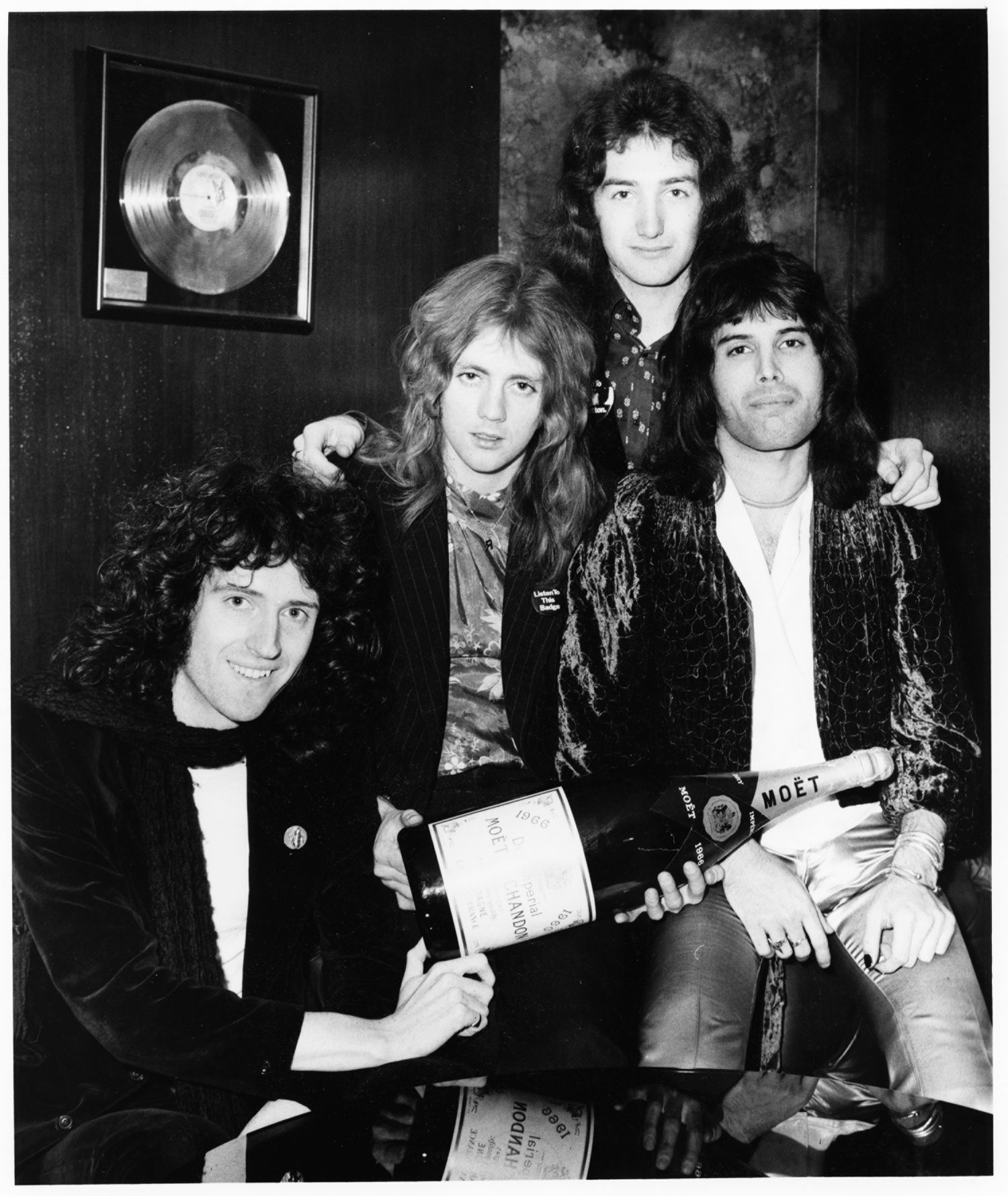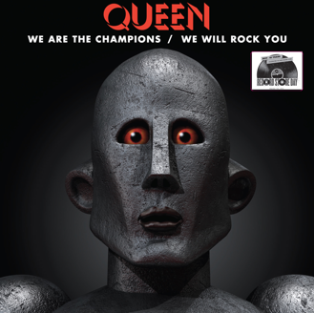Bio / Press Releases
Sterling song craft, virtuoso musicality, outrageous glamour and colossal spectacle: Queen has over four decades continued to find new fans and hold an indelible influence on generations of music makers.
Despite the loss of lead singer and songwriting partner Freddie Mercury more than 20 years ago, Queen’s electrifying artistry continues to shake stadiums, to galvanize arenas and toenthrall audiences worldwide.
The statistics are simply staggering: sales in the hundreds of millions of units, an unprecedented string of number one albums and top-charting singles, seven UK Ivor Novello Awards; Induction into The UK Music Hall of Fame, the US Rock and Roll Hall of Fame and The Songwriters Hall of Fame; MTV Global Icon Award; Songs enshrined in the Grammy Hall of Fame, and a star on the Hollywood Walk of Fame. According to the Guinness Book of World Records, Queen has spent 1,422 weeks on the British charts …over 27 years total, with their Greatest Hits according to BPI sales statistics the best-selling album in Britain UK between 1956 to 2013 (first released in 1981, close on 6 million sales).
Queen’s achievement is amazing, to even see off The Beatles classic, Sergeant Pepper, an album that shook the world.
Four individual talents: Brian May, an incredible guitarist who has earned a PhD in Astrophysics; Roger Taylor, one of the most influential drummers of all time; John Deacon,a fast and facile bassist, multi-instrumentalist and a brilliant electronics engineer; and Freddie Mercury, certainly one of most riveting showman to ever command a stage, with one common thread, the ability to marry a fantastic sense of melody and song structure to a swaggering presentation. Queen is the only band ever in which all four members have written a No 1 single.
With their third album, Sheer Heart Attack, Queen arrived in the US charts, hitting the top 10 with both the single Killer Queen and the album. A Night At The Opera launched the band into the stratosphere, as the inescapable and quite magnificent, Bohemian Rhapsody melded rock and operatic overtones into a five minute and fifty-five second opus of 180 vocaloverdubs, and many, many “Galileos.”. The song is the only single ever to top the chartstwice by the same artist. In the UK it ranks the third biggest selling single of all time, comingbehind only the charitable singles, Elton John’s Candle In The Wind and Band Aid’s Do They Know It Is Christmas”.
Two of the bands songs, We Will Rock You, and We Are the Champions, have become classic stadium anthems, the repertoire of millions of sports fans around the world. During the 2012 London Olympics the track was played more than 500,000 times.
As live artists Queen created anthems of triumph and celebration for an unprecedented live audience who came to witness over 700 concerts across the globe.
Queen, who embodied joyous excess laced with a sense of humor delivered such classic singles as “Fat Bottomed Girls”, Bicycle Race,” and “Killer Queen”.
They blazed to the top of the US charts with “Crazy Little Thing Called Love” and “Another One Bites The Dust” – the latter crossing over the pop and R & B charts and becoming the most played record of the year in 1980. It also became Queen’s bestselling single, with sales of over 7 million copies.
The pinnacle of Queen’s performances came with the legendary Live Aid Benefit in 1985, when the band joined a superstar bill and undeniably stole the show. Their performance is year-on voted best live performance of all-time by a rock artist.
The passing of Freddie Mercury was a profound tragedy. But it speaks to his incredible spirit that the album, Made In Heaven, assembled after his departure sold over seven million copies worldwide. In his memory, the band orchestrated the Freddie Mercury Tribute Concert for AIDS Awareness, and the Mercury Phoenix Trust was established. To date The trust has donated more than $15 million to The fight against AIDS around the world.
For generations of rock fans who weren’t yet born during Queen’s campaign across the globe,the ageless music of Queen is a soundtrack of living history.
Queen The Greatest Special
Latest series of The Greatest celebrates newly released Queen I boxset
With the remixed, remastered and expanded version of Queen’s classic 1973 debut album now available, The Greatest goes behind the scenes with Brian May and Roger Taylor to explore the creation of this landmark album.
Queen The Greatest Special: “The Story of Queen I – Behind The Promo Videos”
(Episode 4)
Queen’s reputation for iconic music videos wasn’t earned overnight. In an exclusive video interview for the latest episode of Queen The Greatest, co-founders Brian May and Roger Taylor look back on the false starts and lucky breaks of their early career on camera and talk about why they hated their first promo video.
**Episode goes live on YouTube Friday December 13 – 6AM PT / 9AM ET
Queen Official YouTube – https://youtu.be/yCB2wt71rSI
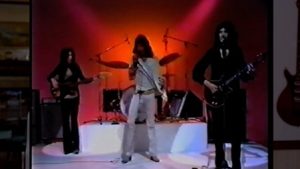
Photo Credit: Queen Productions LTD
(December 13, 2024) Known as masters of the music video, with the lineup of Freddie Mercury, Brian May, Roger Taylor and John Deacon immortalised as everything from the floating heads of “Bohemian Rhapsody” to the stifled housewives of “I Want To Break Free.” Rewind to 1973, however, and when the young band set out to promote their self-titled debut album – now freshly remastered and extended as the new Queen I boxset – the four musicians found themselves facing the unique challenge of matching sound and vision.
In the latest episode of Queen The Greatest, Brian and Roger reflect on the twists of fate – not to mention the good, bad and ugly run of early promos – that would eventually propel them into the public eye. Queen’s career on camera, remembers the guitarist, began with a lucky break that shone a much-needed spotlight on debut single “Keep Yourself Alive.”
Back in July 1973, just one week before the album came out, the opening track, “Keep Yourself Alive,” was released as a single. But with Queen being a new band struggling for any radio airtime, there was a danger the song would fail to make any impact at all. That was, until a BBC TV show offered a glimmer of hope that not only gave this first single valuable exposure, but would go on to kick start Queen’s now legendary reputation for making music videos.
“I remember it very vividly. We had heard that The Old Grey Whistle Test wanted to play ‘Keep Yourself Alive,’” explains Brian of the seminal BBC TV show. “I remember going to my parents’ house and it was going to come on the TV, so we’re glued to The Old Grey Whistle Test. And suddenly you hear the riff and there’s this little train going along. And we were mesmerised because somebody had put together a really nice video. They didn’t have any footage of us, so they couldn’t make a performance video, but they put together very nice little bits of animation, made it all work, and it was very exciting. And suddenly we’re like, ‘Oh, we’re kind of on the scene now.’
“(Presenter) Bob Harris was there, bless him, whispering Bob Harris said some nice things about it, ‘something very exciting, a new group.’ And suddenly we’re like, ‘oh we’re kind of on the scene, you know, people have actually heard of us now.’ And it really did make a difference. So massive thanks forever to The Old Grey Whistle Test team for doing that, taking that shot and putting us on there.”
“It really went very well,” picks up Roger. “I think it was [producer] Mike Appleton who chose that song for The Old Grey Whistle Test. He was a man of taste, actually. I think that was our first – well, I say ‘TV appearance’, but we weren’t in it, you know. But the track was and the cartoon was.”
To build on the momentum – and put faces to the name – Queen’s management decided to shoot a short promotional film at the UK’s Shepperton Studios. “I think that was Trident’s idea,” remembers Roger, “to show people what we were about.”
Yet the result – as laid bare by this week’s episode – was a misfire, with all the grit and danger of Queen’s live shows evaporating as the band squirmed through a performance of “Keep Yourself Alive” in a sterile TV studio.
“When we saw the finished result, we hated it,” admits Brian. “Because somehow the whole thing had become so well-lit, it looked very clinical. It just didn’t feel like rock ‘n’ roll at all. So, we kicked up a bit of a fuss, being the precocious boys we were, and said ‘We don’t like it, we need to do it again. And this time we want it lit the way we want it. Instead of a white stage, we’ll have a black stage and lights which make us look like moody and serious rock musicians, rather than Top of the Pops.’”
At the second attempt – with the four shadowy bandmembers prowling a dimly lit stage – the classic Queen aesthetic began to take shape. And although the video was seen by precious few outside the music industry – “There was no outlet for a video like that,” explains Brian, “no way you could put it on Top of the Pops” – Queen had taken their first emphatic step into the visual realm that would ultimate lead to era-defining visual moments like the now classic “Bohemian Rhapsody” promo video.
“At the time, we did think the visual thing had a part to play, but we didn’t really realise the power of a video,” recalls Roger. “When we did “Bohemian Rhapsody” later, the idea of making that video was our idea, and we knew we could use it as a promotional tool on television. Which is why – when we got to Australia a year after “Bohemian Rhapsody” had been released – it was number one, and they’d been subjected to it for six weeks on their big TV music show, Countdown…”
Episode Image:
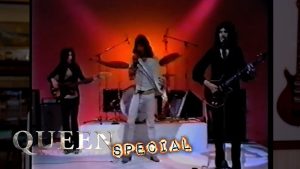
Queen The Greatest YouTube Playlist Link:
https://youtu.be/C5XBmGOFV7E
Episode Embed link:
<iframe width=”560″ height=”315″ src=https://www.youtube.com/embed/C5XBmGV7E?si=a7h9fXv9XNkwvIhx title=”YouTube video player” frameborder=”0″ allow=”accelerometer; autoplay; clipboard-write; encrypted-media; gyroscope; picture-in-picture; web-share” referrerpolicy=”strict-origin-when-cross-origin” allowfullscreen></iframe>
Episode 5 – Queen The Greatest Special: “The Album Cover” coming soon
http://www.queenonline.com
YouTube / Instagram / Facebook / Twitter / TikTok
Brian / Roger
Queen The Greatest YouTube Series Returns with
Limited Six Episode Run
Queen The Greatest Special series celebrates the newly remastered
and expanded Queen I boxset
With the remixed, remastered and expanded version of Queen’s classic 1973 debut album now available, The Greatest goes further behind the scenes with Brian May and Roger Taylor to explore the creation of this landmark album.
Queen The Greatest Special: “The Night Comes Down”
(Episode 3)
Following the recent 7” single release of “The Night Comes Down” from the new Queen I boxset, Brian May now reveals for the first time the inspiration behind the deeply personal lyrics – and unearths his original acoustic guitar to demonstrate how he achieved the song’s unique sound.
Friday November 8 – 6AM PST / 9AM EST at Queen Official YouTube: https://youtu.be/yCB2wt71rSI
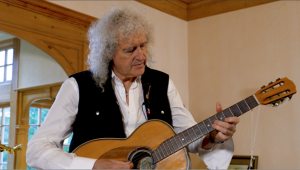
Photo Credit: Queen Productions LTD
Image Link HERE
Embed link:
<iframe width=”560″ height=”315″ src=https://www.youtube.com/embed/yCB2wt71rSI?si=X-nk0xbEA_Le6IGp title=”YouTube video player” frameborder=”0″ allow=”accelerometer; autoplay; clipboard-write; encrypted-media; gyroscope; picture-in-picture; web-share” referrerpolicy=”strict-origin-when-cross-origin” allowfullscreen></iframe>
“I had moments when I thought, ‘I’m in a great place, I can make music. I’m with great friends. I’m at college doing stuff that I love doing. Everything’s great.’ And then somehow, everything would fall apart, and then it’s like the night came down in my head. So that’s what the song was about. It’s not a jolly song.” –Brian May
Released last month on 7” vinyl as a prelude to the Queen I boxset, “The Night Comes Down” is still pricking up ears half-a-century after its creation. Now, in the latest episode of Queen The Greatest – a new video series celebrating the freshly remastered and expanded debut album of 1973 – Brian May looks back on the cult ballad that caught the young lineup’s revolutionary spirit.
With an otherworldly instrumental intro like nothing else in ’70s rock, a soul-baring lyric (and its sense of mystery only amplified by the fact it was never performed live by the band), “The Night Comes Down” is perhaps the most enigmatic song in Queen’s five-decade catalogue.
Fifty-one years later, this exclusive video interview sees Brian explore the roots of this haunting early highlight – and showcase the one-of-a-kind acoustic guitar that gave it life.
“’The Night Comes Down’ evolved in my head, and in my own bedsit and the flats of the people I knew at the time,” explains Brian. “I would have this old acoustic guitar, which I still have, and I restrung it with wire strings. It was originally a gut guitar and, the bridge wasn’t high enough to make them vibrate cleanly. But I turned this into an advantage because I liked the buzzy sound. I’d put pins and needles in the bridge, which I’d carved out myself and stuck on the top. I bastardised this guitar. But it made this sound like a sitar but warmer. And I learnt to play lead on an acoustic, which wasn’t, in those days, done very much.
You know, it’s a very cheap guitar I guess, it’s not like a Martin or a Gibson or whatever, but it has its own sound and it’s very much a part of that, the first Queen album, it’s all over it.”
Solitary by nature and struggling with the rites of young adulthood, “The Night Comes Down” is also a poignant snapshot of Brian’s emotional state in the early-’70s. “The song, actually, was about those moments when you’re not jolly. When you feel like you’ve lost it. When I look back at it, I was very young to be writing that stuff, but I did get depressed in those days. It was always about relationships. And I had moments when I thought, ‘I’m in a great place, I can make music. I’m with great friends. I’m at college doing stuff that I love doing. Everything’s great’. And then, somehow, everything would fall apart, and then it’s like the night came down in my head. So that’s what it’s about. It’s not a jolly song.
“The funny thing is, it’s also a bit of a sort of protest song in a way, because we were told in these little excursions we’d had into studios – ‘You can’t mix acoustic guitar with electric guitar’. And we’d go ‘well why?’ ‘Well, because the electric guitar is too loud’. I’d go ‘don’t be ridiculous. You can make it as loud as you want in the mix.’ But there was this sort of myth around ‘oh, it’s not going to work.’ So I wanted to sort of prove to myself that you could make the acoustic guitar, the front instrument and the electric guitars could be actually behind. So the electric guitars, when they go ‘ne ne ne,’ they’re like a sort of string quartet behind the acoustic guitar, and they’re not too loud because you have got the right volume in your mix.”
Tracking their demo at De Lane Lea Studios, the addition of Brian’s orchestral electric licks – played on the more familiar Red Special – and Freddie Mercury’s swooping falsetto, alongside the sensitive push and pull of bassist John Deacon and drummer Roger Taylor, made “The Night Comes Down” a bewitching listen.
“I’d sung the song to him and Freddie, as always, would make it his own and take it to the next level,” remembers Brian. “Roger in those days was quite busy. He would do a lot of fills, but it fits so perfectly with the way we’re playing. And John gives it his own kind of style and it blends with the acoustic really nicely. It’s got this really gluey, kind of heavy sound. I was really pleased that it sounded so different from everything else that was out there.”
In spring ’72, the Queen lineup graduated to Trident Studios for album sessions proper. But with the signature ‘Trident sound’ clashing with their own vision for the album, the lineup resorted to subterfuge, smuggling their preferred demo tape in a ‘Trident’-labelled box. As such, “The Night Comes Down” was the only survivor from the De Lane Lea sessions. “I was dead set against trying to re-record ‘The Night Comes Down,’” explains Brian, “because I was aware it was a moment, and it sounded exactly like I wanted it to sound. And Roy Baker was very sympathetic. He said, ‘Look, I understand, and maybe we’ll just remix it.’”
It’s only now – with the release of the remixed and remastered Queen I boxset – that “The Night Comes Down” is aired as the band originally intended. “Roy, bless him, put a lot of work into the song,” recalls Brian. “But his brief as dictated by his bosses was to make it sound like it came out of Trident. I was sitting there thinking: ‘At least the original isn’t being destroyed here. At least this is an alternative. Maybe one day we can go back and look at the original’. And now, we’ve done it.”
Episode Image:

Photo Credit: Queen Productions LTD
“It’s a very cheap guitar I guess, it’s not like a Martin or a Gibson or whatever, but it has its own sound and it’s very much a part of that, the first Queen album, it’s all over it.” Brian May.
Image Link
Queen The Greatest Youtube Playlist Link:
https://queen.lnk.to/TheGreatest
December 6: Episode 4 – Queen The Greatest Special: “Behind The Promo Videos “
Queen The Greatest YouTube Series Returns with
Limited Six Episode Run
New series, Queen The Greatest Special celebrates the
newly remastered and expanded Queen I boxset
With the remixed, remastered and expanded version of Queen’s classic 1973 debut album now available, The Greatest goes further behind the scenes with Brian May and Roger Taylor to explore the creation of this landmark album.
********
Queen The Greatest Special: “The Story of Queen 1”- Part 2 (Episode 2)
Episode 2 goes live Friday November 1 at 6AM PT / 9AM ET
https://youtu.be/6Y-BMViFwck
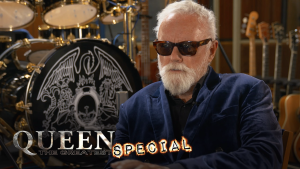
Image Link
Photo Credit: Queen Productions LTD
Episode Embed link:
<iframe width=”560″ height=”315″ src=https://www.youtube.com/embed/6Y-BMViFwck?si=fGJE2vLqpjpBSPPS title=”YouTube video player” frameborder=”0″ allow=”accelerometer; autoplay; clipboard-write; encrypted-media; gyroscope; picture-in-picture; web-share” referrerpolicy=”strict-origin-when-cross-origin” allowfullscreen></iframe>
Continuing the celebration of the release of the Queen 1 Box set, Brian May and Roger Taylor share their memories of recording those first album sessions. Now signed to Trident, Queen can follow in the footsteps of some of their idols into the famous studios, and finally start work on their first album. But, as we hear from Brian and Roger, the experience wasn’t quite what they expected.
As they walked into London’s Trident Studios for the first time in spring ’72 – following a brutal few years of rejection and poverty – the Queen lineup might have hoped they were finally in the fast lane. But as we discover from Brian May and Roger Taylor’s testimony for the latest episode of Queen The Greatest – a new video series to celebrate the freshly remastered and expanded Queen I boxset – the hard work had only just begun.
As Roger reflects, the first challenge was logistical. With Queen at that point a minnow amongst Trident’s roster of big-hitters, the lineup were expected to snatch sessions at dead of night. “It was tough in the beginning. We were really working off-peak hours when the studio was free . Trident Studios was regarded as the studio of the moment in the ’70s. But we’d arrive at three in the morning and go on for all the hours we could grab.”
“It was very tough because we never knew when we were going to get back in there,” adds Brian of the chaotic results. “Tapes got jumbled up and lost, and there was a discontinuity. Sometimes we had to have a different engineer who didn’t realise what we’d done before. It was really a mess. It was a hodgepodge, difficult to hold it together. They were tough times.”
Already, Queen had a distinct vision for their debut – which clashed with their Trident paymasters and left the band dissatisfied with the record’s sound until this year’s remastered Queen I. Even so, as Brian reflects, that original pressing still caught the band’s spirit. “As a band, I think we came through. The energy and creative power actually got onto tape. We had enough passion and belief and indulgence to see through that stuff and realise that even though the sounds weren’t quite what we wanted, we still had our energy and our vibe.”
Even the debut album’s release on July 13, 1973, didn’t quite go according to plan. With Roger recalling “a tsunami of nothing” amongst a disinterested rock press, Brian explains that it took the word-of-mouth buzz from their tireless gigging to send Queen up the charts (the record ultimately went gold in the wake of 1975’s multi-platinum A Night At The Opera). “Once we had that first album out, we had an audience who understood us and were really behind us. There’s suddenly momentum coming in from outside. And that’s incredibly helpful. That gives you the energy you need. So, we had internal energy and we had external energy coming to us from what became the Queen fans, which is incredible.”
Queen ascended to national-treasure status many decades ago. But it’s only now – 51 years after its original release – that the band’s debut album is presented as it was meant to be heard. “Essentially,” explains Roger, “we’ve made the actual album sound the way we wanted it to sound. Using the techniques we have now, the overall sound is better, the mixes are better. And Brian and I thought it was a good idea to clarify exactly what it was by calling it Queen I…”
Adds Brian: “So it’s been amazing to go back into those tapes and build them, to rebuild them, so they have the sounds that we had in our heads at the time. And this is all four of us. It’s not just me or just Roger. No, it’s Freddie very much. John, very much. We always thought, ‘wouldn’t it be great if we could go back to that first album and make it sound the way that we wanted it to sound at the time?’ So now we did it. I’m excited. I’m very excited.”
Received with rhapsodic reviews, it appears Queen 1 is finally being heard figuratively and literally the way the band always dreamed it would be.
Episode Images:
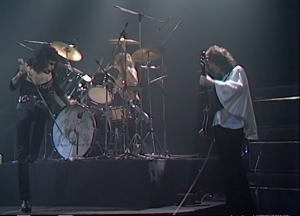
Queen filmed live for the first time, performing Rainbow Theatre London, November 20, 1974
Roger Taylor
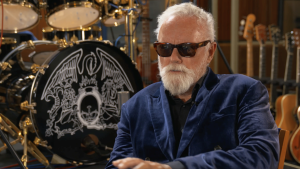
Brian May
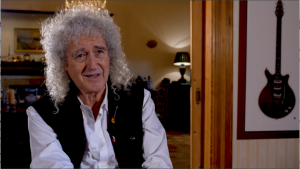
Queen The Greatest Special : The Story of Queen 1 – Part 2 (Episode 2)
YouTube Link:
Episode Embed link:
<iframe width=”560″ height=”315″ src=https://www.youtube.com/embed/6Y-BMViFwck?si=fGJE2vLqpjpBSPPS title=”YouTube video player” frameborder=”0″ allow=”accelerometer; autoplay; clipboard-write; encrypted-media; gyroscope; picture-in-picture; web-share” referrerpolicy=”strict-origin-when-cross-origin” allowfullscreen></iframe>
November 29: Episode 3 – Queen The Greatest Special: “The Story of Queen 1” (Reaction to new Mixes)
YouTube Playlist Link:
https://Queen.lnk.to/TheGreatestLive
Queen The Greatest Special Limited Series
New series of Queen The Greatest celebrates the hugely anticipated Queen I boxset released 25 October
With the remixed, remastered and expanded version of Queen’s classic 1973 debut album released October 25, Queen The Greatest goes behind the scenes with Brian May and Roger Taylor to explore the creation of this landmark album.
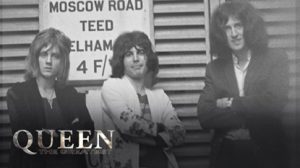
|
View Queen The Greatest:”The Story of Queen I” – Part 1 YouTube Link:
Episode Embed link: YouTube Embed link: <iframe width=”560″ height=”315″ src=https://www.youtube.com/embed/HxI3RzYLfs8?si=feDZ1YCODCbpCozV title=”YouTube video player” frameborder=”0″ allow=”accelerometer; autoplay; clipboard-write; encrypted-media; gyroscope; picture-in-picture; web-share” referrerpolicy=”strict-origin-when-cross-origin” allowfullscreen>
Queen The Greatest Special: “The Story Of Queen I” (Part One) To mark the release of the remixed, remastered and expanded Queen I boxset, Brian May and Roger Taylor reflect on the rocky road to the recording of their self-titled debut album. In this first episode, we hear how the opportunity to trial a brand-new London studio offered the breakthrough they had been waiting for.
Live now on Queen Official YouTube HERE A half-century after announcing themselves to the world with 1973’s self-titled debut album, Queen’s status as a rock ‘n’ roll institution is cast in stone. But as that classic album is reborn on October 25, 2024, as a suitably regal boxset Queen I – featuring remixed/remastered vinyl and CDs, fly-on-the-wall studio outtakes, live rarities, one-of-a-kind memorabilia and much more – The Greatest video series returns to tell the true story behind the band’s dramatic rise to fame.
Interviewed exclusively for this first episode of this acclaimed video series, Brian May and Roger Taylor turn back the clock to the early ’70s and pull no punches in their memories of the fledgling Queen’s financial straits. “It was tough in the beginning,” recalls the drummer. “We were very poor. It really was hand-to-mouth. What do you call a musician without a girlfriend? Homeless.”
But fate threw a lifeline in the form of the De Lane Lea Studios: a brand-new facility located in the shadow of Wembley Arena, seeking an upcoming band to put the untested equipment and sound insulation through its paces. “The De Lane Lea Studios really changed our lives,” explains Brian, “and it was just because a friend of a friend had got hold of me and said, ‘Would you like to come in and make a noise?’ And in return, we got to make those demos.”
The world beyond the studio walls might not yet have known their name, but as Brian reflects, Queen’s musical signatures were already forming – alongside the nascent vocals of Freddie Mercury. “It was the first time I ever tried a three-part guitar solo, on “Keep Yourself Alive.” I’d had it in my brain for a long time and I wanted to hear this three-part soaring guitar sound like an orchestra. Freddie was very elemental in those days. But incredibly quickly, he picked up the art of recording in a studio and getting the best out of himself.”
Those thrilling first steps can be heard on CD2 of the new Queen I boxset, which offers a contemporary remaster of the original De Lane Lea demos.
Armed with these songs, the band started banging on doors of record companies. But as Roger reflects, the music industry of the early ’70s took more convincing. “I remember getting on endless trains with Freddie, hawking the demo around to all the different record companies. We’d sit in their offices and they’d play the stuff, and they’re all kind of interested, but nobody actually took the bait.” “It was just a grind. I wouldn’t say it was soul destroying because we were quite confident. We had a sort of innate, gentle arrogance. You know, we thought we were good and quite different. But, yeah, it could have been soul destroying, but we didn’t let it get us down too much.” Then fortune smiled again, as the noted producer and A&R man John Anthony took a chance on the band who had pricked up his ears as students, easing Queen towards the deal that would make their debut album a reality. “When we did our showcase gigs in Imperial College, we invited John both times,” remembers Brian, “and he came, give him credit. And when we were in De Lane Lea, he popped in one day with Roy Baker, to see how the recordings were coming on, and he was obviously impressed. He said, ‘Well, this is going to be really great. I’ll get you the deal with Trident Audio Productions, who were an embryonic management company. They were already a successful studio recording, based in Saint Anne’s Court in Soho.”
Says Roger Taylor: “A lot of hits came out of that studio, you know. With George Harrison come in and do “All Things Must Pass,” and, David was producing Transformer with Lou Reed, a great album, you know, absolutely ground-breaking. So it was the place to be.” Having signed that management deal with Trident, Queen would be given crucial access to the studio, and in our next episode Brian and Roger explain how work on Queen’s first album could finally begin. Queen The Greatest Special – The Story of Queen 1 (Part Two): out November 1st. |
|
Photos:
|
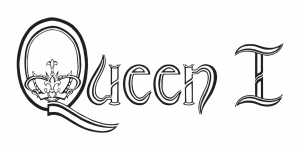
QUEEN I
Queen’s groundbreaking 1973 debut album, Queen, remixed, remastered and expanded in a 6CD+1LP box set Queen I Collector’s Edition
out October 25.
Also released as Vinyl LP Queen I – 2024 Mix
plus 1 CD, 2CD Deluxe Edition, 1LP Picture Disc and Cassette formats.
Single “The Night Comes Down” leads release.
Pre-Order Queen I: https://Queen.lnk.to/QueenI
Link to press folder: https://Queen.lnk.to/QueenIPRContent
Queen I Website: http://www.queenIofficial.com/
“I have seen the future of pop music, and it’s a band called Queen.”
Jac Holzman, founder of Elektra Records, 1972
“Queen I is the debut album we always dreamed of bringing to you.”
Brian May and Roger Taylor, 2024
Over half a century since its release and a vital chapter in the band’s story, Queen’s self-titled 1973 debut album has been remixed and restored by Justin Shirley-Smith, Joshua J Macrae and Kris Fredriksson to sound the way the band always wanted it to. A new tracklisting, alternative takes, demos and live tracks have now been added to create the most complete version of this pivotal work. This is the very first time that a Queen album has ever received a new stereo mix.
The 6CD + 1 LP Queen I box set contains 63 tracks with 43 brand new mixes, comprising the original album with its intended running order restored, intimate fly-on-the-wall audio of Queen in the studio, demos, rare live tracks, and previously unheard recordings from Queen’s first ever live performance in London, August 1970. Absent from the 1973 release, the song “Mad the Swine” has been reinstated to its original place in the running order. A 108-page book containing handwritten lyrics and memorabilia accompanies the release.
“This is not just a remaster,” writes Brian May in the CD sleeve insert notes, “this is a brand new 2024 rebuild of the entire Queen debut album, which, with the benefit of hindsight, we have re-titled QUEEN I.”
May continues, “All the performances are exactly as they originally appeared in 1973, but every instrument has been revisited to produce the ‘live’ ambient sounds we would have liked to use originally. The result is “Queen“ as it would have sounded with today’s knowledge and technology – a first.”
“Queen I is the debut album we always dreamed of bringing to you.”
Queen began life in early summer 1970, but took their first steps in the studio after vocalist Freddie Mercury, guitarist Brian May and drummer Roger Taylor recruited bass guitarist, John Deacon, in July 1971.
“The first three years were really faith and fumes,” says Roger Taylor. “We were penniless but we had a lot of belief in ourselves and a lot of energy.”
While Queen struggled for recognition, their music and stage act were developing. If their previous band Smile were a band for the late 1960s, then Queen’s sound and image was about the here and now and tomorrow. Their songs were already filled with huge riffs, choral harmonies and classical flourishes.
After John Deacon’s arrival, Queen secured a production, song publishing and management deal with Trident Audio Productions. Having heard the band’s demos, the company’s owners, brothers Norman and Barry Sheffield, agreed to fund the recording of Queen’s first album, which they would then shop to potential record companies.
The Sheffields also owned Trident Studios, a state-of-the-art facility in London’s Soho, which had been used by Elton John and The Beatles and was rarely available to young, unsigned bands. Trident’s popularity was such that the studio was usually fully booked during the day, meaning Queen could only record during what was known as ‘downtime’, those rare moments when the studio was empty, usually at night.
Queen began work on the album in May 1972 and spent the next four months living a fractured, nocturnal existance. Evenings would be spent waiting around Soho until the studio was ready. An exhausted Queen would emerge from Trident several hours later.
“We’d work through the night and usually until 7am when the cleaners came in,” recalls Brian. “It was us just grabbing little bits of time.”
Says Roger: “You know, we just came in there right after Bowie had done Hunky Dory and Rise and Fall of Ziggy Stardust and he did both of those albums back to back, two great albums. So, we were very pleased to be there, but when we were there, we’d arrive at three in the morning and then go on, for all the hours that we could grab. It was just a grind. I wouldn’t say it was soul destroying because we were quite confident. We had a sort of innate, gentle arrogance, you know, we thought we were good and quite different.”
Queen recorded the album with Trident’s in-house co-producers, John Anthony and Roy Thomas Baker. Both were staunch advocates of Queen and had been instrumental in the band signing with Trident. However, the group quickly ran up against the studio’s rules and regulations.
Says Brian: “Although we had great technology around us, we really didn’t have much freedom to use it. We were regarded as the new boys who didn’t know anything, and nobody really wanted to listen to the way we wanted to do things.”
While relatively inexperienced, Queen already had a clear musical vision. However, the huge guitar and drum sounds they heard in their heads proved difficult to recreate at two o’clock in the morning and on the studio’s in-house perspex drum kit rather than their own.
Says Roger: “They had this very dead drum sound, and it was never the sound we wanted. They had a drum booth, and it was a well known sound. It was kind of American. Very dry, quite fat, dead sound, which is not what I wanted. I wanted to hear the drums resonate, to hear the sound of the drum. I didn’t even have my proper kit in there. It was a bit rough really. So the album never sounded as we wanted it to.”
“We wanted everything to sound like it was in-your face,” says Brian. “We had this incredible fight to get the drums out of the booth and into the middle of the studio and put the mics all around the room.”
But that wasn’t Trident’s way. “I remember saying to Roy Thomas Baker, ‘This isn’t really the sound we want,’” continues Brian.”And he said, ‘Don’t worry, we can fix it all in the mix.’ And I think we all knew it ain’t going to happen.” Now in 2024, it has been ‘fixed in the mix’.
Queen’s frustration was compounded by the fact that the songs themselves already displayed the breadth of Queen’s ideas and vaulting ambition. “Keep Yourself Alive”, was like a rallying cry, cueing up the likes of “Doing All Right”, “Great King Rat”, “Liar”, “Modern Times Rock’n’Roll” and “Son And Daughter”.
Meanwhile, Freddie’s imagination had free rein on the biblically-inspired “Jesus” and on “My Fairy King”, where the singer (who was soon to assume the stage name ‘Freddie Mercury’) sang about “horses born with eagles’ wings” and implored “Mother Mercury, look what they’ve done to me.”
“I never knew where some of those lyrics came from,” says Roger. “But Fred was like a magpie. He had a very sharp brain.”
Crucially, this new 2024 Mix version of Queen I now includes “Mad The Swine”, a song absent from the original LP after a difference of opinion between the band and one of its producers. It is now reinstated to its rightful place as the album’s fourth song, in between “Great King Rat” and “My Fairy King”, just as Queen wanted it to be in 1972.
Despite the restrictions imposed upon them at Trident, the band still managed to break the rules. Brian’s composition (and the box set’s first single), “The Night Comes Down”, blueprinted that layered acoustic and electric guitar sound that was soon to become part of Queen’s signature. But the band insisted on using a recording from De Lane Lea Studios rather than attempt a new version at Trident. They smuggled in their demo multi-track tape in a newly labelled ‘Trident’ box in order to mix the song for the album.
CD2: De Lane Lea Demos – 2024 Mix explores Queen I’s fascinating pre-history, with brand new 2024 mixes of the demos the band recorded preceding their album. In summer 1969, Brian and Roger’s pre-Queen group, Smile, had recorded at De Lane Lea Studios in London’s Kingsway. Two years later, the company opened a new complex in Wembley, and needed a band to help them test the mixing desks and the sound quality of the different rooms.
Brian and Roger volunteered Queen, and the band spent time at the studio between November 1971 and January 1972 – “a massive thrill,” Brian recalls. They were repaid with a five-song demo, overseen by De Lane Lea’s chief engineer Louie Austin, and containing “Keep Yourself Alive”, “The Night Comes Down”, “Jesus”, “Liar”, and “Great King Rat
“The demos we made at De Lane Lea Studios were closer to what we dreamed of,” explains Brian. “Nice open drum sounds and ambience on the guitar. That was much more the way we wanted it to go.”
“We were young and had total blind faith in what we were doing,” says Roger.
Although these demos were intended to be hawked around to procure a recording contract, the band, says Brian, always felt the performances had more spontaneity and sparkle, as well as the benefit of more natural sounds compared with the final album versions. As, the only surviving copies of the mixes of the demos are on scratched acetates, here for the first time, these self-produced recordings have been restored and remixed from the original multitracks.
CD3: Queen I Sessions, and CD4: Queen I Backing Tracks, take the listener behind the scenes at both Trident and De Lane Lea studios.
CD3: Sessions collates completely different and 100% previously unreleased versions of the songs on the album. Newly created using out-takes from De Lane Lea and Trident. They feature some false starts, guide vocals, backing tracks and alternative takes, including spoken-word segments in which the members of Queen can be heard chatting and joking (“It was you Bulsara!”) and occasionally expressing their frustration. Many of the takes are built around acoustic guitar, the electric would have been added later, which gives a different feel to these versions.
CD4: Queen I Backing Tracks offers mixes of the songs from the original Queen album without lead vocals.
Queen pitched the De Lane Lea demos to several record companies, but didn’t sign with any, hence their deal with Trident. The album was pretty much completed in 1972. But Queen and their producers were still arguing about the mix right up until the last day, so much so that the band chose a mix of “Keep Yourself Alive”, created with Trident’s assistant engineer Mike Stone, rather than one of the earlier versions. Mike would go on to engineer the next five Queen albums.
Trident pitched Queen’s debut to labels, and eventually signed the band to EMI in the UK and Elektra in the US. Elektra’s founder, Jac Holzman, attended Queen’s date at London’s Marquee club on April 9, 1973. The box set’s book includes an entry from Roger’s diary about the gig: “Went down a storm… Jac Holzman liked it!” Holzman circulated a memo to his staff declaring, “I have seen the future of pop music, and it’s a band called Queen.”
Queen’s debut wasn’t released until July 13, 1973 in the UK and September 4 in the US, increasing their frustration. Queen were “hugely ambitious and unashamedly so,” said Roger Taylor, and had progressed rapidly over the previous twelve months. The LP’s sleevenotes implied as much with the curt note: “Representing at least something of what Queen’s music has been over the last three years.”
EMI issued “Keep Yourself Alive” as a single a week before the album’s UK release, but radio play proved hard to come by. Someone was listening, though.
CD5: Queen I At The BBC, begins with “My Fairy King,” in a slightly different version recorded for DJ and early Queen champion John Peel’s BBC Radio 1 show Sounds Of The Seventies in February 1973, five months before the LP’s release. As no-one had heard their album yet, the band took in backing tracks and added new vocals and other overdubs for this first session. This was the first time Queen’s music had been broadcast anywhere in the world. Three further BBC sessions are preserved here, with new versions of all of Queen I’s songs broadcast by the BBC between February 1973 and April 1974.
What CD5 ‘Queen I At The BBC’ and CD6, ‘Queen I Live’, demonstrate is how these songs grew and developed away from Trident Studios.
CD6: Queen I Live distils the best performances of the first album’s songs from Queen’s triumphant March 1974 headline date at London’s Rainbow Theatre, plus several previously unreleased tracks added. These include the first official release of “Hangman”, a Free-inspired Mercury/May/Taylor/Deacon composition which was a mainstay of Queen’s early live shows, but was never recorded in the studio. This performance of “Hangman” comes from a show at the San Diego Sports Arena on the last night of the band’s US tour in March 1976.
The final songs on ‘Queen I Live’ revisit the historic moment Queen became Queen. Among the 108-page enclosed book’s many never-before-seen artefacts is Roger’s handwritten invitation to Queen’s first ever performance in London: “A private showing on Sunday August 23 [1970] at 7:30pm at Imperial College… lecture theatre A, level 5,” he writes.
Two songs from this historic show, “Jesus” and a cover of the Spencer Davis Group’s 1967 hit “I’m A Man”, have been retrieved from cassettes in the archive, and are the earliest Queen recordings in existence, even pre-dating John Deacon’s arrival in the band.
The final track on the original Queen album is the urgent-sounding one and a quarter minute instrumental snippet of “Seven Seas Of Rhye”. The finished song wouldn’t appear until Queen II, and became a UK Top 10 hit. In a sense though, this abbreviated version’s frantic rhythms, hammering piano and orchestral-sounding guitar captures the spirit of Queen’s debut: it’s the sound of a restless, determined young band eager to take the next step.
As Freddie once said: “All of us were aiming for the top, and we weren’t going to be content or satisfied with anything less.”
Says Brian: “Freddie was so convinced that he would be successful, he never doubted it. We were all precocious boys but he was another level. But we all shared this passion. And the energy grew and coalesced into something very powerful.”
And a final thought from Roger Taylor: ”Essentially with the Queen I box set we’ve made the actual album sound the way we wanted it to sound using the techniques that we have now. We’ve made the drums sound like they should sound and, the overall sound of it is better, the mixes are better. So it’s been a delight to improve it, to bring it up to where we wanted it to be.”
“I have found one thing though that has amazed me listening to this album again and again is how bloody religious some of the lyrics are, you know, it’s really quite religious.”
THE NIGHT COMES DOWN 7” SINGLE – Physical release
A: The Night Comes Down (2024 Mix – Single Version)
B: The Night Comes Down (Backing Track)
The Night Comes Down first Instant Grat from album to be available immediately on pre-ordering digital version of the album.
Physical 7” single for release 4 October. Available for pre-order 11th September from Queen Online store ahead of October 25 Queen I box set release.
QUEEN I Collector’s Edition (6CD+LP)
Release October 25, 2024
CD1: Queen I – 2024 Mix
1 Keep Yourself Alive
2 Doing All Right
3 Great King Rat
4 Mad The Swine
5 My Fairy King
6 Liar
7 The Night Comes Down
8 Modern Times Rock ‘n’ Roll
9 Son And Daughter
10 Jesus
11 Seven Seas Of Rhye…
CD2: De Lane Lea Demos – 2024 Mix
1 Keep Yourself Alive
2 The Night Comes Down
3 Great King Rat
4 Jesus
5 Liar
CD3: Queen I Sessions
1 Keep Yourself Alive (Trident Take 13 – Unused Master)
2 Doing All Right (Trident Take 1 – with Guide Vocal)
3 Great King Rat (De Lane Lea Take 1 – with Guide Vocal)
4 Mad The Swine (Trident Take 3 – with Guide Vocal)
5 My Fairy King (Trident Backing Track In Development)
6 Liar (Trident Take 1 – Unused Master)
7 The Night Comes Down (De Lane Lea Takes 1 & 2 – with Guide Vocal)
8 Modern Times Rock ‘n’ Roll (Trident Takes 8 & 9)
9 Son And Daughter (Trident Takes 1 & 2 – with Guide Vocal)
10 Jesus (De Lane Lea Take 2 – with Guide Vocal)
11 Seven Seas Of Rhye… (Trident Take 3)
12 See What A Fool I’ve Been (De Lane Lea Test Session)
CD4: Queen I Backing Tracks
1 Keep Yourself Alive
2 Doing All Right
3 Great King Rat
4 Mad The Swine
5 My Fairy King
6 Liar
7 The Night Comes Down
8 Modern Times Rock ‘n’ Roll
9 Son And Daughter
10 Jesus
11 Seven Seas Of Rhye…
CD5: Queen I At The BBC
1 My Fairy King (BBC Session 1, February 1973)
2 Keep Yourself Alive (BBC Session 1, February 1973)
3 Doing All Right (BBC Session 1, February 1973)
4 Liar (BBC Session 1, February 1973)
5 Keep Yourself Alive (BBC Session 2, July 1973)
6 Liar (BBC Session 2, July 1973)
7 Son And Daughter (BBC Session 2, July 1973)
8 Modern Times Rock ‘n’ Roll (BBC Session 3, December 1973)
9 Great King Rat (BBC Session 3, December 1973
10 Son And Daughter (BBC Session 3, December 1973
11 Modern Times Rock ‘n’ Roll (BBC Session 4, April 1974)
CD6: Queen I Live
1 Son And Daughter (Live at the Rainbow – March 1974)
2 Guitar Solo (Live at the Rainbow – March 1974)
3 Son And Daughter (Reprise) (Live at the Rainbow – March 1974)
4 Great King Rat (Live at the Rainbow – March 1974)
5 Keep Yourself Alive (Live at the Rainbow – March 1974)
6 Drum Solo (Live at the Rainbow – March 1974)
7 Keep Yourself Alive (Reprise) (Live at the Rainbow – March 1974)
8 Modern Times Rock ‘n’ Roll (Live at the Rainbow – March 1974)
9 Liar (Live at the Rainbow – March 1974)
10 Hangman (Live in San Diego – March 1976)
11 Doing All Right (Live in San Diego – March 1976)
12 Jesus (Live at Imperial College – August 1970)
13 I’m A Man (Live at Imperial College – August 1970)
LP: Queen I – 2024 Mix
Side One
1 Keep Yourself Alive
2 Doing All Right
3 Great King Rat
4 Mad The Swine
5 My Fairy King
Side Two
1 Liar
2 The Night Comes Down
3 Modern Times Rock ‘n’ Roll
4 Son And Daughter
5 Jesus
6 Seven Seas Of Rhye…
ADDITIONAL FORMATS:
1x CD: Queen I – 2024 Mix
2x CD: Deluxe Edition
CD1: Queen I – 2024 Mix
CD2: Queen I – Sessions
1x LP: Queen I – 2024 Mix
1x LP Picture Disc: Queen I – 2024 Mix
Exclusive to Queen Online Store
1x Cassette: Queen I – 2024 Mix
Also available in Download / Streaming / Atmos
Queen The Greatest series returns with season 2
Queen The Greatest Live a year-long celebration of Queen Live
A 50-week YouTube series going behind the scenes to reveal what goes into creating a
Queen show featuring moments from iconic performances and demonstrating why the band is regarded as the ultimate live act.
https://Queen.lnk.to/TheGreatestLive
Queen The Greatest Live: “Live In The 21st Century” (Episode 45)
At the vanguard of British rock ‘n’ roll since 1970, Queen have seen the live experience evolve from a communion in the moment to the video sharing of the smartphone era. In this week’s exclusive video interview, Brian May and Roger Taylor hold forth on the biggest changes, for better and worse.
WATCH HERE
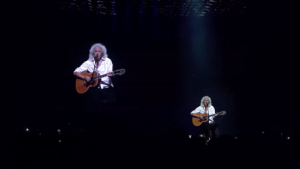
Brian May performs ‘Love Of My Life’, O2 London
© Queen Productions
Embed link:
<iframe width=”560″ height=”315″ src=https://www.youtube.com/embed/pQnr5w_EY14?si=A7KZyJEVO_pqMtwztitle=”YouTube video player” frameborder=”0″ allow=”accelerometer; autoplay; clipboard-write; encrypted-media; gyroscope; picture-in-picture; web-share” allowfullscreen></iframe>
Queen straddled the ’70s and owned the ’80s – but they are almost unique as a band from that golden era of British rock who remain active and relevant in the modern age with an unrivalled ability to continuously amaze and surprise their audiences with a must see show that, year on year, just gets bigger and better.
This week’s exclusive video interview with Brian May and Roger Taylor sees the Queen co-founders explain how the live experience has adapted to a changing world and answer the question on how shows and audiences of today compare to those when it all began.
“The reaction is very similar to what it used to be,” says Brian of this year’s triumphant Rhapsody Tour. “The biggest difference is mobile phones, because in the old days people didn’t have that stuff and they would just be there, their whole selves interacting in mind and body and eyes and ears. It’s not like that now. Everybody has this urge to kind of immortalize stuff. So, when you look out, you see almost as many mobile phones as people, which is weird. There are knock on effects from that because there’s nothing secret anymore. We used to go from town to town and audiences would have no idea what we were going to do. So everything was new and exciting. Nowadays people will have filmed it. It’ll be on YouTube, it will be on Instagram, and people will know what you did last night.”
Fortunately, as Brian reveals, he has a trick to nudge fans into enjoying an unmediated experience. “When I do “Love Of My Life,” I ask them to put their lights on. People don’t necessarily twig it, but what I’m saying is you’re not using your phone to film at this point. You’re actually using the light, so you can’t be filming at the same time. I think that’s partly why the moment is so powerful, because people suddenly go, ‘Oh, there’s nothing else except the performance’.”
As a band whose 2023 shows opened with the eye-popping illusion of an invading robot army, Queen can hardly be accused of an old-school mentality – and as Roger explains, technology also has its benefits. “Modern lights generate almost no heat. Before, the stage was like a furnace. Our lighting rig would come down and my stool would smoke. It was just so hot onstage, it was indescribable. Of course, that’s gone now. And then, you’ve got these wonderful screens, which are getting better every year. It’s possible to do amazing things with them.”
Ultimately, explains Brian, the trick is to embrace the best of the cutting edge while never losing sight of the primal thrills of a live rock show. “There’s a few places where we’re consciously old school. One is definitely the way the lights are operated. A lot of people these days will work all on presets. Whereas we much prefer to get somebody pushing the buttons in time with us, feeling what we’re doing. Same with the video. We don’t work to a click, they have to be working the little bits of video to keep them in time with us, which is great. It makes everything locked in – it makes it a truly live show.”
Next week: Queen The Greatest Live – “21st Century Queen – Hammer To Fall” (Episode 46)
Youtube Playlist Link
https://Queen.lnk.to/TheGreatestLive
YouTube / Instagram / Facebook / Twitter / TikTok
Queen The Greatest series returns with season 2
Queen The Greatest Live a year-long celebration of Queen Live
A 50-week YouTube series going behind the scenes to reveal what goes into creating a
Queen show featuring moments from iconic performances and demonstrating why the band is regarded as the ultimate live act.
https://Queen.lnk.to/TheGreatestLive
Queen The Greatest Live: “We Will Rock You” (Episode 44)
Brian May’s foot-stomping, hand-clapping anthem never fails to galvanize the entire audience, its legendary beat too compelling to resist. But as we see in this montage of archive Queen shows, an added visual flourish from Freddie Mercury ensured the song’s unifying effect transcended borders and cultures.
WATCH HERE
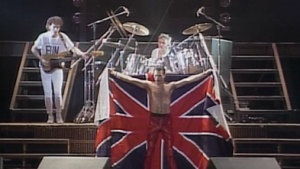
Queen perform Japan, May 1985
© Queen Productions
Embed link:
<iframe width=”560″ height=”315″ src=https://www.youtube.com/embed/ulJ-SxfgkW0?si=gRK0ENVkZCoUaNwotitle=”YouTube video player” frameborder=”0″ allow=”accelerometer; autoplay; clipboard-write; encrypted-media; gyroscope; picture-in-picture; web-share” allowfullscreen></iframe>
Never in the history of rock ‘n’ roll have three percussive notes made such an impact. When Brian May wrote “We Will Rock You,” after a particularly raucous show at Stafford’s Bingley Hall in the late-’70s, he hoped it would spark a primal call-and-response with the Queen hardcore.
But the guitarist could scarcely have imagined just how far that beat would travel – with this week’s archive footage showcasing the ubiquitous stomp-stomp-clap at four shows spanning from the Far East to South America.
From its inception, “We Will Rock You’s” propulsive and near-Pavlovian rhythm made it an obvious choice for the encore, blurring the lines between performer and audience. But as we see in this latest episode of Queen The Greatest Live, the song also allowed the band – and Freddie Mercury in particular – to put their hands across the water, saluting crowds on home turf and foreign soil alike.
At the Milton Keynes Bowl in ’82, the singer emerges from the wings in a traditional wide-brimmed hat to greet his countrymen. At Hungary’s Népstadion on the 1986 Magic Tour Freddie salutes the audience with its national white, red and green flag colors. At 1985’s Rock In Rio, he appears swaddled in the colors of the Brazilian flag with its famous motto Ordem e Progresso (‘Order and Progress’), while most flamboyant of all, the singer slowly walks to the lip of the stage in Japan ’85 – before spinning to reveal that the reverse of his Union Jack cape bears the crimson dot of the Hinomaru.
In each case, just as Brian had intended all those years before, the crowd is united under one banner. “’We Will Rock You’ brings people together,” says the guitarist. “That’s probably the best thing of all…”
Next week: Queen The Greatest Live – “21st Century Queen” (Episode 45)
Youtube Playlist Link
https://Queen.lnk.to/TheGreatestLive
Queen The Greatest series returns with season 2
Queen The Greatest Live a year-long celebration of Queen Live
A 50-week YouTube series going behind the scenes to reveal what goes into creating a
Queen show featuring moments from iconic performances and demonstrating why the band is regarded as the ultimate live act.
https://Queen.lnk.to/TheGreatestLive
Queen The Greatest Live: “Friends Will Be Friends” (Episode 43)
Anyone attending a concert during Queen’s record-breaking Magic Tour in 1986 could be forgiven for thinking the grand finale of “We Will Rock You” and “We Are The Champions” was cast in stone. The band, however, always had a few surprises up their sleeve, and the encore on this tour was no exception.
WATCH HERE
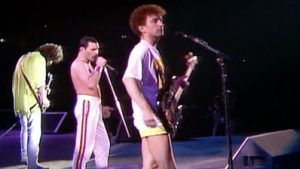
Queen: Brian May, Freddie Mercury, John Deacon.
London Wembley Stadium. Magic Tour. July 1986.
© Queen Productions
Embed link:
<iframe width=”560″ height=”315″ src=https://www.youtube.com/embed/-fUwzGSAF8I?si=8EjmpL2mlKrv0CG4 title=”YouTube video player” frameborder=”0″ allow=”accelerometer; autoplay; clipboard-write; encrypted-media; gyroscope; picture-in-picture; web-share” allowfullscreen></iframe>
When Queen brought the curtain down with “We Will Rock You” and “We Are The Champions” on their News Of The World tour in 1977, they knew they had found a triumphant finale that sealed the connection between band and audience. And so the template was set for every subsequent show…or so it seemed.
It would take a special song indeed to drive a wedge between those two precision-tooled, audience-igniting encores.
Always with an eye on surprising their fans, on the 1986 Magic Tour, as Brian’s thunderous guitar solo from “We Will Rock You” reaches its crescendo, rather than wait for the melodic piano entry to Champions, Roger counts in an unexpected twist to the set list that delights the crowd…as Queen introduce “Friends Will Be Friends,” the band’s ode to comradeship.
Step up John Deacon, the band’s virtuoso bassist and secret weapon, whose soft-spoken manner belied his writing of such Queen classics including “I Want To Break Free,” “Another One Bites The Dust” and “You’re My Best Friend.” As John said: “If I’d just been a bass player all my life with the band, I wouldn’t be as satisfied as I am because I only consider that as part of what I do. The songwriting and being involved in the decision-making means I’ve been able to have a part in the band’s destiny.”
Co-written with Freddie Mercury, Friends Will Be Friends was another highlight from the Deacon songbook, its glorious opening swoops of guitar settling into a tender lyric catching the human need for companionship (‘When you’re through with life and all hope is lost, hold out your hand, ’cos friends will be friends’).
Released as a UK single on June 9th 1986 – and joining the Magic Tour setlist two days later at Leiden’s Groenoordhallen in the Netherlands – this week’s footage finds the Wembley Stadium crowd blissfully blindsided in July ’86, as the anticipated piano intro of “We Are The Champions” is hijacked by Roger Taylor’s count-in and a twist in the tail. The audience reaction was unanimous, and the retooled encore featuring “Friends Will Be Friends” would endure right through to Queen’s final Freddie-era show at Knebworth that August.
Next week: Queen The Greatest Live – “We Will Rock You” (Episode 44)
Youtube Playlist Link
https://Queen.lnk.to/TheGreatestLive
YouTube / Instagram / Facebook / Twitter / TikTok
Queen The Greatest series returns with season 2
Queen The Greatest Live a year-long celebration of Queen Live
A 50-week YouTube series going behind the scenes to reveal what goes into creating a
Queen show featuring moments from iconic performances and demonstrating why the band is regarded as the ultimate live act.
https://Queen.lnk.to/TheGreatestLive
Queen The Greatest Live: “Jailhouse Rock” (Episode 42)
Before the anthemic one-two of “We Will Rock You” and “We Are The Champions” became their regular encore, Queen often signed off with a rabble-rousing take on an Elvis classic. In this week’s footage, watch everybody in the whole cell block – or, in this case, the Hammersmith Odeon – dancing to the “Jailhouse Rock.”
WATCH HERE
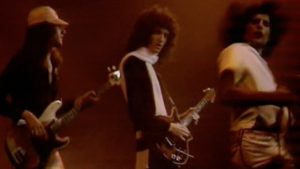
Queen: John Deacon, Brian May, Freddie Mercury.
Hammersmith Odeon, December 24, 1975.
© Queen Productions
Embed link:
<iframe width=”560″ height=”315″ src=https://www.youtube.com/embed/AhpU0zGMyr0?si=lLMJOCI7VUBtC1b9 title=”YouTube video player” frameborder=”0″ allow=”accelerometer; autoplay; clipboard-write; encrypted-media; gyroscope; picture-in-picture; web-share” allowfullscreen></iframe>
While Queen shows of the mid-’70s led rock ‘n’ roll into a new era, the band often saluted their formative influences as a parting shot. Prior to May 1978, when “We Will Rock You” and “We Are The Champions” took up permanent residence on the setlist’s closing straight, the band were known to dive into the songbooks of the great US pioneers, including Elvis Presley’s “Jailhouse Rock.”
Penned by songwriting/production duo Jerry Leiber and Mike Stoller – and recorded by the King for his 1957 film of the same name – the original “Jailhouse Rock” had been a hip-swaying rave-up, telling of a raucous “party in the county jail” where “the prison band began to wail”.
Meanwhile, across the Atlantic in their childhood homes, Queen’s future members were listening intently. “I think it’s impossible to have been a kid at that time and not been influenced by Elvis,” reflected Brian May in 2021. “Freddie in particular though, of course. He was one of Freddie’s great heroes. For me, his guitarists were a great inspiration. Scotty Moore was one, James Burton the other. So, yeah, Elvis was definitely an influence.”
But as we see in this archive footage from the Hammersmith Odeon on 24th December, 1975, Queen’s ferocious reboot of “Jailhouse Rock” was anything but reverent, adding rocket fuel and proto-punk energy. With Roger Taylor revving the tempo, Brian pulling out his best supercharged Scotty Moore guitar licks and Freddie throwing flowers to the crowd – while balloons and blow-up dolls float through the air – it’s the most anarchic encore imaginable.
As Roger recently reflected: “On “Jailhouse Rock,” we could go a bit mad…”
Next week: Queen The Greatest Live – “Friends Will Be Friends” (Episode 43)
Youtube Playlist Link
https://Queen.lnk.to/TheGreatestLive
YouTube / Instagram / Facebook / Twitter / TikTok
IMAX AND PATHÉ LIVE ANNOUNCE THE GLOBAL RELEASE OF
“QUEEN ROCK MONTREAL” EXCLUSIVELY IN IMAX THEATRES
FOR A LIMITED ENGAGEMENT BEGINNING JANUARY 18
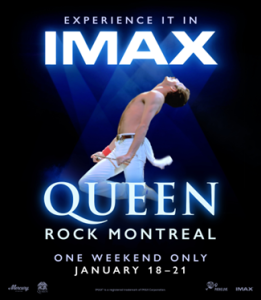
Los Angeles, CA (November 29, 2023) — IMAX and Pathé Live in partnership with Mercury Studios and Queen Films announced today that, for the very first time, one of the world’s biggest bands will perform on cinema’s biggest screens with the global release of “QUEEN ROCK MONTREAL,” exclusively in IMAX® beginning January 18, 2024. This exhilarating live concert from 1981 is a window into Queen in their most unalloyed form, giving audiences a larger-than-life, front-row immersive experience. The film was digitally re-mastered for the first time into the image and sound quality of The IMAX Experience®, including 12-channel surround sound, crystal-clear images, and IMAX’s customized theatre geometry. Rock & roll royalty Freddie Mercury, Brian May, Roger Taylor, and John Deacon take to the stage in a historic and exhilarating performance of their greatest hits including “We Will Rock You,” “Somebody To Love,” “Under Pressure,” Bohemian Rhapsody,” “Another One Bites the Dust,” “We Are The Champions,” and additional songs from popular album The Game including “Dragon Attack,” “Play the Game,” and more. Executive producers include Geoff Kempin and Alice Webb for Mercury Studios and Jim Beach and Matilda Beach for Queen Films.
“I don’t think we quite realized it at the time, but this film has preserved one of the highest peaks in Queen’s touring life, on stage in the old glory days. The director was very much focussed on Freddie, and this now stands as probably the most precious intimate capture ever of Mr. Mercury at his full awesome power,” said Brian May. Added Roger Taylor, “Enjoy. We were young!”
“QUEEN ROCK MONTREAL” will be released in over 450 IMAX locations globally for four days beginning January 18. Participating territories include the United States, Canada, United Kingdom, France, Germany, South Africa, Australia, Brazil, and Mexico, to name a few. For a list of theatres and to purchase tickets please visit IMAX.COM/QUEEN.
“QUEEN ROCK MONTREAL” captures a pivotal moment in the band’s history. When Queen returned for the fourth time to Montreal’s 18,000-seat Forum in November 1981, where this concert was recorded, it was after a 15-month absence during which they became the biggest band in the world. Fueled by the release of The Game album, their smash single “Under Pressure,” and extensive touring, Queen now dominated the charts in every major territory across the globe.
The two shows that took place in Montreal – November 24 and 25, 1981 – were arranged specifically to set Queen up for another first: shooting a full-length concert film to properly document their live show, highlighting the state-of-the art sound recording. Having spent almost two years on the road, the group was ready for such a challenge and hit Montreal in top form for what would end up being two consecutive sold out, legendary nights.
“QUEEN ROCK MONTREAL” not only delivers Queen in their rawest form but captures the unparalleled musicianship and vocal talents of Freddie, Brian, Roger and John performing together. Showcasing the group in their pre-Hot Space album era, before keyboards would find a place in the band’s touring line up, this classic concert film shows these talented musicians in total cohesion while finding space to demonstrate their individual strengths. Directed by Saul Swimmer, “QUEEN ROCK MONTREAL” marks the first concert captured on film of this legendary and groundbreaking band.
About IMAX Corporation:
IMAX, an innovator in entertainment technology, combines proprietary software, architecture, and equipment to create experiences that take you beyond the edge of your seat to a world you’ve never imagined. Top filmmakers and studios are utilizing IMAX systems to connect with audiences in extraordinary ways, making IMAX’s network among the most important and successful theatrical distribution platforms for major event films around the globe.
IMAX is headquartered in New York, Toronto, and Los Angeles, with additional offices in London, Dublin, Tokyo, and Shanghai. As of September 30, 2023, there were 1,731 IMAX systems (1,651 commercial multiplexes, 12 commercial destinations, 68 institutional) operating in 87 countries and territories. Shares of IMAX China Holding, Inc., a subsidiary of IMAX Corporation, trade on the Hong Kong Stock Exchange under the stock code “1970.”
IMAX®, IMAX® 3D, Experience It In IMAX®, The IMAX Experience®, DMR®, Filmed For IMAX®, IMAX LIVE™, IMAX Enhanced® are trademarks and trade names of IMAX Corporation or its subsidiaries that are registered or otherwise protected under laws of various jurisdictions. For more information, visit www.imax.com. You may also connect with IMAX on Instagram (www.instagram.com/imax), Facebook (www.facebook.com/imax), LinkedIn (www.linkedin.com/company/imax), X (www.twitter.com/imax), and YouTube (www.youtube.com/imaxmovies).
About Pathé Live:
Pathé Live is a pioneer in global distribution of event cinema. Over the last 10 years, the subsidiary of Pathé group has released over 200 events in cinemas including operas (Metropolitan Opera Live in HD in French speaking territories), classical ballets (producer and worldwide distributor of the Bolshoi Ballet cinema series which ended right after the beginning of the war) and record-breaking music concerts such as BTS – LOVE YOURSELF IN SEOUL (2019), MYLENE FARMER 2019 – THE FILM (2019) and INDOCHINE – CENTRAL TOUR IN CINEMA (first ever Filmed for IMAX concert film – 2022 – French speaking territories only). Pathé Live strives to reach the widest international audience with epic, prestigious and unmissable cultural events combining uniquely communal cinematic experiences with the highest quality image, sound and comfort tailored for the big screen.
###
Assets:
Queen The Greatest series returns with season 2
Queen The Greatest Live a year-long celebration of Queen Live
A 50-week YouTube series going behind the scenes to reveal what goes into creating a
Queen show featuring moments from iconic performances and demonstrating why the band is regarded as the ultimate live act.
https://Queen.lnk.to/TheGreatestLive
Queen The Greatest Live: “The Encore” (Episode 41)
The show must go on – right up until the thundering climax that sends Queen fans home in raptures. In this exclusive brand-new video interview Roger Taylor and Brian May explain the art of a roof-raising encore and the all-important role played by the fans.
WATCH HERE
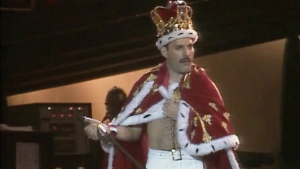
Freddie Mercury. The Magic Tour 1986 © Queen Productions
Embed link:
<iframe width=”560″ height=”315″ src=”https://www.youtube.com/embed/RcXrJN5Zm3M?si=4qOgIwSyNMA6XWJ5” title=”YouTube video player” frameborder=”0″ allow=”accelerometer; autoplay; clipboard-write; encrypted-media; gyroscope; picture-in-picture; web-share” allowfullscreen></iframe>
“What do you want to have in people’s heads as they go out? I think it’s fulfilment. It’s like good sex. You want to come out of it thinking, ‘Yeah, that was everything it should have been’. Brian May
The old showbiz adage – ‘always leave them wanting more’ – has never applied to Queen. Each night, when the band leave the stage for the first time, there is the tacit understanding they will return to sate a crowd still ravenous for anthems. Now, in this week’s exclusive video interview for Queen The Greatest Live, co-founders Brian May and Roger Taylor reveal their unique philosophy to encores.
“I think audiences these days are aware the encore isn’t really the old-fashioned kind, which was, ‘Oh, that was so wonderful, we actually want more’,” says Roger. “It’s built into the show. You’re expecting to play it. They’re expecting to hear it. And our encores have very well-known songs. It would feel quite weird if they’d come to a show and we hadn’t played them. So it’s not a secret.”
As Brian explains, there are practical reasons for a set-break, allowing the band to regroup and rally for the home straight. “You have to go off and refresh at that point because you’ve given everything and you’re like a wet rag at the end of what we’ve done after two-and-a-half hours. You know, you need to go off, change your clothes and take a deep breath for that final push.”
In Queen’s early days, the band might sign off with a bombastic moment like “In The Lap Of The Gods… Revisited,” or even a revved-up cover. “On “Jailhouse Rock,” we could go a bit mad,” reflects Roger. “We used to do “Big Spender” as well.”
But from 1977, the band realized no finale could top the back-to-back singalongs of “We Will Rock You” and “We Are The Champions.” “It’s that participation thing,” says Brian. “The fact the fans can stretch their bodies upwards to the sky and sing and chant and stamp and clap to “Rock You” and “Champions” is kind of an unbeatable thing. You can’t really follow that.”
Ultimately – as another vital element of a Queen show’s ebb and flow – the encore is precision-tooled to leave fans buzzing. “How do you want to send people out?” considers Brian. “It’s a big question, which we do ask ourselves. You know, what do you want to have in people’s heads as they go out? And I think it’s fulfilment. It’s like good sex. You know, you want to come out of it thinking, ‘Yeah, that was everything it should have been’. And you want people to be talking to each other: ‘Ah, that was awesome. Do you remember the bit where…?’ Just like we used to as kids when we left The Who shows.”
Next week: Queen The Greatest Live – “Jailhouse Rock” (Episode 42)
Youtube Playlist Link
https://Queen.lnk.to/TheGreatestLive
YouTube / Instagram / Facebook / Twitter / TikTok
Queen The Greatest series returns with season 2
Queen The Greatest Live a year-long celebration of Queen Live
A 50-week YouTube series going behind the scenes to reveal what goes into creating a
Queen show featuring moments from iconic performances and demonstrating why the band is regarded as the ultimate live act.
https://Queen.lnk.to/TheGreatestLive
Queen The Greatest Live: “Stone Cold Crazy” (Episode 40)
For aspiring British musicians of the ’70s, all roads led to London’s legendary Rainbow Theatre. In 1974, Queen reached that milestone as they stepped up to headliner status – and as this November 1974 archive footage shows, they seized the opportunity with a searing performance of this hard-rocker from Sheer Heart Attack.
The footage is notable as marking the first time Queen were professionally filmed live in concert.
WATCH HERE
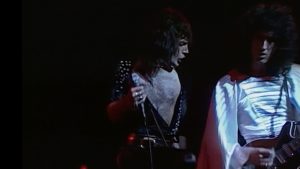
Freddie Mercury, Brian May. Rainbow Theatre, London, 20 November 1974.
© Queen Productions
Embed link:
<iframe width=”560″ height=”315″ src=https://www.youtube.com/embed/wj7obrzGQaw?si=2QVhRYMkzpMKc3JM title=”YouTube video player” frameborder=”0″ allow=”accelerometer; autoplay; clipboard-write; encrypted-media; gyroscope; picture-in-picture; web-share” allowfullscreen></iframe>
No rock band is born in a stadium. Back in the early-’70s, when Queen were a hot tip but not yet a national treasure, the Rainbow Theatre in London’s Finsbury Park was an imposing rite of passage, challenging every group of upcoming hopefuls to prove themselves capable of graduating from the club circuit.
Queen had already braved the Rainbow stage once before as support to Mott The Hoople in 1973. But when Freddie Mercury, Brian May, Roger Taylor and John Deacon returned to headline the 3,000-seater venue the following March and November – promoting that year’s breakthrough albums Queen II and Sheer Heart Attack – the lineup were bristling and bent on proving themselves.
“When I see the footage of us from those shows now, I see so much confidence and adrenalin,” Brian told Mojo in 2014. “And I think, ‘My God, we were such impatient boys.’”
The Rainbow shows have gone down in Queen lore as the moment the band announced their ambitions and stepped up to British rock’s top table. And while the band’s setlist ran the gamut that November, perhaps the most rabble-rousing moment is the pummeling rendition of “Stone Cold Crazy” revisited in this week’s archive footage.
With Roger counting in the band with a bellowed proto-punk ‘1-2-3-4!’, Freddie shooting his rapid-fire vocal without missing a syllable and Brian’s spacey guitar solo scaling the heights of his Red Special’s neck, this highlight from “Sheer Heart Attack” has never sounded so rocking. “When I listen to Queen At The Rainbow now, I find it extraordinary,” said Roger of the live album released in 2014. “I’d forgotten how heavy we were with things like “Stone Cold Crazy” and “Flick Of The Wrist.” We weren’t a pop band. We were like Led Zeppelin with harmonies…”
Next week: Queen The Greatest Live – “The Encore” (Episode 41)
Youtube Playlist Link
https://Queen.lnk.to/TheGreatestLive
YouTube / Instagram / Facebook / Twitter / TikTok
Queen The Greatest series returns with season 2
Queen The Greatest Live a year-long celebration of Queen Live
A 50-week YouTube series going behind the scenes to reveal what goes into creating a
Queen show featuring moments from iconic performances and demonstrating why the band is regarded as the ultimate live act.
https://Queen.lnk.to/TheGreatestLive
Queen The Greatest Live: “A Kind Of Magic” (Episode 39)
Queen pull out a classic from the Highlander soundtrack as they rock Wembley Stadium in the summer of 1986. It’s another triumphant moment in front of a home crowd – not to mention some very unruly inflatable friends.
WATCH HERE
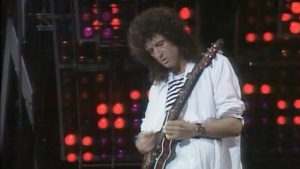
Brian May, Queen performing Wembley Stadium, July 1986
© Queen Productions
Image Download Link
Embed link:
<iframe width=”560″ height=”315″ src=https://www.youtube.com/embed/EJd1ckVnG10?si=LhhFG5W21jlSROoj title=”YouTube video player” frameborder=”0″ allow=”accelerometer; autoplay; clipboard-write; encrypted-media; gyroscope; picture-in-picture; web-share” allowfullscreen></iframe>
Queen might have conquered stadiums around the world, but in the mid-’80s, Freddie Mercury, Brian May, John Deacon and Roger Taylor almost seemed like London’s Wembley Stadium’s house band. While 1985’s Live Aid gave them just 21 minutes to steal the show, for the following summer’s Magic Tour, the band returned to the North London venue for two headliner nights– and had a few more tricks up their sleeve.
Written by Roger Taylor, “A Kind Of Magic” had first featured on the soundtrack to the 1986 fantasy movie Highlander (the band also contributed fan-favorites including “Who Wants To Live Forever” and “Princes Of The Universe”). But while Brian once described the original’s pulsing synth-rock as “quite lugubrious and heavy”, Freddie developed a funkier and lighter-footed treatment that would be re-recorded with producer David Richards.
“Originally, “A Kind Of Magic” was used at the end of the movie, over the closing credits,” Roger recalled. “It was a grander concept with a much more broken-up tempo. Freddie really believed in this song and we reworked it as a single.”
Hitting UK#3 as the third single and title track of 1986’s “A Kind Of Magic” album, the song was already an anthem when Queen arrived at the national stadium that July for two back-to-back performances. “It became very popular onstage,” Roger reflected, “and when we did it on the 1986 Magic Tour, which was our last ever tour, it used to go down incredibly well.”
This week’s archive footage from Wembley proves just how quickly “A Kind Of Magic” had joined Queen’s canon of classics, as Freddie leads the 72,000-strong audience in a mass singalong of the song’s many memorable lines (including the pop-culture perennial, ‘There can be only one’). Meanwhile, in a surreal twist, the band are watched by their own giant inflatable avatars based on the cartoons from the “A Kind Of Magic” album sleeve – with the ‘Freddie’ balloon escaping the stadium and apparently found the next day by a somewhat startled lady half-deflated in her garden several miles away!
Next week : Queen The Greatest Live – “Stone Cold Crazy” (Episode 40)
Youtube Playlist Link
https://Queen.lnk.to/TheGreatestLive
Queen The Greatest series returns with season 2
Queen The Greatest Live a year-long celebration of Queen Live
A 50-week YouTube series going behind the scenes to reveal what goes into creating a
Queen show featuring moments from iconic performances and demonstrating why the band is regarded as the ultimate live act.
https://Queen.lnk.to/TheGreatestLive
Queen The Greatest Live: “Love Of My Life” (Episode 38)
Today, Brazil’s Rock In Rio is an institution – but Queen blazed the trail back in 1985 as headliners of the inaugural festival, performing to more than 400,000 fans over two nights. This week’s episode revisits one of the standout moments from those shows, as Brian and Freddie’s acoustic take on Love Of My Life sparks a community singalong.
WATCH HERE
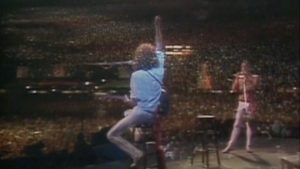
Brian May, Freddie Mercury, Rock In Rio, January 1985
© Queen Productions
Image Download Link
Embed link:
<iframe width=”560″ height=”315″ src=https://www.youtube.com/embed/Tuy_GSz7HX8?si=-BCe0OGf9x3TtFpe title=”YouTube video player” frameborder=”0″ allow=”accelerometer; autoplay; clipboard-write; encrypted-media; gyroscope; picture-in-picture; web-share” allowfullscreen></iframe>
Watched by a human sea of 400,000 fans, Queen’s two-night stand as headliners of 1985’s inaugural Rock In Rio represented rock ‘n’ roll communication on the grandest scale imaginable. In a venue like the City Of Rock – a 2.7-million-square-foot behemoth purpose-built for the festival in Brazil – intimacy seemed impossible. But while their setlist was packed with rowdy rock anthems, this latest episode of Queen The Greatest Live shows the band’s unique ability to make even the biggest stadium show feel personal with a ballad that spoke to every last soul.
Originally featured on 1975’s A Night At The Opera album, the studio version of “Love Of My Life” was intricately orchestrated and featured Queen’s signature flood of vocal harmonies. But as their performance at Rock In Rio reminds us, the ballad became an entirely different proposition live, with Brian rearranging the song for twelve-string acoustic guitar and taking the stage with Freddie Mercury for a stripped-back duet.
As Brian explained in an interview, the song had already proved a crowd-pleaser on previous trips to South America. “I think it’s the moment we first realised they knew Love of My Life. Not only knew it but would sing it. And not only would they sing it but would sing it with a passion that brought tears to our eyes.”
Now, as Brian introduces “Love Of My Life” in Rio – “You want to sing with us?” – the response is deafening, letting Freddie take on the role of choirmaster as he conducts the crowd, basking in their energy, bowing and blowing kisses. And when he takes the lead, his lyrics now seem unbearably poignant (‘When I grow older, I will be there at your side’), in the hindsight knowledge that the Freddie-fronted lineup was nearing the end as a live band.
But that unforgettable night at Rock In Rio, Queen were indomitable, holding the sprawling South American crowd in the palm of their hand. “You did great!” shouts Brian as the song concludes. “You sing very nicely…”
Next week : Queen The Greatest Live – “A Kind Of Magic” (Episode 39)
Youtube Playlist Link
https://Queen.lnk.to/TheGreatestLive
Queen The Greatest series returns with season 2
Queen The Greatest Live a year-long celebration of Queen Live
A 50-week YouTube series going behind the scenes to reveal what goes into creating a
Queen show featuring moments from iconic performances and demonstrating why the band is regarded as the ultimate live act.
https://Queen.lnk.to/TheGreatestLive
Queen The Greatest Live: “Bohemian Rhapsody” (Episode 37)
Since its recording in 1975, “Bohemian Rhapsody” has featured on the setlist at every single Queen show – and Freddie Mercury’s über-ambitious rock opera has never failed to ignite the crowd. Now, enjoy a medley of Queen’s most iconic anthem performed through the ages at some of the world’s most famous venues.
WATCH HERE
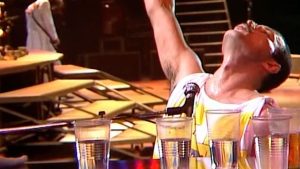
Image Download Link
Embed link:
<iframe width=”560″ height=”315″ src=https://www.youtube.com/embed/5AcoydbNTVY?si=7zYwpAJfrxLbFQdE title=”YouTube video player” frameborder=”0″ allow=”accelerometer; autoplay; clipboard-write; encrypted-media; gyroscope; picture-in-picture; web-share” allowfullscreen></iframe>
From the day it was caught in the bottle at Rockfield Studios for 1975’s A Night At The Opera, “Bohemian Rhapsody” became arguably the greatest of all Queen’s anthems – a shapeshifting six-minute rock opera that stood as a monument to the band’s towering musical ambition. “That one really took us into another league,” Roger Taylor once said of the band’s first UK#1 single. “It was a game-changer.”
Segueing from a cascade of multi-tracked harmonies to headbanging hard-rock, Freddie Mercury’s grandiose composition was perhaps the most challenging song in the catalogue to recreate live – but that didn’t stop “Bohemian Rhapsody” taking up permanent residence on the Queen setlist. Now, in the latest episode of Queen The Greatest Live, a visual medley of iconic performances of the song from across the band’s career reminds us how Queen carried this timeless anthem through the ages and across the world.
Rewind to Hammersmith Odeon in 1975 and an androgynous twenty-something Freddie starts “Bohemian Rhapsody” unaccompanied at the piano, instantly captivating the audience with that evocative first line (‘Mama, just killed a man…’). By 1982, at Seibu Lions Stadium, Tokorozawa, Japan, the singer is topless and slick with sweat, delivering the confessional lyric like a storyteller, with Brian May decorating his vocal with ethereal guitar touches.
At the Milton Keynes Bowl – also in 1982 – the song sounds commanding and fiery, with Freddie’s piano intro flowing into Brian’s aching guitar solo. Then comes the big riff at 1985’s Rock In Rio. “We thought it was kind of pointless to try to recreate that huge, multi-part operatic section with just the four of us,” Brian once explained. “So the solution we came to was, we would go off stage, change our frocks, and come back and crash into the heavy section.”
And finally, join the front row at Wembley Stadium in 1986 for the song’s wistful outro (‘Nothing really matters to me…’), with Freddie triumphantly throwing a fist to the heavens as the rock odyssey of “Bohemian Rhapsody” comes to a close.
Next week : Queen The Greatest Live – “Love Of My Life” (Episode 38)
Youtube Playlist Link
https://Queen.lnk.to/TheGreatestLive
YouTube / Instagram / Facebook / Twitter / TikTok
Queen The Greatest series returns with season 2
Queen The Greatest Live a year-long celebration of Queen Live
A 50-week YouTube series going behind the scenes to reveal what goes into creating a
Queen show featuring moments from iconic performances and demonstrating why the band is regarded as the ultimate live act.
https://Queen.lnk.to/TheGreatestLive
Queen The Greatest Live: “Iconic Venues” (Episode 36)
During their illustrious career, Queen have rocked hundreds of the world’s most iconic venues. In exclusive new interviews, Brian May and Roger Taylor reveal some of their favorites, while recalling the moment they took the remarkable leap from clubs, concert halls and arenas to selling out stadiums across the planet.
WATCH HERE
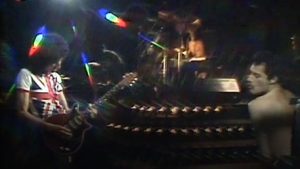
Image Download Link
Embed link:
<iframe width=”560″ height=”315″ src=https://www.youtube.com/embed/xDoWeC-ziT4?si=2Q_slh0hvwkJEPQy title=”YouTube video player” frameborder=”0″ allow=”accelerometer; autoplay; clipboard-write; encrypted-media; gyroscope; picture-in-picture; web-share” allowfullscreen></iframe>
From their first club shows of 1970 to the original lineup’s farewell at Knebworth Park in 1986, Queen must have played every major stage around the globe. Today, the famous venues conquered by the band are part and parcel of the folklore – but as Brian May and Roger Taylor reveal in this week’s exclusive new video interview, some locations are particularly special, even a half-century later.
“Madison Square Garden in New York was top of the list, that was a mythical place for us,” reflects Brian of the Manhattan arena where, coincidentally, the Adam Lambert-fronted band plays two shows on 12/13th October as part of the its 23-date North America tour which began earlier this week. “We knew Zeppelin had played there. First time we played it, it was like, ‘Whoa, we’re treading in these [big shoes]’.”
As for Roger, his own memories lead us to the US West Coast and the fabled Greek-styled arena where Queen triumphed several times at the close of the ’70s and early-’80s. “We used to love places like the L.A. Forum because they’re just great places,” remembers the drummer. “They’ve got something magical. And of course, the audience are great.”
As the venues grew bigger, Roger explains, more thought went into fine-tuning the Queen production, not least killing the lights before showtime. “It’s funny, there’s so many things that go into the making of a show, how good it is, how well it comes over. We try to make it dark.”
And while Wembley will always be central to the band’s story, Brian reminds us that Queen’s ascent to the stadium league actually began on the far side of the Atlantic in ’81. “Playing stadiums instead of arenas happened in South America. We went down there with jumbo jets full of gear to play these football stadiums, not knowing if we would sell them out. We’d been assured by our wonderful tour manager and illustrious manager, Gerry Stickells and Jim Beach: ‘You’re going to fill all these stadiums because you are that big down there’ – even though we’d never been. Suddenly, instead of 18,000 people in an arena, we’re playing outside to 100,000 or even more, 150,000 in the case of some of those places in Argentina and Brazil”
But as Roger reflects, rising to the big occasion was never a problem for Queen. “We wanted our music to be big and so I think we could project it and make it work in big places. I mean, other people have been good at it as well. But I think it was particularly suited to us…”
Next week : Queen The Greatest Live – “Bohemian Rhapsody” (Episode 37)
Youtube Playlist Link
https://Queen.lnk.to/TheGreatestLive
YouTube / Instagram / Facebook / Twitter / TikTok
Queen The Greatest series returns with season 2
Queen The Greatest Live a year-long celebration of Queen Live
A 50-week YouTube series going behind the scenes to reveal what goes into creating a
Queen show featuring moments from iconic performances and demonstrating why the band is regarded as the ultimate live act.
https://Queen.lnk.to/TheGreatestLive
Queen The Greatest Live: “Freddie Mercury – Part 2” (Episode 35)
In this second interview from the archives, Queen’s flamboyant and legendary frontman offers more fascinating insights into how he sees his role on stage. From the importance of connecting with the crowd to why sell-out stadium shows beat the elitism of punk, Freddie tells it in his own words.
WATCH HERE
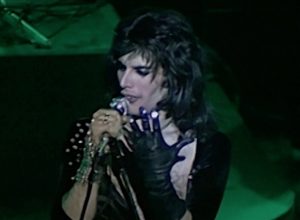
Freddie Mercury. London Rainbow Theatre. November 1974
© Queen Productions
Image Download Link
Embed link:
<iframe width=”560″ height=”315″ src=https://www.youtube.com/embed/a3-wBU7or5o?si=HGzsx-1UdF-V4d5r title=”YouTube video player” frameborder=”0″ allow=”accelerometer; autoplay; clipboard-write; encrypted-media; gyroscope; picture-in-picture; web-share” allowfullscreen></iframe>
“I like the whole world to listen to my music. And I want anybody and everybody to come and listen to me and look at me when I’m playing.”
Freddie Mercury.
Just as each of their voices had its place within the harmony, all four members of Queen took the stage knowing their own distinct role. While guitarist Brian May, drummer Roger Taylor and bassist John Deacon supplied the thrilling musical cut and thrust, frontman Freddie Mercury not only sang lead but stepped up as ringmaster, connecting with every audience, regardless of its size.
As Freddie reveals in this second archive interview episode, working the crowd was never an afterthought. “I have to win them over or it’s not a successful gig. It’s my job to make sure I win them over and make them feel they’ve had a good time. That’s part of my role, part of the duty that I have to do.”
“This cliché of saying, ‘Oh, you have them eating from the palm of your hand’ – I just feel that the quicker I do that, the better, because then I feel I can manipulate them or whatever. But it’s all to do with me feeling in control as so that I know that it’s all going well.”
With Queen wanting their shows to be as entertaining and theatrical as possible, that meant Freddie needed to bring energy, flamboyance and style to every performance – and fortunately for the fans, he never disappointed.
From Queen’s formation in 1970, Freddie bantered with fans between songs. Leading into a performance of “Stone Cold Crazy” at the famed London Rainbow show of ’74, featured here, “Do you like my claws?” he enquires while showing off his jewelled glove “They’re real diamonds. A present from the Devil himself.”
And as Queen ascended to the stadium league, the frontman upped the ante. “I’m very frivolous, and I like to enjoy myself. And what better way than on stage in front of 300,000 people? I don’t like to go on stage sitting on a stool. I’m very volatile and I like to actually put a song across. It’s all part of showbiz and theatre, and that’s another side of me.”
As Queen’s popularity skyrocketed, so did the number of people wanting to see them perform live. For many bands, large venues and massive crowds would be overwhelming – but for Queen, it was what they were all about.
On the flipside, as Freddie explains, the dawning of British punk in 1976 – with its threadbare audiences and shoebox clubs – made no sense to him. “I think everybody wants to be successful. I don’t care what they say. I know there was a fashion with the punk movement or whatever. They said, ‘Oh, we want to play to the small audiences because we’re being intimate’ and all that. Load of rubbish!”
As for Queen, counters Freddie, the band’s mission was always to make music that struck a universal chord. “Everybody wants to play to the biggest audiences. I want to play to as many people as I can and the more the merrier. My music is not channelled into any category. I want everybody to listen to it. Music is for everybody, it’s an international language. Music is limitless, you know.”
“And that’s the way it is. So as far as I’m concerned, I like the whole world to listen to my music. And I want anybody and everybody to come and listen to me and look at me when I’m playing.”
Next Week: Queen The Greatest Live: – “Iconic Venues” (Episode 36)
Youtube Playlist Link
https://Queen.lnk.to/TheGreatestLive
YouTube / Instagram / Facebook / Twitter / TikTok
Queen The Greatest series returns with season 2
Queen The Greatest Live a year-long celebration of Queen Live
A 50-week YouTube series going behind the scenes to reveal what goes into creating a
Queen show featuring moments from iconic performances and demonstrating why the band is regarded as the ultimate live act.
https://Queen.lnk.to/TheGreatestLive
Queen The Greatest Live: “Freddie Mercury – Part 1” (Episode 34)
Freddie Mercury’s flamboyant stage presence was a vital factor in Queen’s status as the greatest live band in the world. In this week’s archive interview, the singer routinely crowned rock’s ultimate showman provides some fascinating insights into how entertaining visual theatrics played a vital part of any Queen show.
WATCH HERE
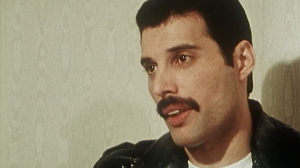
Freddie Mercury.
© Queen Productions
Image Link
Embed link:
<iframe width=”560″ height=”315″ src=https://www.youtube.com/embed/wSw8-XlCcwI?si=TBytHyItdKJS6dW2 title=”YouTube video player” frameborder=”0″ allow=”accelerometer; autoplay; clipboard-write; encrypted-media; gyroscope; picture-in-picture; web-share” allowfullscreen></iframe>
“It’s like, you do your music and then entertainment plus.”
Freddie Mercury.
Part of the reason why Queen are widely regarded as the ultimate live act is the indisputable fact they had one of the greatest front men in the history of rock and roll. In a two-part Queen The Greatest Live special, the series delves back into the archive to get some fascinating insights from Freddie Mercury.
Faced with the force-ten showmanship of Freddie Mercury, resistance was futile. Not for nothing did he scale Classic Rock Magazine’s 2004 poll of the greatest frontmen of all time, and as he explains in this week’s archive interview, thrilling a stadium crowd took more than a facsimile of the studio material.
As we have heard in previous episodes, Queen’s passion for putting on an entertaining show was paramount from the very start. And as Freddie confirms, the visual side of their performance has always been essential.
“People want to be entertained. How boring if we reproduce note-for-note what was on the album,” says Freddie. “People might as well just sit at home and listen to the album. It’s a show, it’s entertainment, and our songs take on a different meaning when we do a stage show.”
“Visual theatrics have always been there from any kind of theatre entertainment. All the greatest acts have used it, in one way or other, like Jimi Hendrix or the Stones. It has to be there. It’s a form of entertainment. It’s like, you do your music and then entertainment plus. And I, sort of personally, you know, I just like doing that anyway. I’d hate to go on stage and just sit and sing my songs. I have to move. It depends on each song. If there’s an aggression in some song I have to show it.”
Right from the start, Freddie pushed the visual theatrics further than any rock ‘n’ roll singer before him. As he reflects, during Queen’s ascent in the early-’70s, you might find him dressed as a harlequin, fluttering amongst the dry ice in a Zandra Rhodes-designed batwing tunic or even pirouetting onto the stage as a ballerina.
“At that time, to introduce a certain kind of balletic look into rock ‘n’ roll was sort of outrageous. And I thought, you know, what’s a real funky rock ‘n’ roll audience going to say to this prancing ballerina coming on? I thought, Fine, I’ll sing my rock ‘n’ roll songs with a tutu on – I don’t care.”
As the scale of Queen’s live shows grew through the 70s and into the 80s, the need to innovate and evolve became even more important. Similarly, Freddie also felt it was vital to pay attention to every last detail.
“We’re learning a lot after every show, and I personally do a lot of research after every show to find out what’s going right, especially like the lights, they’re very sophisticated lights and they can do so much more. I think every day I learn something, you know, ask the lighting man to do something new.”
“We’re interjecting the show with new songs. So, every time we do a new song, we have to have a new light thing. The light cues can be different, you know, forever. I mean, you can have a new show every day if you wanted to.”
All the while, at the heart of every performance was a showman who seemed supercharged by the energy exchange between crowd and band. “I’d hate to go on stage and just sit and sing my songs,” explains Freddie. “I have to move…”
Next Week: Queen The Greatest Live: – “Freddie Mercury –Part 2” (Episode 35)
Youtube Playlist Link
https://Queen.lnk.to/TheGreatestLive
Queen The Greatest series returns with season 2
Queen The Greatest Live a year-long celebration of Queen Live
A 50-week YouTube series going behind the scenes to reveal what goes into creating a
Queen show featuring moments from iconic performances and demonstrating why the band is regarded as the ultimate live act.
https://Queen.lnk.to/TheGreatestLive
Queen The Greatest Live: “Radio Ga Ga” (Episode 33)
There are few better examples of band and audience in total harmony than Roger Taylor’s classic 1984 single “Radio Ga Ga.” Across borders and language barriers, everyone in the stadium knows exactly what to do – and the result is one of the most life-affirming moments of unity that rock ‘n’ roll has to offer.
WATCH HERE
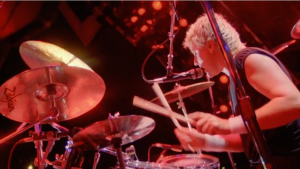
Roger Taylor, Queen performing Nepstadion Budapest July 27, 1986
© Queen Productions
Image Download Link
Embed link:
<iframe width=”560″ height=”315″ src=https://www.youtube.com/embed/DPtRzL7Dl7U?si=dRGtcXfuRH7w-Jna title=”YouTube video player” frameborder=”0″ allow=”accelerometer; autoplay; clipboard-write; encrypted-media; gyroscope; picture-in-picture; web-share” allowfullscreen></iframe>
The Queen audience are a rhythm section in their own right – and as we see in the latest episode of Queen The Greatest Live, when it comes to stadium-shaking handclaps, Radio Ga Ga is a match for even the mighty “We Will Rock You.”
As one of Queen’s defining hits of the ’80s, “Radio Ga Ga” was written by Roger Taylor, who worked for three days straight in the studio with a synth and drum machine to craft this ode to the golden age of the airwaves. “That’s part of what the song’s about, really,” the drummer told the UK’s Breakfast Time presenter Frank Bough as the song hit UK#2 in 1984. “The fact that music videos seem to be taking over almost from the aural side – the visual side seems to be almost more important.”
While the verse felt at once triumphant and wistful, it was “Radio Ga Ga’s” chorus – inviting an almost Pavlovian double-handclap – that gave Queen yet another crowd-participation flashpoint. Yet it took Freddie Mercury to recognize the song’s anthem potential. “I think Roger was thinking about it as just another track,” reflected the singer, who finished off “Radio Ga Ga.” “But I instantly felt there was something in there, a really good, strong, saleable commodity.”
As ever, Freddie was proved emphatically right, with “Radio Ga Ga’s” human percussion ringing out at every Queen show from its release until the original lineup stepped back from the road in the late-’80s. And if you were never lucky enough to be in that sea of hands, catch the atmosphere with this week’s electrifying archive footage from the band’s history-making Hungary’s Népstadion concert on the 1986 Magic Tour.
Next Week: Queen The Greatest Live: – “Freddie Mercury” (Episode 34)
Youtube Playlist Link
https://Queen.lnk.to/TheGreatestLive
YouTube / Instagram / Facebook / Twitter / TikTok
Queen The Greatest series returns with season 2
Queen The Greatest Live a year-long celebration of Queen Live
A 50-week YouTube series going behind the scenes to reveal what goes into creating a
Queen show featuring moments from iconic performances and demonstrating why the band is regarded as the ultimate live act.
https://Queen.lnk.to/TheGreatestLive
Queen The Greatest Live: “Vocal Games” (Episode 32)
Freddie Mercury was the master of crowd interaction – and the bigger the audience, the better. In this clip from Queen’s famous 1982 show at the U.K. Milton Keynes Bowl, the singer challenges the vast crowd to match his vocal acrobatics.
WATCH HERE
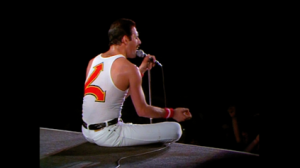
Freddie Mercury, Milton Keynes Bowl, UK, June 5, 1982
© Queen Productions
Image Download Link
“I’m gonna make you sing like Aretha Franklin!”
Embed link:
<iframe width=”560″ height=”315″ src=https://www.youtube.com/embed/0MbKCd71pEI?si=POCBPvor2bgXGSNW title=”YouTube video player” frameborder=”0″ allow=”accelerometer; autoplay; clipboard-write; encrypted-media; gyroscope; picture-in-picture; web-share” allowfullscreen></iframe>
Of all the qualities that routinely see Freddie Mercury crowned the greatest frontman of all time, his ability to connect with a crowd was paramount. As we’ve seen in recent episodes of Queen The Greatest Live, the band intentionally built a call-and-response element into many of their best-known tracks. But that wasn’t enough for Freddie, who often bantered with the fans between songs – and even challenged entire stadiums to keep up with his a capella vocal ad libs.
“That’s part of my role – I have to win the audience over, otherwise it’s not a successful gig,” the singer once explained. “It’s my job to make sure I win them over and make them feel that they’ve had a good time. I’m very frivolous and I like to enjoy myself – and what better way to do it than onstage in front of 300,000 people?”
The most obvious example of Freddie’s vocal games might be the joyous ‘ay-oh!’ section of Queen’s show-stealing performance at 1985’s Live Aid. But for Queen connoisseurs, this week’s episode focuses on a lesser known but equally charming moment from a little earlier in the decade, as the frontman interrupts the band’s summer ’82 show at the U.K. Milton Keynes Bowl to put the capacity crowd through their paces.
“I’m gonna make you sing like Aretha Franklin!” promises Freddie as he sits on the edge of the stage to play choirmaster – and with the crowd doing its best to match his gravity-defying vocal acrobatics, the singer ends with a playful endorsement: “Alright, you can join the band…”
Next Week: Queen The Greatest Live: “Radio Ga Ga” (Episode 33)
Youtube Playlist Link
https://Queen.lnk.to/TheGreatestLive
Queen The Greatest series returns with season 2
Queen The Greatest Live a year-long celebration of Queen Live
A 50-week YouTube series going behind the scenes to reveal what goes into creating a
Queen show featuring moments from iconic performances and demonstrating why the band is regarded as the ultimate live act.
https://Queen.lnk.to/TheGreatestLive
Queen The Greatest Live: “In The Lap Of The Gods” (Episode 31)
No Queen concert is ever short of songs that encourage the fans to sing along, and even before the now legendary combination of “We Will Rock You” and “We Are The Champions” provided the ultimate sing along finale, Queen had plenty of crowd pleasers that unified the audience into one massive chorus – such as
“In The Lap Of The Gods.”
WATCH HERE
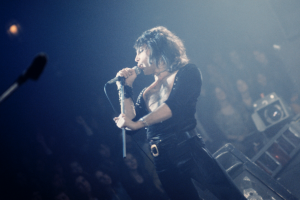
Photo Credit: Johnny Dewe-Matthews
Freddie Mercury “In The Lap of the Gods”
A Night At The Odeon December 24, 1975.
© Queen Productions
Image Download link
Embed link:
<iframe width=”560″ height=”315″ src=https://www.youtube.com/embed/kHZUe1MovZE?si=K1P3lqilRaijjMvVtitle=”YouTube video player” frameborder=”0″ allow=”accelerometer; autoplay; clipboard-write; encrypted-media; gyroscope; picture-in-picture; web-share” allowfullscreen></iframe>
Even with the lineup singing four-way harmonies, there has always been room for a few thousand backing vocalists at a Queen show. As passionate advocates for crowd participation, the band have too many singalongs to list, from “Radio Ga Ga” and “Another One Bites The Dust” to the finale of “We Will Rock You” and “We Are The Champions.” But as we see in the latest episode of Queen The Greatest Live, even the band’s deeper cuts could turn a rowdy stadium in a word-perfect choir.
Opening (and closing) the second side of 1974’s Sheer Heart Attack album, the two versions of “In The Lap Of The Gods” were wrenched from the emotional depths by Freddie Mercury. “In the beginning, a lot of his writing was very fantastical, but underneath, I think he was pouring his heart out,” Brian May told Uncut. “Freddie was struggling with various things and we all know his sexuality was quite fluid. It was hard for him to express. I think you can hear him in this song, struggling with his relationships, putting them into words and music.”
While “Killer Queen” and “Now I’m Here” would be cherrypicked as singles from Sheer Heart Attack, the Queen hardcore always kept the yearning refrain from “In The Lap Of The Gods… Revisited” close to their hearts. And as the band’s Christmas Eve 1975 concert at Hammersmith Odeon hit the home straight, the crowd took no persuasion to join Freddie in a chorus that ached with wordless emotion (‘Whoa, whoa, la, la, la, oh!’).
Fast-forward a decade to 1986’s Magic Tour and the song had lost none of its power to unite, with 144,000 fans at Wembley Stadium swaying in unison as they roared the hook, and the singalong effortlessly crossing the language barrier as the band lit up Budapest’s Népstadion in Hungary. But as Brian told Uncut, it might never have flown without a choirmaster of Mercury’s calibre: “That song is Freddie being magnificent and being a god – which he was quite good at.”
Next week: Queen The Greatest Live: “Vocal Games” (Episode 32)
Youtube Playlist Link
https://Queen.lnk.to/TheGreatestLive
Queen The Greatest series returns with season 2
Queen The Greatest Live a year-long celebration of Queen Live
A 50-week YouTube series going behind the scenes to reveal what goes into creating a
Queen show featuring moments from iconic performances and demonstrating why the band is regarded as the ultimate live act.
https://Queen.lnk.to/TheGreatestLive
Queen The Greatest Live : “The Fans” (Episode 30)
In this week’s exclusive new video interview, Brian May and Roger Taylor explain their unique bond with the Queen audience – and how the fans have influenced everything from the band’s stagecraft to its songwriting direction since the ’70s.
WATCH HERE
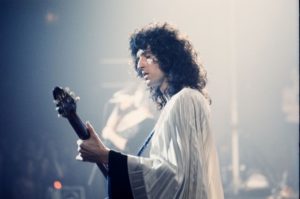
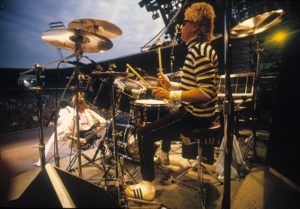
Queen. Brian May (L), Roger Taylor (R)
© Queen Productions
Image Download links:
Brian May Image
Roger Taylor Image
Embed link:
<iframe width=”560″ height=”315″ src=https://www.youtube.com/embed/ff4e1YqwuZotitle=”YouTube video player” frameborder=”0″ allow=”accelerometer; autoplay; clipboard-write; encrypted-media; gyroscope; picture-in-picture; web-share” allowfullscreen></iframe>
“I mean, I remember some bands, the guitar player might even face the back. It’s just f**king rude, you know?” Roger Taylor
“There’s a bouncer telling them not to stand up. That’s not rock and roll. That’s not the way it should be.” Brian May
Queen shows don’t happen in a vacuum. Just as important as the push and pull amongst the four musicians is the energy exchange between stage and audience. Having never subscribed to the ‘untouchable-rock-god’ school of the ’70s, in this week’s exclusive video interview for Queen The Greatest Live, Brian May and Roger Taylor explain how the concert experience still flows both ways.
“I think we have a very personal relationship with the audience,” says Brian. “We don’t get lost in being gods with the costumes and lights. We’re still human and we like the interaction. I think that’s something which is a little different.”
Roger Taylor adds: “And this is a wonderful feeling and we should involve the audience. And, you know, the one thing we weren’t was a shoe gazing… I mean, I remember some bands, the guitar player might even face the back. It’s just f**king rude, you know?”
Famously, it was Queen’s love of audience participation that sparked call-and-response classics like “We Will Rock You,” and as Brian tells us, the fans’ reaction is still the best yardstick for tightening the setlist. “If you put a new song in there and you get a great reaction, you get reinforced and you think, ‘Yeah, we’ll do that again next night’. So the audience are fashioning what we play, and I think they know that. Of course, you go for the things which produce a reaction, whether it’s happy or sad – but some kind of reaction.”
While Queen shows have increasingly encouraged audiences to their feet, as Roger remembers, the fans haven’t always been so free to cut loose, with the band forced in early years to overcome everything from heavy-handed security to authoritarian regimes. “In the ’70s, it was the dreaded bouncers. As soon as anybody stood up, it was, ‘You, sit down, sit down!’ You know, they’d come at you. And we just used to encourage them to riot!”
And if a show still refused to ignite, Queen always had their not-so-secret weapon in the form of ringmaster Freddie Mercury. “He was incredible,” recalls Roger. “He could just shout, ‘Come on!’, and then everybody would get up…”
Next week: Queen The Greatest Live – In The Lap Of The Gods
Youtube Playlist Link
https://Queen.lnk.to/TheGreatestLive
Queen The Greatest series returns with season 2
Queen The Greatest Live a year-long celebration of Queen Live
A 50-week YouTube series going behind the scenes to reveal what goes into creating a
Queen show featuring moments from iconic performances and demonstrating why the band is regarded as the ultimate live act.
https://Queen.lnk.to/TheGreatestLive
Queen The Greatest Live: “An Unforgettable Moment” (Episode 29)
With twists, turns and unexpected pleasures, the Queen live experience has long been built on surprising the audience. And there can be no better example of
that than this unifying moment in Hungary 1986, when the band strayed from
their own catalogue to perform a traditional folk song to create a historic and
truly unforgettable moment.
WATCH HERE
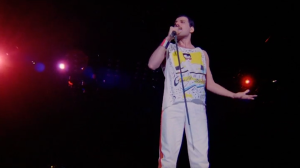
Freddie Mercury, Queen. Nepstadion, Budapest. July 1986
© Queen Productions
Image Download Link
Embed link:
<iframe width=”560″ height=”315″ src=https://www.youtube.com/embed/6rl7q8Vl8I8 title=”YouTube video player” frameborder=”0″ allow=”accelerometer; autoplay; clipboard-write; encrypted-media; gyroscope; picture-in-picture; web-share” allowfullscreen></iframe>
As one of rock’s first truly international bands, Queen have never let the language barrier stand in their way. Having already blazed a trail to South America at the dawn of the ’80s, the lineup broke new ground again on that decade’s Magic Tour, journeying to Hungary for a sell-out show at Budapest’s Népstadion.
Before a note was even played, the show on July 27th, 1986 was loaded with significance, representing the first concert performed by a stadium-league Western European rock band behind the Iron Curtain. “We like going places where it’s a challenge,” noted Brian May – and that certainly applied to a country where Communist strongman György Lázár still held sway.
As seen in the following year’s film release, Queen: Live In Budapest (later repackaged as Hungarian Rhapsody), the Népstadion crowd were word-perfect as the band rolled out the hits (the government’s “lenient restriction on audience behavior” allowed singing and clapping, if not smoking and drinking).
This week’s episode of Queen The Greatest Live captures the electrifying moment when Freddie Mercury and Brian May paused their customary acoustic mini-set for a surprise rendition of the traditional Hungarian folk song, “Tavaszi Szél Vizet Áraszt” (its title roughly translating as “Spring Wind Floods Water”).
Watch closely and you can see Freddie discreetly fan his fingers in order to read the lyrics written phonetically on the palm of his hand. He coped admirably, and the pair’s heartfelt performance – watched by 80,000 fans and heard by a further 45,000 outside the Népstadion – proved a great unifying moment between East and West. “The reaction at that point,” recalled Brian, “was f**king deafening.” He continued:
“That night was amazing, with the Hungarian folk song and the whole atmosphere. It may sound like an exaggeration, but it was like we took a step into infinity that night.”
Next week: Queen The Greatest Live – “The Fans” (Episode 30)
Youtube Playlist Link
https://Queen.lnk.to/TheGreatestLive
Queen The Greatest series returns with season 2
Queen The Greatest Live a year-long celebration of Queen Live
A 50-week YouTube series going behind the scenes to reveal what goes into creating a
Queen show featuring moments from iconic performances and demonstrating why the band is regarded as the ultimate live act.
https://Queen.lnk.to/TheGreatestLive
Queen The Greatest Live: “Big Spender” (Episode 28)
A chance to revisit era-spanning archive footage of Queen’s classic showtune cover, as Freddie gets right to the point – and Brian, Roger and John lay down the bombastic groove – at Hammersmith Odeon in ’75 and Wembley Stadium in ’86
WATCH HERE
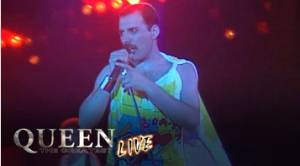
“Now let me get right to the point…”
Freddie Mercury, “Big Spender”
© Queen Productions
Embed link:
<iframe width=”560″ height=”315″ src=https://www.youtube.com/embed/0_gzCWMC9DY title=”YouTube video player” frameborder=”0″ allow=”accelerometer; autoplay; clipboard-write; encrypted-media; gyroscope; picture-in-picture; web-share” allowfullscreen></iframe>
“Could you imagine me doing “Big Spender” when we were first starting? As a rock band? They’d freak. Now we do more a combination of rock ‘n’ roll and theatre.”
-Freddie Mercury
Queen’s kaleidoscope of influences meant almost no song was off-limits as a potential cover. From formative rock ‘n’ roll standards to classic showtunes, the band never ceased to surprise on the stage – but one song that obviously held era-spanning affection was “Big Spender,” showcased by this week’s archive footage from two of the band’s most famous concerts in 1975 and 1986.
With its irresistible gold-digger lyric and fruity flourishes of brass, this timeless showtune was first performed on the Broadway stage in the 1966 musical Sweet Charity. But it’s more likely the song reached Queen’s Freddie Mercury via the definitive rendition by legendary Welsh singer Dame Shirley Bassey, the three-time James Bond soundtrack theme song provider.
As Freddie told Hit Parader in 1977, the decision to expand Queen’s oeuvre was not made lightly. “Sneaking my cabaret influences into our act was done slowly. Could you imagine me doing “Big Spender” when we were first starting? As a rock band? They’d freak. Now we do more a combination of rock ‘n’ roll and theatre.”
Having made that leap of faith, Queen never looked back. This week’s episode opens with footage from Hammersmith Odeon on Christmas Eve 1975, where the band teased the sell-out crowd – and the BBC audience watching at home – by walking offstage after the frenzied finale of “In The Lap Of The Gods.” Finally, with the atmosphere at fever pitch, the band returned to encore with “Big Spender.”
With Roger Taylor pounding his toms in a multi-coloured clown wig, Brian May reimagining the classic brass motif as an anvil-heavy slide guitar riff, and Freddie playing provocatively with the cord of his kimono – before dropping the garment entirely – it’s a bravura performance topped only by the band’s showstopping reprise, eleven years later, at Wembley Stadium.
Next week: Queen The Greatest Live: “An Unforgettable Moment”
Youtube Playlist Link
https://Queen.lnk.to/TheGreatestLive
YouTube / Instagram / Facebook / Twitter / TikTok
Queen The Greatest series returns with season 2
Queen The Greatest Live a year-long celebration of Queen Live
A 50-week YouTube series going behind the scenes to reveal what goes into creating a
Queen show featuring moments from iconic performances and demonstrating why the band is regarded as the ultimate live act.
https://Queen.lnk.to/TheGreatestLive
Queen The Greatest Live: “Tutti Frutti” (Episode 27)
Queen have always been spoilt for choice when it comes to packing setlists with their own crowd-pleasers – but as seen in this special moment from the Magic Tour, the band’s riotous cover version of the Little Richard classic from Wembley ’86 both ignites the stadium crowd and sees the lineup play with the joy of a teenage
garage band.
WATCH HERE
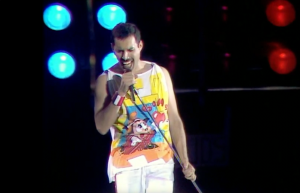
“Tutti Frutti”.
Freddie Mercury, Queen. Wembley Stadium, London. The Magic Tour 1986.
© Queen Productions
Image Download Link
Embed link:
<iframe width=”560″ height=”315″ src=https://www.youtube.com/embed/bZqFwJ0cLco title=”YouTube video player” frameborder=”0″ allow=”accelerometer; autoplay; clipboard-write; encrypted-media; gyroscope; picture-in-picture; web-share” allowfullscreen></iframe>
In last week’s episode of Queen The Greatest Live, Brian May and Roger Taylor revealed how curveballs keep the show fresh for band and fans alike. Whether unplugging for an intimate acoustic set on a ‘B’ stage, splicing hits into a quickfire medley or racing through a formative rock ‘n’ roll cover – the only rule at a Queen concert is to expect the unexpected.
Now, in this archive Wembley Stadium footage from 1986’s Magic Tour, the joy is infectious as the lineup put an inimitable Queen spin on Little Richard’s immortal “Tutti Frutti.” As Brian told Total Guitar earlier this year, the song was a fitting choice for a band who cut their teeth on the R&B trailblazer. “When I first heard Little Richard, it was a moment of shock, but there was also the joy of realising that people could actually sing that way – they could scream their emotions.”
Starting the song half-hidden in moody blue lighting, with Freddie supplying fingerclicks and falsettos, it briefly seems the band have taken a mellow acoustic approach. Then this cover version explodes into a rocket-fuelled rhythm and blues masterclass, with Roger laying down his tambourine for thunderous drum fills, while Brian slings the Red Special for a ferocious solo. Watch closely, too, for the moment when Freddie mimes a golf swing with his sawn-off mic stand.
The 72,000-strong Wembley crowd’s response says it all, with the entire stadium shouting back the “Tutti Frutti” gobbledygook-genius payoff: “A-wop-bop-a-loo-bop, a-lop-bam-boom…!”
Next week: Queen The Greatest Live – “Big Spender” (Episode 28)
Youtube Playlist Link
https://Queen.lnk.to/TheGreatestLive
YouTube / Instagram / Facebook / Twitter / TikTok
072823
Queen The Greatest series returns with season 2
Queen The Greatest Live a year-long celebration of Queen Live
A 50-week YouTube series going behind the scenes to reveal what goes into creating a
Queen show featuring moments from iconic performances and demonstrating why the band is regarded as the ultimate live act.
https://Queen.lnk.to/TheGreatestLive
Queen The Greatest Live: “Expect The Unexpected” (Episode 26)
In an exclusive Queen The Greatest Live interview, Brian May and Roger Taylor reveal how they love to keep the audience on their toes with some well-placed surprises. Guaranteed to create a special and unique experience for fans, and helping keep the band fresh on a long tour, it has led to some truly crowd-pleasing magical moments.
WATCH HERE
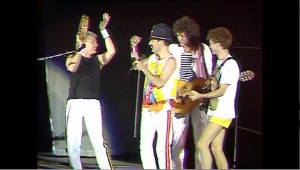
Queen. Wembley Stadium, London. The Magic Tour 1986
© Queen Productions
Episode Embed Link
<iframe width=”560″ height=”315″ src=https://www.youtube.com/embed/evlr10eW3kA title=”YouTube video player” frameborder=”0″ allow=”accelerometer; autoplay; clipboard-write; encrypted-media; gyroscope; picture-in-picture; web-share” allowfullscreen></iframe>
“Why do we cover other people’s songs? It’s just an instinct. Sometimes you just want to give it that thing which you loved when you were a kid. Maybe like ‘Heartbreak Hotel.’” – Brian May
“Those things like ‘Tutti Frutti,’ Little Richard. Yeah. Kind of telling people this is why
we love rock and roll, because these songs really influenced us.” –Roger Taylor
Some 50 years since they first took on the world, Queen continue to be hailed one of the greatest live bands of all time. The band’s legendary 20-minute live performance at Live Aid in 1985 was earlier this month voted by the UK public as the most memorable festival moment of all time, according to a new poll.
Throughout the band’s illustrious touring career, Queen always sought new ways to thrill and surprise their audiences. Band fans quickly came to learn that in attending a Queen show, as seen in this week’s Queen The Greatest Live episode, audiences had learned to Expect The Unexpected.
Offering ‘the unexpected’ in this episode is rare footage of the band performing a rock and roll tribute to their own personal early music heroes – Elvis Presley, Little Richard, and Ricky Nelson, taken from the band’s history-etched Magic Tour July 1986 pair of London Wembley Stadium concerts, the very last concerts the band would perform in the city.
Interacting with their audience has always been a vital part of the Queen live experience. An early innovation into the Queen live show which has evolved over the years to still be an integral part of the band show to this very day, sees Roger Taylor step down from the drum riser and join the rest of the band as they go acoustic at the front of the stage, to give the crowd an up close and personal experience.
Roger Taylor says: “We’ve done that in a number of ways for a long time. We used to have a completely separate stage at the front, which would then actually descend with a little mini bass drum kit on it.
“So we’d come down to the front and it just formed one of the more intimate parts of the show. These days, with this sort of set-up, you can reach out with this long catwalk and really get out into the audience with people, which is very good in arenas. You’re surrounded by audience then, and it’s great. You really feel like you’re in touch with people you know, and you can actually look at people.”
In addition to those moments, and with the intention of giving the crowd full value by packing as much into a show as possible, Queen found a well-constructed medley would keep the audience on their toes as one song suddenly takes a very different direction into another, as seen in this episode as “Bohemian Rhapsody” segues into “Killer Queen.”
Brian May says: “There’s a moment when you think, ‘Oh, isn’t it a shame? Can’t do this song, this song, this song.’ It’s hard to know what to leave out, the thing of too many hits. So what if we could just do a little piece of this and a little bit of that, just little hints of stuff, so people feel like they heard the song. So we used to do quite a long medley of “Killer Queen” and all sorts of other stuff.”
Interestingly, as Brian explains, merging songs in this way is not a task to be taken lightly. “Very often I don’t like other people doing medleys, it kind of puts me off doing them. I see people doing a medley. I think, ‘why don’t you just sing the bloody song?’ Because you do deprive people of the structure of the song and the narrative of the song. So, you don’t get the beginning of the story and the end of the story. You go into another song which can be frustrating. You’ve got to be quite careful with medleys, to be honest.”
But perhaps the most unexpected moment of any tour would be when Freddie, Roger, Brian and John, despite having a wealth of their own songs to choose from, would spring a surprise on their fans by finding the space to cover someone else’s song, as seen here in footage from the 1986 Magic Tour in which the band salute some their own personal favorite songs and artists with a three-song medley of Elvis Presley’s “(You’re So Square ) Baby I Don’t Care,” Ricky Nelson’s “Hello Mary Lou,” and the Little Richard classic “Tutti Frutti.” Recorded live at London’s Wembley Stadium, July 12, 1986, the medley would become a fixture of their final 1986 tour and feature on the band’s Live at Wembley ‘86 double album released late May 1992.
Says Brian: “Why cover other people’s songs? It’s just an instinct. Sometimes you just want to give it that thing which you loved when you were a kid. Maybe like ‘Heartbreak Hotel.’ And every now and again we would want to go into that area. I suppose it refreshes us and sometimes it’s quite refreshing for the audience. It’s out of the blue. They don’t expect it. It just brings something out of you, you can be a bit more reckless with other people’s material than with your own sometimes. Fun. It’s just fun, I guess.”
Roger agrees: “Yeah, absolutely. Those things like ‘Tutti Frutti,’ Little Richard. It’s kind of telling people this is why we love rock and roll, because these songs really influenced us. It’s nice to do those. It keeps our interest up and kind of broadens the show a bit.”
Next week: Queen The Greatest Live – “Tutti Frutti” (Episode 27)
Youtube Playlist Link
https://Queen.lnk.to/TheGreatestLive
YouTube / Instagram / Facebook / Twitter / TikTok
Queen The Greatest series returns with season 2
Queen The Greatest Live a year-long celebration of Queen Live
A 50-week YouTube series going behind the scenes to reveal what goes into creating a
Queen show featuring moments from iconic performances and demonstrating why the band is regarded as the ultimate live act.
https://Queen.lnk.to/TheGreatestLive
Queen The Greatest Live: “Adapting Songs – ‘Seven Seas Of Rhye’” (Episode 25)
From the start, Queen pushed the limits of studio technology to accommodate their exquisite overdubs and intricate harmonies. But perhaps even more impressive was their ability to recreate that onstage without backing tapes or additional musicians, as demonstrated by this iconic November 1974 Rainbow performance
WATCH HERE
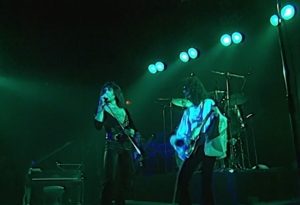
Freddie Mercury, Brian May.
Queen perform London Rainbow Theatre, November 20, 1974
© Queen Productions
Image Download Link
Episode Embed Link
<iframe width=”560″ height=”315″ src=https://www.youtube.com/embed/9APxqGT_HSg title=”YouTube video player” frameborder=”0″ allow=”accelerometer; autoplay; clipboard-write; encrypted-media; gyroscope; picture-in-picture; web-share” allowfullscreen></iframe>
For Queen, the two-night stand at London’s Rainbow Theatre in November 1974 marked a turning point. The year had begun in dispiriting fashion, with the band heckled at January’s Sunbury Pop Festival in Australia by fans demanding home-grown acts, and Brian May felled by hepatitis during the band’s spring US tour under Mott The Hoople. But when the band hit the London Rainbow Theatre stage on November 19th and 20th – now armed with breakthrough album Queen II and their first hit singles in “Seven Seas Of Rhye” and “Killer Queen” – their restored confidence was palpable.
“It’s incredible how much happened to Queen in 1974,” Brian remembered in Mojo magazine. “When I see the footage of us from those shows now, I see so much confidence and adrenaline and I think, My God, we were such impatient boys.”
Filmed at the second night at the Rainbow on November 20th, this week’s archive performance of “Seven Seas Of Rhye” shows a fearless live band already pushing the boundaries of the song that had changed their fortunes. Principally written by Freddie Mercury – and opening with his instant-classic cascading piano part – the song’s success lived up to its all-conquering lyric. Released as the band’s second UK single in February 1974, it was boosted to #10 by their first TV appearance as an eleventh-hour substitute for David Bowie on Top Of The Pops.
Even in those formative years, Queen were experimental and ambitious studio musicians, employing swirls of vocal harmony and multitracked instrumentation to create epic textured soundscapes. Translating that to the stage took an entirely different skill-set, and in this footage – incidentally, the first-ever Queen concert to be filmed and recorded, with an edited version later screened in UK cinemas as the opener to Led Zeppelin’s The Song Remains The Same, before returning to the vaults for two decades – the band’s live mastery is breathtaking.
From Freddie playing one-handed piano while holding the microphone, to Roger Taylor effortlessly hitting the high harmony that some fans assumed was studio trickery on Queen II, this is indisputably the sound of a band at the top of their game. “When I listen to Queen Live At The Rainbow now, I find it extraordinary,” says Taylor of the boxset released in 2014. “I’d forgotten how heavy we were…”
Next week: Queen The Greatest Live: “Expect The Unexpected” (Episode 26)
Youtube Playlist Link
https://Queen.lnk.to/TheGreatestLive
Queen The Greatest series returns with season 2
Queen The Greatest Live a year-long celebration of Queen Live
A 50-week YouTube series going behind the scenes to reveal what goes into creating a
Queen show featuring moments from iconic performances and demonstrating why the band is regarded as the ultimate live act.
https://Queen.lnk.to/TheGreatestLive
Queen The Greatest Live: “Crazy Little Thing Called Love” (Episode 24)
A highlight of any Queen show is the rock and roll classic, “Crazy Little Thing Called Love” – a perfect opportunity for the band to truly let rip. And as evidenced in this
clip from Japan, Brian, Roger, Freddie and John enjoy it as much as the audience does.
WATCH HERE
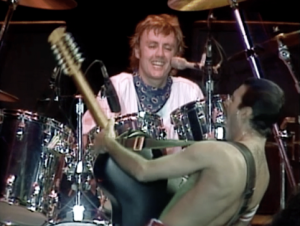
Roger Taylor, Freddie Mercury
Queen Perform Seibu Lions Stadium, Japan, November 1982
© Queen Productions
Image Download Link
Embed link:
<iframe width=”560″ height=”315″ src=https://www.youtube.com/embed/WqDYyAc9zIE title=”YouTube video player” frameborder=”0″ allow=”accelerometer; autoplay; clipboard-write; encrypted-media; gyroscope; picture-in-picture; web-share” allowfullscreen></iframe>
Famously conceived by Freddie Mercury in 1979 amidst the bubbles of his bathtub at Munich’s Bayerischer Hof hotel, “Crazy Little Thing Called Love” has always been one of the most playful songs in the Queen catalogue. But as we see in this week’s live archive footage from Japan ’82, the song evolved on the stage to include an outro jam that found the band flexing their musical muscles.
As the first song in contention for 1980’s The Game at Munich’s Musicland Studios, Crazy Little Thing Called Love moved at pace. “It took me five or ten minutes,” Freddie told Melody Maker of writing the Elvis-inspired foundations. “I did that on the guitar, which I can’t play for nuts, and in one way it was quite a good thing, because I was restricted, knowing only a few chords.”
Perhaps wary of the song vanishing into the ether, Freddie coralled the lineup and urged engineer Reinhold Mack to roll the tape. “Freddie wrote it very quickly and rushed in and put it down with the boys,” Brian May told Absolute Radio. “By the time I got there, it was almost done. And I think the sounds that Mack managed to get – these very elemental, very real, ambient sounds in the studio – had a big contribution to make. It does sound very authentic.”
The pièce de résistance was the period-correct ’50s twang of Brian’s guitar solo, reluctantly performed on Roger Taylor’s Telecaster. “I got bludgeoned into playing it,” said the guitarist. “That was Mack’s idea.”
As the band’s first US#1, Mercury admitted it took “sheer guts and bravery” to strap on a twelve-string acoustic and drive the song’s rockabilly rhythm live. But as we see in this week’s footage, when the Japanese leg of 1982’s Hot Space Tour concluded at Tokorozawa’s Seibu Lions Stadium on November 3rd, the song had become the ideal platform for jamming, with Brian and Freddie gathered around piano player Fred Mandel with the joyous intimacy of a pub lock-in.
As an aside, Mandel would also join Brian and Eddie Van Halen in April 1983 at LA’s Record Plant for the near-mythical Star Fleet Project sessions – and four decades later, the thrilling results can be heard on the enhanced 40th Anniversary Edition, out July 14th on CD, vinyl and LP deluxe boxset.
Next week : Queen The Greatest Live: “Seven Seas Of Rhye”
Youtube Playlist Link
https://Queen.lnk.to/TheGreatestLive
YouTube / Instagram / Facebook / Twitter / TikTok
Queen The Greatest series returns with season 2
Queen The Greatest Live a year-long celebration of Queen Live
A 50-week YouTube series going behind the scenes to reveal what goes into creating a
Queen show featuring moments from iconic performances and demonstrating why the band is regarded as the ultimate live act.
https://Queen.lnk.to/TheGreatestLive
Queen The Greatest Live: “Another One Bites The Dust” (Episode 23)
Never satisfied to simply standing on stage and recreating their studio recordings note-for-note, Queen have always seized the opportunity to improvise on even their biggest hits – as this rousing version of “Another One Bites The Dust” demonstrates.
WATCH HERE
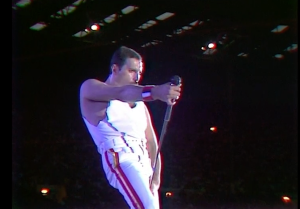
Freddie Mercury, Wembley Stadium, London, July 1986
© Queen Productions
Embed link:
<iframe width=”560″ height=”315″ src=https://www.youtube.com/embed/b1XYudmhiKk title=”YouTube video player” frameborder=”0″ allow=”accelerometer; autoplay; clipboard-write; encrypted-media; gyroscope; picture-in-picture; web-share” allowfullscreen></iframe>
As we have previously heard from Roger and Brian, the adaptation of Queen songs is not just how they transfer from studio to stage, but how their desire to make them an even more inclusive experience for the audience sees them continually evolve through new interpretations.
Queen’s live musicianship means no song is set in stone. Improvs erupt, outros are jammed out, arrangements are bent out of shape and audiences are brought into the mix as backup singers – all with Freddie Mercury effortlessly controlling the impulsive push and pull.
Nowhere is Queen’s free-form approach to performance better demonstrated than in this week’s archive footage from the first of their two magical nights at Wembley Stadium in July 1986, in which the band settle into an impromptu groove of fan-favourite single “Another One Bites The Dust,” allowing Freddie Mercury to demonstrate his mastery at playing with a crowd.
When John Deacon first presented his iconic bassline at Munich’s Musicland Studios, it was deceptively simple: just three notes played on a single string, but already pulsing with potential. “I listened to a lot of soul music when I was in school and I’ve always been interested in that sort of music,” Deacon told Bassist & Bass Techniques. “I’d been wanting to do a track like “Another One Bites The Dust” for a while, but originally all I had was the line and the bass riff. I could hear it as a song for dancing but had no idea it would become as big as it did.”
Brian May recalls that Deacon was “totally in his own world and came up with this thing, which was nothing like what we were doing.” But the line-up built a classic anthem from that spare groove, with Mercury so enthused that “he sang until his throat bled.” When “Another One Bites The Dust” was released as a single in August 1980 – at the suggestion of Michael Jackson – it became Queen’s biggest hit of the decade.
Six years later, on the Magic Tour that proved to be Queen’s final outing fronted by Freddie Mercury, the song had evolved further still, with Deacon’s bassline and Roger Taylor’s propulsive beat anchoring the performance while the singer led a thrilling call-and-response with the 72,000-strong Wembley crowd and May coaxed off-the-cuff funk licks from his Red Special guitar.
Next Week: Queen The Greatest Live – “Crazy Little Thing Called Love”
Youtube Playlist Link
https://Queen.lnk.to/TheGreatestLive
YouTube / Instagram / Facebook / Twitter / TikTok
Queen The Greatest series returns with season 2
Queen The Greatest Live a year-long celebration of Queen Live
A 50-week YouTube series going behind the scenes to reveal what goes into creating a
Queen show featuring moments from iconic performances and demonstrating why the band is regarded as the ultimate live act.
https://Queen.lnk.to/TheGreatestLive
Queen The Greatest Live: “We Will Rock You” (Episode 22)
Continuing the exploration of how Queen songs are adapted from studio to stage, we revisit archive footage of one of the band’s all-time classics to discover how that transition can often inspire unexpected results.
WATCH HERE
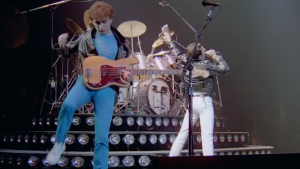
Queen Live at the Forum, Montreal, 1981
© Queen Productions Ltd
Episode Embed link:
<iframe width=”560″ height=”315″ src=https://www.youtube.com/embed/6qP9MrsMemU title=”YouTube video player” frameborder=”0″ allow=”accelerometer; autoplay; clipboard-write; encrypted-media; gyroscope; picture-in-picture; web-share” allowfullscreen></iframe>
Few songs have remained at the heart of popular culture like “We Will Rock You” – and Queen’s classic anthem has evolved alongside the changing times. When Brian May presented the song for 1977’s News Of The World, the band tracked the original studio version without drums (all four members instead supplying foot stamps and handclaps). “I wasn’t sure if it was going to sound like a proper song,” Brian told Guitar World. “But as soon as I heard Freddie singing it, I started to be more confident, because he sounded like a kind of rabble-rouser.”
Played live on that year’s News Of The World tour and rapidly earning its enduring status as a must-play setlist highlight (usually followed by “We Are The Champions”), “We Will Rock You” has shed its skin countless times. In last week’s episode of Queen The Greatest Live, Brian explained how the Queen crowd claimed ownership of the song’s addictive beat (“It’s become a drum extravaganza… the audience sing it, and the physicality is there.”)
Now, rare archive footage reveals how the band reimagined”We Will Rock You” through the eras, toying with tempo, instrumentation and many other variables. Opening with the famous show at Budapest’s Népstadion on July 27, 1986, we watch the performance that cleaves closest to the studio original, with Roger Taylor driving the iconic rhythm at a leisurely pace on his floor toms and snare.
But a speedier version of “We Will Rock You” always existed in parallel, and the song becomes a very different beast at a 1977 show in Houston, as Brian attacks his Red Special guitar with an almost punky aggression while a leather-jacketed Freddie shoots his vocal from the lip. The song flexes its muscles once again at Queen’s fabled 1982 show at the Milton Keynes Bowl, while the band’s four-way vocal harmonies seemed more prominent than ever when they chose “We Will Rock You” as the opener at Montreal’s Forum in November 1981.
Next week: Queen The Greatest Live – “Another One Bites The Dust”
YouTube Playlist Link:
https://Queen.lnk.to/TheGreatestLive
YouTube / Instagram / Facebook / Twitter / TikTok
Queen The Greatest series returns with season 2
Queen The Greatest Live a year-long celebration of Queen Live
A 50-week YouTube series going behind the scenes to reveal what goes into creating a
Queen show featuring moments from iconic performances and demonstrating why the band is regarded as the ultimate live act.
https://Queen.lnk.to/TheGreatestLive
Queen The Greatest Live: Adapting Songs (Episode 21)
In exclusive new interviews with Roger Taylor and Brian May, we explore how some of Queen’s masterful studio creations transferred to the stage and evolved into live classics, sometimes in ways that surprised even the band themselves
WATCH HERE
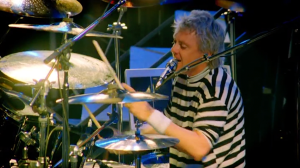
Roger Taylor, Queen, perform Seven Seas of Rhye, Nepstadion, Budapest 1986
© Queen Productions Ltd
Episode Embed link:
<iframe width=”560″ height=”315″ src=https://www.youtube.com/embed/JGW8WMxQkiE title=”YouTube video player” frameborder=”0″ allow=”accelerometer; autoplay; clipboard-write; encrypted-media; gyroscope; picture-in-picture; web-share” allowfullscreen></iframe>
For Queen, the stage and studio were two sides of the same coin. While hard rock anthems like “Sheer Heart Attack” and “I Want It All” were inevitably bound for the stage, intricate studio productions like “The Miracle” always seemed better-suited to headphones than the front row of a stadium.
Now, this latest episode of Queen The Greatest Live explores a third category – the songs that transcended their studio roots to become entirely different beasts live. In new interviews with Brian and Roger, this episode explores with the process of taking songs that were crafted in the studio and adapting them for the stage.
“I think some songs are written with the idea of how it might sound live, like ‘Sheer Heart Attack’ for instance,” say Roger Taylor. “I always thought that would go, that would play, if we play that fast, that will go live.”
Says Brian May, “I think there’s various processes. Sometimes you’re in the middle of writing a song in the studio and you think, how would that be live? And it actually informs your recording process because you’ve fashioned it towards being a sort of live feeling kind of track, something like ‘I Want It All,’ it’s pretty much designed to be a live track. Other songs not. Something like ‘The Miracle.’ I don’t think that was ever envisaged to be a live song, and it never was. It was purely a creation in the studio, something which would be hard to reproduce on stage.”
While the band knew instinctively that some songs would never be right for the live shows, there were others they believed, with a slightly different approach, would result in a truly special moment with the fans.
First featured on 1975’s A Night At The Opera, the studio original had been an ambitious production, with the frontman performing classically influenced piano and vocal harmonies, while Brian layered harp parts alongside his customary guitar. Now, talking in this latest episode, Brian explains how he rearranged “Love Of My Life” for the duets that became a highlight of Queen’s live shows of the era.
Says Brian: “We had this piano song, which would have been very difficult to do live. It’s got all these beautiful overdubs of harmonies. How would you do it live? And I remember just sitting with Freddie and going, ‘Well, we could do it acoustic and you could just sing it.’ It happened quite quickly. I just found ways of doing it, which are actually not very close to the record, but it compressed it all into something we could perform quite easily and we could invite the audience to sing with us – which they did.”
With other songs, the Queen crowd could sometimes play a pivotal role in the transition from studio to stage. The band always intended “We Will Rock You” to spark a call and response with their fans – but as Brian explains, the song’s live incarnation has travelled a long way from its roots on 1977’s News Of The World.
“It’s different live. For a start, there’s no drums on the original recorded version. It’s become a drum extravaganza and the audience do sing it. The stamping and clapping thing has evolved into a completely incomprehensible situation because some people will go ‘bump bump punch,’ some people go ‘boom, boom, punch.’ But it doesn’t matter, because the physicality is there and they sing it, and obviously it’s a staple – it’s always going to be with us, same with ‘Champions.’
“So yeah, it’s moments of discovery. I love waking up in the middle of the night and thinking, ‘Oh, we can do this.’ We could do this.’ And you go in, ‘can we try this,’ and then you go, ‘actually, yeah, that could work, that can pretty much work.”
Next week: Queen The Greatest Live – “We Will Rock You”
YouTube Playlist Link:
https://Queen.lnk.to/TheGreatestLive
Queen The Greatest series returns with season 2
Queen The Greatest Live a year-long celebration of Queen Live
A 50-week YouTube series going behind the scenes to reveal what goes into creating a
Queen show featuring moments from iconic performances and demonstrating why the band is regarded as the ultimate live act.
https://Queen.lnk.to/TheGreatestLive
Queen The Greatest Live: “Is This The World We Created…?” (Episode 20)
Revisiting a memorably moving moment from Queen’s Wembley ’86 concert, where Freddie Mercury’s impassioned vocal and Brian May’s acoustic fretwork made for a performance as mesmerising as any of the band’s stadium-rocking anthems.
WATCH HERE
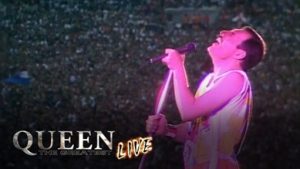
Freddie Mercury. Queen Wembley Stadium
Magic Tour. July 11/12, 1986 © Queen Productions Ltd
Episode Embed link:
<iframe width=”560″ height=”315″ src=https://www.youtube.com/embed/GsA4LoNIosE title=”YouTube video player” frameborder=”0″ allow=”accelerometer; autoplay; clipboard-write; encrypted-media; gyroscope; picture-in-picture; web-share” allowfullscreen></iframe>
Intimate isn’t a term typically associated with stadium shows. But while Queen took the stage for their two Magic Tour sell-out Wembley Stadium concerts of July 1986 armed with epic production and grandstanding rock ‘n’ roll anthems, just as powerful were the stripped-back acoustic numbers that made every member of the 72,000-strong crowd feel like the band was performing just for them.
In recent episodes of Queen The Greatest Live, we’ve heard from Brian May and Roger Taylor about the all-important ‘shape’ of a Queen setlist: the art of building and releasing tension, directing mood and sending fans home walking on air with the grand finale.
Now, in this archive footage from the band’s 1986 Magic Tour, we see how the explosive opening hits at Wembley – which included “One Vision” and “Tie Your Mother Down” – were temporarily traded for a more intimate acoustic section in which Brian accompanied Freddie Mercury on a stunning rendition of “Is This The World We Created…?”
With Brian writing the music and Freddie penning most of the lyric – the pair having watched an agonising documentary on the African famine of the ’80s – this contemplative ballad from 1984’s The Works album also proved a live favorite, taking a pumped-up crowd to an entirely different headspace. And as we can see, the audience are just as captivated here, as at any other point in the show.
A year earlier at the same venue, “Is This The World We Created…?” had been a highlight of the Live Aid benefit concert’s finale. Now, this stunning duet from the band’s own ’86 Wembley show lays the song beautifully bare, with Brian’s deft fingerstyle on a nylon-string classical guitar carrying Freddie’s yearning vocal.
Next week: Queen The Greatest Live – “Adapting Songs”
YouTube Playlist Link:
https://Queen.lnk.to/TheGreatestLive
YouTube / Instagram / Facebook / Twitter / TikTok
Queen The Greatest series returns with season 2
Queen The Greatest Live a year-long celebration of Queen Live
A 50-week YouTube series going behind the scenes to reveal what goes into creating a
Queen show featuring moments from iconic performances and demonstrating why the band is regarded as the ultimate live act.
https://Queen.lnk.to/TheGreatestLive
Queen The Greatest Live: “Dragon Attack” (Episode 19)
Queen might have countless hit songs to choose from, but when it comes to building the setlist, the band has always stirred in a few surprises to keep the audience on their toes. In this latest episode, we revisit a pulsating performance of
“Dragon Attack” that unexpectedly segues into a crowd-pleasing classic.
WATCH HERE
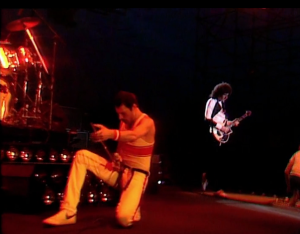
Queen. Hot Space Tour, Milton Keynes Bowl, June 5, 1982
Photo Credit: © Queen Productions Ltd
Image Download Link:
https://umusic.box.com/s/028mgoxc3wc6u3ayz2nslxmv6hp9zk2b
Episode Embed link:
<iframe width=”560″ height=”315″ src=https://www.youtube.com/embed/K3sDeEy5X-k title=”YouTube video player” frameborder=”0″ allow=”accelerometer; autoplay; clipboard-write; encrypted-media; gyroscope; picture-in-picture; web-share” allowfullscreen></iframe>
Some songs are non-negotiable on a Queen setlist. A concert without such stone-cold anthems as “Another One Bites The Dust,” “Radio Ga Ga” and “We Will Rock You” – to name but three – would be unthinkable. But with a vast discography and wealth of deeper cuts at their disposal, the band have always thrown curveballs into the setlist for the Queen hardcore – often segueing effortlessly between numbers in the heat of the moment.
In this latest episode of Queen The Greatest Live, we catch up with the band at the Milton Keynes Bowl, Buckinghamshire, on June 5th, 1982 – a legendary show that saw Brian May’s jaw-dropping guitar showcase “Dragon Attack” transformed on a (silver) sixpence into a second crowd-pleaser.
Released as the B-side of the “Another One Bites The Dust” single – and a highlight of 1980’s The Game album – the song’s fiery, funky fretwork was flavoured by the long nights the line-up spent at Munich’s downtown discotheque Sugar Shack while recording at Musicland Studios. The club is even referenced in the “Dragon Attack” lyric (‘Take me to the room where the black’s all white and the white’s all black/Take me back to the Shack,’ sings Freddie Mercury).
“It was done very late one night, or early one morning, probably very drunk,” explained Brian of the recording. But perhaps “Dragon Attack” was always most suited to the stage, with the song performed consistently between 1980 and 1985, and its elastic format often thrillingly jammed out by the band.
For this particularly memorable performance – and to the delight of the Milton Keynes crowd – “Dragon Attack” suddenly flows into a reprise of fan-favorite anthem “Now I’m Here,” from 1974’s Sheer Heart Attack. And for the eagle-eyed, look out for the moment right at the start when Brian breaks a guitar string on his Red Special – but switches to a spare and soldiers on.
Next week: Queen The Greatest Live: “Is This The World We Created”
YouTube Playlist Link:
https://Queen.lnk.to/TheGreatestLive
YouTube / Instagram / Facebook / Twitter / TikTok
Queen The Greatest series returns with season 2
Queen The Greatest Live a year-long celebration of Queen Live
A 50-week YouTube series going behind the scenes to reveal what goes into creating a
Queen show featuring moments from iconic performances and demonstrating why the band is regarded as the ultimate live act.
https://Queen.lnk.to/TheGreatestLive
Queen The Greatest Live: “Opening Magic” (Episode 18)
Highlighting how Queen were masters at creating a set list with an explosive opening, we return to Budapest in1986, the site of one of the band’s most legendary shows, to see that in glorious action.
WATCH HERE
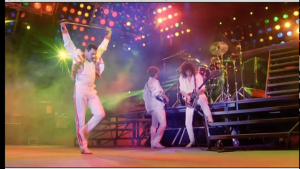
Queen. Budapest, Nepstadion. July 27, 1986
Image Download Link
https://www.dropbox.com/s/3miqxv4df8bn8ef/Budapest%2086.png?dl=0
Episode Embed link:
<iframe width=”560″ height=”315″ src=https://www.youtube.com/embed/J0yednJzIXY title=”YouTube video player” frameborder=”0″ allow=”accelerometer; autoplay; clipboard-write; encrypted-media; gyroscope; picture-in-picture; web-share” allowfullscreen></iframe>
In the last episode, Roger and Brian both spoke about the importance of an adrenaline filled beginning to a Queen live show. The Magic Tour in 1986 is a prime example of one such explosive opening.
Re-energerised after their triumphant performance at Live Aid the previous summer of 1985, Queen determined to get back on the road and prove they still had the magic to dazzle their audiences.
Announcing their 1986 The Magic Tour, which would see the band back on stage in the UK and across nine European countries, Roger Taylor said “I think we’re probably the best live band in the world at the moment, and we’re going to prove it. No one who comes to see us will be disappointed.” His comments would prove not to be exaggerated.
The ’86 tour would, according to Taylor, feature the most elaborate lighting set-up ever seen in a Queen show. It would also be the most ambitious (and expensive) stage production ever undertaken.
Out would go their previous show set, now drastically reworked. Now opening the show instead of the regular opener “Machines” would come instead the band’s only single release of the previous year, “One Vision” released November 1985, which had provided them with a positive conclusion to the year, charting top 10. “One Vision” is followed by the show staple, “Tie Your Mother Down.”
In this episode, filmed at the band’s historic Budapest Nepstadion show, on July 27, 1986 ,we see how the band’s new set list and Roger’s promise of proving themselves the best live band in the world crystalise, as the band bombard the ecstatic audience with the first two numbers without giving them a chance to draw breath. Pure magic.
Next week : Queen The Greatest Live: “Dragon Attack”
YouTube Playlist Link:
https://Queen.lnk.to/TheGreatestLive
“Queen The Greatest Live”
The Greatest series returns with
a year-long celebration of Queen Live.
A 50-week YouTube series going behind the scenes to reveal what goes into creating a Queen show, featuring moments from iconic performances and demonstrating why the band is regarded as the ultimate live act.
https://Queen.lnk.to/TheGreatestLive
Queen The Greatest Live: Set List (Episode 17)
When it comes to creating a live show, nothing could be more crucial than the choice of songs to be included. Over the years, Queen created a killer formula that ensured anyone attending one of their shows was in for an unforgettable experience. Here, Brian and Roger reveal the secrets behind that all important Set List.
“Come on big, give them what they’ve been waiting for.” Brian May.
“I think we like to send our audiences home feeling they’ve had a real experience…” Roger Taylor.
WATCH HERE
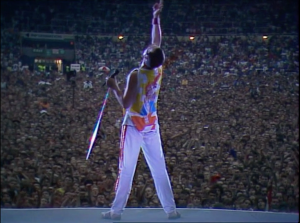
Freddie Mercury. © Queen Productions Ltd
Image Download Link
Embed link:
<iframe width=”560″ height=”315″ src=https://www.youtube.com/embed/UuHAz-y4tfstitle=”YouTube video player” frameborder=”0″ allow=”accelerometer; autoplay;
clipboard-write; encrypted-media; gyroscope; picture-in-picture; web-share” allowfullscreen></iframe>
In recent episodes of Queen The Greatest Live, we’ve heard about the band’s philosophy of starting shows hard and fast. This week, in exclusive new interviews with Brian May and Roger Taylor, we discover how a well-structured set list can build atmosphere and shift mood, holding fans rapt until the final note of We Are The Champions.
Says Brian: “Set lists are a very interesting case. You have all these songs and everything and what is the optimum way to put them across? Do you just go in there and randomly work your way through where you can and that’s how everybody starts. But wouldn’t it be nice if you can take the audience on a journey and optimize the mood that happens?”
“The thing is, you want to quit before they want you to quit, you have to kind of be a little bit ahead of the game and we evolved this kind of shape to a show which is basically come on big. I mean, there are variations of this, but the shape was generally, come on big, give them what they’ve been waiting for.”
“They’re full of adrenaline. They want to rock hard, hard, hard. So the first two or three songs hit them hard in different ways, different tempos, different kind of atmospheres, but all hard rock.”
Roger Taylor: “It’s really you try and make an impact with the first song visual and obviously sort of an aural attack really. And and then you try and space the songs intelligently, but you really want to go bang, bang, bang, bang at the beginning of a show.”
“And then the show can just take its normal sort of course and we meander all over the place with different styles of stuff, and then you’ll have a sort of hiatus, a sort of calm spot, which is normally Brian, he’s very good at that. He’ll just have an acoustic guitar at the beginning. We’ll do something on our B stage, which is like right up into the audience, which is much more sort of close contact, you know, and more intimate.”
Long-standing fans will fondly remember Brian and Freddie Mercury’s acoustic sets, holding vast stadiums in the palm of their hands with the band’s most thoughtful songs like Is This The World We Created and Love Of My Life.
Brian May: “I don’t know if anyone had ever done that in the way that we did it, but you really take them down to rock bottom because you abandon all your pizzazz and all your sort of dramatic effects and everything.”
“I go, at the moment, it’s mainly me that goes out. I go out, I have just an acoustic guitar. I’m right in the middle of the auditorium and I’m kind of naked. There is nothing else going on except me trying to be close to the audience. That’s the sort of lowest you go in terms of energy and and drama, I suppose. “
Roger Taylor: “And so that would be that bit and hopefully that’s quite exciting in a different way. And then we’ll go back to the main stage for the sort of big grand run up to the end of the show, which is the sort of quite big numbers, you know, sort of big grand spectacular numbers.”
Brian May: “And at that moment we have like The Show Must Go On, Radio Gaga, We Will Rock You, We Are The Champions. And you can’t go far wrong with that because you’re building and building and building the whole time and you’re giving people basically what they’ve come to see.”
Roger Taylor: “And it’s as if they were made for that, but they weren’t. But that’s just the way it’s turned out over the years. I think we like to send our audiences home feeling they’ve had a real experience.”
YouTube Playlist Link:
https://Queen.lnk.to/TheGreatestLive
Next week : Queen The Greatest Live – Opening Magic
Website / YouTube / Instagram / Facebook / Twitter / TikTok
Queen The Greatest series returns with season 2
Queen The Greatest Live a year-long celebration of Queen Live
A 50-week YouTube series going behind the scenes to reveal what goes into creating a
Queen show featuring moments from iconic performances and demonstrating why the band is regarded as the ultimate live act.
https://Queen.lnk.to/TheGreatestLive
Queen The Greatest Live: “Under Pressure” (Episode 16)
A compilation of four performances of Under Pressure from some of Queen’s most spectacular concerts throughout the ’80s. It was a decade that saw Queen at the peak of their powers, and as this episode demonstrates, the sound and vision of their live act continued to astound audiences around the world.
WATCH HERE
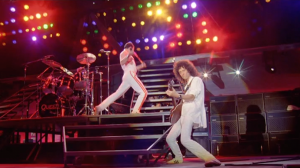
Queen, Wembley Stadium, London, July 1986
© Queen Productions Ltd
Embed link:
<iframe width=”560″ height=”315″ src=https://www.youtube.com/embed/BlkX5co2BUc title=”YouTube video player” frameborder=”0″ allow=”accelerometer; autoplay; clipboard-write; encrypted-media; gyroscope; picture-in-picture; web-share” allowfullscreen></iframe>
Creatively and commercially, Queen spent the ’80s on the top of the world. Throughout that imperious decade, the band’s fearless studio work flowed into their most ambitious live shows, as the lineup embraced the stadium league with production that pushed the limits of sound, lighting, visual effects and stagewear.
In this latest episode of Queen The Greatest Live, we revisit four vintage performances of “Under Pressure,” the fan-favourite single that rose to UK #1 in October 1981 and proved a live highlight in this period. Led by John Deacon’s instant-classic two-note bassline, and featuring dovetailing vocals by Freddie Mercury and a guesting David Bowie, the song had been recorded during a marathon wine-fuelled 24-hour session at Montreux’s Mountain Studios.
“You already had four precocious boys, and David, who was precocious enough for all of us,” recalled Brian May in Mojo. “Passions ran very high. I found it very hard because I got so little of my own way. But David had a real vision and he took over the song lyrically.”
On the stage, however, Queen claimed “Under Pressure” as their own, right down to the head-turning stagewear that gave the song an added dimension. The first performance in the compilation sees Freddie take command of the Milton Keynes Bowl on June 5th, 1982 of the band’s Hot Space tour (a show later released as Queen On Fire: Live At The Bowl). Fast-forward to May 1985 and we find the lineup rocking Japan as part of a six-date visit by an increasingly global band. Almost as far-flung is Queen’s historic Hungary show at Budapest’s Nepstadion on July 27th, 1986, offering a rare release to the 80,000-strong crowd in a nation still held in the grip of Communist strongman György Lázár.
The final section sees Queen return to their home turf of Wembley Stadium, where on July 11th and 12th, 1986, Freddie rose to the occasion in his iconic Diana Moseley-designed military-style yellow cropped jacket – for what would prove to be his last-ever performances in the capital.
YouTube Playlist Link:
https://Queen.lnk.to/TheGreatestLive
YouTube / Instagram / Facebook / Twitter / TikTok
Queen The Greatest series returns with season 2
Queen The Greatest Live a year-long celebration of Queen Live
A 50-week YouTube series going behind the scenes to reveal what goes into creating a
Queen show featuring moments from iconic performances and demonstrating why the band is regarded as the ultimate live act.
https://Queen.lnk.to/TheGreatestLive
Queen The Greatest Live: “Sheer Heart Attack” (Episode 15)
Queen’s musical evolution in the late-’70s and early-’80s ran alongside their ever-changing stagewear. In this episode, a compilation of three classic performances of Roger Taylor’s hard-hitting “Sheer Heart Attack” showcases how the band’s look developed during this fascinating creative period.
WATCH HERE
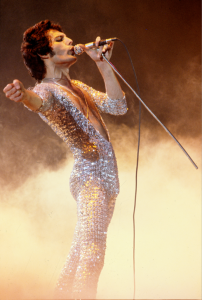
Freddie Mercury, Houston, The Summit, December 11, 1977
Credit: Neal Preston © Queen Productions Ltd
Episode Embed link:
<iframe width=”560″ height=”315″ src=https://www.youtube.com/embed/8PjXVjTegkI title=”YouTube video player” frameborder=”0″ allow=”accelerometer; autoplay; clipboard-write; encrypted-media; gyroscope; picture-in-picture; web-share” allowfullscreen></iframe>
The late-’70s and early-’80s was a period of lightning-fast evolution for Queen. With the band’s studio discography growing rapidly – and each record pushing the envelope a little more – the stage became a space for the lineup to showcase their latest metamorphosis.
This latest episode of Queen The Greatest Live revisits three classic performances of the Roger Taylor-penned Sheer Heart Attack, filmed over a four-year period, with Freddie Mercury utterly transforming himself between 1977, 1979 and 1981.
As we can see in this compilation, although the Glam Rock influence was receding, Freddie’s passion for Ballet continued to shine through before, like Brian, Roger and John, he embraced the more minimalist, but no less dramatic looks of the late 70’s and early 80’s.
As Julian Day, costume designer of 2018’s Bohemian Rhapsody biopic movie, once told Vogue: “I don’t think Freddie ever followed fashion as such.” Instead, the singer fused his own kaleidoscope of passions into his increasingly head-turning stagewear, whether that was the inspiration of glam-rock, ballet, theatre, monarchy or club life. And as Freddie told biographer Lesley-Ann Jones, performing was a chance to slip his identity: “I change when I walk out onstage.”
In the episode’s first clip, filmed at Houston’s The Summit on December 11th, 1977, Queen contrast one of the hardest-rocking songs from that year’s News Of The World album with Freddie’s androgynous choice of a silver sequin catsuit slashed to the navel.
Fast-forward to the Hammersmith Odeon on December 26th, 1979 – the final date of Queen’s Crazy Tour, for which the band were approached by Paul McCartney to raise funds for the people of war-torn Kampuchea – and Freddie is unrecognisable, performing the song stripped to the waist in red leather pants.
Finally, at the Montreal Forum in November 1981, Freddie takes a minimalist approach with red neckerchief and clubbing vogue tiny white shorts. No wonder, as the singer once stated: “It’s not a performance you’re seeing, it’s a fashion show…”
Next week: “Under Pressure” (Episode 16)
YouTube Playlist Link:
https://Queen.lnk.to/TheGreatestLive
YouTube Playlist Link:
https://Queen.lnk.to/TheGreatestLive
YouTube Playlist Link:
https://Queen.lnk.to/TheGreatestLive
YouTube / Instagram / Facebook / Twitter / TikTok
Queen The Greatest series returns with season 2
Queen The Greatest Live a year-long celebration of Queen Live
A 50-week YouTube series going behind the scenes to reveal what goes into creating a
Queen show featuring moments from iconic performances and demonstrating why the band is regarded as the ultimate live act.
https://Queen.lnk.to/TheGreatestLive
Queen The Greatest Live: “Ogre Battle” (Episode 14)
Revisit a classic performance of this hard-rock highlight from the Queen II album, filmed live at Queen’s famous London Hammersmith Night at The Odeon concert in December 1975 and showcasing the band’s evolving sound and glam-influenced stage wear
WATCH HERE
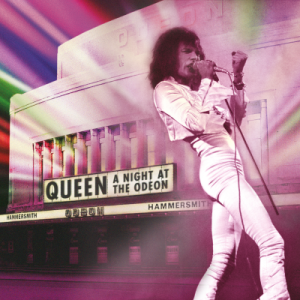
Image © Queen Productions Ltd.
Episode Embed link:
<iframe width=”560″ height=”315″ src=https://www.youtube.com/embed/pQAH4ORoHYA title=”YouTube video player” frameborder=”0″ allow=”accelerometer; autoplay; clipboard-write; encrypted-media; gyroscope; picture-in-picture; web-share” allowfullscreen></iframe>
As Queen moved from one era to the next, the band’s look always evolved alongside their sound. Every period has its iconic outfits. but the band’s glam-inspired aesthetic of the early-’70s stands amongst their most fondly remembered, and in this latest episode of Queen The Greatest Live, a fiery performance of the epic “Ogre Battle” showcases their dazzling fusion of music and styling.
At this very special show on Christmas Eve 1975 – broadcast live from London’s Hammersmith Odeon for BBC TV and radio, and officially released 40 years later as A Night At The Odeon – Queen’s confidence was sky-high. Released a month earlier, the band’s fourth studio album, A Night At The Opera, was already hailed as an all-time classic, while its groundbreaking centrepiece “Bohemian Rhapsody” was in the middle of its record-breaking nine week run at UK#1 when the band took the stage in London.
While the music was the main event at the Hammersmith show – including this performance of Freddie’s pummelling “Ogre Battle,” featuring visceral fretwork from Brian May that represents the titular clash of monsters – the band treated the 5,000-strong audience to one of their most ambitious early productions.
Performing beneath an elaborate lighting rig that bathed the stage in a ghoulish green glow, the band also pushed the sartorial envelope, with Freddie leading the lineup in a Wendy DeSmet-designed white satin catsuit and Brian’s beloved Zandra Rhodes winged cape amplifying the physicality of his playing. Look closely and you’ll see Freddie had even painted the nails of his left hand black for the show, offset by Brian painting his own nails white.
As Brian explained in last week’s interview, this striking use of monochrome effects was an integral part of the show. “The black and white stuff we got into – it’s all designed to be dramatic. It’s designed to accentuate our movements and accentuate the moods of the songs.”
Next week: “Sheer Heart Attack” (Episode 15)
YouTube Playlist Link:
https://Queen.lnk.to/TheGreatestLive
YouTube Playlist Link:
https://Queen.lnk.to/TheGreatestLive
Queen The Greatest series returns with season 2
Queen The Greatest Live a year-long celebration of Queen Live
A 50-week YouTube series going behind the scenes to reveal what goes into creating a
Queen show featuring moments from iconic performances and demonstrating why the band is regarded as the ultimate live act.
https://Queen.lnk.to/TheGreatestLive
Queen The Greatest Live: “Stage Wear” (Episode 13)
In an exclusive interview with Brian May and Roger Taylor, we discover the thinking behind some of their iconic live outfits. And it won’t come as a surprise to anyone to discover which member of the band was most passionate about their choices of stage wear.
WATCH HERE
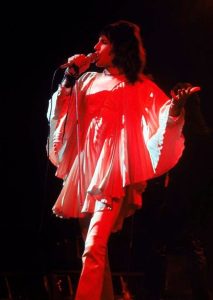
Freddie Mercury. Stage Costume: Zandra Rhodes, 1975
Courtesy EMI Photo Archive.
Embed link:
<iframe width=”560″ height=”315″ src=https://www.youtube.com/embed/deFR-4cBcgA title=”YouTube video player” frameborder=”0″ allow=”accelerometer; autoplay; clipboard-write; encrypted-media; gyroscope; picture-in-picture; web-share” allowfullscreen></iframe>
“We’re not kind of glam, but we are, I suppose…. Yeah, maybe we are glam, but mainly we’re dramatic that’s the idea.” Brian May
“Freddie, he didn’t always tell us… I mean, when he first turned up in the ballet thing, I think he slightly looked like Kermit, and the ballet pumps as well.
I mean, we were we were absolutely tickled.” Roger Taylor
As Queen The Greatest Live continues its journey to explore what makes a Queen show the ultimate live experience, and having already studied the rehearsals, opening numbers and lighting, this week’s episode turns its attention to Queen’s memorable stage wear.
In new and exclusive interviews with Brian May and Roger Taylor, QTGL series creator and director Simon Lupton learns from them both the history behind some of the band’s most iconic stage costumes, including the one that didn’t quite measure up for Roger Taylor and Brian’s initial reaction to Freddie’s infamous red sequined shorts.
And it is unlikely to come as a surprise to learn which band member was the driving force behind many of the choices.
Brian May: “The clothes are part of it, and no one was more aware of that than Freddie. Freddie really pioneered a lot of stuff and we came out of an era which was called glam, where people in rock groups realized that they could dress up and look fancy and make a big splash. But it was all very kind of random.
“And what we tried to do was, I guess, call on the traditions of opera and other art forms and make the costumes speak for us, make them part of the storytelling. So Freddie, with his little wings on his suits and all his of crowns and paraphernalia, also the black and white stuff, which we got into, and it’s all designed to be dramatic. It’s designed to accentuate our movements and accentuate the moods of the songs.
“We were lucky enough to work with some great designers. Zandra Rhodes was the first one we really worked with, and we had these very, very dramatic kind of pleated efforts and that was really helpful to us because it made us more aware of our physicality on stage, made us speak with our bodies as well as our hands and voices.”
The collaboration with Zandra Rhodes resulted in some outfits that are now legendary – but it quickly became apparent that extravagance might not work for everyone in the band…
Roger Taylor: “At the beginning, many years ago, there was this big thing, you know, that we wanted Zandra Rhodes to do everything. Well, she made me a costume. I wore it once. It was so bloody hot I never wore it again. It was completely impractical.
“And I don’t really like the word costume because with ‘costume’ I think of kids, or I think of pantomime or, you know, and this isn’t costumes, this is meant to be rock and roll. So I don’t really have a costume. And also, being drums, it’s pretty sweaty. You need something where you can move that is not hampering you in any way.
“And I leave it to… I leave it to the sort of those people out the front, whoever they are, to ponce around in their frilly dresses.”
For Freddie it was an aspect of the live show that he revelled in, and he particularly enjoyed surprising his fellow band members, as much as he did the fans.
Roger Taylor: “Freddie, he didn’t always tell us. I mean, when he first turned up in the ballet thing, I think he slightly looked like Kermit, and the ballet pumps as well. I mean, we were we were absolutely tickled. It could have gone the other way. You know, we could have gone ‘don’t be so ridiculous’, but because it was Fred, It was ‘yeah, come on. That’s brilliant.’ You know, why not?.
“And if you’ve got the balls to get… and let’s face it, we’ll be able to see them, you can get away with that. Yeah, let’s go. I mean, it was a great talking point. I remember several musicians faces, sort of jaws dropping in astonishment that this guy could come on, and they could play some serious rock n roll, you know?”
Brian May: “I think Freddie preferred to shock us. I do remember him appearing in the red sequined shorts. Swimming trunk type efforts and we went ‘Freddie really?’, and he went ‘Darling? This is what I do.’ Yeah, he was pretty outrageous. And he did like to shock us all – those cat suits and everything.
“But it’s all great. You know, he took so many chances, did Freddie. And I think because physically he was in such good shape as well, he could carry it off. And a lot of people would look ridiculous in those kind of leotards and stuff. But he looked like Nijinsky or whatever because he was physically at that point.”
Ultimately, Queen’s stage wear was not simply about being shocking or outrageous, but instead another well crafted, integral part of the overall audience experience.
Brian May: “I think to make best use of yourself on stage, it is a whole-body thing and it becomes very instinctive, after a while. You’re conscious about it for a while, the clothes and everything and the movements, but then it becomes part of what you are. And instinctively you do that and you instinctively know if you’re wearing the wrong stuff, it just kind of feels wrong. And so you go in search of good stuff and we have some great people to interact with who will say, ‘you’ve tried this?’. So, we’re not kind of glam, but we are, I suppose…. Yeah, maybe we are glam, but mainly we’re dramatic that’s the idea.”
Next week: “Queen The Greatest Live – Ogre Battle” (Episode 14)
YouTube Playlist Link:
https://Queen.lnk.to/TheGreatestLive
YouTube / Instagram / Facebook / Twitter / TikTok
Queen The Greatest series returns with season 2
Queen The Greatest Live a year-long celebration of Queen Live
A 50-week YouTube series going behind the scenes to reveal what goes into creating a
Queen show featuring moments from iconic performances and demonstrating why the band is regarded as the ultimate live act.
https://Queen.lnk.to/TheGreatestLive
Queen The Greatest Live: “Who Wants To Live Forever” (Episode 12)
Headlining at the Isle Of Wight Festival in June 2016, Queen and Adam Lambert stole the show with this powerhouse rendition of “Who Wants To Live Forever,” backed by a dazzling laser show. It remains one of the most moving and memorable moments from a decade of Queen and Adam Lambert shows.
WATCH HERE
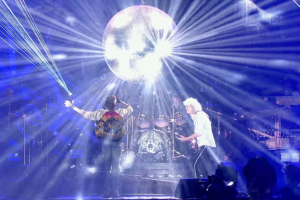
Queen + Adam Lambert, Isle of Wight Festival, June 12, 2016
© Miracle Productions LLP
Image Download Link
https://www.dropbox.com/s/nx4jr3layszyym2/image001.png?dl=0
Episode Embed link:
Embed link: <iframe width=”560″ height=”315″ src=https://www.youtube.com/embed/7pJrky5VxIk title=”YouTube video player” frameborder=”0″ allow=”accelerometer; autoplay; clipboard-write; encrypted-media; gyroscope; picture-in-picture; web-share” allowfullscreen></iframe>
Sound and vision have always gone hand-in-hand at Queen shows. While recent episodes of Queen The Greatest Live have shown how the perfect blend of music and production have elevated the band’s most rocking moments, this week we look back at an unforgettable laser-enhanced performance of Brian May’s devastating power ballad, “Who Wants To Live Forever,” which became the most emotionally charged moment of the 2016 Isle Of Wight Festival.
A highlight of Queen’s 1986 studio album, A Kind Of Magic, “Who Wants To Live Forever” was released as a UK #24 single alongside one of the band’s most iconic music videos, filmed in an East End warehouse with the National Philharmonic Orchestra, forty choirboys and several hundred candles. Just as memorable, the song was the emotional centrepiece of Queen’s acclaimed Highlander soundtrack, scoring the heart-breaking scene in which Christopher Lambert’s immortal Connor MacLeod endures the ageing and death of his beloved wife Heather.
It would take something truly special to match those iconic visuals. But at the 2016 Isle Of Wight Festival, the band pushed the envelope further than ever with a spectacular laser show that filled the night sky with a lattice of blue and purple beams. It was the perfect complement to Adam’s incredible vocal, with the new singer demonstrating his sky-scraping range for a festival crowd who might not yet have seen him in action. No wonder the performance was included amongst the personally selected concert highlights on Queen + Adam Lambert’s 2020’s UK #1 Live Around The World compilation album.
“I’ve never heard it sung like that, that’s special,” noted Roger Taylor after the performance, while Brian was just as effusive: “Adam is astounding, the lengths he can push things to is extraordinary. Sometimes I’m standing right here playing “Who Wants To Live Forever,” and he’s there doing his thing. And when he goes into this stratospheric thing in the middle, I very often go, ‘Wow.’”
The band’s headline set on the Isle Of Wight held added emotional significance, coming just hours after the horrific attack at the Pulse nightclub in Florida, where a mass shooting left fifty people dead and many more injured. As Adam told the festival crowd before ‘Who Wants To Live Forever’: “This song is dedicated to those who lost their lives last night, and anyone who has been a victim of senseless violence or hatred.”
Next week: “Queen The Greatest Live – Stage Wear”
YouTube Playlist Link:
https://Queen.lnk.to/TheGreatestLive
YouTube / Instagram / Facebook / Twitter / TikTok
Queen The Greatest series returns with season 2
Queen The Greatest Live a year-long celebration of Queen Live
A 50-week YouTube series going behind the scenes to reveal what goes into creating a
Queen show featuring moments from iconic performances and demonstrating why the band is regarded as the ultimate live act.
https://Queen.lnk.to/TheGreatestLive
Queen The Greatest Live: “We Are The Champions” (Episode 11)
Rare footage from the band’s 1977’s end of year USA tour, where the band introduce their new grand finale of We Are The Champions – complete with clouds of dry ice and the famous Crown lighting rig
WATCH HERE
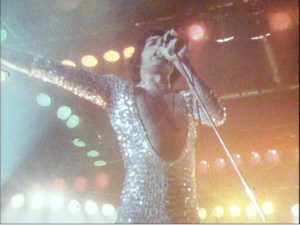
Freddie Mercury. Queen North America Tour November 1977 /. © Queen Productions Ltd.
Episode Embed link:
Embed link: <iframe width=”560″ height=”315″
src=https://www.youtube.com/embed/sqfZU9_4VnEtitle=”YouTube video player” frameborder=”0″ allow=”accelerometer; autoplay; clipboard-write; encrypted-media; gyroscope; picture-in-picture; web-share” allowfullscreen></iframe>
“We always end our show with it because it’s the best last song we know.”
-Brian May
In recent weeks, we’ve seen how Queen perfected the art of the opening number. Now, in Episode 11 of Queen The Greatest Live, we race to the end of the setlist, with a rare clip from the band’s 1977 end of year USA tour that shows how the band’s new anthem “We Are The Champions” saved the best until last.
Written by Freddie Mercury, “We Are The Champions” was inspired by a May ’77 concert at Bingley Hall, Stafford, where the crowd’s chants of football anthem “You’ll Never Walk Alone” convinced the band to write a song that invited mass singalongs.
“We wanted to get the crowds waving and singing,” Brian May has said. “’We Are The Champions’ is very unifying and positive. People love it because it’s so uplifting. Although much of our music was created using multi-layered arrangements and vocal harmonies – which work especially well in the recording studio – we were into making our concerts musical events.”
Featured on 1977’s News Of The World album – and released as a UK#2/US#4 single that included the equally grandiose “We Will Rock You” as its flipside – “We Are The Champions” was introduced into the band’s live set in November 1977 on their end of year North American tour. “It’s the most egotistical and arrogant song I’ve ever written!” Freddie joked in one
interview, before explaining that the lyric was intended to empower the entire audience: “Basically it’s a participation thing.”
With the News Of The World tour’s epic production including the iconic Crown lighting rig – a vast network of tungsten bulbs, searchlights and spotlights – the song’s all-conquering sentiment was the perfect fit. In this rarely seen footage from one of those US concerts we see the band throw everything at their performance, with Freddie leading “We Are The Champions” from the piano in a cloud of dry ice.
On the Queen tours that followed, the song, along with “We Will Rock You,” would become the ultimate concert finale and the band’s non-negotiable closing number (albeit followed by a blast of “God Save The Queen”). “’We Are The Champions” is very triumphal,” Brian has said. “It fits the occasion, whatever the occasion might be. We always end our show with it because it’s the best last song we know.”
Next week: “Queen – Who Wants To Live Forever” (Episode 12)
YouTube Playlist Link:
https://Queen.lnk.to/TheGreatestLive
Queen The Greatest series returns with season 2
Queen The Greatest Live a year-long celebration of Queen Live
A 50-week YouTube series going behind the scenes to reveal what goes into creating a
Queen show featuring moments from iconic performances and demonstrating why the band is regarded as the ultimate live act.
https://Queen.lnk.to/TheGreatestLive
Queen The Greatest Live: “Tie Your Mother Down” (Episode 10)
Revisiting the band’s famous concert at the Milton Keynes Bowl in June 1982 where Freddie Mercury, Roger Taylor, Brian May and John Deacon turned heads with a spectacular live take on one of their greatest rock anthems.
WATCH HERE
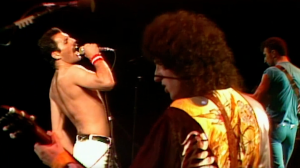
Queen, Milton Keynes Bowl, UK. June 5, 1982
© Queen Productions Ltd.
Episode Embed link:
<iframe width=”560″ height=”315″ src=https://www.youtube.com/embed/s8w-KpG5vsc title=”YouTube video player” frameborder=”0″ allow=”accelerometer; autoplay; clipboard-write; encrypted-media; gyroscope; picture-in-picture; web-share” allowfullscreen></iframe>
In last week’s exclusive video interview, Brian May and Roger Taylor explained the vital role of lighting in the Queen live experience. Now, in this latest episode, we see the thrilling result of all the band’s hard work behind the scenes, as the lineup power through an eye-popping performance of “Tie Your Mother Down” that held the Milton Keynes Bowl spellbound on June 5th, 1982.
The last of four UK dates on 1982’s Hot Space Tour in support of Queen’s tenth album, the Milton Keynes Bowl was then one of the nation’s largest new open-air venues and demanded a performance to match. As Roger said in a backstage interview before the show: “It’s a big field. I hope it goes well.”
“Outdoor gigs are fraught with all kind of unexpected things,” added Brian.
In the event, Queen’s classic performance and epic production at the Milton Keynes Bowl would go down in rock ‘n’ roll history and later be released in full on 2004’s DVD and CD, Queen On Fire: Live At The Bowl. While the band opened the setlist with the title track of their recent Flash Gordon soundtrack, they made sure to leave the crowd with a big number before regrouping for the encore.
Written by Brian and the opening track of Queen’s 1976 album, A Day At The Races, “Tie Your Mother Down” was the perfect candidate. “It was built around a riff I’d had kicking around for a long time,” Brian told Absolute Radio. “I know pretty much where I first played it. It was on top of a volcanic ridge in Tenerife where I was doing my PhD studies. I had a little acoustic guitar I’d bought down in Santa Cruz, and I remember beating out that riff and enjoying the feeling of bending the string. And I sat there watching the sun go down and singing along to it.”
By the time Queen performed “Tie Your Mother Down” at the Milton Keynes Bowl, the song had grown into a driving hard-rock anthem – and with Freddie Mercury commanding the stage in the glow of the band’s most ambitious lighting rig to date, it remains an electrifying moment in Queen’s history.
Next week: “Queen – We Are The Champions” (Episode 11)
YouTube Playlist Link:
https://Queen.lnk.to/TheGreatestLive
Queen The Greatest series returns with season 2
Queen The Greatest Live a year-long celebration of Queen Live
A 50-week YouTube series going behind the scenes to reveal what goes into creating a
Queen show featuring moments from iconic performances and demonstrating why the band is regarded as the ultimate live act.
https://Queen.lnk.to/TheGreatestLive
Queen The Greatest Live: “Under The Lights” (Episode 9)
In an exclusive new interview, Brian May and Roger Taylor explain why lighting is so important to the Queen live experience – and look back at the band’s most ambitious productions over the decades.
WATCH HERE
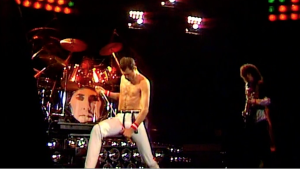
Queen Hot Space Tour. Milton Keynes Bowl, June 5, 1982
© Queen Productions Ltd.
Episode Embed link:
<iframe width=”560″ height=”315″ src=”https://www.youtube.com/embed/klfiNtLAbDQ” title=”YouTube video player” frameborder=”0″ allow=”accelerometer; autoplay; clipboard-write; encrypted-media; gyroscope; picture-in-picture; web-share” allowfullscreen></iframe>
“It was pretty much like a pizza oven.” Brian May
When Queen formed in 1970, the band were determined their live shows would dazzle all the senses. Now, in an exclusive interview for Episode 9 of Queen The Greatest Live, Brian May and Roger Taylor explain why lighting is such a vital part of the band’s audio-visual spectaculars – and reveal their favorite moments under the lights.
“For that two-and-a-half hours that we’re onstage, we are in complete control of the environment – that means the sound, the lights, the temperature, everything,” says Brian. “We’ve always thought the lights are not just objects to illuminate, they’re objects in themselves and they’re part of the environment. And that’s a kind of rock ‘n’ roll thing, I think. I think we imbibed that from seeing stuff that we enjoyed when we were kids.”
Coming up on the London circuit of the late-’60s, the Queen line-up watched the evolution of rock-show lighting at first hand, and having taken inspiration from pioneers like Pink Floyd, they resolved to push the envelope further still. “There were so many acts going around that had hundreds of lights, all different colours, and it just made white,” remembers Roger. “So, we had this idea of just having red, green and white. And it was very effective.”
As their concert venues grew rapidly in the early-’70s, Queen’s productions became ever more ambitious, and over the past five decades the line-up have worked with the lighting sector’s greatest visionaries and most cutting-edge technology. (In fact, by the time of 1982’s Hot Space Tour, the lighting rig was so heavy that a proposed show at the Royal Albert Hall was cancelled over fears the famous domed ceiling could not support it.)
In this new interview, Roger recalls one trailblazing lighting rig nicknamed the ‘Crown’ that could be raised and lowered during the show (a first for rock ‘n’ roll), as well as the suspended lighting banks colloquially known as ‘Bic razors’ and much-copied since. Yet the drummer also explains how, at a Queen show, less is sometimes more: “Sometimes the most effective light is one single powerful spotlight, to focus the entire arena on that performer.”
Meanwhile, Brian reflects on the dynamic lighting pods that responded to his guitar solos, as well as the infamous ‘pizza oven’ rig whose tungsten bulbs made concerts a physical ordeal for the band. “In those days, they were hot, they were incandescent, all of them, they were all tungsten,” he remembers. “And when it came down, it was pretty much like a pizza oven. And Rog used to get frightened. There was smoke coming off his stool when he went off for the encore. I don’t quite how we survived that!”
“We also had a different set up where we had lights in pods, and in each pod there was a man running it and operating it so you could actually interact with these pods. And there’s some footage of me doing the guitar solo and playing to the pod and sort of moving it. It would sort of interact with me and talk to me when I’m playing. “
“That was a lot of fun. Michael Jackson saw that and said, I want that. And he did.”
Next week: “Queen – Tie Your Mother Down”
YouTube Playlist Link:
https://Queen.lnk.to/TheGreatestLive
YouTube / Instagram / Facebook / Twitter / TikTok
Queen The Greatest series returns with season 2
Queen The Greatest Live a year-long celebration of Queen Live
A 50-week YouTube series going behind the scenes to reveal what goes into creating a
Queen show featuring moments from iconic performances and demonstrating why the band is regarded as the ultimate live act.
https://Queen.lnk.to/TheGreatestLive
Queen The Greatest Live: “One Vision” (Episode 8 )
To round up our look back at some of Queen’s most iconic opening numbers, we revisit the legendary Magic Tour of 1986 to see how those massive stadium shows were kicked off in style with One Vision.
WATCH HERE
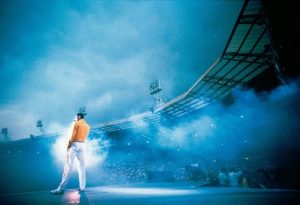
Queen -The Magic Tour. Wembley Stadium, July 11, 1986
Credit: Photograph by Denis O’Regan. © Queen Productions Ltd.
Episode Embed link:
Embed link: <iframe width=”560″ height=”315″ src=https://www.youtube.com/embed/tJqKPsEgSOw title=”YouTube video player” frameborder=”0″ allow=”accelerometer; autoplay; clipboard-write; encrypted-media; gyroscope; picture-in-picture; web-share” allowfullscreen></iframe>
Queen The Greatest Live, continues with another example of Queen kicking things off in style with an incredible opening number.
When Queen undertook their now legendary Magic Tour of European stadiums in 1986, the opening number was going to have to be something very big to captivate the enormous crowds. After all, Freddie had promised for their return to Wembley and their home town for the first time since Live Aid ’85: “We are going to play on the biggest stage ever built at Wembley, with the greatest lightshow ever seen.”
And of course, in true Queen fashion, the band did not disappoint.
Concluding our look back at some of Queen’s most iconic opening numbers, we now revisit the legendary Magic Tour of 1986 to see how the band kicked off those massive stadium shows in style with “One Vision.” Episode 8 of Queen The Greatest Live captures the thrill of the front row at Wembley Stadium, as the band hit the stage that summer armed with a new song that represented one of the most rocking moments in their catalogue.
Released as a UK#7 single in November 1985 and featured on the following year’s A Kind of Magic album, “One Vision” was a close-knit collaboration between all four bandmembers. Roger Taylor led the lyric-writing (the drummer admitting the ‘I had a dream’ bridge section was “half-nicked off Martin Luther King’s famous speech”), while the final cut featured Brian May’s three-part guitar harmonies and the Freddie Mercury vocal ad-libs that were woven into a swirling sonic tapestry by producer Reinhold Mack.
As the opener to their Wembley Stadium shows of July 11th and 12th, 1986, the band took “One Vision” to the next level from the studio original, with Brian adding guitar pyrotechnics and Freddie revving up the 144,000-strong crowd in the iconic military-style yellow jacket created by his designer and friend Diana Moseley. Almost four decades later, it’s still a stone cold classic Queen moment.
“One Vision” would be the show opener every night throughout their 26-date 1986 UK and European tour including at what would be the band’s very last show ever, at Knebworth Park, UK, on August 9.
Next week: “Queen – Under The Lights” (Episode 9)
YouTube Playlist Link:
https://Queen.lnk.to/TheGreatestLive
Queen The Greatest series returns with season 2
Queen The Greatest Live a year-long celebration of Queen Live
A 50-week YouTube series going behind the scenes to reveal what goes into creating a
Queen show featuring moments from iconic performances and demonstrating why the band is regarded as the ultimate live act.
https://Queen.lnk.to/TheGreatestLive
Queen The Greatest Live: “Flash and The Hero” (Episode 7)
Continuing the celebration of Queen’s spectacular concert openings, we enjoy another example of Freddie, Brian, Roger and John’s ability to whip a crowd into a frenzy, this time from their memorable performance at the legendary Milton Keynes Bowl.
WATCH HERE
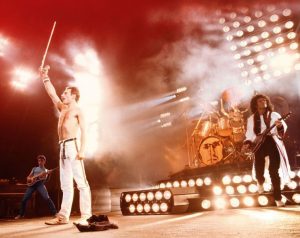
Queen – Live At Milton Keynes Bowl, June 5, 1982
Credit: © Queen Productions Ltd.
Photo download link:
https://www.dropbox.com/s/njqftb8fk8w2uba/image001.jpg?dl=0
Embed link:
<iframe width=”560″ height=”315″ src=https://www.youtube.com/embed/l_HjIuRqGyw title=”YouTube video player” frameborder=”0″ allow=”accelerometer; autoplay; clipboard-write; encrypted-media; gyroscope; picture-in-picture; web-share” allowfullscreen></iframe>
In the interview we saw earlier in the current series, both Roger Taylor and Brian May explained how the combination of building anticipation in an audience, and then hitting them with a spectacular opening number is a vital hallmark of any Queen show. And to find a classic example of that in action, we need look no further than the phenomenal start to their 1982 concert at the Milton Keynes Bowl.
In Episode 7, we journey back to June 5th, 1982, when Queen whipped the U.K. Milton Keynes Bowl into a frenzy with an all-guns-blazing medley of “Flash” and “The Hero.”
Written by Brian May and driven by an unforgettable vocal hook (‘Flash! Ah-ah!’), “Flash” was the theme song of 1980’s Flash Gordon movie and the first taste of Queen’s hugely successful soundtrack work. Played over the stadium PA in Milton Keynes, “Flash” set the scene as Brian, Freddie Mercury, Roger Taylor and John Deacon hit the stage amidst spotlights and pyro – before kicking into a second cut from the Flash Gordon soundtrack, “The Hero.”
The Milton Keynes show was one of four huge outdoor concerts on the UK leg of Queen’s 1982 Hot Space Tour: a 30-date European trek that confirmed the band’s enduring popularity. The scale of Queen’s grandiose production, meanwhile, was underlined when plans for a concert at London’s Royal Albert Hall were abandoned due to fears the famous domed ceiling would collapse under the weight of the lighting rig.
Released in 2004 on DVD/CD as Queen On Fire – Live At The Bowl, the Milton Keynes show also gave the band a rare chance to take the stage on a perfect summer’s day. “It’s not very often we do shows in the daylight,” noted Freddie during the concert. “I f***ing wish we had before – I can see you all now! And there’s some beauties here tonight…”
Next week: “One Vision” (Episode 8)
YouTube Playlist Link:
https://Queen.lnk.to/TheGreatestLive
YouTube / Instagram / Facebook / Twitter / TikTok
Queen The Greatest series returns with season 2
Queen The Greatest Live a year-long celebration of Queen Live
A 50-week YouTube series going behind the scenes to reveal what goes into creating a
Queen show featuring moments from iconic performances and demonstrating why the band is regarded as the ultimate live act.
https://Queen.lnk.to/TheGreatestLive
Queen The Greatest Live: “Now I’m Here” (Episode 6)
A celebration of one of Queen’s greatest opening numbers, and the song they’ve performed live more times than any other – the epic “Now I’m Here”
WATCH HERE
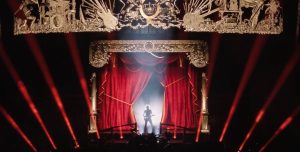
Photo credit: © Queen Productions Ltd.
Rhapsody Over London 2022. “Now I’m Here”
Episode Embed link:
Embed link: <iframe width=”560″ height=”315″ src=https://www.youtube.com/embed/H7sCSxY3Txk title=”YouTube video player” frameborder=”0″ allow=”accelerometer; autoplay; clipboard-write; encrypted-media; gyroscope; picture-in-picture; web-share” allowfullscreen></iframe>
Last week’s episode of Queen The Greatest Live saw Brian May and Roger Taylor reveal their tactics for starting Queen shows with a bang. Now, on Friday February 24th, Episode 6 of the hit YouTube video series showcases four live performances of “Now I’m Here” – the hard-rock anthem that has opened countless shows and appeared in more Queen setlists than any other song: two classic clips with Freddie from the London Rainbow ’74 and London Hammersmith ’75 plus Queen and Adam Lambert peformances from Summer Sonic, Tokyo, in 2014 and most recent, from the band’s Rhapsody Over London show 2022.
Written by Brian May in the summer of 1974, “Now I’m Here’s” piston-pump riff, call-and-response vocal and explosive dynamics made it the ideal song to light the fuse. As Freddie Mercury told Record Mirror, the song also reminded fans that Queen were still rockers at heart. “We released it after ‘Killer Queen.’ And it’s just a total contrast. It was just to show people we can still do rock ‘n’ roll, we haven’t forgotten our rock ‘n’ roll roots. I enjoyed doing that on stage.”
As a highlight of 1974’s Sheer Heart Attack studio album, Queen immediately adopted “Now I’m Here” as their set opener. Now, Episode 6 bottles the feverish anticipation at those ’70s shows, when venues were left waiting in the darkness until the song erupted with the line: “I’m just a new man!”
And when drawing up the set for the Adam Lambert-fronted tour Brian’s classic rocker announced itself as the perfect opening gambit as the new lineup met their public.
In Episode 6, we look back at one such Adam-era performance of “Now I’m Here” with a giant kabuki curtain dropping as Brian and Roger attack their instruments – causing fans to literally weep with excitement.
Next week: “Flash and The Hero” (Episode 7)
YouTube Playlist Link:
https://Queen.lnk.to/TheGreatestLive
YouTube / Instagram / Facebook / Twitter / TikTok
Queen The Greatest series returns with season 2
Queen The Greatest Live a year long celebration of Queen Live
A 50-week YouTube series going behind the scenes to reveal what goes into creating a
Queen show featuring moments from iconic performances and demonstrating why the band is regarded as the ultimate live act.
https://Queen.lnk.to/TheGreatestLive
Queen The Greatest Live: “Opening Numbers” (Episode 5)
Queen The Greatest Live video series returns as
Brian May and Roger Taylor explain the art of opening a live show.
WATCH HERE
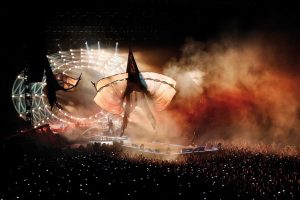
Queen + Adam Lambert. Kabuki curtain drop.
Photo: Xavier Vila © Miracle Productions LLP
Episode Embed link:
<iframe width=”560″ height=”315″ src=”https://www.youtube.com/embed/sAK_iBSSxpQ” title=”YouTube video player” frameborder=”0″ allow=”accelerometer; autoplay; clipboard-write; encrypted-media; gyroscope; picture-in-picture; web-share” allowfullscreen></iframe>
“I think for the audience, they want to be blown away at first . We used to say blind them, deafen them, and then calm down a bit after 20 minutes, but you really want to go bang, bang, bang, bang at the beginning of a show.” — Roger Taylor.
Opening with a bang! Brian and Roger reveal the thinking behind the spectacular openings to Queen shows, and the legends who inspired them in the band’s early days.
As a live band famous for making an electrifying first impression, there’s a science to the Queen setlist, and in this exclusive video interview with Brian May and Roger Taylor, the two founders reveal their philosophy to starting with a bang.
“The audience want to be blown away at first,” explains Roger. “We used to say blind them, deafen them, and then calm down a bit after twenty minutes. You really want to go bang, bang, bang, bang at the beginning of a show.”
From “One Vision” to “Bohemian Rhapsody,” Queen have hit the stage over the past half-century armed with rock’s greatest rabble-rousing anthems. As Brian explains, some songs demand a place at the top of the setlist. “Sometimes, writing a song, you’re already aware it would be a good opener. You see it in that light. The production starts to take place in your head. We’ve had some really good openers and I think generally they’ve come out of the music.”
Episode 5 goes on to reveal how Queen learned the importance of building anticipation from heroes like The Who and Led Zeppelin – before looking back at classic Queen openers, from Freddie Mercury revving up the crowd with “We Will Rock You” to the kabuki curtain drop and the dash down the runway for “Tie Your Mother Down” in the Paul Rodgers period.
“We’ve had some good openings,” reflects Roger. “I used to like the kabuki. The big curtain just disappears in front of your eyes and suddenly reveals all. That was always a good gag. You try and make an impact with the first song.”
Full episode transcript below:
Next week: “Now I’m Here” (Episode 6)
Opening Numbers (Episode 5)
Episode Transcript:
Roger Taylor: “As with most shows, I’m not talking about plays or anything like that, I think for the audience, they want to be blown away at first. So if you can blow them away a bit at first, we used to say blind them, deafen them, and then calm down a bit after 20 minutes.”
Roger Taylor: “But it’s really you try and make an impact with the first song visual and obviously sort of an aural attack really. And then you try and space the songs intelligently, but you really want to go bang, bang, bang, bang at the beginning of a show.”
Brian May: “Yeah, openings and closings of shows are incredibly important. What’s in the middle is important too. But you know, the way you come on and the way you leave are the most significantly memorable moments. So a lot of thought goes into the opening, and it’s been a specialty of mine for a long time. In fact, sometimes writing a song, you’re already aware that it would be a good opener. You see it in that light. The production starts to take place in your head.”
Brian May: “We’ve had some really good openers and I think generally they’ve come out of the music. You see, I think our show is also different from many shows in that everything comes from the music. It’s not like just let’s put on a pretty light show and play some music. Everything comes from the music, everything is making the music more expressive, making it connect better.”
“So knowing that process and that sort of solid seat of it, it’s actually quite easy to fashion those moments. And it’s fun. It’s so fun to plan it out, plan the sound, plan where we’re going to be, planning the lights and everything and then see the effect on the audience and go, ‘Yes, that works’.”
Roger Taylor: “We’ve had some good openings. I used to like the kabuki. The big curtain just disappears in front of your eyes and suddenly reveals all. That was always a good, good gag.”
Brian May: “I remember going to see a show by The Who or Zeppelin, and you’re sitting there in the audience and they’re late and it’s all hot and steamy and sweaty, and you think… ‘What are they going to do when they come on?’ and it’s that amazing moment when they first hit the stage. So we’re very aware of that and we try to give… we’re never late. But we try to give that feeling, justify that feeling of anticipation, give them something that they’ve never quite seen before,
Roger Taylor: “It’s nice to sort of create an atmosphere, I think, and we use very sort of ambient things. Sounds for that through the P.A., not loud, just to get a nice buzz, hopefully, and an expectant buzz. I think many acts do that. Support act? Yes. We’ve had them in the past. Many and it’s always been fine. But I think the show these days is big. It’s a massive production and really, and it’s long, and I think it’s just a bit sort of superfluous really. We don’t feel we need a support act and so we don’t have one.
Brian May: “Basically, we have a lot to offer on a given night and we like to use the whole evening. So we like to do the whole show ourselves. It’s like we kind of do the warm up ourselves. In some ways it’s a shame because it’s nice to take a support group out because it gives them a leg up and it gives them a good chance to be seen.”
Brian May: “But at the same time, we’ve talked to our audience a lot of the time, and I think most of them prefer what we do. They like to have the whole evening, just us, that we’ve actually made the effort to put our show together, which lasts two and a half hours or more, which encompasses everything that they might want to see us do. And you can’t do that in any less time than that, really.”
Ends.
Queen The Greatest series returns with season 2
Queen The Greatest Live a year long celebration of Queen Live
A 50-week YouTube series going behind the scenes to reveal what goes into creating a
Queen show featuring moments from iconic performances and demonstrating why the band is regarded as the ultimate live act.
https://Queen.lnk.to/TheGreatestLive
Queen The Greatest Live Episode 4: “Rehearsals – Part 4”
To wrap up our behind-the-scenes look at Queen’s rehearsal process, this rare footage of Brian and Roger at a sound check in Kyiv reveals how those precious few hours at a venue before the show are key. In unseen footage from that watershed 2012 concert, we see Brian and Roger using that time to make sure everything is as ready as it can be.
WATCH HERE
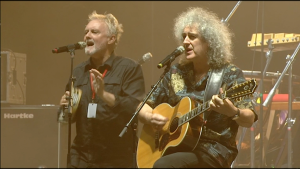
Photo credit: © Queen Productions Ltd.
Roger Taylor, Brian May, rehearsals, Independence Square, Kiev, Ukraine. 30 June 2012
Episode Embed link:
<iframe width=”560″ height=”315″ src=https://www.youtube.com/embed/NyQ7_WT0R7s title=”YouTube video player” frameborder=”0″ allow=”accelerometer; autoplay; clipboard-write; encrypted-media; gyroscope; picture-in-picture; web-share” allowfullscreen></iframe>
On Friday February 10th, the hit YouTube video series Queen The Greatest Live returns with Episode 4: “Rehearsals Part 4.” Inviting fans to witness this vital behind-the-scenes process, the exclusive footage of Brian May and Roger Taylor rehearsing the classic Brian May written Queen track “’39” shows the hard work behind a make-or-break 2012 concert that heralded a new chapter for the band.
While every Queen show is special, some take on added significance. On June 30th, 2012, founding members Brian and Roger were preparing for their first full concert with new frontman Adam Lambert at Kyiv’s Independence Square in Ukraine. Performing a benefit for the Elena Pinchuk ANTIAIDS Foundation in front of more than 350,000 fans – plus a TV audience of millions – this was the night when the new Queen lineup proved it had wings.
“There was this sense of camaraderie,” recalled Adam in a previous episode of Queen The Greatest. “It was an instant sense of comfort and ease that we all had. We all got a kick out of each other. It felt like the right fit.”
Fans will also be thrilled by this behind-the-scenes snapshot of “’39.” A highlight of 1975’s A Night At The Opera, this joyous-yet-wistful anthem is one of Brian’s finest compositions, driven by twelve-string acoustic and cascading harmonies, telling the story of a team of space voyagers who return to terra firma to find time has marched on without them and their loved ones are now aged or departed.
“’39” has long been a cult favorite, with fans in high places. First surfacing on the band’s fourth studio album, A Night At The Opera, it emerged as a live favorite throughout the 70’s often being used as an audience singalong and gathered fans beyond their core base; the song was once chosen by Dan Hawkins of The Darkness as his number-one Queen moment, and was also a touchstone for George Michael throughout his career, with the singer not only busking it on the London Underground before finding fame with Wham!, but performing it at 1992’s Freddie Mercury Tribute Concert.
Now, this latest episode of Queen The Greatest Live reveals how “’39” has evolved to become a concert highlight in the modern era, with Brian and Roger leading the song on harmonies, guitar and tambourine – and here, even changing the final line to salute their Ukraine audience.
YouTube Playlist Link:
https://Queen.lnk.to/TheGreatestLive
Next week: Episode 5 – “Chapter 2 – The Opening Number”
Queen The Greatest series returns with season 2
Queen The Greatest Live a year long celebration of Queen Live
A 50-week YouTube series going behind the scenes to reveal what goes into creating a
Queen show featuring moments from iconic performances and demonstrating why the band is regarded as the ultimate live act.
https://Queen.lnk.to/TheGreatestLive
Queen The Greatest Live – Episode 3:
“Rehearsals – Part 3 – Rehearsing Magic”
Rare fly-on-the-wall rehearsal footage from 1986’s The Magic Tour
In preparation for their massive, and ultimately final, stadium tour of Europe with Freddie in 1986, Queen embarked on a series of full production rehearsals to test all elements of their extraordinary show. Some of those rehearsals were captured on a home movie camera, giving a rare insight into the amount of preparation that went into these Magic shows.
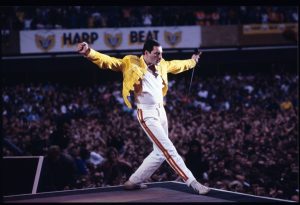
Freddie Mercury. Queen Magic Tour 1986
Photograph by Neal Preston. © Queen Productions Ltd.
Download photo HERE
Episode Embed link:
<iframe width=”560″ height=”315″ src=”https://www.youtube.com/embed/ELt35f5c_7M” title=”YouTube video player” frameborder=”0″ allow=”accelerometer; autoplay; clipboard-write; encrypted-media; gyroscope; picture-in-picture; web-share” allowfullscreen></iframe>
On Friday February 3rd, the hugely popular YouTube video series Queen The Greatest Live returns with Episode 3: a rare glimpse into the band’s preparations for The Magic Tour. This epic 1986 tour saw Queen rocking Europe’s most iconic stadiums – and proved to be their final shows with Freddie Mercury.
This latest episode cuts classic footage from the Magic shows with a secretly taped film of the lineup in rehearsals, giving viewers an unprecedented snapshot of the band’s pre-tour drill.
With lavish production and a setlist that ran close to 30 songs, The Magic Tour was an ambitious 26-date undertaking whose staging demanded countless hours of work behind closed doors.
While the lineup would typically choose to rehearse the material in private, episode three invites viewers to become a fly on the wall as Freddie leads Brian May, Roger Taylor and John Deacon through “Tear It Up,” “I Want To Break Free” and “Now I’m Here” with the same mic stand-twirling abandon of the stadium shows themselves.
“We don’t know who shot it, but it was clearly someone with access to the rehearsals who took the initiative and shot it on their home movie camera,” explains Queen’s long-standing multimedia collaborator Simon Lupton. “From the angles and quality, it certainly wasn’t official and the band – and presumably management – were unaware!”
Simon continues: “Although it would have been very much frowned upon at the time, it now gives us a rare and fascinating insight into the rehearsal process. The tape came to light in about 2003, I think, when a collector unearthed it thinking it was a copy of the TV broadcast of Live at Wembley, only to discover this rare gem.”
The Magic Tour – 26 dates played over an eight week period – incorporated the UK and nine European countries included Queen’s first and only show in Budapest, Hungary, and their only concert at Knebworth Park, Hertfordshire, which would prove to be Queen’s very last concert. Sadly for us that historic final show was never officially filmed although there are thought to be many privately filmed recordings out there still to potentially be discovered…
YouTube Playlist Link:
https://Queen.lnk.to/TheGreatestLive
Next week: Episode 4: “The Soundcheck”
WATCH HERE
Queen The Greatest series returns with season 2
Queen The Greatest Live a year long celebration of Queen Live
A 50-week YouTube series going behind the scenes to reveal what goes into creating a
Queen show featuring moments from iconic performances and demonstrating why the band is regarded as the ultimate live act.
https://Queen.lnk.to/TheGreatestLive
Queen The Greatest Live – Episode 2: “Rehearsals – Part 2”
Continuing this brand new series of Queen The Greatest Live –
we see first-hand how Queen’s dedication to rehearsing played a crucial
role in what is regarded as one of the greatest performances in music history.
WATCH HERE
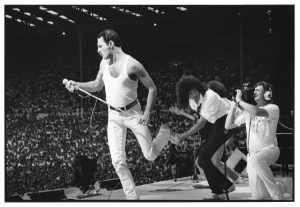
Photograph by Neal Preston / Courtsey Queen Productions Ltd.
Freddie Mercury, Brian May, Live Aid, July 13, 1985
Photo Download Link
Episode Embed link:
<iframe width=”560″ height=”315″ src=https://www.youtube.com/embed/Hc7ajsOZb6o title=”YouTube video player” frameborder=”0″ allow=”accelerometer; autoplay; clipboard-write; encrypted-media; gyroscope; picture-in-picture; web-share” allowfullscreen></iframe>
The second episode of this new series, Queen The Greatest Live, a year long celebration of Queen on stage, once again explores the importance the band put on rehearsals, revisiting one of the band’s most iconic performances – their 1985, 17 minute set at Live Aid, which continues to be hailed as one of the greatest live moments in music history.
As one of the only bands to put serious time into rehearsing to get the maximum out of the short set time, it’s proof that preparation is key. Fortunately, cameras were allowed to get a quick glimpse of those historic rehearsals in progress.
Cutting between rarely seen rehearsal footage and the band’s live performances of “Bohemian Rhapsody,” “Hammer To Fall” and “Radio Ga Ga,” the episode presents in close up the casually clad Freddie, Roger, John and Brian (those shorts!) warming up for what would become their global juke box triumph, and one of the greatest rock and roll performances of all time, despite Brian recently telling Total Guitar magazine he initially left the stage nervous that the set was one of the band’s weaker performances.
“We didn’t go there to [steal the show]. We went there to do our bit… I didn’t think when we came off that it was our best performance or anything like that.” He credits Freddie Mercury’s confidence during the performance as the reason why Queen were seen as having ‘stolen the show.’
“The adrenaline that was flowing in Freddie was pretty magnificent,” Brian said. “Freddie, when you watch him now, he looks so full of confidence. And he is … He knows that he can get the audience on his side, in spite of the fact that nobody had bought tickets to see us. We weren’t on the bill when people bought all those tickets. So that was a step into the unknown. But I don’t think Freddie ever had any doubts.”
A view shared by Roger Taylor: “From the word go, he (Freddie) came out of the traps like a champion. I remember looking up and seeing the whole place going completely bonkers in unison and thinking ‘Oh, this is going well.’”
The total triumph of that performance has since been enjoyed by generations too young to have witnessed that original historical achievement by the band, faithfully recreating the scale of the record-breaking event in the band’s 2018 cinema blockbuster, Bohemian Rhapsody.
View Queen The Greatest Live Episode 2. Rehearsals (Part 2)
Photo:

Freddie Mercury, Brian May, Live Aid, 13 July 1985
Photograph by Neal Preston. © Queen Productions Ltd.
View Queen The Greatest Live Episode 2. Rehearsals (Part 2)
YouTube Playlist Link:
https://Queen.lnk.to/TheGreatestLive
Episode Embed link:
<iframe width=”560″ height=”315″ src=https://www.youtube.com/embed/Hc7ajsOZb6o title=”YouTube video player” frameborder=”0″ allow=”accelerometer; autoplay; clipboard-write; encrypted-media; gyroscope; picture-in-picture; web-share” allowfullscreen></iframe>
Next week: “Rehearsals – Part 3: Rehearsing Magic”
The Queen The Greatest Series Returns With
Season 2: A Yearlong Celebration of Queen Live.
Queen The Greatest Live
A 50-week YouTube series going behind the scenes to reveal what goes into creating a Queen show featuring moments from iconic performances and demonstrating why the band is regarded as the ultimate live act.
Queen The Greatest Live – Episode 1: “Rehearsals – (Part 1)”
This first episode features a brand new and exclusive interview with Brian May and Roger Taylor, as they reveal their rehearsal secrets.
Episode 1 goes live Friday January 20 – 4am PT / 7am ET
here: https://Queen.lnk.to/TheGreatestLive
Episode Embed link:
<iframe width=”560″ height=”315″ src=https://www.youtube.com/embed/yCuHPNLToXE title=”YouTube video player” frameborder=”0″ allow=”accelerometer; autoplay; clipboard-write; encrypted-media; gyroscope; picture-in-picture; web-share” allowfullscreen></iframe>
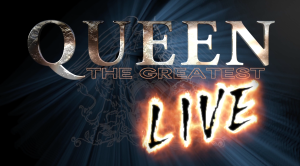
“They call it Kaizen in Japan; you improve tiny little things all along the way and suddenly the whole shows an improvement. And that’s why the show is so good, I think. I mean, I hope it is good. People say it’s good.” Brian May
“Normally we play a song through and see if we think it’s going to work live. They don’t always work live. So there’s quite a few songs we’ve never played live that have been on albums and probably for good reason.” Roger Taylor
From their earliest shows playing to several hundred at London’s famed Marquee Club in 1973 to more recent concerts performed to over 70,000 in Sydney, Australia, the one constant in Queen’s performing history has been the band’s commitment to what they consider the most crucial aspect of a successful Queen performance: the rehearsals.
Now in its triumphant second year, the mightily popular YouTube video series Queen The Greatest return this Friday, January 13. This first episode of 2023 kick-starts a twelve-month, 50-video schedule that will bring fans more rare archive live footage, contemporary performances, and behind-the-scenes interviews from across Queen’s five decades. Complemented by the meticulously assembled visuals of longtime multimedia collaborator Simon Lupton, Queen The Greatest Live promises to continue to inform and delight the most hardcore fan, many of whom might be thrilled to spot that the return of the series now boasts a new opening theme tune – fashioned specially by Brian May from “We Are The Champions.”
From Live Aid to Rock In Rio, Queen’s fabled concerts have always been the climax of months of painstaking preparation. As Brian and Roger explain in Episode 1, the rehearsal and soundcheck process is a vital part of the nightly magic that happens on the stage, not only helping Queen sculpt their famously epic sound but also tighten tricky musical gearshifts and even dust off songs that have rarely appeared on the setlist. “And if it works out well in soundcheck,” notes Brian, “you put it in the next night.”
Interspersed with the new interviews, Episode 1 also offers behind-the-scenes footage from Queen tours past and present. In modern times, we see Roger put his kit through its paces and frontman Adam Lambert testing the stadium acoustics. But this latest video dives deep into the vaults, too, bringing us News Of The World-era soundcheck footage, with Freddie Mercury singing “Tie Your Mother Down” to rows of empty seats while Brian wrangles his pedalboard.
Our journey starts with a new and exclusive interview with Brian May and Roger Taylor to discover the importance of the first crucial aspect of any successful Queen tour: the rehearsals.
Brian May: “Rehearsing before tour is always a bit of a surprise because you don’t know how much you’re going to remember, and you don’t know if it’s still going to feel the same. But it’s surprising how stuff does flow back into you, into your veins, once you start kicking stuff around.”
Roger Taylor: “Normally, we play a song through and see if it works, if we think it’s going to work live, and they don’t always work live. Some of them just, they’re not suited really for an exciting or involving, engaging performance, a live performance. So we probably, there’s quite a few songs we’ve never played live that have been on albums and probably for good reason.”
Brian May: “We’ll try a lot of stuff out, and then very often we’ll go, ‘Oh, well, we did this last time. Well, maybe we’ll do that,’ and you put a rough set together very quickly. It’s about a lot of things. It’s also about looking at the sound and making sure that everything’s in place out front for the for the people out front. It’s about looking at the monitor system, making sure that we can be heard between each other like I can hear Rog, he can hear me, etc., etc.”
Brian May: “It’s also about the lights, the whole production. So you have an awful lot to do in that rehearsal period. And it’s easy for things to, I guess, be unfinished. So you know you’re going to go out on tour on the first night and it won’t be finished. There will be work in progress, but that’s the nature of the game. You can’t be perfect. You can’t hit the ground perfect. You hit the ground, okay? And you evolve to the place where you hopefully want to be. So by the time you get to the end of the tour, you’re really good.”
To ensure this evolution continues throughout a Queen tour, a precious few hours on each show day becomes vitally important.
Brian May: “Sound checking is the real kind of baseline of touring, really. If you don’t soundcheck while you’re in the process of touring, you’re static, and you’re kind of dead. That’s my feeling. I know it’s Roger’s feeling, too.”
Roger Taylor: “We just wouldn’t feel happy unless we felt we knew exactly where everything was – the set up the sound, even if we’re doing several nights in one place. You want to go in the next day and kind of make sure everything’s sounding right. It’s tuned right. Everything’s in the right… And there might have been something you weren’t happy with the night before. You want to correct it, you know. And then we might just change a song, and so we’ll rehearse a new song to put in and just try things out, really. But I think Brian and I certainly not happy with just going on cold. We like to know that everything’s right and that hopefully, nothing’s going to go wrong.”
Roger Taylor: “The soundcheck. Normally at 4 o’clock, I go first in the secure knowledge that Brian is going to take ages, so I can do mine fairly quickly. And then I’ll vacate the stage and the other guys will be in there, rhythm, bass, keys and they’ll be running through stuff, technically, harmonies, stuff like that. And then Brian will come on to get his sound and then we’ll get together as a unit and play ensemble. Yeah, that’s the way it normally works. Yeah.”
Brian May: “We call it a soundcheck, but part of it is to check the sound, and it’s always necessary, but the rest of it is to just try stuff out, even if it’s only a few bars. Like, ‘What happened last night? Oh, that happened. What if we do this?’ And you gradually, gradually evolving the show, finding out little bits that didn’t work as well as they could. Maybe they could be improved. ‘Oh, let’s try. We didn’t try this song for ages. Maybe we try this?’ And if it works out well in soundcheck, you put it in the next night.”
Brian May: “But it can be all sorts of little, small, tiny, little things. Like ‘if I do this, you know, generally you do that which conflicts, you know, so maybe we.. Oh yeah, okay I’ll do this.’ And you adjust those little things which, which improve. They call it Kaizen in Japan and you improve tiny little things all along the way and suddenly the whole shows an improvement. And that’s why the show is so good, I think. I mean, I hope it is good. People say it’s good.”
Roger Taylor
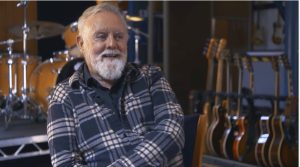
Brian May
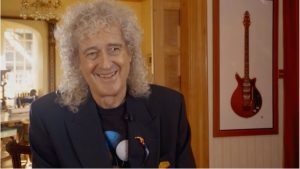
Photo Credit: Courtesy of Queen Productions Ltd
View Queen The Greatest Live – Episode 1: “Rehearsals (Part 1)”
YouTube Playlist Link: https://Queen.lnk.to/TheGreatestLive
Episode Embed link:
<iframe width=”560″ height=”315″ src=https://www.youtube.com/embed/yCuHPNLToXE title=”YouTube video player” frameborder=”0″ allow=”accelerometer; autoplay; clipboard-write; encrypted-media; gyroscope; picture-in-picture; web-share” allowfullscreen></iframe>
Next week: “Rehearsals – Part 2: Preparing for the biggest show of all time”
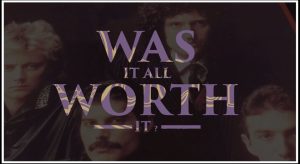
Living breathing rock’n’roll:
Career-Spanning New Video for “Was It All Worth It” Takes Us On Dazzling Ride through Queen’s Extraordinary Journey To The Miracle.
***Video Goes Live November 18***
Watch Here: https://Queen.lnk.to/WasItAllWorthIt
Queen “Was It All Worth It”
Embed Link
<iframe width=”560″ height=”315″ src=”https://www.youtube.com/embed/li569Oz158I” title=”YouTube video player” frameborder=”0″ allow=”accelerometer; autoplay; clipboard-write; encrypted-media; gyroscope; picture-in-picture” allowfullscreen></iframe>
Enhanced QUEEN THE MIRACLE COLLECTOR’S EDITION
8-disc Vinyl LP/5CD/DVD/Blu-ray Box Set
Also arriving November 18.
https://Queen.lnk.to/TheMiracle
You might need to be a Celebrity Mastermind on the subject of Queen to spot all the career landmarks squeezed into this newly created video for Queen’s The Miracle album track “Was It All Worth It” which dazzlingly captures the themes of the track through an inspired assemblage of archive footage, still photos and cutting-edge animation – and challenges hardcore fans to spot every last reference from a treasure-trove of Queen career milestones.
The countdown to the new “Was It All Worth It” video starts 12AM PT on Wednesday November 16, with fans invited to visit the dedicated YouTube Watch page at Queen.lnk.to/WasItAllWorthIt and share in the excitement and updates. The much-anticipated video will then go live Friday November 18 at 12AM PT/3AM ET – the same day as the arrival of highly anticipated The Miracle Special Collector’s Edition release. This very special boxset presents Queen’s classic 13th album as never before, including original takes, early demos, work-in-progress cuts, six previously unreleased tracks and candid audio of the unguarded band in the studio.
The grand closing out track to the band’s 13th album, The Miracle, the messaging behind “Was It All Worth It,” has been mulled and interpreted in many ways. This newly created video for the track doesn’t set out to quell any of the many espoused theories…but it is one hell of a ride through the myriad milestones of Queen’s historical accomplishments up to this point.
At six minutes in length – with epic orchestration and a lyric that charts the band’s journey from first drumkit to global fame – “Was It All Worth It” ranks amongst Queen’s most grandiose moments. “We thought, my God, we’re really getting overblown here!” Brian May told Sounds in 1989. “And there’s an element of humour in there, in the lyrics, which is nice. It’s a kind of conscious comment on some of the stuff we’ve done, and we did laugh at ourselves. We enjoy it, we like painting those pictures. It’s fun, and it’s something peculiar to Queen.”
“From talking to people who were there when “Was It All Worth It” was originally recorded, the band had a great time creating this song in the studio,” says the video’s director Simon Lupton. “Animator Jake McBride and I also had a joyous experience creating this video over 30 years later and taking fans on a whistlestop tour through Queen’s incredible journey. We hope viewers enjoy spotting all the nods and references we’ve included.”
Starting with the diverse paths that brought the four members to the rock ‘n’ roll epicentre of London, the video nods to everything from the breakthrough 1974 shows at the Rainbow Theatre to Frank the robot colossus from 1977’s News Of The World and the nude cyclists from 1978’s “Bicycle Race” video – all cut with dazzling TV footage of the band taking flight. Look out, too, for the notice advertising for a ‘Brilliant Drummer’: an exact replica of the classified ad that brought Roger Taylor into the fold. “For this project,” says Simon, “I asked Brian if he’d rewrite the advert for us, and he very kindly did – so what appears in the video is a recreation of the original, made by Brian himself!”
As the new decade dawns, the “Was It All Worth It” video nods to the countless highlights of Queen’s triumphant ’80s. Needless to say, even casual fans will spot flagship visual and live landmarks, like the hoovering Freddie housewife of 1984’s “I Want To Break Free,” the record-breaking sets at the inaugural Rock In Rio in January 1985 and that summer’s earth-shaking performance at Live Aid, their final Magic Tour, movie soundtracks, iconic videos, schoolgirl Roger, dystopian flying cars, magical pyrotechnic projecting guitars…truly living breathing rock’n’roll.
Yet other references are more oblique and buried deeper –to identify them all, fans might need the encyclopaedic knowledge of British actor, writer and director Rhys Thomas, who did actually win the title of Celebrity Mastermind on the BBC Television series of the same name on the subject of Queen in 2010.
And more than enough there to keep pub quiz nights in play from now well into Christmas.
“The truly remarkable thing,” says Simon Lupton, “is there is still so much about Queen’s story that we couldn’t squeeze into the time we had, and we stopped at 1989 when The Miracle was released. There’s another 20 years of iconic Queen achievements, performances and recordings that we didn’t touch!”
One of the band’s most fascinating songs, there are flashes of wistfulness in Freddie’s “Was It All Worth It” lyric (‘Am I a happy man, or is this sinking sand?’). But just as the song ends on a note of vindication (‘Yes, it was a worthwhile experience – ha!’), so too does the new video, with a rapid-fire montage of album sleeves that reminds fans of Queen’s immeasurable contribution to British rock ‘n’ roll – and whets appetites for The Miracle Collector’s Edition boxset released the same day, November 18.
View Queen Was It All Worth It
https://Queen.lnk.to/WasItAllWorthIt
Photo
Link to image:
https://www.dropbox.com/s/0j8l44xclyuhqzm/WIAWI%203.jpg?dl=0
Queen The Miracle Collector’s Edition Box Set Assets
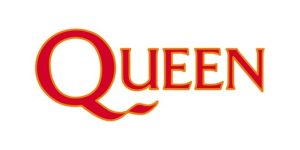

QUEEN rediscovered track featuring Freddie Mercury “FACE IT ALONE”
arrives as digital single release today, Thursday October 13
Digital/Streaming single available October 13
7” single available November 18
Listen / Pre-Order Now: LINK TBC
Precedes arrival QUEEN THE MIRACLE COLLECTOR’S EDITION
8-Disc Box Set: Vinyl LP/5CD/DVD/Blu-ray
Includes Lost Original LP Cut of classic 1989 album and
The Miracle Sessions CD, featuring original takes, demos and rough cuts, and six previously unreleased tracks – plus intimate fly-on-the-wall audio of the band at work in the studio
Coming November 18.
Pre-Order Now: LINK TBC
Having generated a media firestorm back in the summer when band members Brian May and Roger Taylor first leaked news of a rediscovered Queen song featuring Freddie Mercury being considered for possible release, the highly anticipated ‘lost’ track, “Face It Alone,” drops as a simultaneous worldwide single release today, Thursday, October 13 at 5.30am ET.
The track’s existence was first revealed by May and Taylor in a BBC radio interview at their appearance at this year’s Royal Jubilee concert at which they performed the opening with their regular singer Adam Lambert, with Roger Taylor describing it as “a little gem from Freddie that we’d kind of forgotten about,” with Brian May saying “it’s beautiful, it’s touching.”
The track’s arrival as a single leads into the November 18 release of a new revisiting of the band’s 13th album, The Miracle, the band’s penultimate to be released in Freddie Mercury’s lifetime, which now becomes available in a lavish 8-disc Queen The Miracle Collector’s Edition box set format.
Among its contents, the expanded set includes The Miracle Sessions: an hour-plus disc of further previously unreleased recordings, including six unpublished songs. Just as tantalising for fans, the audio includes the band’s candid spoken exchanges on the studio floor in London and Montreux, giving the most revealing window yet into the four members’ creative process and the joy, in-jokes and banter on their return to working together.
“Face It Alone” was originally recorded during the band’s historic 1988 sessions for that album, a prolific period which saw the band lay down around 30 tracks, many of which were never released, but remained among those that didn’t make the final album cut. It was rediscovered when the band’s production and archive team returned to those sessions to work on The Miracle box set reissue.
“We’d kind of forgotten about this track,” admits Roger Taylor, “but there it was, this little gem. It’s wonderful, a real discovery. It’s a very passionate piece.”
The single will be the first new song featuring Freddie Mercury released in over 8 years. On 2014’s Queen Forever
album the band included three previously unheard tracks with Mercury, including “Let Me in Your Heart Again,” “Love Kills” and “There Must Be More to Life Than This.”
Speaking of the rediscovered track, Brian May says: “I’m happy that our team were able to find this track. After all these years, it’s great to hear all four of us … yes, Deacy is there too … working in the studio on a great song idea which never quite got completed … until now!”
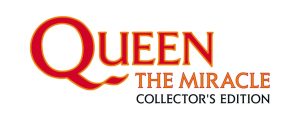
QUEEN THE MIRACLE COLLECTOR’S EDITION
33 years later Queen deliver Long Lost Original LP Cut of classic 1989 album
8-Disc Box Set: Vinyl LP/5CD/DVD/Blu-ray to arrive November 18.
Pre-Order Now: https://Queen.lnk.to/TheMiracle
Includes The Miracle Sessions, containing over an hour of unreleased studio recordings including six previously unpublished songs – plus intimate fly-on-the-wall audio of the band at work (and play) in the studio
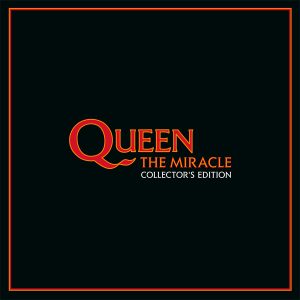
Box Set Assets Here
Widely recognised as Queen’s strongest album of the 80’s and one of their most inspired, the 1989 released The Miracle was a global success reaching No. 1 in the UK and several major European markets, even re-establishing the band in the US where it delivered a gold album. Brian May has often cited the title track as his favorite Queen song of all time.
The hugely prolific sessions for The Miracle began in December 1987 and stretched out to March 1989. It was to be one of the most consequential periods in Queen’s history. Fifteen months previously, on August 9, 1986, Queen’s mighty Europe Magic Tour had ended on a high, before an estimated audience of more than 160,000 at Knebworth Park in Britain. As the band left the stage that night – toasting the flagship show of their biggest tour to date – they could hardly have foreseen that Knebworth marked a line in the sand. This would be Queen’s final live show with Freddie and the first in a chain of pivotal moments that would lead towards a lengthy separation for the band.
It would take 15 months and a radical re-structuring of internal band dynamics before Queen regrouped in London’s Townhouse Studios on December 3rd, 1987, to start work on their thirteenth studio album. For the first time, Queen would share songwriting credits equally, regardless of who conceived each song, a consensus of opinion that was to have fertile results. “Splitting the credits was a very important decision for us. We left our egos outside the studio door,” says Brian, “and worked together as a real band – something that wasn’t always the case. I wish we’d done it 15 years before.”
Said Roger: “Decisions are made on artistic merit, so ‘Everybody wrote everything’ is the line, rather than ego or anything else getting in the way. We seem to work together better now than we did before. We’re fairly up-and-down characters. We have different tastes in many ways. We used to have lots of arguments in the studio, but this time we decided to share all the songwriting, which I think was very democratic and a good idea.”
This show of unity was elegantly conveyed by band art director Richard Gray’s cover for The Miracle, which depicts Queen’s four faces merged into one. “The cover art represents the unity of the group at the time: a seamless merging of four people becoming one,” May has said. “We were also dealing with Freddie’s deteriorating health and pulling together to support him.”
While Freddie could no longer tour, Queen remained a band of staggering creative resourcefulness. As John Deacon implied, they instead channelled their live chemistry into the studio: “In the first few weeks of recording we did a lot of live material, a lot of songs, some jamming, and ideas came up.”
“’Party’ and raw rock ‘Khashoggi’s Ship’ evolved naturally, straight away,” said Freddie. Inspired by something Anita Dobson would say, and later adopted for anti-apartheid protests, the massive “I Want It All” was – though written before the band went into the studio – a forceful expression of Queen’s concert-honed heavy-rock powers. “We were never able to perform this song live with Freddie,” said May. “It would have become something of a staple core of the Queen show, I’m sure, because it was very participative – designed for the audience to sing along to – very anthemic.”
Says Roger: “Lots of the [Miracle] tracks have first-take stuff in them; we tried to preserve that freshness. We tried to capture all the enthusiasm that we had from playing together as a band.”
Queen’s writing also reflected their personal circumstances. The torn-from-the-headlines drama of “Scandal” was May’s personal swipe at the press intrusion into the bandmembers’ respective personal affairs. Singled out by Deacon for praise, Freddie’s soaring album closer, “Was It All Worth It,” has in retrospect been interpreted as a reflection on the singer’s health.
One further ingredient in the mix was David Richards, who had worked with Queen since his billing as assistant engineer on Live Killers. After further credits on A Kind of Magic and Live Magic, Richards stepped up to co-produce The Miracle, praised by May for his “whizz kid” technical prowess.
The months in the studio birthed 30-plus songs, more than Queen could possibly need for one album. Ten tracks were selected to form the release, with others later appearing as B-sides or solo tracks, or carried over to the Innuendo and Made in Heaven albums. Five hit singles supported the album.
Says Brian: “We had all these bits and pieces of tracks, and some of them were half-finished, some of them were just an idea, and some of them were nearly finished, and it sort of happened on its own really. There are some tracks which you always want to get out and work on, and so they get finished, and there are some tracks which you think, ‘Oh that’s great, but I don’t really know what to do with it at this moment,’ so they naturally get left by the wayside.”
Most of these left-over session tracks remained undisturbed in the Queen archives for the past 33 years.
For the Queen hardcore, meanwhile, one of the most highly anticipated elements of the new box set is The Miracle Sessions CD featuring original takes, demos, and rough takes of the full album plus six additional previously unreleased tracks.
Tantalising enough that this hour-plus disc offers the first official airing of such near-mythical songs as “Dog With A Bone,” “I Guess We’re Falling Out,” “You Know You Belong To Me,” and the poignant “Face It Alone,” released as a single in October. Add to that, the trove of sunken treasure spanning from original takes and demos to rough cuts that signpost the album The Miracle would become.
But perhaps the real gemstones of The Miracle Sessions CD are the spoken segments that bookend the musical takes. As the studio tape keeps rolling in London and Montreux, the four members are caught at their most candid, giving listeners the uncanny fly-on-the wall experience of standing amongst Freddie, Brian, John and Roger as they banter, debate, swap jokes and show both joy and occasional frustration.
With the band arriving at the studio with scarce mapped-out material these sessions found Queen at their most inspired and impulsive, and that atmosphere is mirrored in not just the music but the familial exchanges that punctuate it. As Freddie said: “I think it’s the closest we’ve ever been in terms of actually writing together.”
“Before we all pass out, can I just try this?”
Freddie Mercury (“I Want It All”)
“I don’t want to do the fancy bits now…I’ll do them later.”
Brian May (“Khashoggi’s Ship”)
Heard for the first time in Queen history, the spoken outtakes from The Miracle Sessions invite fans onto the studio floor to experience the band’s unvarnished dynamic, more natural and revealing than any official press interview. These unguarded exchanges – by turns mischievous, encouraging, witty, even affectionately waspish – capture the band as they truly were during The Miracle’s late bloom, buzzing with renewed enthusiasm at their return to the studio, and driven by a rare chemistry that still threw up sparks.
Another first for the box set is the reinstatement of “Too Much Love Will Kill You.” The Miracle was originally planned to be an 11-track album, but “Too Much Love” was removed at the last minute due to unresolved publishing issues. Later, Queen’s original version was to emerge on Made in Heaven in 1995, featuring Freddie’s lead vocal. While the CD version of the album remains faithful to the familiar ten-song running order, the vinyl record in this Collector’s Edition marks the first time that “Too Much Love Will Kill You” has been presented as part of the album, in the exact position on Side One it was allocated in 1989.
Elsewhere, The Miracle Collector’s Edition brims with rarities, outtakes, instrumentals, interviews and videos, including the last interview John gave, from the set of the video for the hard-driving single “Breakthru.” The richly packed box set also includes a lavish 76-page hardback book featuring previously unseen photographs, original handwritten fan-club letters from the band, press reviews from the time and extensive liner notes, with recollections from Freddie, John, Roger and Brian on both the making of the album and some of their most iconic videos.
Featuring a plethora of fascinating insights into a hugely pivotal moment in Queen’s storied history, this is The Miracle fans have been waiting for.
*************
Queen The Miracle Collector’s Edition
Content listing
VINYL LP: The Miracle
Long Lost Original LP Cut
The Miracle as never heard before. Sourced from a master tape from March 1989, the Long Lost Cut reinstates “Too Much Love Will Kill You” as it was originally intended, in the exact position on Side One allotted in 1989, nestled between “I Want It All” and “The Invisible Man.” The updated LP sleeve presents the album with a gatefold cover for the first time in its history.
CD 1: THE MIRACLE
The album as originally released on CD, remastered by Bob Ludwig in 2011 from the original first-generation master mixes.
CD 2: THE MIRACLE SESSIONS
A fascinating window into the band’s creative process featuring much sought-after original takes, demos and early versions, including the new single “Face It Alone,” among six previously unheard tracks. Just as revealing – and sure to be prized by the Queen hardcore – are the spoken exchanges between the four members at the Townhouse, Olympic and Mountain Studios, giving listeners a unique snapshot of their friendship and working dynamic.
CD 3: ALTERNATIVE MIRACLE
Recreates the proposed follow-up to the album, Alternative Miracle. Originally considered at the time, this compilation of extra tracks from The Miracle, B-sides, extended versions and single versions was cancelled due to a heavy release schedule.
CD 4: MIRACU-MENTALS
Instrumentals and backing tracks of the ten songs that make up The Miracle.
CD 5, THE MIRACLE RADIO INTERVIEWS
The band discuss, in their own words, the creative process behind the album. The first interview, Queen for an Hour, was broadcast on BBC Radio 1 on May 29, 1989. Host Mike Read speaks with the band for what would be their final group interview. In this interview, Freddie suggests for the first time that his touring days are over. The second interview presents Roger Taylor and Brian May talking with host Bob Coburn and taking live telephone calls on the popular US radio programme Rockline.
BLU-RAY / DVD: The Miracle Videos
The Miracle Videos includes the five promotional music videos and bonus content on both Blu-ray and DVD formats.
“I Want It All”
“Breakthru”
“The Invisible Man”
“Scandal”
“The Miracle”
Plus:
The Miracle Interviews:
Interviews with Roger, Brian and John on the set of the “Breakthru” film shoot in June 1989, by Gavin Taylor.
John Deacon has given no further interviews since that day.
The Making of the Miracle Videos:
This feature contains behind the scenes footage of “I Want It All,” “Scandal,” “The Miracle” and “Breakthru” videos.
The Making of the Miracle Album Cover:
Queen’s graphic designer Richard Gray talks about and demonstrates how he made the ground-breaking The Miracle album cover.
THE MIRACLE
COLLECTOR’S EDITION – 2022
Executive Producers: Brian May and Roger Taylor
All tracks written by Queen
Except: “Too Much Love Will Kill You” (May, Musker, Lamers),
“My Melancholy Blues” (Mercury), and “You Know You Belong To Me” (May)
Content supervised by Justin Shirley-Smith, Kris Fredriksson and Greg Brooks.
Audio compilation and restoration Kris Fredriksson
Project managed by Emma Donoghue
In an always fascinating and sometimes amusing read, The Miracle Collector’s Edition hardback art book also looks back across two pages on how critics of the time responded to The Miracle on its original release.
QUEEN The Miracle
‘The Miracle’ sees Queen once again redefining Rock ‘N’ Roll on their own terms, stoically ignoring those too narrow-minded or stupid to get the point.
Vocalist Freddie Mercury has always attracted the greatest amount of flak from critics too busy crawling up their own posteriors to recognize the man’s tongue-in-cheek self-deprecating witticisms, or to acknowledge the fact that he’s one of the greatest Rock vocalists ever. Examples? Every single track, I’m afraid. ‘Breakthru’ and ‘Scandal’ prove that he can still reach the top notes with effortless ease, whilst ‘Rain Must Fall’ and ‘My Baby Does Me’ feature him scatting and crooning with soulful intensity. Beautiful.
No individual song credits this time, so it’s hard to evaluate the songwriting contributions of drummer Roger Taylor or bassist John Deacon, but I’ll bet that Deacon had more than a hand in the funkier moments of ‘Khashoggi’s Ship’. Meanwhile, ‘The Invisible Man’ sounds distinctly Tayloresque, with its eerie, shuffling rhythm passages and up-front bass work.
The arrangements are quite extraordinary, a result of the band’s ability to dabble in whatever musical genre they damn well please, doubtless fuelled by individual members’ excursions into fields as diverse as Opera and Metal. Both the title track and closer ‘Was It All Worth It’ feature the sort of ingenious orchestral twists and turns that have remained the band’s trademark since the heady days of ‘The March Of The Black Queen’ (‘Queen II’ – 1974) when ‘Nobody played synthesiser’.
…I could go on, but space doesn’t permit (‘Thank God’ – rest of RAW office). Let’s just say that Queen will always be the cultured satin-draped heart of Rock ‘N’ Roll … and it feels so good to have ‘em back.
[Maura Sutton. Raw Magazine. May 1989)
QUEEN ‘I Want It All’ (Parlophone)
A long-standing institution they may be, but Queen still know how to take on today’s bratty young rockers when the urge takes them. In a typically extravagant return to form,
Queen put their disco shoes away for a while and slip back into their own glorious
brand of power metal.
There’s no other sound as hot and mellifluous as Brian May’s guitar, and here he spars with funny old Freddie in full camp and grind mode, as ‘IWIA’ builds to a stadium filling climax. Theatrical rock with guts.
[Neil Perry. Sounds. May 6, 1989]
CARRY ON CAMPING
‘THE MIRACLE’ is a good, old-fashioned, lovably preposterous Queen album. It’s a widescreen sprawl that flits from gurgling pulp-funk to high-stepping rockstomp to the kind of eccentric, epic melodramas that swelled the early albums.
‘The Miracle’ is fantastic entertainment – extravagant, potty, def Queen.
[Paul Elliott. Sounds. May 27, 1989]
Press Contact:
Sharrin Summers / Hollywood Records
Sharrin.summers@disney.com

OFFICIAL CHART RECORD BREAKER
Queen’s Greatest Hits becomes first album in Official Charts history to reach 7 million UK chart ‘sales’
Brian May and Roger Taylor “humbled and honoured” as they make the milestone
www.officialcharts.com/p/36841
(July 19, 2022) British rock legends Queen make UK chart history as they become the first act ever to reach 7 million UK chart ‘sales’ of an album, the Official Charts Company can confirm.
Queen break Official Chart records as they surpass the 7 million milestone with their 1981 Greatest Hits album. The Official best-selling album of all time in the UK, the record includes such classic tracks as We Will Rock You, Don’t Stop Me Now and the group’s top-selling behemoth Bohemian Rhapsody.
Greatest Hits reaches this record-breaking achievement through a combination of physical sales, downloads and streams.
Back in 2014, Queen’s Greatest Hits became the first album to ever surpass 6 million sales in the UK and, as pure sales (physical and digital download copies) of the collection continue to increase, the group’s back catalogue proves enduringly popular in the modern streaming age. Greatest Hits has accumulated an incredible 1.26 billion total UK streams to date, with the album’s most-streamed track being Bohemian Rhapsody, which boasts 240 million UK streams and counting.
The record also recently celebrated its 1000th week on the Official Albums Chart, with Queen becoming the first British act ever to achieve this landmark milestone.
Speaking to OfficialCharts.com, Queen guitarist Brian May says: “We’re here to bring you the joyous news that Queen’s Greatest Hits album has sold 7 million copies, which nobody has ever done before. No album has done this before in history. Thank you, we appreciate it.”
Queen’s Roger Taylor adds: “The British public and their infinitely-great taste have made this the biggest-selling album in history. Thank you very much; we’re humbled and honoured. We salute you!”
Martin Talbot, Chief Executive, Official Charts Company, comments: “It really is a fantastic achievement by Queen to become the first act to notch up 7 million sales of one album, with their legendary Greatest Hits. When it was released for the first time in 1981, career-spanning packages such as Greatest Hits were relatively rare, the preserve of only the very biggest acts. Queen’s Greatest Hits can claim to be in more than one-in-four UK households’ record collections today, and there is no doubt that its massive success has done as much as any other release to turn hits packages into the omnipresent album concept that they are today.”
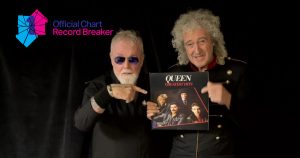
Above: Queen’s Roger Taylor and Brian May celebrate 7 million ‘sales’ of their Greatest Hits album (credit: Official Charts Company)
Watch new Queen video:
Embed new Queen video:
<iframe width=”560″ height=”315″ src=”https://www.youtube.com/embed/9D0WgJCobss” title=”YouTube video player” frameborder=”0″ allow=”accelerometer; autoplay; clipboard-write; encrypted-media; gyroscope; picture-in-picture” allowfullscreen></iframe>
Video credit: Emma Donoghue.
This comes as Queen + Adam Lambert announce Rhapsody Over London; a concert film available to stream live and on-demand later this month.
The exclusive concert spectacular, filmed live at London’s O2 Arena during the group’s sold-out European tour, will premiere live via Kiswe’s global streaming platform on July 24. The stream will also include a Q&A with Brian, Roger and Adam, speaking backstage from the penultimate show of their European tour.
Rhapsody Over London will give fans worldwide the once-in-a-lifetime opportunity to experience Queen’s dazzling 28-song show, which honours the late Freddie Mercury’s enduring ethos that “too far is never far enough.” Find out more information here.
Notes to Editors
Chart information quoted from this release must be credited to the Official Charts Company.
You are receiving this email because you are registered on the Official Charts Company press mailing list. You can view our privacy policy here, or to unsubscribe simply respond to the sender of this email with your request.
About Official Charts Company
The Official Charts Company are the providers of the UK’s only official music and video charts, as seen at OfficialCharts.com, on BBC Radio 1, MTV, Music Week, The Sun, Daily Star and many more. Compiling its charts purely from sales and streaming information gathered across all key distribution (or entertainment) channels including all major high street retail chains, independent stores, supermarkets, mail order internet retailers and digital music and streaming service providers. This market research sample equates to 99% of the total UK singles market; 98% of the total UK albums market and 90% of the total UK DVD market.
The Official Charts Company is a joint venture between record labels’ body the BPI and ERA, the Entertainment Retailers Association. The Official Charts Company are responsible for the commissioning, marketing, distribution and management of the UK’s industry standard music charts and industry sales data.
About OfficialCharts.com
OfficialCharts.com is the new destination site of the UK’s Official Charts, delivering exclusive breaking chart news, video interviews with the week’s Official Number 1 artist, hot new releases and competitions to 2.5 million of the UK’s biggest chart fans monthly. You can access the full Official Singles and Official Albums Chart Top 100, published Fridays at 5.45pm, plus official genre and format charts for Rock, RnB, Dance, Streaming, Vinyl and many more. You can also search our historical chart archive from the Access The Archive box on the home page, here you can search the Official Charts Company archive by date, artist, song or album title or keyword.
View the Official Charts
The Official Charts Company publishes the full Official Singles Chart and Official Albums Charts Top 100 online at http://www.officialcharts.com/charts/singles-chart/ and http://www.officialcharts.com/charts/albums-chart/. You can also search our historical chart archive from the Access The Archive box on the home page, here you can search the Official Charts Company archive by date, artist, song or album title or keyword.
Hear the Official Charts
The Official Chart with Scott Mills, Fridays 4 – 5.45pm, BBC Radio 1; BBC Radio 1 can be found on 97-99FM; on DAB Radio; online at bbc.co.uk/radio1; and on Freeview, Sky, Virgin and Freesat.
The Official Chart: First Look with Katie Thistleton & Vick Hope, Sundays 6-7pm, airs on BBC Radio 1 and gives a first glance of the Top 20 ahead of Friday’s Official Singles Chart Top 100. The chart is based on preliminary sales and early streaming reports, giving music fans a weekly sneak preview of the Official Singles Chart. The First Look reveals how songs are performing in the first two days of the chart week (Friday-Saturday), outlining the hottest new tracks of the week so far, as well as the new entries and highest climbers.
Queen’s The Platinum Collection To Be Released On Vinyl For The First Time As A Limited-Edition 6LP Color Vinyl Box Set On June 17
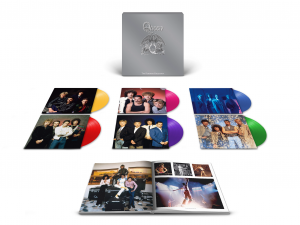
Watch the Unboxing Trailer HERE: Queen.lnk.to/PlatinumCollectionUnboxingVideo
Available to Pre-Order NOW: Queen.lnk.to/PlatinumCollectionVinyl
DOWNLOAD ARTWORK & PHOTOS
https://www.dropbox.com/sh/cgz21nunkhuc7vq/AAD1kP7VHkWewDu4S79IDb7Sa?dl=0
Released for the first time on vinyl, Queen’s compilation The Platinum Collection, featuring all three of their Greatest Hits albums, shows their unrivalled track record of chart-topping, award-winning, record-breaking rock and pop classics. With four songwriters in the band – Freddie Mercury, Brian May, Roger Taylor and John Deacon – Queen created a glorious legacy of all-time anthems that still ring out across the ages. For past and future fans alike, they will rock you!
Living up to its name, The Platinum Collection is certified 5x Multi-Platinum in the US and was recently certified by the UK music industry organization the BPI as having gone 8 x Platinum, representing sales of 2.4 million achieved since its June 2011 re-release as part of Queen’s 40th anniversary celebrations.
June 17 will see the limited edition 6LP color vinyl set released in a slipcase with brand new artwork. Each piece of vinyl will be a different color and come in its own individually designed sleeve. The set also comes with an exclusive 24-page 12″ photo booklet.
QUEEN Greatest Hits, first released in 1981, is certified 9x Platinum in the US and is the best-selling album of all time in the UK, having sold over 6.8 million copies, with global sales in excess of 25 million. Spanning Queen’s triumphant first act, from 1974 to 1980, Greatest Hits includes some of the world’s most beloved rock standards, including the stadium-sized symphonic chart-topper
‘Bohemian Rhapsody,” recently inducted into the National Recording Registry of the Library of Congress as a culturally, historically, and aesthetically significant song worthy of preservation for all time, and the roof-raising “We Are The Champions,” which was named the most catchy song of all time by a team of scientists in 2011. But this album also dazzles with its stylistically promiscuous range, from the crowd rousing “We Will Rock You,” the tongue in cheek “Fat Bottom Girls,” the stomp-stomp-stomp late 70’s disco inspired “Another One Bites the Dust,” to the finger-snapping jukebox retro-rock homage “Crazy Little Thing Called Love” and the soaring, impassioned, gospel-fired Aretha-isms of “Somebody To Love.”
QUEEN Greatest Hits II, originally released shortly before Freddie Mercury’s death in 1991, has sold over 19 million copies worldwide. It spans 1981 to 1991, the period which followed Queen having dropped their famous no synthesizers rule elevating them to new heights of creativity. Opening up their guitar-heavy sound to embrace funk, disco and electronics resulted in rich rewards, transforming these former Seventies glam rockers into a glossy, streamlined, emphatically contemporary super-group. Rebooted and rewired, Queen produced some of their most immortal hits during this imperial Eighties phase. Built around an improvised studio jam, their infectious David Bowie collaboration “Under Pressure” became a global chart-topping smash. The retro-futurist epic “Radio Gaga” and the humorously romantic “I Want To Break Free” stand as testaments to their early mastery of synthesizers, while the muscular ripcord riffs of “Hammer To Fall” and octave-vaulting grand-piano acrobatics of “It’s a Hard Life” are vintage Queen both sonically and lyrically. Officially the tenth best-selling album of all time in the UK, Greatest Hits II also features the tender sentiments of “Friends Will Be Friends,” the planet-sized synth-rock fanfares of “One Vision,” and the heroically defiant swan song “The Show Must Go On,” featuring Freddie in his last days still playing shamelessly to the gallery.
QUEEN Greatest Hits II, rarely available on vinyl, features their latter-day songs, the band members’ solo hits and the band’s collaborations with other artists including Elton John, Montserrat Caballé, George Michael and Wyclef Jean.
Undimmed by time or fashion, The Platinum Collection is a reminder that Queen were always colorful, always dynamic, always ablaze with passion and pride.
TRACKLISTING
Greatest Hits – LP 1 – Side A
- “Bohemian Rhapsody”
- “Another One Bites The Dust”
- “Killer Queen”
- “Fat Bottomed Girls”
Greatest Hits – LP 1 – Side B
- “Bicycle Race”
- “You’re My Best Friend”
- “Don’t Stop Me Now”
- “Save Me”
Greatest Hits – LP 2 – Side A
- “Crazy Little Thing Called Love”
- “Somebody To Love”
- “Now I’m Here”
- “Good Old Fashioned Lover Boy”
Greatest Hits – LP 2 – Side B
- “Play The Game”
- “Flash”
- “Seven Seas Of Rhye”
- “We Will Rock You”
- “We Are The Champions”
Greatest Hits II – LP 3 – Side A
- “A Kind Of Magic”
- “Under Pressure” (Queen + David Bowie)
- “Radio Ga Ga”
- “I Want It All”
- “I Want To Break Free”
Greatest Hits II – LP 3 – Side B
- “Innuendo”
- “It’s A Hard Life”
- “Breakthru”
- “Who Wants To Live Forever”
Greatest Hits II – LP 4 – Side A
- “Headlong”
- “The Miracle”
- “I’m Going Slightly Mad”
- “The Invisible Man”
Greatest Hits II – LP 4 – Side B
- “Hammer To Fall”
- “Friends Will Be Friends”
- “The Show Must Go On”
- “One Vision”
Greatest Hits III – LP 5 – Side A
- Queen + Elton John – “The Show Must Go On” (Live, Theatre National de Chaillot, Paris, 1997)
- Queen + David Bowie – “Under Pressure” (Rah Mix)
- Freddie Mercury + Montserrat Caballé – “Barcelona” (Single Version)
- Queen – “Too Much Love Will Kill You”
Greatest Hits III – LP 5 – Side B
- George Michael + Queen – “Somebody To Love” (Live, The Freddie Mercury Tribute Concert For AIDS Awareness, Wembley, April 1992)
- Queen – “You Don’t Fool Me”
- Queen – “Heaven For Everyone”
- Queen – “Las Palabras De Amor” (The Words Of Love)
Greatest Hits III – LP 6 – Side A
- Brian May – “Driven By You”
- Freddie Mercury – “Living On My Own”
- Queen – “Let Me Live”
- Freddie Mercury – “The Great Pretender”
- Queen – “Princes Of The Universe”
Greatest Hits III – LP 6 – Side B
- Queen + Wyclef Jean – “Another One Bites The Dust” (Remix)
- Queen – “No One But You (Only The Good Die Young)”
- Queen – “These Are The Days Of Our Lives”
- Queen – “Thank God It’s Christmas”
Coming Soon:
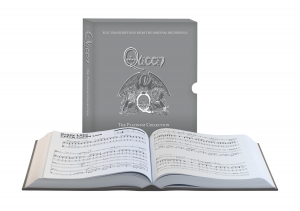
Queen – The Platinum Collection. Complete Scores Collector’s Edition.
At last … a collector’s edition fit for Queen! The new Queen Platinum Collection is a hardcover edition featuring full-band transcriptions for nearly 50 classics from the iconic band. Every instrument, every note, every lyric, and every nuance of every song is carefully transcribed. It’s beautifully packaged in a protective sturdy slipcase. Songs include: “Another One Bites the Dust” · “Bicycle Race” · “Bohemian Rhapsody” · “Crazy Little Thing Called Love” · “Don’t Stop Me Now” · “Fat Bottomed Girls” · “The Great Pretender” · “I Want It All” · “I Want to Break Free” · “Killer Queen” · “Radio Ga Ga” · “The Show Must Go On” · “Somebody to Love” · “Thank God It’s Christmas” · “Under Pressure” · “We Are the Champions” · “We Will Rock You” · “You’re My Best Friend” · and more.
Further Information Queen The Platinum Collection Vinyl Box Set:
Sharrin Summers
More Information on The Platinum Collection complete scores collector’s edition:
Trish Dulka | Hal Leonard Vice President Corporate Publicity & Communications
Email: tdulka@halleonard.com
Tel: ++ 414.774.3630
Link to pre-order:
https://www.halleonard.com/product/366199/queen-the-platinum-collection
Special YouTube Premiere Screening
SATURDAY, MARCH 19 – 10AM PT / 1PM ET
Queen + Paul Rodgers: Live In Ukraine 2008 – YouTube Special
In support of Ukraine, Queen is returning to its historic Kharkiv concert with a
YouTube special screening aimed at raising funds
for Ukraine Relief.
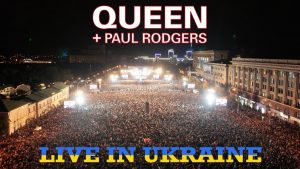
Link to video assets here: https://umusic.box.com/s/8rnf5utz3etx09bibwh6doht29xwm7ap
In September 2008 Queen + Paul Rodgers answered a call from Ukraine’s Elena Pinchuk AntiAids Foundation to reach out to the youth of the country with the message “Don’t Let AIDS Ruin Your Life” by playing a free Life Must Go On Aids awareness concert performed in Ukraine’s second largest city Kharkiv’s historic Freedom Square to a live audience of over 350,000 – and a television audience of more than 10 million.
The band recall that event as “an unforgettable experience…one of those rare things in life you know you will never forget. A meeting in music, but also a coming together to fight a common enemy…”
Today, with millions of Ukrainian refugees in need of urgent humanitarian relief from a different affliction, Queen is returning to that historic moment
with a YouTube special screening aimed at drawing donations for UNHCR relief efforts.
“Queen + Paul Rodgers Live In Ukraine” plays on YouTube Saturday, March 19 at 10AM PT / 1PM ET
Please make your donations to: UNHCR – The UN Refugee Agency.
YouTube Link: https://youtu.be/PGCTQTZXGXs
YouTube Embed Link: https://www.youtube.com/embed/PGCTQTZXGXs
YouTube Embed Link
<iframe width=”560″ height=”315″ src=”https://www.youtube.com/embed/PGCTQTZXGXs” title=”YouTube video player” frameborder=”0″ allow=”accelerometer; autoplay; clipboard-write; encrypted-media; gyroscope; picture-in-picture” allowfullscreen></iframe>
Queen + Paul Rodgers: Live In Ukraine 2008.
28 Queen + Paul Rodgers classic tracks performed live
One Vision
Tie Your Mother Down
The Show Must Go On
Fat Bottomed Girls
Another One Bites the Dust
Hammer to Fall
I Want it All
I Want to Break Free
Seagull
Love of My Life
39
Drum Solo
I’m in Love With My Car
Say It’s Not True
Shooting Star
Bad Company
Guitar Solo
Bijou
Last Horizon
Crazy Little Thing Called Love
C-lebrity
Feel Like Makin’ Love
Bohemian Rhapsody
Cosmos Rockin’
All Right Now
We Will Rock You
We Are the Champions
God Save the Queen
Run Time: 2:00h41
Queen The Greatest: a celebration of 50 of the greatest moments from the Queen story so far.
A 50-week YouTube series celebrating key moments in Queen’s history reminding us why Queen and their music continue to beloved across the world
Queen The Greatest Episode 50: “A Decade of Queen + Adam Lambert – Part 2”
A look back at the collaboration between Queen and Paul Rodgers that included a run of sell out tours around the world – with Brian and Roger performing in some cities for the first time, as well as revisiting some old favorites.
WATCH HERE
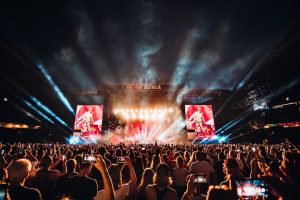
Credit: Photography courtesy Jordan Munns
Download LINK
Queen + Adam Lambert perform at Fire Fight Australia benefit concert.
ANZ Stadium Sydney, Australia, February 16, 2020
“Goodbye, everybody, we’ve got to go…”
After almost a full year, Queen The Greatest reaches its series finale episode and for this ultimate week continues its look back at the spectacular live performances from –
“A Decade of Queen + Adam Lambert.”
Between 2012 and 2020, Queen and Adam Lambert toured extensively, clocking up an incredible 218 performances in over 40 countries, and in front of an estimated three and a half million people.
Each new touring production seemed to get bigger and better, thrilling the crowds with a mixture of recognizable hits alongside imaginative interpretations of some of the deeper cuts.
Adam Lambert: “We have a little bit of a little treat in the set that we’re going to be doing this summer on tour. There is, what kind of is considered, a new song that many people might not have heard before in the context of Queen. Freddie Mercury worked on a song…
“He created a song with Giorgio Moroder for the film Metropolis. It’s called “Love Kills,” and we’re going to do it for you in our own way.”
But never far from everyone’s minds, was the legacy of how it all started.
Adam Lambert: “I knew Queen songs before I knew who Queen were. I mean, they’re just ever present and to get up there for me personally, and to get up to celebrate Freddie as well, is a real treat. You know, there’s no replacing Freddie. It’s not possible. So to be on stage and to talk to the audience about Freddie, and we show Freddie on the screen a couple of points in the show, we hear his voice, that’s very important for this, this experience, for the audience.”
Brian May: “There’s one song that I sing together with Freddie, which is always a great moment. I can’t see ever not wanting to do that really. And of course, the audience do it all. It’s all about the audience, and sharing that moment.”
Brian May: “The memories, and the fact that we’re still here, and the legacy lives on, and I think Freddie would be so happy about that.”
At the beginning of 2020, the band was in full flight with their Rhapsody Tour already playing to sold out crowds across And although the global pandemic was about to put plans to tour across Europe on hold, Queen and Adam Lambert, in response to a tragedy unfolding in Australia, managed to contribute to a show, with what is regarded as one of their absolute finest performance – replicating for the first time ever the band’s iconic 1985 Live Aid set for the Fire Fight Australia fundraising concert, staged to help communities affected by Australia’s devastating brushfires.
The 22-minute performance even included video footage from the 1985 show, honouring Freddie Mercury in a digital cameo with the re-enactment of one of his most iconic audience-participation moments.
Brian May: “It was incredible because, you know, it was a terrible thing to see the fires sweep through Australia and the amount of hardship, and people losing their homes, the amount of wild animals killed. Very tragic. And we happened to be in Sydney at a point where it was convenient to put on a concert to raise awareness, raise money for the cause, for the fire fighters. So we’d already done our show the night before, and we kind of donated our stage to open the stadium the next night.
“The feeling of adrenaline was insane. And strangely, we had already decided that we wanted to recreate the Live Aid set. Because there’s a lot of similarities between the causes. And so we went on and just as, you know, the original Live Aid, it was a one off. We’ve never done that set before, and this was a one off to. And the audience were…”
Adam Lambert: “They were wild. Yeah.”
Brian May: “So energized. That’s the highlight of this whole thing that we’re putting out, I think, that we end up in Sydney at that Fire Fight concert.
It was another one off.”
Roger Taylor: “The feeling of electricity in the stadium in Sydney before we went on, was incredible. So I think it connected.”
Later that year, that particular set also appeared on the Queen + Adam Lambert Live Around The World album – a compilation of some of the stand out live performances from the Queen + Adam Lambert years, that was released as a thank you to the fans. Queen’s first album without Freddie and John Deacon, it raced to number one in the charts in October 2020, ensuring Queen entered their sixth decade with another number one album and providing Adam with his first UK No.1 album.
Thank you for watching Queen The Greatest and joining this journey through the extraordinary Queen story – and with the band’s Rhapsody Tour about to resume in the coming months, it looks like that story will continue for many more years to come…
Embed link here:
<iframe width=”560″ height=”315″ src=”https://www.youtube.com/embed/pgy8U81YA_k” title=”YouTube video player” frameborder=”0″ allow=”accelerometer; autoplay; clipboard-write; encrypted-media; gyroscope; picture-in-picture” allowfullscreen></iframe>
Queen The Greatest Episodes 1-49: http://Queen.lnk.to/TheGreatest
# # #
Website / YouTube / Instagram / Facebook / Twitter / TikTok
Thanks for watching. We will be back!
Queen The Greatest
Written and produced by Simon Lupton
Edited by Fergus March
Film Researched by Keith Badman
With Special Thanks to:
Brian May & Roger Taylor
And Adam Lambert
Queen The Greatest: a celebration of 50 of the greatest moments from the Queen story so far.
A 50-week YouTube series celebrating key moments in Queen’s history reminding us why Queen and their music continue to beloved across the world
Queen The Greatest Episode 49: “A Decade of Queen + Adam Lambert – Part 1”
A look back at the collaboration between Queen and Paul Rodgers that included a run of sell out tours around the world – with Brian and Roger performing in some cities for the first time, as well as revisiting some old favorites.
WATCH HERE

Download LINK Download LINK
Queen +Adam Lambert perform Isle of Wight Festival, 2016
Roger Taylor: “I’ve never heard it sung like that. That’s, that’s special.”
Brian May: “He’s still astounding, the lengths he can push things to is extraordinary.
I very often go, ‘Wow.’”
Queen The Greatest draws to a close with a two-part look at Queen + Adam Lambert. This week looks at how the collaboration has enabled Brian and Roger to revisit some favourite venues and cities, while also enjoying spectacular new experiences.
Adam Lambert: “You know, why I have all these things on stage? Because I Want It All.”
As the Queen The Greatest series draws to a close with this penultimate episode we bring the story up to date with a look at – “A decade of Queen + Adam Lambert.”
Adam, Brian and Roger discuss their “brilliant, symbiotic relationship” and are seen in defining performances on their Asia Tour 2014 which saw a memory making return to Japan for Queen, and on their 2016 European Festivals tour highlighting a stand out Isle of Wight Festival performance of “Who Wants To Live Forever” that took even Roger and Brian by surprise.
When the response to their first forays on stage together in 2012 proved that the desire to see Queen music performed live was as strong as ever, Queen + Adam Lambert embarked on a series of tours that encompassed every continent.
As a result, fans new and old have had the opportunity to see a Queen show in all it’s majesty, and although this collaboration has been an exciting new venture, it also meant Brian and Roger could once again revisit some of their favorite cities and venues.
Adam Lambert: “It’s the most brilliant, symbiotic relationship you could dream of because, you know, one might say, ‘Oh, well, Adam, you know, if it weren’t for you, they wouldn’t be doing these venues with these countries,’ but it’s the same for me. If it weren’t for them, I wouldn’t be playing arenas all around the world, either.”
Adam Lambert: “I felt more so a sense of… magic. It was cool that they’re back doing this again.”
Roger Taylor: “Japan was fantastic. Last time we went, it was absolutely magical.”
“That, I think, more than anywhere else felt like the old days.”
Roger Taylor: “That brought back the memories in particular of first going to Japan and the fantastic reaction.”
Adam Lambert: “What meant a lot to me about going back to some of these famous venues that Queen has stamped their mark on, was seeing Brian and Roger being nostalgic about it. That meant a lot to me. That was really cool to be a part of those moments of them recalling the first time they were there and what it was like, and knowing also that there were members of the audience that were probably there the first time too.”
There have also been opportunities for them all to enjoy completely new experiences together. There are many highlights to choose from, but Queen’s first appearance at the world famous Isle Of Wight Festival in 2016, resulted in a truly memorable night.
Adam Lambert: “Once I got over my own head trip about, ‘Oh God, are they going to compare me to Freddie? Oh God, am I good enough?’ I realized this is this once in a lifetime experience to sort of be a vessel and just perform.”
And one of the standout moments from that evening, a towering performance of “Who Wants To Live Forever,” demonstrated what a powerful combination they had become.
Roger Taylor: “I’ve never heard it sung like that. That’s, that’s special.”
Brian May: “He’s still astounding, the lengths he can push things to is extraordinary. Sometimes I’m standing right here playing ‘Who Wants To Live Forever,’ and he’s there doing his thing. And when he goes into this stratospheric thing in the middle, I very often go, ‘Wow.’”
Embed link here:
<iframe width=”560″ height=”315″ src=” https://www.youtube.com/embed/p5J0w6uRDwk” title=”YouTube video player” frameborder=”0″ allow=”accelerometer; autoplay; clipboard-write; encrypted-media; gyroscope; picture-in-picture” allowfullscreen></iframe>
Next week : A Decade of Queen + Adam Lambert – Part 2
Queen The Greatest Episodes 1-48: http://Queen.lnk.to/TheGreatest
Website / YouTube / Instagram / Facebook / Twitter / TikTok
Queen The Greatest: a celebration of 50 of the greatest moments from the Queen story so far.
A 50-week YouTube series celebrating key moments in Queen’s history reminding us why Queen and their music continue to beloved across the world
Queen The Greatest Episode 48: “Queen at the Movies – Take 3: Bohemian Rhapsody”
A look back at the collaboration between Queen and Paul Rodgers that included a run of sell out tours around the world – with Brian and Roger performing in some cities for the first time, as well as revisiting some old favorites.
WATCH HERE
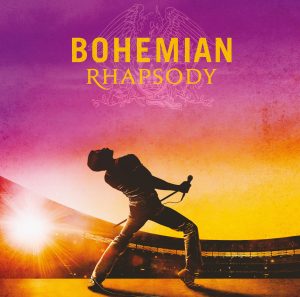
Download Artwork LINK
“This is a band that was revolutionary and continues to be. It’s about being your most authentic self, and Queen is the epitome of inclusivity, and I think that’s what the world really needs right now.” Rami Malek.
First announced in September 2010 as a film “focused on the band’s formative years leading up to Queen’s appearance at the historic Live Aid concert, 1985, when the band famously took the event by storm,” audiences would have to wait until October 2018 to see the Queen story transferred to the cinema screen. The overwhelming worldwide response would confirm the wait had indeed been worth it.
This week’s Queen The Greatest offers a third instalment of “Queen At The Movies” – and this time it’s the blockbuster Bohemian Rhapsody.
In 2018, the Bohemian Rhapsody movie was released to much anticipation, and quite literally took the worldwide box office by storm, setting a new record for the highest-grossing biographical film of all time.
But the journey to this point hadn’t been easy, with the idea taking almost a decade to be realised…
Brian May: “We were a little reluctant in the beginning because, you know, it’s difficult to make a film that would do Freddie justice. And what happened over the years, because it was suggested to us a lot, what happened was that we realized if we didn’t get involved, then somebody else would do it and then you wouldn’t be able to protect Freddie’s kind of legacy.”
Roger Taylor: “I think a lot of people, they think about Freddie, and the media tend to think, ‘Oh, flamboyant,’ whatever, you know? And they remember him for other things, and they tend to forget that he was a brilliant musician. I think the film does pay good attention to the fact that Freddie was a real, real great musician.”
Brian May: “We all felt we wanted to portray Freddie’s humanity, to portray him as a human being, like Roger says, as a musician. And it had to be truthful, and it had to be not too indulgent, and it had to be watchable, and, I think Freddie would say, number one, it had to be entertaining. And I think you have to laugh, you have to cry, and I believe people will do in this movie.”
Brian May: “Casting Rami (Malek) in the role of Freddie absolutely blew us away, the first time we met him. We kind of saw Freddie in him and we could sense his passion, and everything was put together around that, I guess.”
Rami Malek: “At first I thought it would be so daunting to be that extremely liberated, audacious performer that he was on stage who transcended everything about music. And so I thought, ‘OK, there’s a human being there that I could connect with.’ Now, I just wanted to discover how that human being with all those eccentricities and confusing thoughts could be so daring and bold on stage.”
Brian May: “We didn’t get to see him in full ‘shtick’ until that first moment when the cameras rolled on Live Aid. We both went down to see it, and it was, I don’t know what the word is, it just sent shivers up your spine because the recreation was so perfect of the venue and everything about it, including the backstage.
“And then these guys come on and they are us. And they plunged in the deep end. That was like the pinnacle performance they had to pull off right at the beginning of the shooting, which is tough, but they had it down.”
Roger Taylor: “They got very close to us, I mean, visually and as actors, and so which made it particularly uncanny to watch for us. After a couple of viewings you just start to completely believe ‘ah, that was us…oh no, it’s not. It’s other people.’ But, phenomenal.”
As well as setting new box office records for a biopic film, Bohemian Rhapsody won four Oscars, including Best Actor for Rami Malek, who also received the Golden Globe, Screen Actors Guild and BAFTA awards for his portrayal of Freddie.
More importantly, though, it introduced a whole new wave of fans to Queen, who were discovering the music for the first time. The film’s official soundtrack reached top ten positions in twenty-five countries during 2018/2019, becoming one of Queen’s top selling albums in almost 40 years and their second highest album chart placing ever in the US.
Rami Malek: “I want everybody, to be exposed to Queen. The music is so powerful. The lyrics are so powerful. They’re universal. And I think, you know, I don’t know if Queen ever wanted to be socially or politically conscious in their music, but can’t help it. I mean, this is a band that was revolutionary and continues to be. It’s about being your most authentic self, and Queen is the epitome of inclusivity, and I think that’s what the world really needs right now.”
Embed Link
<iframe width=”560″ height=”315″ src=” https://www.youtube.com/embed/l8scWyIPCJ8” title=”YouTube video player” frameborder=”0″ allow=”accelerometer; autoplay; clipboard-write; encrypted-media; gyroscope; picture-in-picture” allowfullscreen></iframe>
Next week: “A Decade of Queen + Adam Lambert – Part 1”
Queen The Greatest Episodes 1-47: http://Queen.lnk.to/TheGreatest
Website / YouTube / Instagram / Facebook / Twitter / TikTok
Queen The Greatest: a celebration of 50 of the greatest moments from the Queen story so far.
A 50-week YouTube series celebrating key moments in Queen’s history reminding us why Queen and their music continue to beloved across the world
Queen The Greatest Episode 47: “Queen 2002: Brian May On The Roof”
A look back at the collaboration between Queen and Paul Rodgers that included a run of sell out tours around the world – with Brian and Roger performing in some cities for the first time, as well as revisiting some old favorites.
WATCH HERE
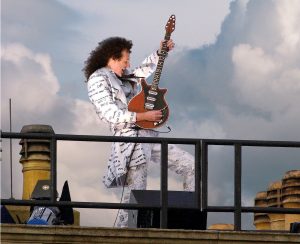
Credit: Photography by Arthur Edwards.
Photo Download LINK
“…then I thought ‘Oh God, I’ve got to do it now!’ The enormity of what I’ve suggested comes through to me and I think, ‘Oh my God, can I really do this thing?’” -Brian May
An invitation in 2002 to attend Buckingham Palace to celebrate the Queen Elizabeth II’s Golden Jubilee would provide Brian May a heady opportunity to perform one of the most iconic and memorable live performances in rock history.
Queen The Greatest this week features the extraordinary moment that saw – Brian On The Roof.
In a new interview Brian talks about that etched-in-time moment when he appeared high among the battlements of the roof of Her Majesty’s primary residence to perform a guitar solo to millions across the world. Not to mention performing it before some of the greatest names in music assembled for the concert line-up.
In 1975, Brian May’s arrangement of the British National Anthem, “God Save The Queen,” appeared as the closing track on the seminal A Night At The Opera album. And from that point onwards, a recording of the track has brought the curtain down on every Queen concert.
However, it was a piece the band never performed live, until an opportunity to change that came 27 years later.
In 2002, to mark Queen Elizabeth’s Golden Jubilee, Roger and Brian were invited to perform in a special concert as part of a line up that was packed full of Rock and Roll royalty, and the organisers also had a special request for the opening number…
Brian May: “They said originally, would you come and play a version of ‘God Save The Queen,’ strolling through the state rooms of Buckingham Palace and in the style of Jimi Hendrix? Now there’s a few things in that I didn’t feel comfortable about. I mean, trying to be Jimi Hendrix is one of them.”
“And then I had this thought, I remember waking up with the thought the next day, and I thought where I need to be is not strolling through Buckingham Palace rooms, but up the top. I need to be on the roof. I need to be the lone piper who’s been up there for the last 50 years in wind and rain. Grizzled old campaigner still playing. So, I rang them up and suggested it and they went, ‘Yeah, OK.’”
“That is the moment which sticks in my mind because then I thought ‘Oh God, I’ve got to do it now!’ The enormity of what I’ve suggested comes through to me and I think, ‘Oh my God, can I really do this thing?’”
As well as the prospect of facing a television audience of 200 million, the logistics of not only playing from the lofty heights of the Palace roof but syncing with an orchestra on stage 80 feet below in the Garden presented some daunting challenges.
Brian May: “Of course, we went up there, on the day, and nothing worked, I couldn’t get a feed from the orchestra. I couldn’t see Michael Kamen who was conducting, because the little TV they put up there was too shiny and you couldn’t see because there’s too much daylight, etc., etc. Nothing worked. Except my amps and me, as Pete (Malandrone, guitar technician) had done a great job.”
Brian May: “I had these three AC-30’s in my face. It sounded colossal, huge up there. And then eventually, only a couple of hours before I was due to go up there, we managed to get the feed from the orchestra.”
Brian May: “So I had big speakers with orchestra on one side of me. Big speakers of my amps on the other side. It was an amazing feeling, I must say, the most incredible, energizing moment. But of course, terrifying. And the combination of that was just electrifying. I remember thinking, if this works and I pull this off, I will never, ever be scared again.”
The Golden Jubilee celebration concert is considered by many as the greatest concert in Britain since Live Aid and the most impressive collection of musicians ever on a single stage featuring Paul McCartney, Elton John, Eric Clapton, Rod Stewart, Annie Lennox, Joe Cocker, Ray Davies, Bryan Adams, Brian Wilson, Steve Winwood, and of course, Queen, among them.
Embed link here:
<iframe width=”560″ height=”315″ src=”https://www.youtube.com/embed/AKX0pGU70_I” title=”YouTube video player” frameborder=”0″ allow=”accelerometer; autoplay; clipboard-write; encrypted-media; gyroscope; picture-in-picture” allowfullscreen></iframe>
Next week: “Queen At The Movies – Take 3: Bohemian Rhapsody”
Website / YouTube / Instagram / Facebook / Twitter / TikTok
Queen The Greatest: a celebration of 50 of the greatest moments from the Queen story so far.
A 50-week YouTube series celebrating key moments in Queen’s history reminding us why Queen and their music continue to beloved across the world
Queen The Greatest Episode 46: ““Queen 2012 – Queen + Adam Lambert – The First Gig”
A look back at the collaboration between Queen and Paul Rodgers that included a run of sell out tours around the world – with Brian and Roger performing in some cities for the first time, as well as revisiting some old favorites.
WATCH HERE
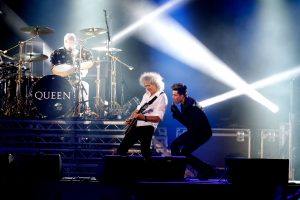
Queen + Adam Lambert, Independence Square, Kiev, Ukraine, June 30, 2012
Photo Credit: ©Andrew Kravchenko
Link Here
“I think it must have been the most terrifying moment for Adam.
He didn’t look like it was terrifying. He looked like he did this every day.”
–Brian May
“In the back of my head, I was like, ‘Oh God, I hope this is the right idea.’”
-Adam Lambert.
Queen The Greatest this week looks back at Brian, Roger and Adam Lambert’s very first full live show together which saw Adam face an audience over 350,000 and compete with an opening first half performed by Elton John.
By 2012, Brian and Roger had already performed with the sensational Adam Lambert on the 2009 American Idol season finale, and an eight-minute medley at the 2011 MTV European Music Awards at which Queen received their Global Icon Award. The reaction to both was phenomenal, and so their thoughts turned to the idea of staging a full Queen + Adam Lambert live show.
This is the story of their first gig – a massive Let’s Stop AIDS Together awareness concert performed on Kiev, Ukraine’s, Independence Square and TV broadcast live to millions – as recalled by Brian, Roger, Adam and Queen music director and keyboard player Spike Edney.
Adam Lambert: “All of us sat down and we had a drink, and there was a sense of camaraderie in that moment about ‘Look what we just did. This feels good. I like you. I like you. You like me.’ It was an instant sense of sort of comfort and ease that we all had with each other. We all sort of got a kick out of each other and felt like the right fit, it felt good.”
Brian May: “With Adam, by the time we got together, we kind of knew, yeah, because we’d seen enough of him and we thought, ‘Yeah, this is going to work.’ You know, Adam comes with a certain amount of pedigree because he’s done his solo stuff with a lot of success. So then we sat down together and said, ‘Well, what could we do?’ We could do a little bit of a tour. We could try something here, try something there. And it gradually took shape. And before we knew it, we were operating with Adam.”
Roger Taylor: “We had some shows about six shows, I think, in Europe, starting with a massive show in Kiev.”
Brian May: “I think it must have been the most terrifying moment for Adam. He didn’t look like it was terrifying. He looked like he did this every day.”
Adam Lambert: “I definitely was intimidated by the idea of singing somebody else’s songs, especially from such a beloved band.”
Adam Lambert: “In the back of my head, I was like, ‘Oh God, I hope this is the right idea.’ You know, I’m so excited to sing these songs, but I don’t know how it’s going to be received.”
Brian May: “It was a tall order, and I think we all knew it, and that gig was put in at the front of the tour to enormous numbers of people.”
Spike Edney: “I think it was more than 350,000 and it was live TV as well.”
Roger Taylor: “Well it was free, wasn’t it? Let’s say it was a million.”
Roger Taylor: “Elton John was on before us and I remember as Elton was rolling out hit, after hit, after hit. I remember thinking, ‘Oh, I hope we’re up to this.’”
Adam Lambert: “I had a lot of help. Spike, who was on keys, I kept looking at over and over again, like, ‘am I supposed to come in here? How long is the guitar solo? Is it my turn?’”
Spike Edney: “Because of his stage training, he was quite happy to take cues. He used to just check in with me and I’d give him a ‘yes,’ and ‘no’ if it was wrong, meaning wait.”
Adam Lambert: “Just a lot of me being like…”
Spike Edney: “He looks at me…I went ‘no, not that, don’t sing that bit.’”
Adam Lambert: “OK.”
Adam Lambert: “It was fun and it was thrilling, and it was what I love the most about being a vocalist, the adrenaline. It’s the thrill of something that could possibly go wrong. I like that. I like the danger in that.”
Roger Taylor: “I had no doubts he could do it. It was good, you know, the feeling was good.”
Brian May: “He’s out there, putting it out there, you know, and he sang great and interacted great, and it was a big success.”
Brian May: “An incredible thing for a new member of a group to step on stage and do that. I took my hat off to him at the time.”
Brian May: “And of course, the rest was easy after that.”
The ‘rest,’ as Brian refers to, amounts to a total of 218 shows performed together the world over to an audience in excess of 3.6 million.
The band’s twice COVID delayed 36-date UK and Europe Rhapsody Tour is due to resume late May 2022.
EMBED LINK
<iframe width=”560″ height=”315″ src=” https://www.youtube.com/embed/cXAA96WJ8nA” title=”YouTube video player” frameborder=”0″ allow=”accelerometer; autoplay; clipboard-write; encrypted-media; gyroscope; picture-in-picture” allowfullscreen></iframe>
Next week – “Brian On The Roof”
Website / YouTube / Instagram / Facebook / Twitter / TikTok
Queen The Greatest: a celebration of 50 of the greatest moments from the Queen story so far.
A 50-week YouTube series celebrating key moments in Queen’s history reminding us why Queen and their music continue to beloved across the world
Queen The Greatest Episode 45: “Queen 2005 – Queen + Paul Rodgers”
A look back at the collaboration between Queen and Paul Rodgers that included a run of sell out tours around the world – with Brian and Roger performing in some cities for the first time, as well as revisiting some old favorites.
WATCH HERE
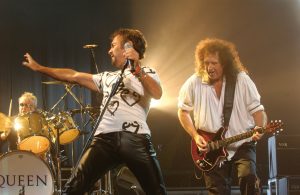
Download LINK
Queen + Paul Rodgers, Japan 2005
Photo Credit: Brad Gregory © Queen Touring Ltd.
“It happened almost by accident at an awards show. I played with Paul Rodgers,
who was a hero of ours, and I remember coming off stage and Paul’s lady said,
‘Oh, you guys seem to really have a great chemistry. All you need is a drummer.’
And I went, ‘well, I think I know a drummer!’”
–Brian May
A 2004 chance appearance together on stage at a 50th anniversary Fender Stratocaster show in London which brought together Brian May and one of Freddie and the band’s favorite vocalists would usher in a new touring and recording era for Brian and Roger.
Queen The Greatest this week heads back to 2005 to celebrate a collaboration that ‘rocked the cosmos’ – Queen + Paul Rodgers.
Taylor Hawkins: “I always held out hope, because Brian and Roger, you don’t want to keep that Lamborghini in the garage. You know, you got to drive that f*****g car every once in a while. So I was hoping that they would find someone.”
Brian May: “We’ve done odd gigs, you know, as Queen in a sense, you know, using guest artists. It was just, I remember saying not many months ago when somebody said, ‘can you do a Queen tour, can you call it Queen?’ And I said, ‘well, no, not really. Not barring a miracle. If there’s a miracle that we find the right person to sing, then yes.’”
Brian May: “Even though we were proud of what we’d done, we didn’t want to go out there and be Queen again without Freddie. And it happened almost by accident at an awards show. I played with Paul Rodgers, who was a hero of ours. and I remember coming off stage and Paul’s lady said, ‘Oh, you guys seem to really have a great chemistry. All you need is a drummer.’ And I went, ‘well, I think I know a drummer!’”
Queen announced a planned collaboration with Rodgers in October 2004, then appeared together when the band was inducted into the U.K. Hall of Fame on November 22 performing Queen’s “We Will Rock You” and “We Are the Champions” that night, along with “All Right Now.”
The group’s first public performance was at a concert in George, South Africa, in March 2005, Queen’s second concert in support of Nelson Mandela’s 46664 AIDS awareness campaign and shortly after they announced a world tour.
Roger Taylor: “Brian and I find that we still have the magic on stage. So it’s great to be doing this with a different singer, but the magic of Queen is absolutely still there.”
Their first tour comprised of 41 dates across Europe, the USA and Japan – seeing Queen return to famous venues such as London’s Hyde Park and the Hollywood Bowl in Los Angeles. This was followed a year later with another North American tour.
Brian May: “He enjoyed playing a lot of the Queen stuff. Not all of it, you know, not all of it suited him, but it was a good combination for a while. We ended up going all round the world a couple of times with Paul.”
Brian May: “I would still go to shows and think, ‘well, we used to do that, you know, we used to play in arenas or whatever.’ And suddenly out of the blue, we are in the same arena again and how incredible that we can still do that, people still want to come and fill those arenas, and we can still rock the hell out of them.”
Roger Taylor: “He was his own man and he belonged in the sort of blues soul field, which there is no, no-one better.”
Roger, Brian and Paul next took their partnership into the studio, which resulted in
The Cosmos Rocks album. This was to be followed by another massive tour that as well as spanning Europe and South America, would see Queen finally get to perform in Russia.
But to start things off, the band first went to Kiev’s Freedom Square to perform in front of a staggering crowd of 350,000 people.
At the end of that tour, Queen and Paul decided the time was right to go their separate ways, having achieved far more than imagined at the outset.
Brian May: “And again, I think Roger and I thought, ‘OK, that’s it.’ You know, we’ve done that, and we’ve done this, and there is nobody out there. We don’t want to employ someone to copy Freddie. Why would we do that? It just wouldn’t make sense.”
As it turned out, fate was about to play a hand in introducing Brian and Roger to another remarkable singer.
EMBED LINK
<iframe width=”560″ height=”315″ src=”https://www.youtube.com/embed/ZSVcySyNYNg” title=”YouTube video player” frameborder=”0″ allow=”accelerometer; autoplay; clipboard-write; encrypted-media; gyroscope; picture-in-picture” allowfullscreen></iframe>
Next week: “Queen 2012 – Queen + Adam Lambert – The First Gig”
Website / YouTube / Instagram / Facebook / Twitter / TikTok
Queen The Greatest: a celebration of 50 of the greatest moments from the Queen story so far.
A 50-week YouTube series celebrating key moments in Queen’s history reminding us why Queen and their music continue to beloved across the world
Queen The Greatest Episode 44: “Queen 2003 – Mandela’s Call”
Queen kick off the new millennium in style by taking London’s West End by storm with their musical – We Will Rock You,
which goes on to become a global phenomenon.
WATCH HERE
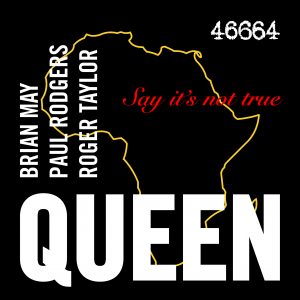
Download Artwork HERE
“Say It’s Not True” was written by Roger Taylor for Nelson Mandela’s 46664 AIDS foundation and performed live by Queen at the first 46664 concert on November 29, 2003.
Recorded as the first studio single by Queen + Paul Rodgers and released on World AIDS Day 1 December 2007 with all proceeds going to 46664.
https://www.youtube.com/watch?v=dUBfFh9QovI
Spearheaded by Brian May, Roger Taylor, and Dave Stewart, 46664 was a global initiative that brought together leading music icons to spread the message of Nelson Mandela:
“AIDS is no longer a disease, it is a human rights issue.”
“You know, we’re not politicians, we’re just musicians using what we do as a platform to just raise awareness effectively, and if you can get on TV in most of the countries in the world, that’s quite a good way of raising awareness.”
-Roger Taylor
This week’s Queen The Greatest episode marks another extraordinary moment in Queen history after Brian and Roger answered a call from Nelson Mandela, setting in motion a series of extraordinary gatherings of the world’s biggest music artists to honor the life and legacy of Nelson Mandela while promoting awareness of the HIV/AIDS pandemic, established under the identity of 46664, Mandela’s prison number under which he was held at Cape Town’s Robben Island until 1982.
In 2003, a call came through from Nelson Mandela, asking for Queen’s help with a concert for AIDS awareness in Cape Town. But, he wasn’t just asking for them to perform….
Brian May: “We answered the call to Madiba. Nelson Mandela is suddenly on the phone saying ‘can you rescue my concert,’ and we produced it for him, and we went out there and we really didn’t imagine that the by-product would be that we would be re-engaging with an audience.”
Brian May: “Something to tell your grandchildren, I think. To be in the presence of such greatness, and to be a part of this whole venture, I just feel incredibly privileged.”
The launch of the campaign would be the first 46664 The Concert at Green Point Stadium in Cape Town on November 29th, 2003. The concert took place in front of an audience of 40,000 and broadcast around the world via TV, webcast and radio.
Designed to raise awareness of the global HIV pandemic, it was an emotional night, packed with some truly memorable performances as music icons and public figures from around the world including Anastacia, Beyonce, Bob Geldof, Bono and the Edge, the Eurythmics, Queen’s Brian May and Roger Taylor, and Oprah Winfrey, shared the stage with many of South Africa’s best known artists, among them Johnny Clegg, Angelique Kidjo, and the Soweto Gospel Choir.
In addition to producing the concert, and appearing as part of the incredible line-up, Brian and Roger both composed new songs, especially for the event. At the concert Queen performed three news songs inspired by Mandela’s appeal; “Say It’s Not True,” “The Call” and “Invincible Hope,” the last track featuring a sample of one of Mandela’s famous speeches.
Coverage of the concert reached more than 2 billion people in 166 countries, making it the most widely distributed media event in history.
Roger Taylor: “You know, we’re not politicians, we’re just musicians using what we do as a platform to just raise awareness effectively, and if you can get on TV in most of the countries in the world, that’s quite a good way of raising awareness, I think. So this is really a way of pressurising politicians and pharmaceutical companies to make the drugs cheaply, or freely available.”
Brian May: “We’ll be looking for a sustained commitment and I think we’re making it ourselves. I mean we certainly feel that we would like in some way to continue this wonderful club that has come together, the 46664 banner if you like, the trademark. And we’d like to continue on, and keep hammering away and make sure this isn’t just a little puff in the wind.”
In the coming years Queen would be involved in further 46664 concerts in Norway, again in South Africa, and with a final UK concert in London’s Hyde Park on June 27, 2008, attended by 46,664 people that both celebrated Nelson Mandela’s ninetieth birthday and formed part of the 46664 concert series – and further keeping Freddie’s legacy alive by answering the call in the on-going Global fight against the AIDS pandemic.
Queen continue to be inspired by Nelson Mandela and continue the fight against HIV/AIDS through the Mercury Phoenix Trust, the charity set up following the death of Freddie Mercury. http://www.mercuryphoenixtrust.com/
EMBED LINK:
<iframe width=”560″ height=”315″ src=”https://www.youtube.com/embed/9f_nowDwt_8” title=”YouTube video player” frameborder=”0″ allow=”accelerometer; autoplay; clipboard-write; encrypted-media; gyroscope; picture-in-picture” allowfullscreen></iframe>
Next week: “Queen 2005 – Queen + Paul Rodgers”
Website / YouTube / Instagram / Facebook / Twitter / TikTok
Queen The Greatest: a celebration of 50 of the greatest moments from the Queen story so far.
A 50-week YouTube series celebrating key moments in Queen’s history reminding us why Queen and their music continue to beloved across the world
Queen The Greatest Episode 43: “2002 Queen – We Will Rock You : The Rock Theatrical”
Queen kick off the new millennium in style by taking London’s West End by storm with their musical – We Will Rock You,
which goes on to become a global phenomenon.
WATCH HERE
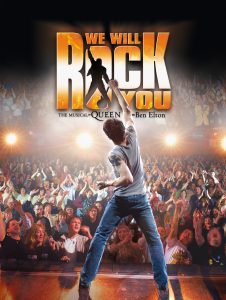
Download Artwork HERE
Over four and a half thousand standing ovations!
“6 million people have been to this building to see the show over the last
ten years, but we’ve always been doing new stuff for the show,
just keeping it alive and moving, evolving.” – Brian May.
This week’s Queen The Greatest returns to remember when Queen rocked London’s West End with the launch of – We Will Rock You.
In May 2002, the Dominion Theatre in London opened its doors for the first time on a brand new rock theatrical experience set entirely to the music of Queen. We Will Rock You had been lovingly brought to life under the watchful eyes of Brian May and Roger Taylor, but was made possible by the unlikely pairing of Queen with a Hollywood legend after a chance meeting at the Venice Film Festival.
Roger Taylor: “We had a series of scripts given to us, and Robert De Niro, strangely, took an interest, which came completely from leftfield, and said he was starting the theatrical arm of Tribeca, his company, and he’d like us – this – our musical, to be his first thing. So we ended up co-producing it.”
Another key partnership was involving esteemed comedy writer, Ben Elton, to create the story that the hit songs would be woven into.
Roger Taylor: “And it’s ended up being hugely funny as well as, you know making some points which Ben normally manages to weave into anything he does. And so I think it’s a very good mixture of having something to say, having a sort of slightly silly story, but very funny and hopefully uplifting with tons and tons of hits.”
Brian May: “It is funny, and it’s also… it has a kind of serious side to it, it has something to say and I think it will… You better bring your handkerchief as well. I think there are some, some moments where you will feel something, something rather sad and feel something rather personal.”
Brian May: “Very often we’ve made very small changes to the lyrics and sometimes none at all. And somehow they just seem to fit the story incredibly well. Now this isn’t an accident. You know, we’ve moulded the story around the songs, and we’ve moulded the songs around the story.”
Brian May: “It’s not just like, let’s sling some songs into a story at all. It’s very much, I guess, we always took our work very seriously. So this is a genuine attempt, if you like, to make something which will stand for the rest of time as a musical, and perhaps some people in the future will forget that these songs ever had a life elsewhere. I don’t know.”
Predictably, some of the press reaction at the beginning was unduly harsh, but that proved irrelevant as the theatre going public flooded in, giving the show nightly standing ovations, and eventually making it the longest running show ever to play at the Dominion Theatre – an extraordinary achievement that was marked in 2012 when the stars turned out for a gala performance to celebrate the show’s 10th anniversary.
Sam Fox: “Oh, it’s amazing it’s been going ten years, shows how popular still rock and roll is.”
Chris Tarrant: “I was here at the first night, absolutely love it.”
Emma Thompson: “I’ve seen it about 17 times.”
Arlene Phillips: “Bring on another ten years.”
Aldo Zilli: “I think it’s going to go on forever. Ten years is nothing.
Tim Minchin: “It’s Queen songs; it’ll go forever won’t it?”
Ben Elton: “We’ve had a laugh for ten years and so have the audience so we’re thrilled, absolutely thrilled.”
Brian May: “6 million people have been to this building to see the show over the last ten years, but we’ve always been doing new stuff for the show, just keeping it alive and moving, evolving.”
From its opening night at the Dominion on May 14, 2002, We Will Rock You quickly became the overwhelming people’s choice of musical in the UK and overseas. In its second year at the Dominion it won top honors in five categories in the Theatregoers Choice awards including Best New Musical. In 2011, nine years after the curtain first went up, the show won the prestigious Olivier Awards Audience Award, the only category voted for entirely by the public. The show went on to win a number of international awards for productions around the globe.
By the time the show closed at London’s Dominion theatre on May 31, 2014, We Will Rock You had become the longest running show ever at the Dominion by a margin of nine years and performed an astonishing 4600 times. Taking its rightful place in West End history, the show sits proudly in the Top 10 longest running musicals of all time notching up over four and a half thousand standing ovations!
Internationally too, the show became a global phenomenon, playing in more than 20 countries and entertaining well over 15 million people.
And today, twenty years after that opening night, We Will Rock You is still going strong around the world, and with a new tour about to start in the UK, clearly Queen will be rocking the theatrical world for many more nights to come.
EMBED LINK: Embed link here:
<iframe width=”560″ height=”315″ src=”https://www.youtube.com/embed/aREKnumREqg” title=”YouTube video player” frameborder=”0″ allow=”accelerometer; autoplay; clipboard-write; encrypted-media; gyroscope; picture-in-picture” allowfullscreen></iframe>
Next week: “Brian on the Roof”
Queen The Greatest: a celebration of 50 of the greatest moments from the Queen story so far.
A 50-week YouTube series celebrating key moments in Queen’s history reminding us why Queen and their music continue to beloved across the world
Queen The Greatest Episode 42: “1996 Queen + Béjart: Ballet For The Masses”
Revisiting the extraordinary collaboration between Queen, Versace and the revolutionary choreographer, Maurice Béjart (with some Mozart added for good measure!) – and featuring what would be John Deacon’s final live performance.
WATCH HERE
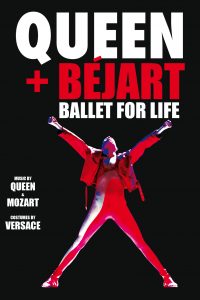
Poster Download LINK
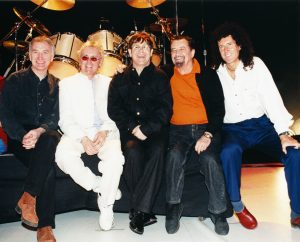
Photo: John Deacon, Roger Taylor, Elton John, Maurice Béjart, Brian May
Théâtre de Challot, Paris, January 1997
Photo: Richard Young
LINK
“We thought ‘oh dear,’ because it’s a strange thing for us to do, firstly, we haven’t played for God knows how long. We don’t have a singer. It’s one song and you have to get a whole production for one song, one performance. And then this message came from
Elton saying, ‘Let’s play.’” – Brian May
“And that was John (Deacon)’s last ever performance, and I could tell he wasn’t happy because he was very, very nervous and had been severely traumatized by losing Freddie.” – Roger Taylor
Queen The Greatest this week celebrates a truly groundbreaking collaboration: the creation of Queen and the late French ballet legend Maurice Béjart’s “Ballet For Life.”
Inspired by Queen’s Made in Heaven album, and driven by the desire to shine a light on the AIDS pandemic and the tragedy of the people who died too young because of it, the internationally renowned choreographer, Maurice Béjart, approached Queen with an extraordinary vision for a new ballet which would draw its inspiration from the lives of Freddie Mercury and Béjart’s former principal dance Jorge Donn, both lost to AIDS.
Roger Taylor: “I met Maurice Béjart at the unveiling of the (Montreux) statue to Freddie. He was an entrancing man and his steely blue eyes lit up and he would carry you along with his enthusiasm.
“We were delighted that somebody wanted to do something so creative with the music. So you know, why not?”
Brian May: “How could we possibly say ‘no’ to a giant of another discipline in our…, you know, coming to us and asking us if he can use our music? What a wonderful thing to happen. I mean, yeah.”
With Queen’s extensive and eclectic catalogue of music to choose from, Béjart began to create a ballet that interpreted some of the band’s most iconic songs in completely new ways.
Béjart also cleverly added some music from Mozart into the mix, and as the ballet took shape, he then turned to Gianni Versace to design the costumes.
Roger Taylor: “We always had a rule of wearing either black or white on stage, and Gianni Versace did the wonderful costumes, and he stuck to that sort of rule. And they’re very immaculate, and I think they look terrific.”
Roger Taylor: “Maurice really took on board some of the aspects of our live performance, even including coloring, colors and lighting. It looks very alive. It looks very modern.”
The January 1997 premiere at the Théâtre de Challot in Paris included a performance by Queen joined by Elton John that would prove to be another milestone in the band’s history.
Brian May: “The first proper public show was due to be in Paris, and we talked about being there and we said we’d like to be there.”
Brian May: “We thought ‘oh dear,’ because it’s a strange thing for us to do, firstly, we haven’t played for God knows how long. We don’t have a singer. It’s one song and you have to get a whole production for one song, one performance. And then this message came from Elton saying, ‘Let’s play.’”
Roger Taylor: “And that was John (Deacon)’s last ever performance, and I could tell he wasn’t happy because he was sort of chain smoking and very, very nervous and had been severely traumatized by losing Freddie.”
Brian May: “Deacy, our dear friend John, I think he didn’t arrive at the same places as we did. And John is there, but John is really so desperately uncomfortable with the whole thing. You can see him, kind of his whole body is sort of reacting against it.
“And at the end of it, he says, I can never do this again. I can’t do this. And it was true, that’s the last time he ever played with us, John, in public.”
Maurice Béjart: “I’m not the judge of my work. I love my works. Of course, I love very much the last one. I love very much the one that people love because it’s natural. But an artist will never turn to watch his past.”
“The Ballet For Life” was a key part of the Queen story, and 25 years later is still very much alive and continuing to tour, entertaining and enthralling audiences around the world.
Roger Taylor: “I was very pleased to have the music allied with Mozart, Versace and Maurice Béjart’s wonderful ballet. It took us to another sphere.”
Brian May: “It did something very big for us. It changed the way we felt about the continuing life of Queen music in the world, and I’m very happy, very proud of that moment in time when Queen Music and Mozart and Maurice Béjart came together in one place.”
Queen + Béjart: “Ballet For Life” performance film directed by David Mallet. Documentary film directed by Lynne Wake.
Embed link here:
<iframe width=”560″ height=”315″ src=”https://www.youtube.com/embed/4JPiexo_WPo” title=”YouTube video player” frameborder=”0″ allow=”accelerometer; autoplay; clipboard-write; encrypted-media; gyroscope; picture-in-picture” allowfullscreen></iframe>
Next week: “2002 We Will Rock You – The Rock Theatrical”
Queen The Greatest: a celebration of 50 of the greatest moments from the Queen story so far.
A 50-week YouTube series celebrating key moments in Queen’s history reminding us why Queen and their music continue to beloved across the world
Queen The Greatest Episode 41: “1995 Made In Heaven”
Determined to give their best friend the ‘biggest send off in history’, Roger, Brian, John and manager Jim Beach prepare a celebration concert that would become one of the most memorable nights in music history.
WATCH HERE
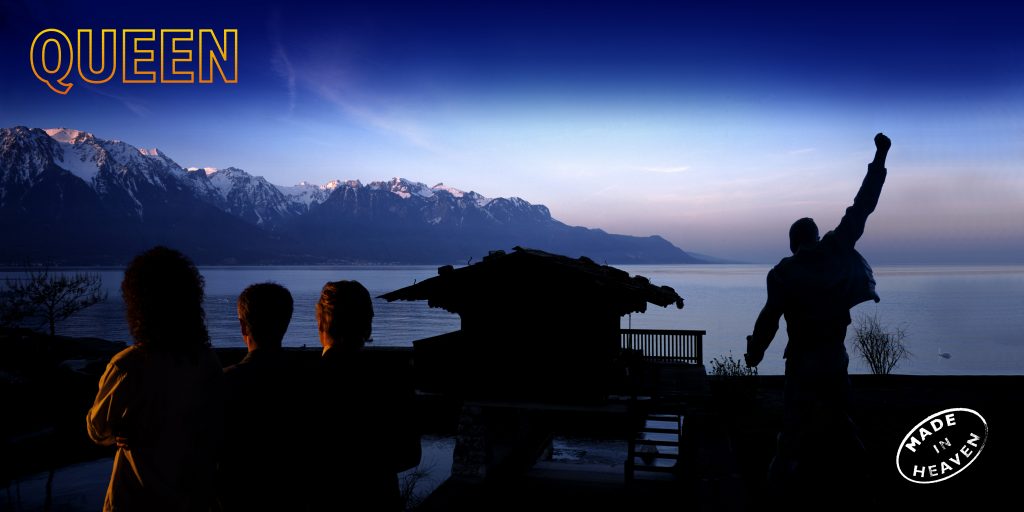
Photo LINK
Photo Credit and design: Richard Gray © Queen Productions Ltd.
”I think I was reluctant to get back into opening those boxes and dealing with
Freddie’s voice there. And it was tough to begin with.
But now, having been through that, I can listen to the album and it’s just joy.
I feel like it was the right completion, and it’s the right album to finish up on.”
-Brian May
“I think Brian and I certainly felt that we knew what Freddie would have been thinking. And, you know, he felt he was almost in the corner of the room.”
–Roger Taylor
The first episode of 2022 of Queen The Greatest heads back to November 1995 to look at Queen’s fastest selling and most successful studio album to date – Made In Heaven.
While the Tribute Concert had been the perfect occasion for fans and the band to come together and celebrate the life, the works, and the dreams of one Freddie Mercury, for Brian, Roger and John there still remained some unfinished business.
In 1993, Brian May, Roger Taylor and John Deacon returned to Mountain Studios in Montreux, Switzerland, to work on finishing the tracks they had begun with Freddie Mercury during the early part of 1991.
The resulting album, Made In Heaven, was the final chapter in the band’s legacy with Freddie, and featured polished versions of songs they had never managed to finish before as well as tracks for which Freddie had laid down vocals prior to his passing, such as “A Winter’s Tale.” Two tracks were revisited versions of songs Freddie originally recorded for his Mr. Bad Guy solo album. Another, “Heaven For Everyone,” started life as a song by Roger’s solo project The Cross, on which Freddie had sung a guest vocal – and Queen’s reworked version became the first single from the Made In Heaven project.
Here Brian May talks about the process of healing that delayed the band’s return to the studio – “I think I was reluctant to get back into opening those boxes and dealing with Freddie’s voice there. And it was tough to begin with” – and acknowledges it was Roger who provided the impetus for the process to begin and mentions the support they received from, among others, songwriter Carole King.
Brian May: “Of course lurking in the wings was all the material we’d done with Freddie, which was unfinished, and what were we going to do with this? Would we manage to make an album with it?”
Roger Taylor: “Things like ‘A Winter’s Tale’ really came out of that, that sort of desperately ill stage.”
Roger Taylor: “They were made very much out of an awareness that Fred wasn’t going to be around very long.”
Brian May: “I think I kind of dragged my heels, I think I went through a very extended grieving process really, because I kind of didn’t want to talk about Queen. I went out on my tour, solo tour, and of course, all that people wanted to talk about was Queen and Freddie’s death and stuff, and I couldn’t deal with it. I just said, ‘Look, let’s just talk about what’s happening now.’”
Brian May: “So I had a bit of sort of denial stuff going on and I think I was reluctant to get back into opening those boxes and dealing with Freddie’s voice there. And it was tough to begin with.”
Brian May: “Roger made the first inroads and he took some of the tapes down to his studio and started working on them. And of course, that’s the trigger I needed because I hear what he’s done, and I go ‘no, no, no, don’t do it like that. You’ve got to do it like this,’ you know? So my juices were working and I just dived in before I had time to think, and I took over some particular tracks. It was a monumental task.”
Roger Taylor: “It was very weird working with Freddie’s voice coming out of the speakers. But again, it was a very interesting process.”
Roger Taylor: “Because we knew that the situation was closing in on us and… so we sort of made the most of every moment and then really enjoyed it.”
Roger Taylor: “I think Brian and I certainly felt that we knew what Freddie would have been thinking. And, you know, we felt he was almost in the corner of the room and sort of knowing each other so well for so long, we sort of thought he’d like that bit but he probably wouldn’t like that bit. And so we sort of got there and I was very pleased with the result.”
Brian May: “I’m very fond of ‘Mother Love,’ and it has a little piece of ‘I’m Going Back’ at the end, which is one of the first things that Freddie ever sang in the studio. In fact, probably the first thing. A Carole King song.
“And I wrote to Carol King to ask her permission to use it, and she was delightful, she was so supportive, and she said she was thrilled that we would consider it important to put on there.”
Brian May: “The whole album is a fantasy, really, because it sounds like the four of us are there all together having fun and making the album, but of course, for most of the time when you’re listening, that’s not the case. You know, it’s built to sound that way. And a lot of love went into that.”
Brian May: “There’s tracks like ‘I Was Born to Love You,’ which of course was never a Queen track, that was a solo track which Freddie did very hurriedly, and he never kind of bothered about the backing tracks. So we stripped everything away and lovingly, cherishingly re-edited all his vocal, put it all together, and I spent months and months piecing together our bits to make it sound like we were in the studio together.”
On it’s release in November 1995, Made In Heaven raced to the top of the charts and achieved multiple Platinum status around the world – going on to sell in excess of 20 million copies. Five tracks were subsequently released as singles, all of which were top 20 hits in the UK.
Brian May: “I think it’s one of our best albums, strangely, so good experiences all connected with that album, and I love the album I can put it on any time. And, obviously there were moments working on it when you’re just listening to Freddie’s voice 24 hours a day and that can be hard, you know, you suddenly think, ‘Oh God, he’s not here,’ you know, ‘why am I doing this?’ But now, having been through that, I can listen to the album and it’s just joy. I feel like it was the right completion, and it’s the right album to finish up on.”
To promote the album the band collaborated with the British Film Institute allowing emerging young directors and the BFI to decide how to represent their music. The result was eight very different short films which used songs from the album as their starting point and soundtrack, and could be shown the world over to promote the album.
Three of the films were selected to show on opening night of the 1996 Venice Film Festival alongside Robert de Niro’s crime drama Sleepers. Meeting de Niro after the screening he asked the band: “Have you ever thought of creating a West End musical based on your music?”
That chance meeting opened up the doors to another extraordinary successful chapter in the Queen story, to be visited in a future episode of Queen The Greatest.
Embed link here:
<iframe width=”560″ height=”315″ src=” https://www.youtube.com/embed/_urF6sJcmGk” title=”YouTube video player” frameborder=”0″ allow=”accelerometer; autoplay; clipboard-write; encrypted-media; gyroscope; picture-in-picture” allowfullscreen></iframe>
Next week: “Queen + Bejart : Ballet for the masses”
Queen The Greatest: a celebration of 50 of the greatest moments from the Queen story so far.
A 50-week YouTube series celebrating key moments in Queen’s history reminding us why Queen and their music continue to beloved across the world
Queen The Greatest Episode 40: “1992 – The Freddie Mercury Tribute Concert”
Determined to give their best friend the ‘biggest send off in history’, Roger, Brian, John and manager Jim Beach prepare a celebration concert that would become one of the most memorable nights in music history.
WATCH HERE
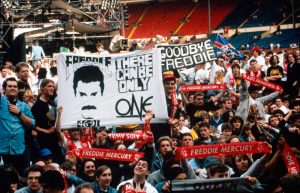
Photo LINK
Photo Credit: Neal Preston
“Roger got the ball rolling. Roger got up one morning and said, ‘Look, we’re doing this right’ and made a few phone calls.”
Brian May
“And Brian said, ‘Well, if you can get that lot, I’ll go, I’ll come.’”
Roger Taylor
“I was the first person to sing with Queen after Fred died. Doing it on stage in front of 80,000 people and a billion people on TV. Holy s**t.”
Joe Elliott
Queen The Greatest – Episodes 1-39 – WATCH HERE
Remembering an event that wasn’t just one of the greatest and most significant in the history of Queen, but also in the entire history of rock music, this week’s episode of Queen The Greatest revisits The Freddie Mercury Tribute Concert of April 20, 1992.
The episode sees Roger and Brian reflect on the making of that historic day, joined by Joe Elliott and Taylor Hawkins recollecting appearing on stage in front of 80,000 people and live on radio and TV to a billion people in 76 countries around the world.
The overwhelming outpouring of love that followed the tragic passing of Freddie convinced Roger, Brian, John and manager Jim Beach, that there needed to be some kind of event to celebrate the life and achievements of their best friend.
The concert idea was conceived on the night Freddie lost his fight for life. Brian, Roger and John gathered at Roger’s house and decided they would organise some kind of tribute to Freddie, the exact form of which would take shape over the coming months, with the concert formally announced on February 12 at the BRIT Awards ceremony where Roger and Brian collected an award on Queen’s behalf for their Outstanding Contribution to Music.
Roger Taylor: “We drew up a list of people that we’d like to be on the show.”
Brian May: “Roger got the ball rolling. Roger got up one morning and said, ‘Look, we’re doing this right’ and made a few phone calls.”
Roger Taylor: “And Brian said, ‘Well, if you can get that lot, I’ll go, I’ll come.’”
Every artist they approached accepted their invitation to perform alongside them at London’s Wembley Stadium, a veritable who’s who of rock and pop paying tribute to Freddie.
Brian May: “So suddenly, we’re performing with David Bowie and Robert Plant. You know, you look around and who is this, you know, Tony Iommi’s beside me, who’s a lifelong friend, you know, the most amazing artists of our lives.”
Joe Elliott: “I was the first person to sing with Queen after Fred died. Doing it on stage in front of 80,000 people and a billion people on TV. Holy s**t.”
Joe Elliott: “You’d never think it would be possible to get one person to stand in Fred’s shoes because there’s no way I could have done anything other than, say, the rock stuff. With the Freddie Mercury Tribute Show, you needed 20 characters to even come close to pulling on his coattails.”
Brian May: “The task of finding one person who could do everything that Freddie could do, would have been pretty much impossible. The whole range of Queen songs is considerable. It’s a very, very colourful catalogue with all kinds of different sorts of vocal approaches needed.”
Roger Taylor: “It did bring home the fact that Freddie was so incredibly talented on so many levels and how hard it was for anybody to cover as much ground as Freddie covered.”
Taylor Hawkins: “I don’t think anyone thought they were going to show up and be the next Freddie Mercury. It ain’t easy, man.”
The show was packed with countless, extraordinary moments that live long in the memory – but just as memorable is the message of AIDS awareness that from that moment became inextricably linked to Freddie’s name.
Roger Taylor: “Obviously, losing Freddie has brought it home to us. You know, in a big way. And many other people that I know, I mean, as time goes on, it becomes more, more of a threat and the threat is growing, I think. I don’t think the awareness is growing. So this seems like, especially for us, a good time to do this.”
As the emotional, yet triumphant night drew to a close, everybody watching hoped this would not be the last they would see and hear of Queen.
Brian May: “It’s done. And Joe Elliott was next to me as we walked off and he just grabbed my arm and he said, ‘Brian, look at that.’”
Joe Elliott: “I said, ‘You need to stand here and look at this because you will never, ever see this again. If this is the end, what a way to go.’”
Brian May: “And for the first time, I looked out and I thought, ‘Ah, how amazing’ this amount of love got poured out to our friend.”
Roger Taylor: “Goodnight Freddie. We love you.”
Brian May: “In a way, the concert is quite important for us because it’s our way of saying goodbye to Freddie as well. And I think we need to do that before our minds can really move on. It’s something which we had in our minds, right from the point where he did die. And it’s very hard to think on after that, isn’t it?”
Brian May: “That’s the only thing I can focus on at this moment is that day. When it’s over, there’s a new world out there in some way.”
Thanks to the Mercury Phoenix Trust, the fight against AIDS is part of Freddie’s everlasting legacy, and as the series of Queen The Greatest continues, we shall see how this wasn’t the end for Queen or their music, but in fact the beginning of a thrilling new chapter.
Liza Minnelli: “Thanks Freddie. We just wanted to let you know we were thinking about you. Stay safe!”
# # #
Embed link here:
<iframe width=”560″ height=”315″ src=”https://www.youtube.com/embed/kwzq4_u2XLA” title=”YouTube video player” frameborder=”0″ allow=”accelerometer; autoplay; clipboard-write; encrypted-media; gyroscope; picture-in-picture” allowfullscreen></iframe>
About The Mercury Phoenix Trust:
Following the Tribute Concert in 1992, Brian May, Roger Taylor and Jim Beach set up The Mercury Phoenix Trust (MPT) in memory of Freddie Mercury following his death from HIV/AIDS in 1991. The Trust is a core part of Queen and Freddie’s legacy, with the passion and power behind the music forming the bedrock of the MPT.
The MPT has reached millions in the fight against HIV/AIDS worldwide to date providing over £17 million ($22.5 million U.S.) to over 1.5K projects in 57 countries. The MPT predominantly funds smaller organizations it assesses and vets as they effectively work at grassroots level, where governments, larger NGOs and markets don’t often reach.
To find out more and donate: http://www.mercuryphoenixtrust.com
Next week: “1996 – Made In Heaven”
Queen The Greatest: a celebration of 50 of the greatest moments from the Queen story so far.
A 50-week YouTube series celebrating key moments in Queen’s history reminding us why Queen and their music continue to beloved across the world
Queen The Greatest Episode 39: “The Drum Sound”
One of the cornerstones of the Queen sound, Brian May and his legendary Red Special guitar are an integral part of any Queen song or performance. Here Brian reveals how he approaches his unique live solos.
WATCH HERE
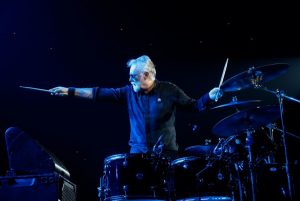
Photo LINK
Photo Credit: Yoshiko Horita
“If I did a solo and I would look down and notice people going out for a hot dog,
I’d never want to do it again because you knew that you were boring people.”
-Roger Taylor
Queen The Greatest – Episodes 1-38 – WATCH HERE
Continuing its current look at the contributions made by its component members, this week’s Queen The Greatest celebrates another vital element of any Queen song or performance: The Drum Sound.
The initial foundation of the unique Queen sound can be traced back to the days of Smile, where Roger and Brian first played together.
Brian May: “I remember him bringing his kit in very carefully, and he set it all up on its stands. And then he started to do something very curious. He was like making little tapping noises and turning knobs, and I went ‘what are you doing?’
“He said, ‘I’m tuning the drums,’ and I went, ‘Oh, really? You tune drums?’ because the drummers that I’d worked with up to that time just basically put the drums down and hit them. But Roger was going on and tuning every little part of each skin so that it would resonate in the right way. So, I was kind of impressed.”
Roger’s distinctive drumming has always been an integral part of the Queen recording process, whether it be providing a subtle yet solid rhythm, or taking center stage in songs such as his swaggering rock anthem “I’m In Love With My Car.”
And subsequently in the live shows, crowds would be whipped into a frenzy by his extraordinary pace, energy and precision.
As is the hallmark of Queen, the drumming contribution evolved over the years, often in unique and surprising ways…
But one thing has remained constant – that is Roger’s belief that any drum solo should be used sparingly and never outstay its welcome.
Roger Taylor: “Drums solos were a cliché. In the early seventies they were a cliché, so, and it was just something that one did, you know? And I never really honestly enjoyed actual solos, I always really preferred playing as part of the ensemble, part of the band and part of the song, really.
“And whereas it’s all very nice, they’re just showing off, really, aren’t they, you know, and especially when you’re playing to a lot of people in big concerts, you know, if I did a solo and I would suddenly look down and notice people going out for a hot dog, I’d never want to do it again because you knew that you were boring people.”
But there’s been no danger of that, whether it be on the Queen + Paul Rodgers tour with his rendition of “Let There Be Drums.”
Or now, in a much-anticipated element of the Queen + Adam Lambert shows – the drum battle, with Roger here seen taking on his drummer son, Rufus Taylor.
Embed link here:
<iframe width=”560″ height=”315″ src=”https://www.youtube.com/embed/5a9ZQGeuFck” title=”YouTube video player” frameborder=”0″ allow=”accelerometer; autoplay; clipboard-write; encrypted-media; gyroscope; picture-in-picture” allowfullscreen></iframe>
Next week: “Queen 1992 – The Freddie Mercury Tribute Concert”
YouTube / Instagram / Facebook / Twitter / TikTok
Queen The Greatest: a celebration of 50 of the greatest moments from the Queen story so far.
A 50-week YouTube series celebrating key moments in Queen’s history reminding us why Queen and their music continue to beloved across the world
Queen The Greatest Episode 38: “The Guitar Solo”
One of the cornerstones of the Queen sound, Brian May and his legendary Red Special guitar are an integral part of any Queen song or performance. Here Brian reveals how he approaches his unique live solos.
WATCH HERE
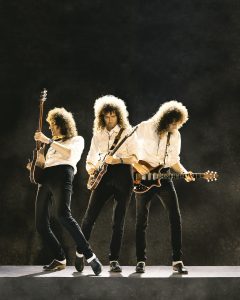
Photo Download Link
Credit: Photography by Richard Gray. © Queen Productions Ltd.
Queen The Greatest – Episodes 1-37 – Watch HERE
This week’s Queen The Greatest celebrates one of the corner stones of any Queen song or performance, “The Guitar Solo.”
Among the many things that make Queen so distinctive is the extraordinary sound of Brian May’s homemade guitar. Through the band’s eclectic range of styles, the now legendary Red Special has demonstrated a vast array of voices and acts of melodic genius as highlighted in songs as diverse as:
“Tie Your Mother Down”
“Killer Queen”
“These Are The Days Of Our Lives”
It was a defining feature of Queen’s music that the band was rightly proud of, and so unsurprisingly it quickly became an established element of the band’s live performances around the world and on most special occasions, including Brian’s legendary performance on the roof of Buckingham Palace, Live Aid, the closing ceremony of the 2012 Olympics…and beyond.
Brian’s remarkable use of delay created a special part of every Queen show, due in part, as he explains here, to how it evolved over the touring years.
Brian May: “The guitar solo, it’s half and half. I’d done it so many times, by that time, that there are certain things which I know are going to be good things to try, but basically it’s improvised. But there are certain things which will always be in there because they work.
“I had to be very careful because you can fall into a trap. If something works great and you get a good response, the tendency is to keep doing it, but it doesn’t work that way. You’ve got to, sort of, take it to its natural peak and then let it go and try something else because things get old. You know, you have to keep yourself fresh and the audience fresh.
“Sometimes I would get fed up with it. Sometimes I really would curtail it and not want to do the whole thing, and then sometimes the mood would be right and you go for it and it would just be great.”
When Queen resumed touring in the 2000’s, first with Paul Rodgers, and now with Adam Lambert, the Guitar Solo had evolved once more, and to this very day continues to produce a magical moment that’s unique to each performance.
Brian May’s soaring, breathtakingly melodic solo on Queen’s “Bohemian Rhapsody” was recently named by Total Guitar readers as the greatest guitar solo of all time. Asked when receiving his award the one he holds in the highest regard? His solo on Queen’s 1974 hit, “Killer Queen.” “It has always been a favorite of mine,” May told the magazine.
“It was something a bit more complex, an adventure in putting guitar harmonies into the solo.”
For those interested in learning more about Brian’s historic relationship with his hand-built guitar that rocked Queen and the world, he has recently issued an updated version of his Red Special book co-written with Simon Bradley. Additions include 2 brand new chapters and an updated Galley chapter.
Embed link here:
<iframe width=”560″ height=”315″ src=”https://www.youtube.com/embed/vrz7nlkSt4k” title=”YouTube video player” frameborder=”0″ allow=”accelerometer; autoplay; clipboard-write; encrypted-media; gyroscope; picture-in-picture” allowfullscreen></iframe>
Next week : “The Drum Sound”
Queen The Greatest: a celebration of 50 of the greatest moments from the Queen story so far.
A 50-week YouTube series celebrating key moments in Queen’s history reminding us why Queen and their music continue to beloved across the world
Queen The Greatest Episode 37: “1991 – Innuendo”
A look back at how Queen roared into the 1990’s and celebrated their twentieth anniversary with the release of the Innuendo single and album, both of which entered the UK charts at number 1.
WATCH HERE
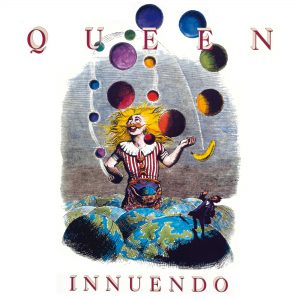
Download LINK
Credit: Design Richard Gray. © Queen Productions Ltd.
“Strangely, a very happy album to make.” –Roger Taylor
“Freddie always used to say, ‘Oh Brian, you’re f**king making me tear my throat to bits again.’ So with “The Show Must Go On” I remember apologizing ‘I don’t know if it’s possible to do it full voice., but obviously that would be great.’ And he went ‘Oh for God’s sake, roll the tape.’ A couple of vodkas, and he went for that line, which is outstanding for him to reach those notes.” –Brian May
Queen The Greatest – Episodes 1-36 – Watch HERE
This week’s Queen The Greatest marks Queen roaring into the 1990s with their 14th and penultimate studio album, the smash hit Innuendo, and looks inside the Montreux studio sessions of March 1989 – November 1990 carried out under the shadow of Freddie’s increasing frailty, but remembered by Roger Taylor as “strangely, a very happy album to make.”
Dave Richards, Producer: “With Innuendo, somebody suggested that they should play live, and they thought that was a good idea. So, we set them up in the Casino Hall (Montreux) and the studio itself was linked with 54 mic lines going down and we could record groups in there.
“They actually created a song live, by improvising until it became a song. And that’s how it started.”
Roger Taylor: “We were working abroad together in Mountain Studios. I think Freddie had then decided he actually loved Switzerland, and he didn’t want the studio to be under the lake, which is where he wanted before.”
Roger Taylor: “There’s some very good stuff on Innuendo, and it was quite live as well, and I think a bigger studio is good for us.”
Brian May: “There was a feeling of sort of re-exploring our youth almost buried in there somewhere. And it was fun.”
Brian May: “We were all working really flat out on everybody’s ideas and not being kind of possessive about things, so there’s quite a liberation there.”
John Deacon: “I think we’re all throwing in different ideas. There’s a lot more teamwork, but people still get very precious about the songs that they feel they started off with.”
Dave Richards: “Freddie was singing down there live as well with them, and there was absolutely no impression from me that he could have been sick. He was full of beans and singing away.”
At the beginning of 1991, the Innuendo album and single were released and both entered the UK charts at number one. It was also Queen’s first album to go gold in the US on release since The Works in 1984.
Brian May: “The new album is great. I think it’s the best one for quite a long time. Very often you put out an album you think, but I wish we’d done this, you know. This one I feel quite happy about and I can listen to it without any problem. I like it a lot.”
Brian May: “Actually, we had some fantastic times, and I think we got over our stupid, you know, going out the whole time business, you know?”
Brian May: “And we were a very close knit group like a family, and we would work in the studio until, usually until Freddie got very tired.”
Brian May: “I did a complete demo for “The Show Must Go On,” including that very high part, you know, ‘On with the show.’ And I said to Freddie, because Freddie always used to say, ‘Oh Brian, you’re f**king making me tear my throat to bits again.’ So, I remember apologizing in as much as I said, ‘Look, I’ve done it in falsetto. I don’t know if it’s possible to do it full voice, you know, but obviously that would be great.’”
Brian May: “And he went ‘Oh for God’s sake,’ you know, he said, ‘roll the tape,’ a couple of vodkas, and he went for that line, which is outstanding, you know, for him to reach those notes. He’s reaching heights he’s never done before. He’s just finding the energy from somewhere. And the voice on “The Show Must Go On” is incredible. I never heard anybody sing like that in my whole life. And he rose to every challenge and seemed to reach heights that he never even reached before.”
This recording experience, despite the challenges we now know the band were facing, proved to be hugely productive, and Innuendo marked the band’s 20th anniversary in style, delivering a powerhouse of song writing and recording in the finest Queen tradition.
Embed link here:
<iframe width=”560″ height=”315″ src=”https://www.youtube.com/embed/NnKJKztvAhk” title=”YouTube video player” frameborder=”0″ allow=”accelerometer; autoplay; clipboard-write; encrypted-media; gyroscope; picture-in-picture” allowfullscreen></iframe>
Next week: “The Guitar Solo”
http://www.queenonline.com
YouTube / Instagram / Facebook / Twitter / TikTok
Brian / Roger
Queen The Greatest: a celebration of 50 of the greatest moments from the Queen story so far.
A 50-week YouTube series celebrating key moments in Queen’s history reminding us why Queen and their music continue to beloved across the world
Queen The Greatest Episode 36: “Freddie’s Hits”
To complete the celebration of Queen’s song writing prowess by looking at which band
member wrote which hits, this week it’s the turn of the majestic Freddie Mercury.
Incredibly, despite some of his biggest hits having been covered in earlier episodes
of this series, there were still plenty of absolute classics to choose from.
WATCH HERE
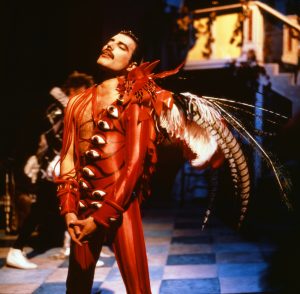
Photo Download LINK
Photo Credit: Simon Fowler. © Queen Productions Ltd
All eyes on Freddie – “It’s A Hard Life” video, 1984.
Queen The Greatest – Episodes 1-34 – Watch HERE
This week’s Queen The Greatest completes the celebration of Queen’s biggest songs and who wrote them by highlighting five classic tracks composed by the band’s inimitable lead singer, Freddie Mercury. It comes just days ahead of the marking of 30 years since his passing.
Some of Freddie’s biggest hits, such as “We Are The Champions,” “Somebody To Love,” “Crazy Little Thing Called Love,” and, of course, his masterpiece, “Bohemian Rhapsody,” have already been featured in this series. Yet there still remain plenty of other treasured gems to be enjoyed, such was Freddie’s extraordinary ability to write timeless classics.
Beginning this journey through Freddie’s further hits is a song that has become more popular as time has passed. “Don’t Stop Me Now” was a hit on its release in 1979, but proving its longevity, it also topped the UK charts when covered by McFly in 2006. A party favorite, and regularly voted as one of the best songs to drive to, the track’s popularity was further galvanized after featuring in the Bohemian Rhapsody film soundtrack, currently standing as Queen’s second most streamed song in the UK.
In 1982, “Body Language” provided a memorable example of how Queen benefited from having such a strong international appeal. Although not an obvious success in the UK, it went down a storm in the US, most probably helped by the notoriety it gained by becoming the first video banned by MTV, and raced up the North American charts giving the band their fifth biggest ever single in the US in June 1982.
“It’s A Hard Life,” featured on the 1984 album The Works and was the third single from that album to make the top ten. The track also gained some notoriety through the Pagliacci opera-styled masquerade ball video for the song, with his fellow band members likening the “eyes” on Freddie’s bright red costume to giving him the appearance of a “giant prawn.”
And although for The Miracle album, all four band members shared the writing credits for each song, Freddie’s inspiration on the title track is widely acknowledged.
The episode appropriately finishes this visiting of some of Freddie’s most memorable hits with the last one he ever wrote, the blissful “A Winter’s Tale.” Featured on the Made in Heaven album, it was a top ten hit when posthumously released in 1995, and is a fitting reminder of Freddie’s genius as a songwriter.
Embed link here:
<iframe width=”560″ height=”315″ src=”https://www.youtube.com/embed/Eg9is8oBO5U” title=”YouTube video player” frameborder=”0″ allow=”accelerometer; autoplay; clipboard-write; encrypted-media; gyroscope; picture-in-picture” allowfullscreen></iframe>
Next week: “1991 Innuendo”
http://www.queenonline.com
YouTube / Instagram / Facebook / Twitter / TikTok
Brian / Roger
Queen The Greatest: a celebration of 50 of the greatest moments from the Queen story so far.
A 50-week YouTube series celebrating key moments in Queen’s history reminding us why Queen and their music continue to beloved across the world
Queen The Greatest Episode 35: “The Parties”
When it comes to their work in the studio, and their live performances on stage,
Queen have reached iconic status. But in true rock n roll fashion their ability to
throw an extravagant party is also legendary.
WATCH HERE
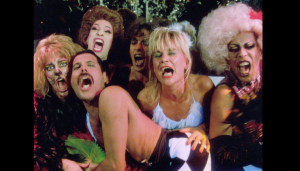
Photo LINK
Photo Credit: Peter Röshler © Mercury Songs Ltd
Excess All Areas
Freddie Mercury’s 39th Birthday Party
Mrs Henderson’s, Munich, September 1985
Queen The Greatest – Episodes 1-34 – Watch HERE
Over the on-going Queen The Greatest series, we have seen how Queen remain second to none when it comes to pushing boundaries with their work. But it’s worth remembering that in true rock’n’roll fashion they also applied the same showmanship when it came to parties.
When Queen were on the road, their live show was always the hottest ticket in town. However, if you were one of the lucky ones that made it onto the guest list for a Queen party, like this one after the Wembley show in 1986 when the band took over London’s famous Roof Gardens, you were in for a night guaranteed to blow your mind. See footage of Brian May performing with glamour model, singer, Samantha Fox.
Perhaps the most legendary of all occurred on Halloween night October 1978, when it was time to launch the band’s Jazz album. Having earlier performed at the New Orleans Civic Auditorium, the action moved to the Fairmont Hotel in the city’s vibrant French Quarter.
Brian May: “When it came time to launch the Jazz album, we had the idea of having a massive party in New Orleans.”
Roger Taylor: “It was the so called ‘launch’ of that album, and we had lots of girls and things, there was a band, a New Orleans band, it was a very, very over the top party.”
Brian May: “We had a bit of a spiritual connection with New Orleans, and a lot of our friends came…of all sexes!”
One fabled story tells that at least one strip club in the vicinity of the Fairmont had to close early because their employees and patrons took Queen up on the offer to party.
Roy Thomas Baker (Producer): “It was definitely fun. When I opened up the door of my suite, on the bed was a complete case of Dom Pérignon, and then it was down hill from there.”
Roger Taylor: “I remember I felt quite ill the next day. There were lots of acts. There was a man who, he was actually a person of restricted growth, who did lay under meats. He said, when asked what he did, he said ‘I lie under meats.’”
Roger Taylor: “And he’s covered in sort of cold cuts and chopped liver, and stuff like that. You couldn’t see him, and so people would approach the trestle table and as they just reached out to scoop their meat, he would just move, like that. And that was his act.
This now established Queen tradition of extravagant nights, spilled over into Freddie’s birthday parties – such as the now famous black and white themed celebration for his 39th birthday held at Munich’s Mrs Henderson’s club and filmed for posterity for Freddie’s “Living On My Own” video.
Each party would generate an array of myths and legends around what happened that night, and although, as has been seen, the cameras were occasionally allowed to capture glimpses – only those that were there really know what happened when the filming stopped…
Embed Link here:
<iframe width=”560″ height=”315″ src=” https://www.youtube.com/embed/S9wt72ti3kE” title=”YouTube video player” frameborder=”0″ allow=”accelerometer; autoplay; clipboard-write; encrypted-media; gyroscope; picture-in-picture” allowfullscreen></iframe>
Next week: “Freddie’s Hits”
http://www.queenonline.com
YouTube / Instagram / Facebook / Twitter / TikTok
Brian / Roger
Queen The Greatest: a celebration of 50 of the greatest moments from the Queen story so far.
A 50-week YouTube series celebrating key moments in Queen’s history reminding us why Queen and their music continue to beloved across the world
Queen The Greatest Episode 34: Queen 1986 – The Magic Tour – Part 2
Continuing our look at Queen’s record-breaking Magic Tour…
As the tour reaches its climax, and within just a few short weeks of each other,
Queen play three of their most memorable and iconic gigs.
WATCH HERE
Queen The Greatest – Episodes 1-33 – Watch HERE
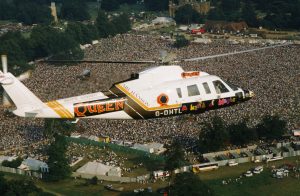
Photo LINK
Credit: Photography by Denis O’Regan.
© Queen Productions Ltd.
Queen arrive for their final 1986 concert at Knebworth Park, U.K., in the ‘Magic Helicopter’ customized with the art from the band’s A Kind of Magic album.
“We always believed that we had something special, and that we could do anything that anyone else did. That’s the kind of belief that kept us going in the early days. But I don’t think we quite believed what would happen. I don’t think we even knew what was possible.” Brian May
“I think that in some form or another the music will always continue now, I think they’ve reached that status. Nobody knows whether Mick Jagger will be singing when he’s 65, or Queen will be performing as Queen. I think that the Queen structure will continue on, and they will continue to make music.” Jim Beach, Manager
Queen The Greatest returns this week with a second instalment revisiting the band’s sensational and record-breaking 1986 Magic Tour.
Having already blazed a trail with 14 sold out shows around the UK and Europe setting milestones along the way, Queen returned to London in July 1986 to play two nights at London’s 72,000 capacity Wembley Stadium – the site of their extraordinary and historic performance at Live Aid the previous year.
Yet despite the band having reached an all-time high popularity, they weren’t taking it for granted that their first home ground shows since Live Aid would sell out…
Brian May: “We’ve been away a long time and tickets will go on sale for Wembley on Friday. And it’s always a time when you sort of go ‘I wonder what is out there? I wonder if they still do want to see us?’ You never know. We’ll only know once the applications start coming in.”
The 150,000 tickets sold out in a matter of hours, and these memorable nights were captured on camera and remain one of Queen’s best-loved live shows to this very day.
Roger Taylor: “I think Wembley was a tough gig, because of the actual physical size of it. You’d better go down well there; you don’t want a quiet audience. I’ve seen people die there because you won’t hear them. If it’s a ripple, a ripple really won’t register. So, you need a roar. They call it the Wembley Roar. And it was OK for us. You knew you were going to have to work quite hard at Wembley.”
Then as Queen hit the road once again, a new adventure awaited them…
[Interviewer]: “I think there’s only one country you’ve never been to before?”
Roger Taylor: “That’d be Hungary. Yeah. Budapest.”
[Interviewer]: “So that is new ground?”
Roger Taylor: “It’s great, yeah. We’re very excited about that. There are people from all over the Iron Curtain bloc coming. They’re selling tickets in…or whatever they do over there. Do they sell tickets?”
[Interviewer]: “I presume so?”
Roger Taylor: “Or give them away? I don’t know, I don’t know. Whatever they do, people are coming from Poland and Czechoslovakia, and a lot of the Eastern Bloc, which is very exciting. ‘Cos the Russians would never let us in.”
Freddie Mercury: “I like doing places that we’ve never done before, to see how they’re going to react. Some places that we’ve already been before, we have a certain idea of how, what they’re going to do. But this is going to be great. It’s going to be great to see if they do the same things, if they have seen the films and whether they’re going to do the same things for ‘Radio Ga Ga’ and things like that. That should be very interesting, a good challenge.”
Making history as the first artists to ever perform anywhere behind the Iron Curtain, the band’s July 27 show would be played to an audience of over 80,000. Filmed using nearly every available 35m television camera available in the country the concert would go on to further make history by being broadcast at the end of the year across the Communist Bloc including Czechoslovakia, East Germany, and Yugoslavia as well as being shown in 59 Hungarian cinemas on New Year’s Day 1987.
Drawing to a close with only dates still to be played in France and Spain, the overwhelming demand back in the UK prompted promoters to hastily add one last massive show to the schedule – at the famous Knebworth Park, where the band would end their tour performing an open-air show before an audience variously estimated at between 160,000 and 200,000. Since the start of the tour, June 7, Queen would end up playing to a just over one million people.
Brian May: “We always believed that we had something special, and that we could do anything that anyone else did. That’s the kind of thing, that’s the kind of belief that kept us going in the early days. But I don’t think we quite believed what would happen. I don’t think we even knew what was possible.”
Jim Beach, Manager: “I think that in some form or another the music will always continue now, I think they’ve reached that status that their music will be remembered. How much longer they record…goodness only knows. Nobody knows whether Mick Jagger will be singing when he’s 65, or Queen will be performing as Queen. I think that the Queen structure will continue on, and they will continue to make music. How it will be…nobody ever knows that, really.”
Freddie Mercury: “We’re the only sort of, the four Grand Dames that have actually stuck it together.”
John Deacon: “Yes you do ask how long it’s going to go on really, and we’ve been doing it a long time now, and I don’t know. If I could tell the future, life would be quite boring I think.”
Signing off at the close of the band’s August 9, 1986, Knebworth concert, Freddie thanked the crowd saying: “Thank you lovely people, you’ve been a wonderful audience. God bless you. God bless you, goodnight, thank you.”
No one knew this yet, but this was to be Queen’s last-ever public performance with Freddie.
Embed link here:
<iframe width=”560″ height=”315″ src=”https://www.youtube.com/embed/Si-sK_OA1V0” title=”YouTube video player” frameborder=”0″ allow=”accelerometer; autoplay; clipboard-write; encrypted-media; gyroscope; picture-in-picture” allowfullscreen></iframe>
Next week: Queen – The Parties
http://www.queenonline.com
YouTube / Instagram / Facebook / Twitter / TikTok
Brian / Roger
Queen The Greatest: a celebration of 50 of the greatest moments from the Queen story so far.
A 50-week YouTube series celebrating key moments in Queen’s history reminding us why Queen and their music continue to beloved across the world
Queen The Greatest Episode 33
Queen 1986: The Magic Tour – Part 1
It’s 1986 and preparations are underway for what would become Queen’s biggest and most successful stadium tour. This is the first in a two-part story going
behind the scenes of the record-breaking Magic Tour.
WATCH HERE
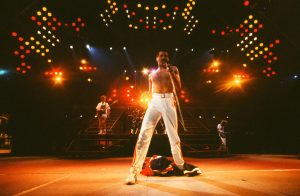
Photo LINK HERE
Photo Credit: Photography by Denis O’Regan © Queen Productions Ltd.
“Strangely enough, when you’re used to large audiences, 100,000 is almost less terrifying in some ways, than 5000.” Roger Taylor
“There was a trend a few years ago, with the punk movement and whatever, where they said, ‘Oh, we want to play to the small audiences because we’re being intimate, and all that.’ Load of rubbish. I mean everybody who wants to be a star wants to play to the biggest audiences.” Freddie Mercury.
Queen The Greatest – Episodes 1-32 – Watch HERE
This week’s Queen The Greatest episode celebrates Queen’s now legendary 1986 stadium tour of Europe – The Magic Tour.
Rejuvenated by their history-making Live Aid performance a year earlier, and the success of their A Kind Of Magic album, June 1986 saw Queen return to touring for what would be the biggest series of concerts of Queen’s career. Although the band had played vast venues before, there was a sense that this tour would take it to another level…
“We’re going to play the biggest stage ever built at Wembley with the greatest light show ever seen,” Roger Taylor told journalists ahead of the tour.
The band would undertake 26 performances at 20 separate locations in the UK and nine European countries over an eight-week period including their first and only show in Budapest, Hungary.
Such was the vast scale and scope of the under-taking, the bridge-like stage structure required the services of a company normally involved in motorway and bridge construction. The trucks transporting the equipment would cover over 165,000 miles, the equivalent of nearly seven times around the world.
Talking here in the preparation stage, the band speak of the commitment they were taking on, with only Freddie expressing concerns about the weight such a massive tour would levy, but non-the-less expressing his enthusiasm for performing for large audiences.
Roger Taylor: “The thing we are all looking forward to most at the moment is this European tour.”
John Deacon: “And that’s quite a commitment from us in a way, because Freddie’s sometimes a little reluctant to go on the road these days.”
Freddie Mercury: “It’s been a while since we actually did a tour. It’s very, very exhausting for me to do what I have to do. The stages are getting bigger and everything, and you know I just like to feel that I’m perfectly fit to do these shows, and not just say ‘yes I’ll do it.”
John Deacon: “We’re starting on it now really, ideas for the staging, the lighting and that sort of thing.”
[Interviewer] “This particular tour you’re doing, you’re taking a hundred and sixty foot stage, which is the biggest ever constructed for a rock act?”
Roger Taylor: “Yes, it’s an absolutely massive stage. It’s really been designed to cope with the places that we’re playing in. To get the optimum out of those places.”
Brian May: “We usually go in someplace like a film studio which has this big, open…like an aircraft hanger I suppose…and just set everything up and put everything through its paces.”
Brian May: “Because it’s not enough for us to be rehearsed, we make sure every single lamp, every wire, is set up so everything’s going to be given a run through, so all the bugs can be ironed out before we get on tour. It’s like a full dress rehearsal.”
John Deacon: “We’ve been playing for so many years now, we do feel very relaxed playing in quite big gigs as well really.”
Roger Taylor: “Strangely enough, when you’re used to large audiences, 100,000 is almost less terrifying in some ways, than 5000.”
Roger Taylor: “It’s a strange thing with our band, the bigger the audience the better it seems to work. The audience contact seems to be better with the larger audiences.”
Brian May: “Once you’re on tour, I like to get on and do it. I don’t like to be hanging around on tour. I like to get in as much as you can because you can build up this great rhythm, and you get into the mood and the feel of playing, you play better each night, I think. If you see us at the end of the tour, we are a lot different from what we are at the beginning of the tour, because we’re in that rhythm.”
Brian May: “I suppose it’s almost like being an athlete, you just work on yourself and you have nothing else to think about, except doing your bit for that two hours as well as you can.”
Freddie Mercury: “There was a trend a few years ago, with the punk movement and whatever, where they said, ‘Oh, we want to play to the small audiences because we’re being intimate, and all that.’ Load of rubbish. I mean everybody who wants to be a star wants to play to the biggest audiences.”
As will be seen in part 2, over the final few weeks of the tour, Queen would perform three of their biggest and most iconic gigs – demonstrating why they are regarded as the greatest live act.
Embed link here:
<iframe width=”560″ height=”315″ src=”https://www.youtube.com/embed/JO6YnMMmOYY” title=”YouTube video player” frameborder=”0″ allow=”accelerometer; autoplay; clipboard-write; encrypted-media; gyroscope; picture-in-picture” allowfullscreen></iframe>
Next week: Queen 1986 – The Magic Tour – Part 2
http://www.queenonline.com
YouTube / Instagram / Facebook / Twitter / TikTok
Brian / Roger
Queen The Greatest: a celebration of 50 of the greatest moments from the Queen story so far.
A 50-week YouTube series celebrating key moments in Queen’s history reminding us why Queen and their music continue to beloved across the world
Queen The Greatest Episode 32:
“Queen at The Movies – Take 2: Highlander”
With just twenty minutes of rough footage to show, director Russell Mulcahy hoped it would be enough to persuade Queen to write one song for his new movie. He ended up with an entire soundtrack that included some massive hits.
WATCH HERE
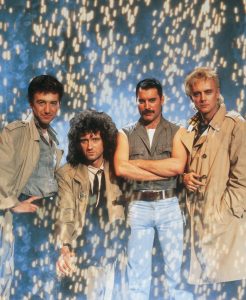
Photo LINK
Credit: Photography by Peter Hince. © Queen Productions Ltd.
Queen The Greatest – Episodes 1-31 – Watch HERE
“I thought to myself, the film needs not only a big orchestration score, but it needs a big rock score. I had twenty minutes of the film cut together, and I brought them in. I didn’t know how they were going to react. I only wanted them to do one song. They saw the footage and said ‘we’ll do five songs’.” – Russell Mulcahy.
“I was dealing with various tragedies in my own life so I could immediately hear Who Wants To Live Forever in my head. It was almost completed in the car going home. I remember singing it to my manager as he drove me. He said, ‘where did that come from?’ and I said ‘I don’t even know where it came from, but I can just hear it in my head.’” Brian May
(Friday, October 22, 2021) Queen The Greatest this week provides a second instalment of Queen At The Movies, this time looking at the band’s musical contribution to Highlander.
Following the success of their first soundtrack album, Flash Gordon, Queen were not short of offers to be involved in other film projects. Nothing captured their imagination until 1986 when director Russell Mulcahy made a tentative approach with his new fantasy movie project, Highlander, to see if the band could be tempted…
Russell Mulcahy: “When it came to doing Highlander, I thought to myself, the film needs not only a big orchestration score, but it needs a big rock score. I had twenty minutes of the film cut together, and I brought them in, and I didn’t know how they were going to react. I only wanted them to do one song in the film. They saw the footage and they said ‘we’ll do five songs.’”
Queen would eventually end up writing and performing six new songs for the film as well providing additional music.
Roger Taylor: “I don’t know what prompted Russell to get in touch with us, but he said ‘come down to a screening theatre and have a look at this and see what you like.’ And we went and we saw the opening scenes and then I think the love scene, in the Highlands, and we thought it was magnificent, visually.
“It was nowhere near finished by then, we just thought ‘that’s really great, we could do some good stuff on that.’ And that inspired Brian to write “Who Wants To Live Forever,” and then I wrote “A Kind Of Magic” off that, nicking the line from the film. And that was quite a nice experience.
Brian May: “It depends how well you know the Highlander film, but it’s a film about a man who becomes conscious that he’s immortal, and he’s reluctant to accept the fact. He’s told that if he falls in love he’s in for big trouble, but of course he falls in love anyway and the girl that he falls in love with eventually grows old and dies in his arms.
“That kind of opened up a floodgate in me, I was dealing with various tragedies in my own life, the death of my father, the death of the marriage etcetera, etcetera, so I could immediately hear this “Who Wants To Live Forever” song in my head. It was almost complete in the car going home, I remember singing it to my manager as he drove me home and he was pretty surprised. He said, ‘where did that come from?’ and I said, ‘I don’t even know where it came from, but I can just hear it in my head.’”
Unlike Flash, Queen decided not to release a soundtrack album, but instead paired their six tracks which appeared in Highlander with other songs, such as “One Vision,” “Friends Will Be Friends,” and “Pain Is So Close To Pleasure” to create a full Queen album, 1986’s A Kind Of Magic, their first to be released since their acclaimed Live Aid performance. It was an immediate No.1 album in the UK and gave them hit singles with tracks from the film “A Kind of Magic” and “Who Wants To Live Forever.”
They teamed up with director Russell Mulcahy again to make the promo videos for the majestic “Princes of The Universe,” and the spellbinding “A Kind Of Magic.”
Roger Taylor: “I remember discussing it with the Director, Russell Mulcahy, saying how we want strange little things to happen, like I remember I sort of wanted gargoyles winking and things like that, and having this magic stuff flying all over the place. And I think it worked nicely, it’s un-pretentious, and it’s rather nice.”
Over subsequent years, Queen songs have featured on and enhanced a number of films – but the next time the band would provide a full soundtrack just over thirty years later, would be for a movie they’d be making themselves – coming soon, to Queen The Greatest.
Embed link here:
<iframe width=”560″ height=”315″ src=” https://www.youtube.com/embed/Yzb3awcURkM” title=”YouTube video player” frameborder=”0″ allow=”accelerometer; autoplay; clipboard-write; encrypted-media; gyroscope; picture-in-picture” allowfullscreen></iframe>
Next Week: “1986 – Queen : The Magic Tour Part 1”
http://www.queenonline.com
YouTube / Instagram / Facebook / Twitter / TikTok
Brian / Roger
Queen The Greatest: a celebration of 50 of the greatest moments from the Queen story so far.
A 50-week YouTube series celebrating key moments in Queen’s history reminding us why Queen and their music continue to beloved across the world
Queen The Greatest Episode 31: “One Vision”
A fascinating glimpse of Queen at work in the studio on the smash hit single “One Vision,” which resulted from, at the time, a unique collaboration between all four band members… with added help from a Chinese Takeaway menu.
WATCH HERE
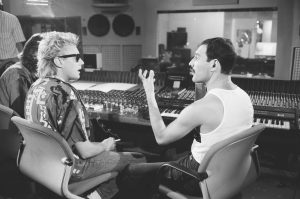
Photo Download LINK
Roger Taylor, Freddie Mercury. Musicland Studios, Munich. 1985
Photo Credit: Peter Röshler / Copyright Queen Productions Ltd
“The original words, actually, were about Martin Luther King, and now I haven’t got a clue what it’s about.”
“That really was a proper collaboration of everybody, I mean Brian came up with the riff, and then John came up with the bass part, and Fred came up with a Chinese menu which he was reading at the end. We’ve got a version actually somewhere.
He goes through half the menu…” – Roger Taylor.
Embed link here:
<iframe width=”560″ height=”315″ src=”https://www.youtube.com/embed/2wmk_C6fzOo” title=”YouTube video player” frameborder=”0″ allow=”accelerometer; autoplay; clipboard-write; encrypted-media; gyroscope; picture-in-picture” allowfullscreen></iframe>
This week’s Queen The Greatest revisits yet another of the band’s stand out hits, “One Vision,” and recounts the fascinating story of a song that appears to have started out being about Martin Luther King…and ended up…well, Roger Taylor attempts to explain.
It also marked only the second song in their career to be credited as written by Queen rather than a specific band member.
In September 1985, at Freddie’s suggestion, Queen returned to Musicland Studios in Munich, Germany, with the idea of getting together to ‘see what happened.’
John Deacon: “Freddie was on the phone, and he wanted to go back in the studio and do some more recording. So in the end we went back in and we recorded another single. It was his idea really, that we could go in and actually write a song together.
“It’s credited as a Queen composition but to be honest I’d say it was mainly Roger, Brian and Freddie that did most of the writing for it.”
The song’s creation began with a riff created by Brian, and some lyric ideas from Roger…
Roger Taylor: “Yeah, I had a, sort of, set of lyrics that I think I used for two songs actually, with sort of amendments. I think it started with those lyrics and we literally wrote the song between ourselves in the studio, around those lyrics really. We were all throwing in bits of chicken bone.”
As the song started to take shape, it was clear that Queen were at a stage where this way of working suited them.
Brian May: “We know where to stop with each other, we know how far we can go, and we respect each other, I think. We think that in spite of all the problems that we may have, that Queen is still something that’s kind of precious.
“Something happens which is a situation where you can be creative and if it works for a long time, you’re very lucky. I’m sure I can leave the group and I can find people to play with who’ll do exactly what I tell them, but it won’t be the same as what we have.”
Roger Taylor: “That really was a proper collaboration of everybody, I mean Brian came up with the riff, and then John came up with the bass part, and Fred came up with a Chinese menu which he was reading at the end. We’ve got a version actually somewhere…he goes through half the menu. Which is why we kept Fried Chicken at the end.”
Although the process had been an unusual one for the band, the end result was another global smash hit, even if, as Roger admitted at the time, the sentiment behind his original lyric ideas had got lost along the way…
Roger Taylor: “The original words, actually, were about Martin Luther King, and now I haven’t got a clue what it’s about. Somebody said it was about Bob Geldof, but I don’t think it is.”
[Interviewer] “So you don’t know what it’s about?”
Roger Taylor: “No, not anymore. Well they changed all my words.”
[Interviewer] “Who did?”
Roger Taylor: “Well that rotter, Freddie.”
On its way to being a fan favorite, “One Vision” would also serve as a memorable opening number for the band’s 1986 Magic tour.
Next Week: “Queen at the Movies: Take 2 – Highlander”
http://www.queenonline.com
YouTube / Instagram / Facebook / Twitter / TikTok
Brian / Roger
Queen The Greatest: a celebration of 50 of the greatest moments from the Queen story so far.
A 50-week YouTube series celebrating key moments in Queen’s history reminding us why Queen and their music continue to beloved across the world
Queen The Greatest Episode 30: Queen 1985: Live Aid
Queen’s finest 20 minutes? Hear from all four members of the band as we look back at Queen’s stunning contribution to one of the most important and memorable events in music history.
WATCH HERE
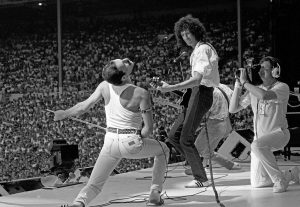
Wembley Stadium, London. 13th July 1985. 6.41pm.
Photo LINK
Credit: Photograph: Neal Preston
Queen The Greatest – Episodes 1-29 – Watch HERE
(Friday, October 4, 2021) After Queen’s record-breaking nights at Rock In Rio in January 1985, the band felt it would take something unbelievably special to top that. Six months later, came…. Live Aid.
On July 13, 1985, many of the world’s biggest music stars came together in London and Philadelphia to stage a global charity concert to raise awareness and money for a devastating famine in Ethiopia.
In just 21 minutes, in front of a worldwide audience of 1.9 billion people, Queen delivered what until today is widely regarded as the greatest live gig of all time.
But winding back the clock, as Brian May explains, when organiser Bob Geldof first approached the band, they weren’t sure he’d be able to pull it off.
Brian May: “It was actually at the BPI Awards that we went to collect an award, and Geldof was a few tables away and came over and said how about doing this thing, and he said we are going to have this, and this, and this, and this, and we said ‘oh yeah, I’m sure,’ thinking that it was an almost impossible thing to get together, but we said ‘yeah,’ we’d be interested.
“And then a bit later he rang up and said ‘look Brian, I have to have a commitment,’ and so we talked about it a bit more and seemed like we were all very keen to do it.”
With just twenty minutes allotted to each act, Queen locked themselves away to work out the best way to make the most of their time. Not an easy task, as the band reveal.
Brian May: “It’s pretty hard to make the choice.”
Roger Taylor: “Yes, we don’t really know quite what to do, whether to play the hits or to try and do something new. But I think in 20 minutes really, we’ve got to play things that people know, and will recognise in Turkey or wherever they’re watching. Maybe. Hopefully.”
Freddie Mercury: “So we’re still squabbling over that fact that’s what he’s trying to say.”
Despite everyone being committed to the cause, the band felt a bit of healthy rivalry between the various acts was also inevitable…
Freddie Mercury: “I think it’s going to be chaotic, yes, it has to be. I mean we’re the nice part of it actually, there’ll be lots of friction and we’re all going to try and outdo each other I guess.”
But on the day, egos or thoughts of rivalry vanished as the enormity of the cause and occasion became apparent. And Queen’s meticulous planning ensured an ecstatic reaction from everyone watching.
Paul Gambaccini (broadcaster/writer): “It was as if all the artistes back stage had heard a dog whistle, and their heads turned and the frisson you felt was ‘they’re stealing the show.’”
Midge Ure: “I defy anybody who saw it, not to have goose-pimples on the back of their neck when you saw that sea of people.”
Roger Taylor: “I remember looking up and seeing the whole place going completely bonkers in unison and thinking ‘oh, this is going well.’”
Brian May: “We did have an unfair advantage, we had done football stadiums. Freddie, particularly, learned this magical way of involving everybody in a huge football stadium, he could make everybody feel that they were in contact.”
What turned out to be one of Queen’s shortest live performances, was probably one of their most important and iconic – paving the way for what was to follow.
Roger Taylor: “People will say was it a career move? Well, no it wasn’t a career move, but of course that’s in the back of everybody’s mind.”
John Deacon: “We got a great reception from the crowd, even at Wembley, and also from the TV audience as well, so in fact it was a great boost of confidence in a way, for the group.”
Manager Jim Beach: “To have conquered Live Aid in that way, undoubtedly breathed fresh energy into the band.”
Something we will learn more of in upcoming episodes of Queen The Greatest.
Embed link here:
<iframe width=”560″ height=”315″ src=”https://www.youtube.com/embed/C4xH92jzKrQ” title=”YouTube video player” frameborder=”0″ allow=”accelerometer; autoplay; clipboard-write; encrypted-media; gyroscope; picture-in-picture” allowfullscreen></iframe>
Next Week – “One Vision”
http://www.queenonline.com
Website / YouTube / Instagram / Facebook / Twitter / TikTok
Brian / Roger
Queen The Greatest: a celebration of 50 of the greatest moments from the Queen story so far.
A 50-week YouTube series celebrating key moments in Queen’s history reminding us why Queen and their music continue to beloved across the world
Queen The Greatest Episode 29: “Queen 1985 – Rock In Rio”
No celebration of Queen’s greatest moments would be complete without a look back at their record-breaking performance at Brazil’s inaugural Rock In Rio festival. Featuring some rare interviews from the after-show party.
WATCH HERE
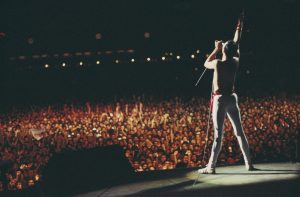
Photo Download LINK
Credit: Photo Richard Young
Queen The Greatest – Episodes 1-28 – Watch HERE
“A lot of the groups were scared to come here in the early days, and we took the plunge. And look what happened!” – Freddie Mercury, Rio de Janeiro, Brazil, 1985
(Friday, October 1, 2021) Revisiting one of Queen’s most iconic moments and greatest achievements, Queen’s record-breaking headlining appearance at Rock in Rio is the focus of this week’s Queen The Greatest.
In January 1985, Queen flew out to Rio de Janeiro, Brazil, to headline what was to be the biggest rock festival ever held. Queen would be the headline act for the 10-day festival performing on the opening night January 12, and the closing show on January 19th.
Over the two nights the band performed to over 600,000 eager and rock hungry Brazilian fans. Edited highlights shown on Brazil’s national O Globo television channel throughout South America were watched by nearly 200 million people.
It was the beginning of a decades long love affair between the band and South America.
Queen’s previous 1981 Gluttons For Punishment tour stadium experiences in South America put them in good stead for what was to come, but could hardly have prepared them for the overwhelming reception they would receive on their return to Brazil.
Interviewer: “Freddie, can I just stop you for a minute and ask you how everything’s going?”
Freddie: “I think everything is going to be OK. I’ve got first night jitters, I think, this is the first big night. We’re going to watch the other bands and see how it’s all going. I just want to get a feel of it all.”
In a site specially built to hold a staggering 250,000 people, Queen took to the stage at 2 o’clock in the morning. Yet despite the late hour, they were met by an extremely excitable crowd, stretching as far as the eye could see.
Their first night delivered another spectacular show, and as a rare BBC TV report from the after-show party at Rio’s famous Copacabana Palace Hotel highlights, the band clearly didn’t want this special night to end.
Interviewer: “What’s it like looking out over all that huge amount of people?”
Freddie Mercury: “Well, it’s mind boggling you know, and to me I just…it’s like a housewife to be honest, just go on there and do my job and then come home.”
Interviewer: “Surely, it can’t be like being a housewife?”
Freddie Mercury: “Oh, you know what I mean. It’s just a job to me anyway, but it’s mind-boggling, what can I tell you, it’s quite amazing. I mean, you saw those people there.”
Interviewer: “So guys, how did you feel it all went tonight?”
Roger Taylor: “Very well. Fantastic. Our biggest audience yet, I think.”
Freddie Mercury: “When you’ve got a crowd as large as that, and the event, the adrenaline just takes you over, and so I guess I was sort of cavorting about more than usual, I don’t know.”
Roger Taylor: “The only thing was it was very late by the time we went on, but everybody stayed so, I mean, it was great really.”
Interviewer: “For a lot of the bands this was a first visit to South America, it was Queen that blazed the trail on two previous tours, being the first big rock band to come here.”
Freddie Mercury: “The Government actually wanted us to be here, and I think. A lot of the groups were scared to come here in the early days, as it were, and we took the plunge. And look what happened!”
Interviewer: “Queen gained a lot of fans in Brazil, some of whom managed to persuade Brian May to come and play on the beach.”
Queen fans had placed five hundred lighted candles in the sand spelling out the band’s name. Observing it, Brian and his daughter left the party for a while to join the fans on the beach, a gesture fans still remember to this day.
Queen would return to Rock in Rio in 2015 with Adam Lambert, for the Festival’s 30th anniversary – once again receiving a rapturous reaction.
Looking back to Rock in Rio 1985, it had been an extraordinary way to start the year, and as the band left Brazil, they must have wondered if there would ever be an event as remarkable as that one had been.
Little did they know the answer to that question was just a few months away…as we will discover in the next episode of Queen The Greatest.
Episode 29 Embed link here:
<iframe width=”560″ height=”315″ src=” https://www.youtube.com/embed/aoCp5U0x7Os” title=”YouTube video player” frameborder=”0″ allow=”accelerometer; autoplay; clipboard-write; encrypted-media; gyroscope; picture-in-picture” allowfullscreen></iframe>
Next Week – “Live Aid”
http://www.queenonline.com
Website / YouTube / Instagram / Facebook / Twitter / TikTok
Brian / Roger
Queen The Greatest: a celebration of 50 of the greatest moments from the Queen story so far.
A 50-week YouTube series celebrating key moments in Queen’s history reminding us why Queen and their music continue to beloved across the world
Queen The Greatest Episode 28: “Queen: Love of My Life”
Originally released on Queen’s 1975 A Night At The Opera album, this beautifully unassuming ballad looked destined to be one of the band’s hidden gems. Instead, it grew into an emotional duet that is a cornerstone moment in the Queen live show to this very day.
WATCH HERE
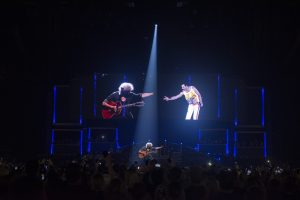
Photo LINK
Credit: Photograph: Ric Lipson. ©Stufish
Queen The Greatest – Episodes 1-27 – Watch HERE
(Friday, September 24, 2021) This week’s episode of Queen The Greatest celebrates a song that has truly become one of a kind. It is “Love of My Life.”
“Love of My Life” first appeared on Queen’s seminal album, A Night At The Opera in 1975. Written by Freddie Mercury, it was not released as a single at the time, and did not immediately make it on to the live set list.
However, it was not destined to be one of the band’s hidden gems after an arrangement by Brian resulted in something special for the Queen live show.
By the time we get to the Live Killers tour of 1979, “Love of My Life” has become firmly established as a key moment with Freddie conducting the audience in a mass duet.
And then in the 80’s, particularly in the stadiums of South America, with audiences regularly well over a hundred thousand, this simple, yet stunningly beautiful ballad really came into its own.
No matter which country Queen was in, or what language was spoken, the audience knew every word, and would respond with an enthusiasm that constantly amazed the band.
If the song provided a true connection between Queen and their audience during the 70’s and 80’s, in more recent years it has become the most fitting and moving of tributes to Freddie – culminating in an emotional on screen appearance, and cementing it as one of Queen’s most enduring songs as can be seen in this live performance from a Queen + Adam Lambert London O2 Arena show in 2018.
Episode 28 Embed link here:
<iframe width=”560″ height=”315″ src=”https://www.youtube.com/embed/f51G446XDsM” title=”YouTube video player” frameborder=”0″ allow=”accelerometer; autoplay; clipboard-write; encrypted-media; gyroscope; picture-in-picture” allowfullscreen></iframe>
Next week – “Queen 1985: Live In Rio”
http://www.queenonline.com
Website / YouTube / Instagram / Facebook / Twitter / TikTok
Brian / Roger
Queen The Greatest: a celebration of 50 of the greatest moments from the Queen story so far.
A 50-week YouTube series celebrating key moments in Queen’s history reminding us why Queen and their music continue to beloved across the world.
Queen The Greatest Episode 27: “Ay-Oh”
Celebrating the evolution of Freddie Mercury as the ultimate showman. From the beginning, Freddie understood the importance of winning a crowd, and over the years became the absolute master – culminating in one of the most iconic moments in music history at Live Aid in 1985.
WATCH HERE
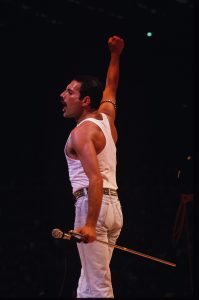
Photo: LINK
Credit: Photography by Neal Preston.
“That’s the part of my role, I have to win them over, otherwise it’s not a successful gig. It’s my job to make them feel that they’ve had a good time.” Freddie Mercury
Queen The Greatest – Episodes 1-26 – Watch HERE
(Friday, September 17, 2021) A simple improv call and response chant believed to have had its beginning in a 1978 Montreal concert – and made its way through history to become a highlight of Queen’s historic 1985 Live Aid performance… not to mention a place in a blockbuster movie.
The subject of its own online discussion boards, lyric interpretation pages and search engines, GIFs and ringtones…it is the instantly recognisable…. Ay-Oh.
This week Freddie Mercury’s legendary crowd call-out gets its own episode of Queen’s weekly YouTube series Queen The Greatest, focussing on what has become one of the most iconic audience participation moments to emerge from Queen’s illustrious live career.
From the very early days of Queen, Freddie understood the importance his role as the band’s frontman had in winning over an audience.
Freddie Mercury: “That’s the part of my role, I have to win them over, otherwise it’s not a successful gig. It’s my job to make sure that I win them over and make them feel that they’ve had a good time.
“I’m very frivolous, and I like to enjoy myself, and what better way to do it than on stage in front of 300,000 people. I just cook on stage, that’s just my nature. That’s not what I’m like in real life, my character’s built up of all kinds of ingredients and this is one element of me.
“On stage, that’s my job and I don’t like to go on stage, sitting on a stool and do a show. I’m very volatile, in that way, and I like to actually put a song across in the way it is. It’s all part of showbiz and theatre, that’s another side of me.”
Just as important as how he performed the songs, Freddie knew his interaction with the crowd helped create a moment that felt special to each audience.
Freddie Mercury: “Do you like my claws? They’re real diamonds. It’s a present from the devil himself. You don’t believe me? They don’t believe me!”
Throughout the 70’s and into the early 80’s, as the venues and crowds got bigger and bigger, Freddie became a master at making everyone feel a part of the show, as witnessed in a clip from the band’s show at the Milton Keynes Bowl in 1982.
And then in 1985, at that monumental Live Aid performance, came one of the most memorable moments in music history….
Featured throughout the 1986 Magic Tour, Freddie’s Ay-Oh’s became a seminal part of the Queen show – and remains so to this very day. In February 2020, when Queen and Adam Lambert re-created the Live Aid set to support the Fire Fight Australia benefit, it was Freddie’s on screen cameo that created one of the show’s most magical moments, as can be seen in footage from the event.
A poignant reminder of how Freddie really was the ultimate showman and ever remains so.
Episode 27 Embed link:
<iframe width=”560″ height=”315″ src=” https://www.youtube.com/embed/IFyiYPAUwts” title=”YouTube video player” frameborder=”0″ allow=”accelerometer; autoplay; clipboard-write; encrypted-media; gyroscope; picture-in-picture” allowfullscreen></iframe>
Next week – “Love Of My Life”
http://www.queenonline.com
Website / YouTube / Instagram / Facebook / Twitter / TikTok
Brian / Roger
Queen The Greatest: a celebration of 50 of the greatest moments from the Queen story so far
A 50-week YouTube series celebrating key moments in Queen’s history reminding us why Queen and their music continue to beloved across the world
Queen The Greatest Episode 26: “Queen 1984: Radio Ga Ga”
Celebrating another Queen classic, this time composed by Roger Taylor, which was not only a worldwide smash hit single, but also arguably the band’s most distinctive video, as well as a year later at Live Aid, becoming one of the most memorable moments in the history of live music.
Notwithstanding some initial unexpected backlash…
WATCH HERE
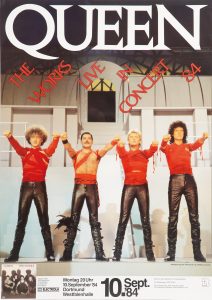
Poster Download LINK 1
“The Nazi thing’s laughable really. People will always find an agenda if they need one. It’s a piece of entertainment, you know, simple as that.” Roger Taylor
Queen The Greatest – Episodes 1-25 – Watch HERE
Celebrating a song that was not only a hit single with an iconic video, but one that also led to one of the band’s most memorable live moments, this week’s Queen The Greatest focuses on the Roger Taylor penned “Radio Ga Ga.”
Inspired by hearing his infant son utter the words ‘radio ka-ka’ to a bad song on the radio, Taylor’s song would go on to provide Queen with one of its biggest hits, reaching No.1. in 19 countries. The song’s success would cement Taylor’s place as one of the band’s primary hit songwriters.
Featured on Queen’s 1984 album, The Works, “Radio Ga Ga” was a perfect example of how the song writing responsibilities within the band had evolved over the first 13 years…
John Deacon: “In the early days, it was Brian and Freddie who really used to write most of the material, but over the last five years, Roger and I have started to contribute more.”
Freddie Mercury: “I think the time has come where we actually, in song writing, we’re actually completely even. Roger will come up with something like “Radio Ga Ga,” and it’s perfect.”
Roger Taylor: “On a Sunday afternoon, my son Felix came in and he’s very young, and he just sort of went ‘ah, Radio Ka Ka’, ‘cos he’s half French. And so, I just thought, ‘that’s quite nice’ you know.
“I sort of put the backing track together and then presented it to Freddie who really loved it.”
The song raced up the British charts, and became a worldwide hit, unsurprisingly attracting a huge amount of radio play. However, ironically given the songs subject matter, it was the video, directed once again by the brilliant David Mallet that caught the imagination of the MTV generation while at the same time receiving some unexpected backlash.
Roger Taylor: “We had a killer video, which we put a lot of work into. And the whole thing just felt good, and it felt of its time, and it felt a bit different. Felt modern, and it was very fresh.”
Inevitably, some members of the British press wanted a reason to dismiss it, and accused Queen of incorporating Fascist imagery – a notion that Roger found more amusing than annoying…
Roger Taylor: “That was so absurd, I mean it was actually meant to be about the film, you know it was meant to sort of mirror Fritz Lang’s ‘Metropolis,’ and the oppressed workers and etcetera. And the Nazi thing’s laughable really. People will always find an agenda if they need one. It’s a piece of entertainment, you know, simple as that.”
If the success of the video and single wasn’t enough, “Radio Ga Ga” had an even bigger impact when it came to the Queen live shows.
Brian May: “One of David Mallet’s great contributions, of course, is when the chorus comes you get a hand clap. It was repeated electronically, on the record, and so it sounds like a double handclap. And Mallet kind of seized upon it and made it a double handclap done by the audience, and it became something so…. Well, I think it became one of the first great proofs of the power of television. The first time we played this, to a non-Queen audience at Live Aid, everybody knew what to do at that point, which is astonishing really, so it has to be the power of the video.”
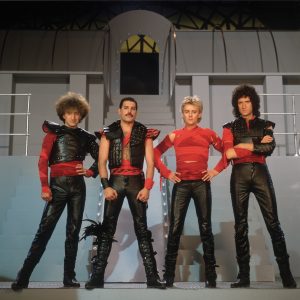
Credit: Photography by Simon Fowler. © Queen Productions Ltd.
Photo Download LINK 2
Episode 26 Embed link:
<iframe width=”560″ height=”315″ src=”https://www.youtube.com/embed/qxLJBajHpYM” title=”YouTube video player” frameborder=”0″ allow=”accelerometer; autoplay; clipboard-write; encrypted-media; gyroscope; picture-in-picture” allowfullscreen></iframe>
Next week – Freddie Mercury “Ay-Oh”
http://www.queenonline.com
Website / YouTube / Instagram / Facebook / Twitter / TikTok
Brian / Roger
Queen The Greatest: a celebration of 50 of the greatest moments from the Queen story so far
A 50-week YouTube series celebrating key moments in Queen’s history reminding us why Queen and their music continue to beloved across the world
Queen The Greatest Episode 25: “Queen On Video”
Having essentially invented the music video with “Bohemian Rhapsody,” Queen went on to create some of the most iconic promos in rock history. Here we celebrate a few of their finest, including a couple that upset the suits at MTV.
WATCH HERE
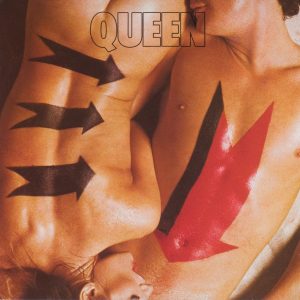
Queen “Body Language” Picture Sleeve – 1982
Credit: © Queen Productions Ltd.
Download link HERE
“Well MTV were very narrow minded. It was Whitesnake, and ****ing Whitesnake, and then another Whitesnake track.” Roger Taylor
Queen The Greatest – Episodes 1-24 – Watch HERE
This week’s Queen The Greatest episode celebrates Queen’s pioneering approach to promo making, which resulted in some truly memorable blockbuster videos, although Queen’s sense of adventurous video making was not always universally embraced…
Having essentially kicked off the era of video promo’s with “Bohemian Rhapsody,” the 1970’s saw some classic videos from Queen, which reflected the band’s ever evolving style.
(Clips: “Somebody To Love,” “We Are The Champions,” “Crazy Little Thing Called Love,” “Bicycle Race”)
But when it came to the 1980’s, the introduction of TV music channels such as the MTV took the art of video making to another level.
Freddie Mercury: “Well things have come a long way, of course, they’re becoming film budgets aren’t they? And the technique and everything is, sort of, improved vastly, so, I mean, you can come up with all kinds of things.
“I remember that in ‘Bohemian Rhapsody’ we wanted these multiple images, and at that time the only way we could only get it was to use a prism. And then we wanted a sort of jagged effect and we had to shake the cameras, somebody had to kick it. Now you have all kinds of things I don’t even know the names for that just do it automatically. It’s beyond me as well, I don’t know what’s going to happen next.”
Naturally, Queen were always at the forefront – whether it be with cutting edge animation, outrageous sets and costumes… (clips: “A Kind of Magic,” “It’s A Hard Life”)
Recreating entire scenes from Hollywood movies… (clip: “Princes of the Universe”)
Or dazzling us with raw power on the back of a fast-moving train… (clip: “Headlong”)
In true Queen style, humor was never far away and the band loved to push the limits – which inadvertently earned them the honor of being the first to have a video banned by MTV with “Body Language,” the erotic undertone bath house scenes deemed unsuitable for audiences in 1982. Surprisingly the cable channel ban did not hamper the track’s chart performance; it went on to become Queen’s fifth biggest US hit single of all time, surprisingly outperforming such better known international hits as “Radio Ga Ga” and “Somebody to Love.”
It was a feat repeated two years later when TV executives failed to get the joke on the brilliant “I Want To Break Free” video in which the band members appeared dressed as female character from the British soap opera Coronation Street. This time the ban impacted on the band’s chance of major US success with the single, the song stalling just inside the Top 50.
Roger Taylor: “Well MTV were very narrow minded. It was Whitesnake, and ****ing Whitesnake, and then another Whitesnake track.
“And they decided they didn’t think that men in drag was ‘rock enough’ I guess, and so they didn’t play the video.”
Throughout their history Queen have always been able to amuse, move, entertain and surprise us with their videos, which has resulted in some of the most enduring and iconic visuals in rock music.
End video: “I’m Going Slightly Mad”
Footnote:
Well known as fans of the band, the Foo Fighters also found themselves fall foul of decency regulators when they used Queen’s “Body Language” in their “Hot Buns” video promoting the 2011 Wasting Light Tour featuring the band members as truckers washing off the grime in a communal shower. A censored version can still be found at YouTube. Verification of age is required to watch the full version.
Alternative picture option:
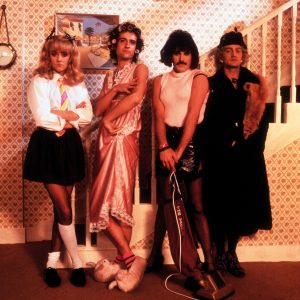
Queen “I Want To Break Free”. 1984.
Credit: Simon Fowler. © Queen Productions Ltd.
Download LINK
Embed link here:
<iframe width=”560″ height=”315″ src=”https://www.youtube.com/embed/CvE4b4ljGBw” title=”YouTube video player” frameborder=”0″ allow=”accelerometer; autoplay; clipboard-write; encrypted-media; gyroscope; picture-in-picture” allowfullscreen></iframe>
Next week: Radio Ga Ga
http://www.queenonline.com
Website / YouTube / Instagram / Facebook / Twitter / TikTok
Brian / Roger
Queen The Greatest: a celebration of 50 of the greatest moments from the Queen story so far
A 50-week YouTube series celebrating key moments in Queen’s history reminding us why Queen and their music continue to beloved across the world
Queen The Greatest Episode 24: “Under Pressure”
Celebrating what is, for many, the greatest collaboration in rock history. The story of how Queen were joined in Montreux, Switzerland, by David Bowie, and a night of fooling around in the recording studio resulted in a number one single.
WATCH HERE
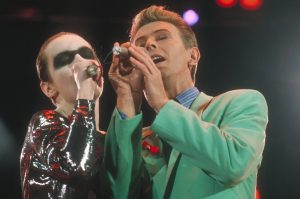
PHOTO LINK HERE
Annie Lennox and David Bowie perform “Under Pressure”
Freddie Mercury Tribute Concert, April 20, 1992
Photography by Neal Preston. © Queen Productions Ltd.
“Well, I think the process was we were all drunk, and in the studio, and were just for fun playing all sorts of old songs, whatever came into our heads. David said, “Look, hang on a minute, why don’t we write one of our own?” –Roger Taylor
“Deacy came up with this riff, ding, ding, ding, de de, ding, ding.” –Brian May
“And then we went for a pizza and he forgot it. Completely escaped his mind!
We got back, and I remembered it.” –Roger Taylor
~
Queen The Greatest – Episodes 1-23 – Watch HERE
Queen The Greatest, this week celebrates one of the biggest collaborations in rock history, Queen and David Bowie’s “Under Pressure.” Brian May and Roger Taylor talk in recent interviews about that momentous night and how that famous riff was almost lost, with additional rarely seen footage of Bowie talking on how he recalled it (“it was peculiar”!).
By 1981, Queen had bought the famous Mountain Studios in Montreux – and it was during one recording session there, that Studio Engineer Dave Richards made an impromptu phone call.
David Bowie: “They were recording there and, David (Richards) knew that I was in town, and phoned me up and asked me if I’d come down, if I’d like to go down and see what was happening. So I went down and these things happen, you know, suddenly you’re writing something together and it was totally spontaneous, it certainly wasn’t planned. It was peculiar!”
Roger Taylor: “Well, I think the process was we were all drunk, and in the studio, and we were just for fun playing all sorts of old songs. I remember a couple of old Cream songs, and whatever came into our heads and I think David said, “look, hang on a minute, why don’t we write one of our own?”
Freddie Mercury: “We were fooling around and then just sort of jamming with tracks and suddenly we said ‘why don’t we just see what we can do on the spur of the moment?’”
Producer Reinhold Mack: “Then there’s the pressure of his majesty, David, being there, and everybody wanted to look suave and quick with ideas and stuff.”
Brian May: “Deacy of course came up with this riff, ding, ding, ding, de de, ding, ding.”
Mack: “Bom, bom, bom, de,de, dah, dah.”
Roger Taylor: “Ding, ding, ding, de de, ding, ding.”
Mack: “He kept playing that over and over and over again.”
Roger Taylor: “And then we went for a pizza and he forgot it! Completely escaped his mind. We got back and I remembered it.”
Brian May: “And of course, we’re used to playing together, and now we have this other guy there, who’s also inputting, inputting, inputting.”
Roger Taylor: “David’s idea to put all these clicks and claps, and then it just, the sort of track grew.”
Brian May: “And by that time David was very impassioned with it and he had a vision in his head I think. It’s quite a difficult process and somebody has to back off, and actually I did back off, which is unusual for me.”
The result of that long night was “Under Pressure,” and when released in October 1981, gave Queen their second UK number 1, and became a massive hit across the globe.
Due to touring commitments, the band were unable to make a promo video – and so director David Mallet captured the essence of the track in a beautifully crafted montage of archive footage.
The song became a permanent feature in subsequent Queen shows, and was one of the stand out moments at The Freddie Mercury Tribute Concert on April 20, 1992 where David Bowie and Annie Lennox joined Roger, Brian and John for a truly spine-tingling performance.
Without doubt one of Queen’s biggest hits, and it was no surprise when readers of Rolling Stone magazine recently voted it as one of the greatest music collaborations of all time.
# # #
EPISODE 24 EMBED LINK
<iframe width=”560″ height=”315″ src=”https://www.youtube.com/embed/DkhfHTphodM” title=”YouTube video player” frameborder=”0″ allow=”accelerometer; autoplay; clipboard-write; encrypted-media; gyroscope; picture-in-picture” allowfullscreen></iframe>
Next week: Queen’s Blockbuster Videos.
http://www.queenonline.com
Website / YouTube / Instagram / Facebook / Twitter / TikTok
Brian / Roger
Queen The Greatest: a celebration of 50 of the greatest moments from the Queen story so far
A 50-week YouTube series celebrating key moments in Queen’s history reminding us why Queen and their music continue to beloved across the world
Queen The Greatest Episode 23: “Queen Rock South America”
Off the back of their tremendous success in North America, Queen are invited to venture into new territory and tour South America. It turns out to be one of their biggest challenges yet – but the response from the vast, enthusiastic crowds is beyond anything they could have imagined.
WATCH HERE
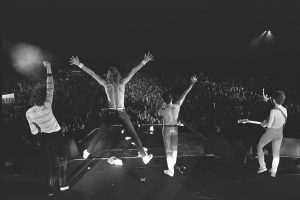
Queen onstage South America 1981.The band performed to an audience of 160,000.
Download Photo LINK
Credit: Photography by Neal Preston. © Queen Productions Ltd.
“hmm, this is, this is going to take some balls to walk out there.” Roger Taylor
Queen The Greatest – Episodes 1-22 – Watch HERE
Freddie Mercury once quipped, “They wouldn’t let us into Russia; they thought we’d corrupt the youth or something…so we went to Latin America. We wanted to play where rock music had never been played before.”
This week’s Queen The Greatest heads back to 1981 and one of the biggest, most ground breaking tours in Queen’s live history: the time they rocked South America, and in doing so forged an enduring bond between the band and an audience that remains one of its most loyal.
Brian May: “South America reared its head, and we heard rumors that we were the biggest thing ever in Argentina and Brazil, and they started to ask us to go down there. And they were saying, ‘you can play football stadiums down there’ and we went ‘oh, you’re joking.’”
Manager Jim Beach: “In those days, under the dictatorship in Argentina, we were negotiating with the Army General, and he said to me ‘how can I possibly allow 50,000 young people into a stadium, when I can’t control them. What happens if somebody suddenly shouts out “Viva Peron” in the middle of a Queen concert, and I have a riot on my hands?
“And I tried to explain to him that, rather like Gladiatorial matches in Rome, this was panacea to the people. They never, ever had this before, this would be an extraordinary experience.”
Brian May: “So, we got the whole thing together and it was God knows how many jumbo jets full of equipment.”
Roger Taylor: “The travel arrangements were very scary, with, you know, driving the wrong way along a raised motorway with outriders, with guys in big jeeps waving their big guns and getting the cars coming straight towards them to pull over.”
Freddie was rather more casual about the experience.
Interviewer: “Fred, how do you feel playing and singing before 200,000 people?”
Freddie Mercury: “Haven’t done it yet.”
Roger Taylor: “I can remember being nervous the first night, the top tier alone took 80,000, and we were in this sort of dug out which, I guess, the football teams would normally be in. All the windows were broken and I remember thinking “hmm, this is, this is going to take some balls to walk out there.”
John Deacon: “All the shows done in Argentina were all at football stadiums, and they were very worried about the pitch getting damaged, because it’s their sort of hallowed ground, the football turf. And we came up with this idea, covering it with plastic grass, and they agreed to it, because that was something we really wanted was to have a lot of people on the pitch.
“We set the stage up down one end. They were quite happy to have people in the stands, but we insisted that we must have people on the pitch as well to give a good atmosphere for the show.
“Oh it was marvelous, it was the closest really to ever actually going to a football match, it was that sort of reaction. They were tremendously enthusiastic, I mean they were quite ecstatic, and they were singing along in English as well, and doing ‘woh, woh, woh, woh’, all the chants and everything.”
Despite the early nervousness, and the huge logistical undertaking, this first South American tour was a massive success, and left a lasting impression on the band and its audience.
Queen would return in 1985 for one of their most memorable performances ever – but that’s a story for another episode of Queen The Greatest.
Next week – “1981 : Under Pressure”
http://www.queenonline.com
Website / YouTube / Instagram / Facebook / Twitter / TikTok
Brian / Roger
Queen The Greatest: a celebration of 50 of the greatest moments from the Queen story so far
A 50-week YouTube series celebrating key moments in Queen’s history reminding us why Queen and their music continue to beloved across the world
Queen The Greatest Episode 22: “Brian May’s Hits”
Celebrating five of Queen’s biggest hits, all written by the band’s iconic lead guitarist Brian May. Including classics such as “I Want It All,” “Save Me” and, of course, “We Will Rock You”
WATCH HERE
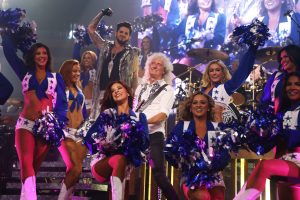 Credit: Photography by Barry Bowden
Credit: Photography by Barry Bowden
Download LINK
Brian May, Adam Lambert.
Queen + Adam Lambert perform “Fat Bottomed Girls” accompanied by Dallas Cowboys cheerleaders.
American Airlines Centre, Dallas, Texas. July 23, 2019
Embed link here:
<iframe width=”560″ height=”315″ src=”https://www.youtube.com/embed/Kanp6HAvCPQ” title=”YouTube video player” frameborder=”0″ allow=”accelerometer; autoplay; clipboard-write; encrypted-media; gyroscope; picture-in-picture” allowfullscreen></iframe>
Queen The Greatest – Episodes 1-21 – Watch HERE
In a week that is set to see Queen legend Brian May make an impressive return to the upper reaches of music charts with his remastered/repackaged original 1992 solo album ‘Back to the Light’, Queen The Greatest this week continues its celebration of some of the biggest Queen songs by highlighting five classic hits provided by the band’s iconic lead guitarist.
Across Queen’s remarkable recording career, May has contributed some of the band’s most anthemic and best loved songs in the Queen rock canon. These include massive tracks such as “Who Wants To Live Forever,” “Flash,” and “The Show Must Go On,” as well as Queen’s first ever single release, “Keep Yourself Alive,” and the song they performed live more than any other, “Now I’m Here.”
Not overlooking of course the live classic, “Tie Your Mother Down.”
This episode focusing on five Queen hits written by Brian gets underway in 1977, with one of the most recognisable songs in rock history ever – it can only be of course, the enduring stomp, stomp sports staple classic “We Will Rock You.”
The following year saw the release of another live favorite, “Fat Bottomed Girls.”
Then in 1980, for the band’s worldwide smash hit album, The Game, Brian contributed the stunningly beautiful, “Save Me.”
By the mid eighties, Queen were regularly playing to massive crowds, thanks to having songs that could take the roof off any stadium –including a highlight from The Works album – “Hammer To Fall.”
And then in 1989, after a three-year wait for a single release, Queen roared back up the UK charts with the mighty “I Want It All.”
A whistle stop tour through five classic Queen songs, written by the incomparable Brian May.
Queen The Greatest has already highlighted the hits of Roger Taylor and John Deacon. Still to come later in the series are the hits originated by Freddie Mercury.
Next week – “1981: Queen Rock South America”
# # #
Queen The Greatest’ Latest Episode and YouTube Playlist Link: HERE
http://www.queenonline.com
Website / YouTube / Instagram / Facebook / Twitter / TikTok
Brian / Roger
Queen The Greatest: a celebration of 50 of the greatest moments from the Queen story so far
A 50-week YouTube series celebrating key moments in Queen’s history reminding us why Queen and their music continue to beloved across the world
Episode 21: “1981: Queen – The Greatest Greatest Hits”
To mark the band’s first decade, Queen’s Greatest Hits was released – packed with 17 of their biggest hits to date. Today it’s still the ultimate playlist, and the biggest selling UK album, ever.
WATCH HERE
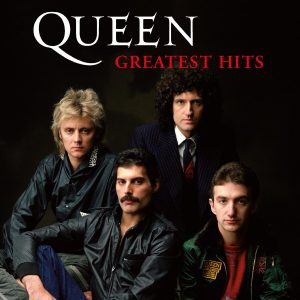
Queen Greatest Hits. The UK’s biggest selling album of all time.
“I have to pinch myself…it’s the ultimate compliment to be sewn into
people’s lives to that extent.” Brian May
Artwork LINK
Credit: Photography by Snowdon. © Queen Productions Ltd.
Embed link here:
<iframe width=”560″ height=”315″ src=”https://www.youtube.com/embed/XX5YC-zVC1A” title=”YouTube video player” frameborder=”0″ allow=”accelerometer; autoplay; clipboard-write; encrypted-media; gyroscope; picture-in-picture” allowfullscreen></iframe>
Queen The Greatest – Episodes 1-20 – Watch HERE
(Friday, August 6, 2021) This year marks some significant milestones for Queen. Not only is it 50 years since the band’s final line-up was completed with John Deacon joining Freddie Mercury, Brian May and Roger Taylor, but it’s also been 40 years since Queen’s Greatest Hits album was released.
Perhaps the most indelible marker of the band’s sustained popularity, in this its Ruby year, the Greatest Hits collection incredibly returned to the top of the UK charts and hit the Top 10 of the Billboard 200 for the first time since its release in 1981.The career-spanning collection also hit No. 1 on Billboard‘s Vinyl Albums chart with the second-largest sales week of 2020 for any vinyl release.
This weeks’ Queen The Greatest, which weekly celebrates Queen’s most outstanding songs, performances and achievements since the band formed in 1971, looks but at what must surely be considered one of Queen’s most historic achievements – continuing to carry the honor of having the UK’s biggest selling album of all time with Queen’s Greatest Hits.
Spanning Queen’s triumphant first act, and released in 1981 – with the now iconic cover photo taken by Lord Snowden – to mark the band’s first decade, Greatest Hits contained no less than 17 hit singles.
Launched with a very modern-for-its -time TV campaign promising “probably the most exciting album you’ve ever heard,” Queen’s Greatest Hits landed at the peak No 1 position of the UK album chart and has resided on the chart for over 956 weeks since.
[Advert Voice Over] “EMI present Queen’s Greatest Hits. 17 of their very best tracks on one album. Tracks like Bohemian Rhapsody and Killer Queen.”
[Advert Voice Over] “Flash, Somebody To Love, and We Will Rock You. Plus Don’t Stop Me Now, Save Me, and many, many more. Probably the most exciting album you’ve ever heard. Queen’s Greatest Hits.”
When it came to choosing the tracks, the album was constructed with the same meticulous care Queen had become famous for on their previous albums.
Brian May: “Every album we ever made, including the Hits albums, we thought ‘yeah, people are going to be putting this on their turntables,’ as it was at the time, ‘and they will be listening to it in sequence.’ And we want to give them a journey, the tracks have to work in sequence.
“It’s amazing that we accrued that kind of catalogue of bona fide hits, most people’s Greatest Hits are like ‘yeah, we’ve got a couple but we’re going to throw a few things in which are kind of, could’ve been hits.’ But this is all gold plated, chart material. So it’s easy, you just put the biggest ones in and that was it.
“And then we went on and we did Greatest Hits 2, and Greatest Hits 3, all of which have done great. And we have the Platinum Collection, which is all three of them together, so it’s done amazingly well. But the Greatest Hits 1 is something very special, and every track you listen to you think ‘ooh, yeah.’”
As the UK’s biggest selling album of all time, Greatest Hits is widely believed to hold a place in one in three UK homes.
Brian May: “It’s amazing, I have to pinch myself. I have to say ‘yes, it is THE biggest album of all time in this country,’ and I never realised it would get to this kind of height. I mean, it’s the ultimate compliment for an artist really to be sewn into people’s lives to that extent.
“So it feels great. And we all feel the same. We had that privilege of actually being triggers in people’s lives which will always be the case as long as this generation, all these generations, are around, that will be the case. So, I feel very proud.”
In testament to their versatility and universal appeal, alternative track listings were created for different territories, reflecting the international popularity of Queen’s varied hits. And incredibly, this has resulted in a total of 25 million sales worldwide.
Queen’s Greatest Hits is one of the Greatest hits in music history, the perfect summary of the band’s first ten years, and probably the greatest playlist of all time.
Next week – Brian May’s Hits
http://www.queenonline.com
Website / YouTube / Instagram / Facebook / Twitter / TikTok
Brian / Roger
Queen The Greatest: a celebration of 50 of the greatest moments from the Queen story so far
A 50-week YouTube series celebrating key moments in Queen’s history reminding us why Queen and their music continue to beloved across the world
Episode 20: “1980: Queen At The Movies – Take 1: Flash Gordon”
An unusual venture sees Queen take on a movie soundtrack, with the band determined that the resulting album should be as musically rewarding as their previous ones. Brian and Roger describe how this exciting project came about and broke new ground.
WATCH HERE
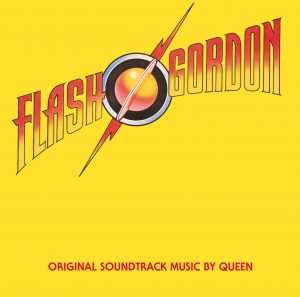
Album artwork LINK
“I think we were quite well ahead of the game there.” Roger Taylor.
“Oh, it’s not going to work for my film.” Dino De Laurentiis, Producer
Queen The Greatest – Episodes 1-19 – HERE
(Friday, July 30, 2021) The Greatest, the journey through the Queen story so far celebrating their biggest songs, performances and achievements, this week looks back at a fascinating new departure for the band.
For what would be the band’s ninth studio album, this would also be a first for them, their first movie soundtrack. It is, of course, Flash Gordon. For a band given to aural spectacular, it seemed a perfect fit although producer Dino De Laurentiis did have his moment of doubt.
In 1980, work on Flash began in tandem with the recording sessions for The Game, but while this would obviously represent something of a departure for the band, they were determined to make it as much a Queen album as their previous ones.
Set against some rare footage of the band live performing “Flash” to image track in London’s Advision Studios, Brian and Roger explain how the project came about.
Roger Taylor: “It was an interesting offer really from (producer) Dino De Laurentiis, and Joe Smith, head of Elektra Records, engineered the whole thing really. And, it was interesting actually, because the film was a big hit in Europe and UK, and flopped completely in America.”
Brian May: “But it became a cult video thing later on. I feel pretty proud of the Flash thing, because really this was the first time that a rock soundtrack had actually been put to a movie which wasn’t about rock music.
“There was a lot of resistance to it, a lot of people said it wouldn’t work, including Dino. When he first heard it he went “oh, it’s not going to work for my film,” the idea of the rock music being in there. But he pretty soon became accustomed to the idea, and he loved it in the end.”
Roger Taylor: “It actually was sort of Brian’s thing really, and it really did forge quite a lot. I mean you never heard heavy rock – a lot of it was quite heavy – music on a film, and so this battle sequence is really quite ground breaking.”
Brian May: “It was, I think, the first.”
Roger Taylor: “And now you can’t see a movie without soundtrack albums coming at you and heavy music.”
Brian May: “And heavy guitars.”
Roger Taylor: “So I think we were quite well ahead of the game there.”
As The Game album started to take up more of the band’s time, Brian took on the responsibility of getting the soundtrack over the line. The title track, “Flash,” would be the only single released, but the album is crammed full of classic Queen tunes – not least “The Hero,” which became a stellar opening to the live show….as can be seen in this band performance in Milton Keynes, UK, June 5 1982.
Understandably, this project begged the question at the time as to whether Queen would consider doing another movie soundtrack…
Roger Taylor said at the time: “This film thing was very interesting, and if somebody comes up with a really fascinating offer for another film, perhaps we might think about that. But, no, we’re a rock and roll band, think we always will be.”
Queen did of course make a return to scoring with their second soundtrack six years later, for another science-fiction fantasy, the hugely successful Highlander.
More of that later.
Embed link:
<iframe width=”560″ height=”315″ src=”https://www.youtube.com/embed/It0zsr9SSok” title=”YouTube video player” frameborder=”0″ allow=”accelerometer; autoplay; clipboard-write; encrypted-media; gyroscope; picture-in-picture” allowfullscreen></iframe>
# # #
Next week – “Queen: The Greatest Greatest Hits”
Queen The Greatest: a celebration of 50 of the greatest moments from the Queen story so far
A 50-week YouTube series celebrating key moments in Queen’s history reminding us why Queen and their music continue to beloved across the world
Episode 19: “Queen: Another One Bites The Dust – Top of the World”
Queen kick off the 1980’s in style with what would become their biggest selling single ever.
But in true Queen fashion, it was a song unlike any of their others, coming from an unlikely source, and representing another massive gamble.
“I mean, funk wasn’t really in the vocabulary.” Producer (Reinhold) Mack.
WATCH HERE
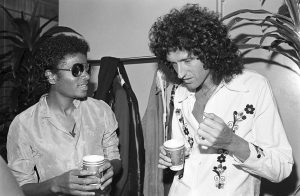
Michael Jackson visits Queen backstage at The Forum, Los Angeles, July 1980. Here with Brian May
Photo Download LINK
Credit: Neal Preston. © Queen Productions Ltd.
Embed link here:
<iframe width=”560″ height=”315″ src=”https://www.youtube.com/embed/D4BlBAP-TLY” title=”YouTube video player” frameborder=”0″ allow=”accelerometer; autoplay; clipboard-write; encrypted-media; gyroscope; picture-in-picture” allowfullscreen></iframe>
Queen The Greatest – Episodes 1-18 – Watch HERE
(Friday, July 23, 2021) In 1980, Queen began their second decade together with one of their biggest ever hits. And in true Queen fashion it was with a style previously unfamiliar to their fans, and originated from an unlikely source – bassist John Deacon, once again demonstrating his uncanny ability to write a monster hit.
At the time, however, the band’s faith in the song took a while to emerge…helped along the way by some persuasion from one of music’s biggest stars of the time, Michael Jackson.
The song at the center of some internal dissent within the group – one that would go on to provide Queen with their biggest selling single until today: “Another One Bites The Dust.”
John Deacon: “I’d always wanted to do something a little bit more, that was more disco, which was very uncool at the time.”
Producer (Reinhold) Mack: “I mean funk wasn’t really in the vocabulary.”
Brian May: “John was pulling us strongly in that direction, a sort of funky direction, and John got Roger to play with tape all over his drums, which is exactly what Roger hated. Roger hated his drums being made to sound dead.”
Roger Taylor: “I didn’t really want to get into dance music. Wasn’t my thing.”
Brian May: “Freddie got deeply into it. Freddie sang it until he bled, ‘cos he was so committed to making it sound the way John wanted it, which was like hard core… I don’t what you would call it…but more towards black music than white music.”
Roger Taylor: “Michael (Jackson) came to several shows I think at the Forum in LA, and he loved Freddie. And he kept saying ‘you guys, you got to put that song out.’ And I wasn’t particularly enamored with it, so I said ‘no, you’re kidding, that’s never a single.’”
By this time, Queen had become masters at never shying away from a risk, so it was released and ultimately sold a staggering 7 million copies to become their biggest-ever selling single.
Adopted as an anthem of triumph and continually played at sporting arenas – particularly boxing matches – the track gave the group their second US #1, remaining in the Hot 100 for 31 weeks and earning a Grammy nomination.
As Brian recalls, it meant the band began the 80’s in a position that ten years previously, they could only dream about….
Brian May: “We kind of became the biggest group in the world, at that moment. You know it’s a fleeting moment because someone else will come and take over, but for that moment, we kind of owned the world.”
“Another One Bites The Dust” naturally featured on the band’s Greatest Hits album, released a year later, but interestingly enough was also on their Greatest Hits 3 album, thanks to a 1998 top ten remix featuring Wyclef Jean.
And then again in 2006, another remix called Queen vs. The Miami Project, reintroduced the song to yet another new generation of fans.
The popularity of this classic shows no sign of dimming, as evidenced in May this year when it passed the incredible milestone of 1 billion streams on Spotify.
But for many, the memory of Freddie, Roger, Brian and John letting loose on stage is where the song is really at its scintillating best…
Photo LINK

Credit: Neal Preston. © Queen Productions Ltd.
Queen The Greatest Latest Episode and YouTube Playlist Link: HERE
Next week: “Queen At The Movies – Take 1 : Flash Gordon”
http://www.queenonline.com
Website / YouTube / Instagram / Facebook / Twitter / TikTok
Brian / Roger
Queen The Greatest: a celebration of 50 of the greatest moments from the Queen story so far
A 50-week YouTube series celebrating key moments in Queen’s history reminding us why Queen and their music continue to beloved across the world
Episode 18: “Queen: 1979 – Cracking America: Crazy Little Thing Called Love”
As the 70s drew to a close, a change of scenery and a song written in ten minutes by Freddie in the bath finally delivered Queen the elusive number 1 slot across the board in America.
Watch HERE
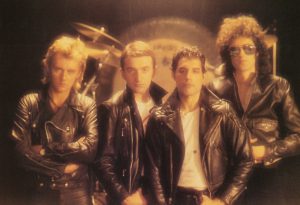 Photo LINK
Photo LINK
“Fred did write the song in the bath in about ten minutes.” Roger Taylor
“Freddie’s tribute to Elvis.” Brian May
Embed link here:
<iframe width=”560″ height=”315″ src=”https://www.youtube.com/embed/C7oZ4lGmdxw” title=”YouTube video player” frameborder=”0″ allow=”accelerometer; autoplay; clipboard-write; encrypted-media; gyroscope; picture-in-picture” allowfullscreen></iframe>
Queen The Greatest – Episodes 1-17 – Watch HERE
(Friday, July 16, 2021) This week’s Queen The Greatest, a journey through some of Queen’s most extraordinary songs, performances and achievements, celebrates what is perhaps one of Queen’s simplest recordings, but without question one of their most remarkable hits… “Crazy Little Thing Called Love,” Freddie’s tribute to Elvis.
By 1979, and after seven albums, Queen’s band members felt that in order to stay fresh and feel challenged it was time to change the way they approached their studio recordings. It was to be the start of an enduring relationship with German producer (Reinhold) Mack and Freddie’s fascination with the city of Munich where he would end up living between 1979 and 1985 and where he would stage his now famous Henderson’s 39th birthday party.
Brian May: “We’d heard that there was this great studio called Musicland in Munich, and we heard there’s this great engineer called Mack, and we got into this rather, kind of indulgent way of just bowling into the studio with no ideas, or very few ideas, and just doing it from scratch. You know ‘what you got?’ ‘Well I dunno, I’ve got this?’”
Roger Taylor: “The first thing we did was ‘Crazy Little Thing,’ and Fred did write the song in the bath in about ten minutes.”
Brian May: “It’s Freddie’s tribute to Elvis, in a way, he was very fond of Elvis, and of Cliff I have to say, also. Yeah, Freddie wrote it very quickly and rushed in and put it down with the boys. By the time I got there it was almost done. And I think the sounds that Mack managed to get, these very elemental, real, very real sounds, ambient sounds in the studio had a big contribution to make. It does sound very authentic, everything about it is sort of like original rock and roll sounding.
“That was the first number one across the board in America, Billboard, Cashbox and Record World I think.”
Roger Taylor: “We were still making the record, we hadn’t even nearly finished the album, and we were going out in Munich, and somebody came up and said ‘oh it’s gone to number one in America,’ and we were going ‘yeah! More drinks!’”
As well as topping the US charts, the song also held the top spot in Australia for a staggering seven weeks, and reached number 2 in the UK.
Freddie often jokingly referred to the simplicity of the song being due to the fact he only knew how to play three chords, and while he played the acoustic guitar on the studio recording, Brian switched his famous Red Special for a Fender guitar to secure that authentic rockabilly style.
As well as being a smash hit on the charts, it also became a raucous staple of the live show. Not least because it gave the band an opportunity to let loose – a sentiment shared by every crowd and evident here, in this rare clip from the Friday concert at London’s Wembley Stadium in 1986…
Next week: “1980: Another One Bites The Dust”
# # #
http://www.queenonline.com
Website / YouTube / Instagram / Facebook / Twitter / TikTok
Brian / Roger
Queen The Greatest: a celebration of 50 of the greatest moments from the Queen story so far.
A 50-week YouTube series celebrating key moments in Queen’s history reminding us why Queen and their music continue to beloved across the world.
Episode 17: “Queen – Independence Day”
After seven years together, Queen’s dream of creative and financial independence would finally come true. A look behind the scenes at that pivotal moment, featuring archive footage of Freddie, John and Roger, as well as a rare interview with the band’s long term manager, Jim Beach.
Watch HERE
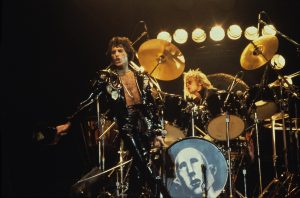
Photo LINK
Credit: Photography by Neal Preston. © Queen Productions Ltd.
“There’s a million sharks out there.” Roger Taylor
Embed link here:
<iframe width=”560″ height=”315″ src=”https://www.youtube.com/embed/lXVwkQysEkc” title=”YouTube video player” frameborder=”0″ allow=”accelerometer; autoplay; clipboard-write; encrypted-media; gyroscope; picture-in-picture” allowfullscreen></iframe>
Queen The Greatest – Episodes 1-16 – Watch HERE
(Friday, July 9, 2021) This week’s Queen The Greatest takes a look behind the scenes at one of the most significant moments in Queen’s history – the moment where one of their ultimate goals was realized – Queen’s Independence Day.
Last week’s episode focused on bassist John Deacon and the hits he provided for Queen. Deacon again features prominently in this week’s episode in which the band reveal the dire straits they were in even after three hit albums, and how John’s steady hand and acumen brought Queen to one of the most significant points in its career – the moment they finally achieved their goal of financial and creative independence.
John reveals: “We didn’t get a penny of record royalties from the first three albums. What we were looking at in that point in time was basically to just look after ourselves and do it completely on our own.”
Roger Taylor: “It’s the long road to artistic, financial freedom which is so hard to find if you’re successful to any degree ‘cos there’s a million sharks out there.”
In early 1978, just before they embarked on recording their Jazz album, Queen finally took full control of their business affairs – setting up three entities to operate and manage their creative endeavors: Queen Productions Limited, Queen Music Limited and Queen Films Limited. This was at the time a highly unusual move for a band, but testament to their belief in their forward musical journey.
For the day-to-day running of the business, Queen turned to Jim Beach, who they had first met in 1975 when the band’s quest for financial independence truly began. It was a meeting that left a lasting impression on Jim…
He recalls that first meeting: “I first met Queen when I was a solicitor at Harbottle and Lewis in London. I was a partner, and I was running what was then a very fledgling music department. It was a show-business firm, and we were used to fairly bizarre clients, but I remember when Queen arrived, the receptionist telephoned me and said, ‘Mr. Beach, Queen are here,’ and I said. Yes, fine, would you like to send them up. And she whispered down the phone, she said, ‘have you seen them?’
“And I said, well yes, she said, ‘well one of them’s got nail varnish on.’ And I said, well really? ‘Yes, black nail varnish.’ And I said, well fine, ‘yes, but it’s only on one hand.’ And I said, don’t be silly, come on, send them up. I always remember Freddie walked in first, they sat down, and Freddie kicked straight off by saying, ‘we’ve recorded three albums, our manager’s just bought his second Rolls Royce, and we’re on sixty quid a week, so something’s wrong.’”
But it wasn’t just the business side where Queen wanted to be masters of their own destiny; their News of The World album had proved that in the studio, they were also ready to take full control.
John Deacon: “It comes to a stage where all you really need is an engineer, because the idea of balancing and sounds you want, an artist or musician should really know what they want. And the only person needed to implement that is an engineer. And when you’re doing a mix, when you’re mixing down the track from the tapes, I mean it’s setting it up and then we actually sit down and work the controls as well.”
On that occasion, long-time Queen Engineer Mike Stone had become the invaluable assistant that enabled the band to enjoy the creative freedom they craved in the studio.
This independence had been hard fought for, and after seven years together, when most bands might be coming to their natural end, Queen had finally successfully maneuvered themselves into a position where they could go from strength to strength.
And it’s fair to say, the best was yet to come…
Jim Beach continues to manage Queen.
Photo:

LINK
Credit: Photography by Neal Preston. © Queen Productions Ltd.
‘Queen The Greatest’ Latest Episode and YouTube Playlist Link:
http://Queen.lnk.to/TheGreatest
Next week: “1979 – Cracking America: Crazy Little Thing Called Love”
Queen The Greatest: a celebration of 50 of the greatest moments from the Queen story so far.
A 50-week YouTube series celebrating key moments in Queen’s history reminding us why Queen and their music continue to beloved across the world.
Episode 16: “Queen: Behind The Hits – John Deacon”
This week, we look at five iconic hits brought to the band by brilliant bassist, John Deacon
WATCH HERE
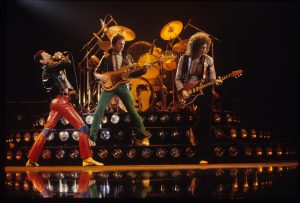
‘Cool cat’ John Deacon (center)
“Another One Bites The Dust”… over a billion streams on Spotify
Download photo: LINK
Credit: Photography by Neal Preston. © Queen Productions Ltd
Episode 16 Embed link here:
<iframe width=”560″ height=”315″ src=”https://www.youtube.com/embed/UMlUcKu7MZ8” title=”YouTube video player” frameborder=”0″ allow=”accelerometer; autoplay; clipboard-write; encrypted-media; gyroscope; picture-in-picture” allowfullscreen></iframe>
Queen The Greatest – Episodes 1-15 – Watch HERE
(Friday, July 2, 2021) While collectively Queen has accounted for many of the biggest hits of all time, it has not always been apparent who wrote each of those million selling songs.
Previously having shone the light on drummer Roger Taylor’s songwriting achievements, this week’s Queen The Greatest turns its focus to the man behind some of their biggest hits and one of the coolest basslines ever.
This week’s episode highlights five classic hits that all came from Queen’s phenomenal bass player, John Deacon, and his contribution to some of Queen’s most iconic moments – not least the instantly recognizable killer bass hook from the collaboration between Queen and David Bowie, “Under Pressure.”
While John may not have written as many songs as his fellow band mates, he is nevertheless responsible for some of the band’s biggest hits, as the journey through them in this episode makes evident.
It wasn’t until Queen’s third album, Sheer Heart Attack, that saw John first get in on the songwriting credits where his composition, “Misfire,” appeared. The band’s next album, 1975’s A Night At The Opera would see John get his first composition released as a single – one that would go on to sell over a million copies in the US alone – “You’re My Best Friend.”
1977 saw the release of fan favorite, “Spread Your Wings.”
…then in 1980, Queen released “Another One Bites The Dust.”
With over 7 million copies sold, not to mention over a billion streams on Spotify, this global hit by John is the band’s biggest selling single and earned John the No 2 position in a Music Radar poll of the coolest basslines ever (the same poll saw “Under Pressure” assign him also the No.7 position).
More chart-topping success followed in 1984 with “I Want To Break Free,” which also resulted in a now legendary, and in some quarters, contentious, video…revisited here.
And then for the A Kind Of Magic album, John teamed up with Freddie to create “Friends Will Be Friends” released as the band’s 30th single in the UK in June 1986 and featured live throughout the band’s final 1986 The Magic Tour.
Five classic Queen songs, written by the brilliant and very cool John Deacon.
Still to come later in the series are the hits originated by Freddie and Brian.
Queen The Greatest’ Latest Episode and YouTube Playlist Link:
http://Queen.lnk.to/TheGreatest
Next week: “Independence Day” (Queen’s ambition of financial and creative freedom finally comes true).
http://www.queenonline.com
Website / YouTube / Instagram / Facebook / Twitter / TikTok
Brian / Roger
“Queen The Greatest”: a celebration of 50 of the greatest moments from the Queen story so far.
A 50-week YouTube series celebrating key moments in Queen’s history reminding us why Queen and their music continue to beloved across the world.
~
Episode 15: Queen In Japan – Queenmania (Part 2)
Continuing our celebration of Queen’s enduring relationship with Japan – highlighted by a smash hit album release in 2004 and an extraordinary festival performance ten years later.
Queen Jewels, the 2004 album, released only in Japan, sold over million copies.
Watch HERE
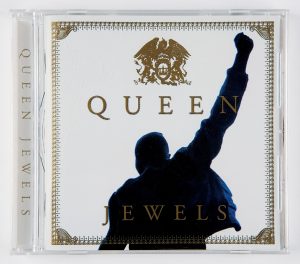
Album Artwork LINK
Queen The Greatest – Episodes 1-14 – Watch HERE
(Friday, June 25, 2021) This week’s episode of Queen The Greatest continues the celebration of the extraordinary relationship between Queen and Japan.
The bond between Japan and Queen had been firmly established through the band’s tours of the 1970’s and 80’s. It would not be until 2005 the band would return, first with Paul Rodgers and then again in 2014 now fronted by Adam Lambert.
Despite their absence on the touring circuit Queen’s music continued to be treasured in Japan throughout the 90’s and into the 21st Century, thanks largely to their inclusion in TV commercials and television dramas, particularly one of Japan’s biggest drama series which prompted the release of a special ‘hits’ compilation album, exclusive to Japan – Queen Jewels. The album went on to sell over a million copies. Featured in a beer commercial, the band’s “I Was Born To Love You” reached No. 1 on the singles charts.
Invited to return in 2014 to headline at Japan’s largest rock festival, Summer Sonic, Queen’s stature as Japan’s favorite foreign band was confirmed. Footage from that Summer Sonic appearance highlights Queen and Lambert’s performance of Japanese favorite “I Was Born To Love You.”
Says Kaz Utsunomiya, Promoter and long-term friend of Queen: “Summer Sonic is like Glastonbury or one of the biggest summer music festival outdoor shows, and we played Osaka and Tokyo. I’ve seen many, many Summer Sonic festivals but I think I can say that everyone who I talk to, including fans and record company people, that was probably the biggest ending act of any Summer Sonic for twenty years or something.”
Japan is now once again a regular feature on the Queen touring schedule, the band having returned as recently as 2020 to perform four massive sold out arena shows playing to a combined audience of over 132,000 people across the country signalling that this mutual love affair is still going strong…
Kaz Utsunomiya: “Even if the Japanese fan loved them, if the band didn’t actually return that kind of love, they wouldn’t have got this big. And I think it’s a mutual respect of the culture, mutual respect of the people, that’s bonded by the greatest songs.”
The episode plays out with Brian May addressing the crowd: “This is specially for you. And if you want to sing that would be wonderful,” leading into a mass audience sing along of one of Queen’s most loved songs in Japan, “Teo Torriatte” (Let Us Cling Together), the song written by May especially for the band’s Japanese fans and including Japanese lyrics and sung here by Brian in Japanese. From the joy on the faces of the audience it is evident that the bond between Queen and Japan continues to remain as strong as ever.
Queen The Greatest’ Latest Episode and YouTube Playlist Link:
http://Queen.lnk.to/TheGreatest
Next Week: John’s Hits.
http://www.queenonline.com
Website / YouTube / Instagram / Facebook / Twitter / TikTok
Brian / Roger
Queen The Greatest: a celebration of 50 of the greatest moments from the Queen story so far.
A 50-week YouTube series celebrating key moments in Queen’s history reminding us why Queen and their music continue to be loved across the world.
~
Episode 14: Queen in Japan (Part 1) – Queenmania
A look at Queen’s long-lasting relationship with Japan which started when the band were overwhelmed by the extraordinary welcome at the airport when they arrived for their first tour in 1975.
Watch HERE
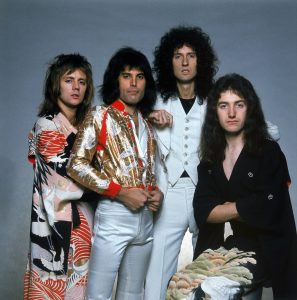
Photo Link
Credit: Terry O’Neill
“Teo Torriatte”
Let us cling together as the years go by
(Friday, June 18, 2021) Queen The Greatest, which celebrates some of Queen’s most memorable songs, performances and achievements this week takes a look at the extraordinary story of Queen in Japan.
In the early years, Queen understandably worked hard to make headway in the UK and USA markets. However, there was another country that had already started to take the band to their hearts, signalling the beginning of a deep bond that endures to this very day.
As early as 1974, in Japan, Music Life Magazine had started to feature pictures of the band and report on their albums. The style of music and stage show struck an immediate chord, and so in April 1975, Queen embarked on an eight-night tour of Japan. Their very first concert on Japanese soil would be at the world-famous Nippon Budokan in Tokyo, an arena dedicated to martial arts and concerts, and it’s fair to say the band had no idea what was in store for them…
Roger Taylor: “We knew there was sort of demand for us there and so we tagged it on to the end of an American tour. We had a holiday in Hawaii and then it was, sort of, logical, so we went there. We arrived at the airport and suddenly realised it was on a scale different to that which we’d imagined – there were thousands of people there, just to welcome us. Normally you just don’t get that sort of thing anywhere.”
In an exclusive interview, record company exec, promoter and long-term friend of Queen, Kaz Utsunomiya, recalls that extraordinary arrival…
Kaz Utsunomiya: “I don’t think anyone really guessed that three thousand people would turn up at the airport. Anyone who turned up at the airport would think that this is like, the second coming of the Beatles.”
Kaz explains how the Japan Queen phenomenon had its beginnings: “In those days the rock group band was mainly supported by the male audience, but then the fact that Music Life (magazine) put in Queen pictures opened up a whole new world with female fans, and caught Japanese fans in both genders, male and female.”
This first encounter marked the beginning of a deep bond between Queen and Japan, with each leaving a lasting impression on the other. So much so, it inspired Brian May to write a song as a special tribute to their Japanese audience with the song “Teo Torriatte,” featured on the band’s 1976 A Day At The Races album containing two choruses sung in Japanese.
Kaz Utsunomiya: “They never expected the band to come up with a song like ‘Teo Torriatte,’ which is mainly for the Japanese market. The band has different songs for all over the world, but I think ‘Teo Torriatte’ you can only listen to them doing that in Japan.”
Queen would regularly tour Japan right up until 1985, but as Kaz explains, the band always embraced a unique approach to where they performed.
Kaz Utsunomiya: “In the early days we toured different cities all over Japan. So, we’d go to Sapporo in Hokkaido which is in the northern part of Japan, and we would go to Sendai in southern part, and it was really interesting because not that many bands used to tour all round Japan.
“A lot of international bands come to Japan, they go to Tokyo and Osaka. A lot of people never had the chance of seeing the international bands in the cities outside of Tokyo and Osaka, which they (Queen) did, and which made them bigger and a very unique international act in Japan. I think that also helped the band understand the Japanese culture, Japanese history, and the Japanese fans.”
The next Queen The Greatest, will continue the celebration of Queen in Japan, and the album release that ensured this mutual appreciation continues to this very day.
Queen The Greatest – Episodes 1-13 and YouTube Playlist Link:
http://Queen.lnk.to/TheGreatest
Next week: Queen in Japan (Part 2)
“Queen The Greatest”: a celebration of 50 of the greatest moments from the Queen story so far.
A 50-week YouTube series celebrating key moments in Queen’s history reminding us why Queen and their music continue to be loved across the world.
~
Episode 13: “Queen: 1977 We Are The Champions – The Show Stopper”
“I mean, where’s the modesty gone?”
The world’s catchiest song..
or
“The most egotistical and arrogant song ever written”?
WATCH HERE
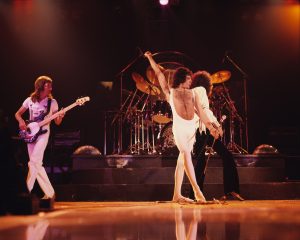
Download image HERE
Credit: 1977 NOTW USA tour. Photo Neal Preston © Queen Productions Ltd.
Queen The Greatest Latest Episodes 1-12 Link Below:
http://Queen.lnk.to/TheGreatest
(Friday, June 11, 2021) Last week’s Queen The Greatest looked at the cultural phenomenon that is “We Will Rock You,” and so it goes without saying that the only song to follow that with this week is its companion piece, “We Are The Champions.”
This 1977 Freddie Mercury composition, which can be seen being recorded here in fascinating archive footage, is widely regarded as one of the greatest rock anthems ever written, holds a place in the Grammy Hall of Fame, and in 2011 was identified by a team of scientific researchers at London’s Goldsmiths University as “the catchiest song ever written.”
But despite going on to become one of the most instantly recognized songs in pop history, the track did not get off to an auspicious start with media challenging the band, and Freddie in particular, for a lack of “modesty” in coming up with such an arrogantly titled song.
[Interviewer] “And only Queen could come up with the title, “We Are The Champions.” I mean, where’s the modesty gone?”
Roger and Freddie rose to the moment in characteristic style:
Roger Taylor: “Well there isn’t any. No modesty whatsoever. After the slagging off we get from the English music press, I mean who cares? We’ve got nothing to lose now.”
Freddie Mercury: “Oh, I’m a cold, heartless bugger. No, it has absolutely nothing. It’s just pure commercial, call it what you like. It’s the most egotistical and arrogant song I’ve ever written.”
Brian May sets out to explain:
Brian May: “I think we were all just mildly shocked, ‘cos it sounded so, kind of, arrogant. But of course, it only takes a moment’s thought to realize that “We Are The Champions” doesn’t just mean me, and my pals, it means all of us.
“But, you know, it came from him and there was a kind of delicious arrogance to Freddie, and I think, if I’m truthful, I think, you know, the very first meaning of it probably was that we were, you know, damn right. We were dragged through all kinds of hell by people, but we emerged victorious.”
Freddie Mercury: “Basically it is a participation thing. I’m just thinking in terms of how we, maybe, we’re going to adapt it on stage and how people are going to… It’s a public, public stroke group thing really.”
And that’s what it quickly became, the perfect finale to every Queen show from 1977 onwards, a unifying, celebratory moment that the band and fans could share.
As Queen moved into stadium rock in the 1980s, songs like “We Are The Champions” were the perfect fit, and it was understandable it would be adopted by sports fans and chanted at venues all over the world, securing the song its legendary status.
As a symbol of unity and togetherness, the song resonated once again in a way perhaps even Freddie wouldn’t have dared imagine when in 2020, at the peak of the global pandemic, it provided a fitting tribute to frontline workers through a new version featuring Queen + Adam Lambert retitled “You Are The Champions.”
Next week: Queen In Japan (Part 1)
http://www.queenonline.com
Website / YouTube / Instagram / Facebook / Twitter / TikTok
Brian / Roger
“Queen The Greatest”: a celebration of 50 of the greatest moments from the Queen story so far.
A 50-week YouTube series celebrating key moments in Queen’s history reminding us why Queen and their music continue to be loved across the world
~
Episode 12: “Queen: 1977 We Will Rock You (Part 2) – Rocking the World”
“Thump, thump, clap…”
“Thump, thump clap…”
WATCH HERE
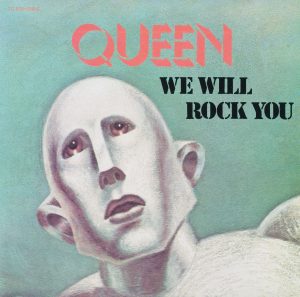
Artwork image:
Link: CLICK HERE // Photo credit: © Queen Productions Ltd.
Queen The Greatest Latest Episodes and YouTube Playlist Link:
http://Queen.lnk.to/TheGreatest
(June 4, 2021) Continuing the celebration of one of Queen’s most instantly identified songs, this week’s episode of Queen The Greatest, returns to Brian May speaking exclusively for the series about Queen’s stadium rouser “We Will Rock You” and how he achieved that rule breaking guitar solo.
With its instantly recognizable rhythm and lyrics, it’s no surprise the song has become one of the band’s most lasting anthems and deservedly earned a place in the Grammy Hall of Fame. In this special interview for the Queen The Greatest weekly YouTube series, Brian shares a few more insights about the fascinating evolution of this classic and secrets of the track’s iconic guitar solo.
“I wanted the song to be non-standard, I wanted it to be exceptional in every way. So, I wanted to break all the rules and normally the guitar solo comes in the middle, and then you get back and have the last verse and wind the thing up. I didn’t want that; I wanted the whole song to be there and then comes the guitar solo out of nowhere.
“I could hear something in my head, but I wasn’t really sure what it was. And in my memory, I think I went there only once, I did just one take.
“I just fished around, I could feel something inside and I didn’t really know what it was, I was just playing along to the feel of what was coming through my headphones. So, I went back in and listened to it, and the bit that I really liked was something I’d stumbled on by accident. That one little riff stuck in my head, and I thought that’s the way to end the song. So, we copied the tape, we snipped it out, put three versions of that together, and that’s what you hear at the end of the track. I didn’t actually play it three times, I just played it the once and we duplicated it and put it on with sticky tape. That’s what you are hearing.”
Revealed in this exclusive interview, budding Brian May guitar aspirants can learn more of how Brian achieved one of the world’s most recognized and distinctive solos of all time.
“The thing I suppose I am most proud of is the fact the song has become part of public life, so when everyone goes thump, thump, clap, in any form whatsoever, that’s what it is. The greatest compliment is when people think nobody wrote it, they just think it has always been there. So “We Will Rock You” has become like, I don’t know, something which is traditional and goes back to the Stone Age. And that makes me happy.
“And it brings joy, it brings people together and that’s probably the best thing of all because “We Will Rock You” and “We Are The Champions” were conceived in that way, in the sense to try and bring people together, and every time I hear this happening at a football match or a sports fixture anywhere around the world I think ‘yeah, it kinda worked. It brings people together; it makes people feel like they have some kind of power by coming together.’ That’s a good feeling for humanity, I think, togetherness is a great thing.”
Next week : Queen 1977 We Are The Champions – The Show Stopper
Artwork:

Link: CLICK HERE // Photo credit: © Queen Productions Ltd.
http://www.queenonline.com
Website / YouTube / Instagram / Facebook / Twitter / TikTok
Brian / Roger
Queen Greatest Hits To Be Re-Released In New Formats July 2
Marking Queen’s 50th Anniversary Year
And 40 Years Since Original Release

Collector’s Edition CD With Exclusive Slipcase Cover & Cassette
Available To Pre-Order HERE
Hi-res photos available to download HERE
Artwork for Global formats available to download HERE
Artwork for all Queen Online Store exclusive formats available to download HERE
(May 28, 2021) Hitting a jaw-dropping 439 weeks, and counting, on the Billboard 200 – currently sitting at #21 on the prestigious US chart – and already wearing the crown as the UK’s biggest selling album of all time, achieving the third longest chart run on the UK Official Charts, Queen’s 1981 Greatest Hits collection is getting a limited edition makeover to mark not only the band’s historic 50th landmark, but also the album’s 40th anniversary.
First released in 1981, Greatest Hits is certified 9x Platinum in the U.S. and stands alone as the first and only album to have sold over 6 million copies in the UK (6.75 million sales to date), has now spent over 900 weeks on the UK Albums Chart, and has been certified a staggering 22× platinum with global sales in excess of 25 million.
And there’s more…according to the Official Charts Company who crowned it ‘Britain’s most popular album of the past 60 years,’ one in four British households already own a copy of the album.
Now, following the record-breaking global success of Queen’s Bohemian Rhapsody feature film – earning almost $1billion at the international box office – a new generation of faithful Queen followers has emerged ensuring that Queen’s undiminishing appeal will continue well beyond their current record-breaking achievements.
These historic landmarks are now to be marked and celebrated with a brand new collector’s edition Greatest Hits CD with exclusive slipcase cover and a limited edition cassette format, both to be released globally July 2.
In addition, the Official Queen Online Store will exclusively offer the collector’s edition Greatest Hits CD and four highly limited band member color cassettes. This version of the Slipcase CD encases a CD-sized print personally signed by band members Brian May and Roger Taylor (limited to 1000 copies only).
All formats available to pre-order HERE
Global Formats
- Collector’s Edition Greatest Hits CD With Exclusive Slipcase Cover
- Collector’s Edition Clear Cassette
Artwork for Global formats available to download HERE.
Queen Online Store Exclusive Formats
- Collector’s Edition CD With Exclusive Slipcase Cover signed by Brian May and Roger Taylor, bundled with all 4 band member colour cassettes and a Greatest Hits gold plated badge (limited to 1000 signed copies)
- Collector’s Edition Frosted Aqua Cassette – Freddie Mercury Cover
- Collector’s Edition Transparent Pink Cassette – Brian May Cover
- Collector’s Edition Transparent Green Cassette – Roger Taylor Cover
- Collector’s Edition Transparent Blue Cassette – John Deacon Cover
Artwork for all Queen Online Store exclusive formats available to download HERE.
Queen Greatest Hits
Spanning Queen’s triumphant first act, from 1974 to 1980, Greatest Hits includes some of the world’s most icon rock songs, including the stadium-sized symphonic chart-topper “Bohemian Rhapsody” and the roof-raising “We Are The Champions,” which was named the most catchy song of all time by a team of scientists in 2011. The album also dazzles with its stylistically diverse range, from the crowd rousing “We Will Rock You,” the tongue in cheek “Fat Bottomed Girls,” the stomp-stomp-stomp late 70’s disco inspired “Another One Bites the Dust,” to the finger-snapping jukebox retro-rock homage “Crazy Little Thing Called Love” and gospel-fired Aretha-isms of “Somebody To Love.”
http://www.queenonline.com
Website / YouTube / Instagram / Facebook / Twitter / TikTok
Brian / Roger
“Queen The Greatest”: a celebration of 50 of the greatest moments from the Queen story so far.
A 50-week YouTube series celebrating key moments in Queen’s history reminding us why Queen and their music continue to be loved across the world.
Episode 11: “Queen : 1977 We Will Rock You (Part 1) – Rocking the World”
An exclusive interview with Brian May revealing the inspiration behind not just one of Queen’s greatest hits, but one of the most recognizable and loved songs in the history of rock music.
Watch HERE
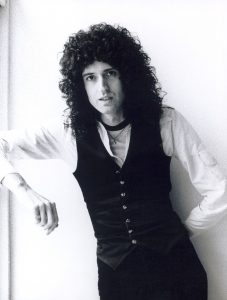
Brian May. 1977.
“when we’re all young, and full of enthusiasm, we think we can change the world”
Photo: LINK
Credit: Chris Hopper / © Queen Productions Ltd.
Click HERE for Queen The Greatest – Episodes 1-10
(May 28, 2021) “Queen The Greatest,” a year-long Queen Official YouTube celebration of the most extraordinary songs, performances and achievements from Queen’s story so far, this week revisits a song that would become not just one of Queen’s greatest hits, but also one of the most recognizable tracks in rock history, “We Will Rock You.”
In an exclusive and brand-new interview with Brian May, the legendary guitarist and songwriter shares how this iconic song written for the band’s 1977 News Of The World album came to life, the specific gig that inspired its creation, and what it has come to mean to him.
“Bingley Hall. This great hall in the Midlands. It was heaving. It’s all sweaty and hot, the atmosphere is great. Everybody’s jumping up and down, making a noise, and what they were doing was singing along. In those days, it was really new I have to tell you. You just didn’t go to concerts where people sang to rock bands. But on this particular occasion they didn’t stop. I think I’d gone to sleep thinking – ‘what could an audience do, what could you ask them to do?’ They’re all crammed in there, they can’t do much, but they can stamp their feet they can clap their hands, and they can sing.”
“It just kind of came to me that we were all part of this scenario where we’re all young, and full of enthusiasm, we think we can change the world, and we get out there…we will rock you! We Will Rock You means we will change the world, and we feel like we can do it when we’re young.
“And then …looking ahead to when you get old, what happens when you get old and all this stuff has kind of blown over, and you stand there and you think ‘what happened, did I change the world? What happened, who am I and what is the world to me now?
“I would like to leave the planet knowing that I just made a little bit of difference to the amount of decency that there is in the world. Not sure I can do that, but I’m still trying. So that in a nutshell is what We Will Rock You is about.” Brian May.
Photo: LINK
Credit: Chris Hopper / © Queen Productions Ltd.
‘Queen The Greatest’ Latest Episode and YouTube Playlist Link:
http://Queen.lnk.to/TheGreatest
Next week: Queen 1977 We Will Rock You (Part 2) – Rocking the World
“Queen The Greatest”: a celebration of 50 of the greatest moments from the Queen story so far.
A 50-week YouTube series celebrating key moments in Queen’s history reminds us why Queen and their music continue to be loved across the world.
Episode 10: Queen: 1976 Live in Hyde Park – Picnic by The Serpentine
WATCH HERE
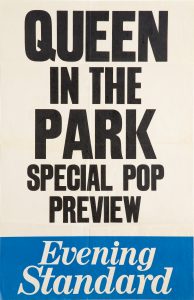
Download poster HERE
Credit: © Queen Productions Ltd.
Click HERE for Queen The Greatest – Episodes 1-9
“Thank you very much, good evening everybody. Welcome to our picnic by the Serpentine.” – Freddie Mercury, September 18, 1976
“Afterwards, we were being threatened with arrest.” – Brian May
This week’s Queen The Greatest episode heads back to 1976 and what remains to this day one of the biggest nights in Queen’s remarkable career. Humbled by the success they had enjoyed so far, the band wanted to do something special to say thank you to their loyal fans – and what better way than to put on their most spectacular show to date. A free concert in the heart of London – the Royal Hyde Park.
Rare interview and news footage from the time reveals it truly was a night to remember but almost ended in the band’s arrest.
As Brian May explains in an interview from the time, Queen’s takeover of this historic London landmark proved to be a massive undertaking…but one with a big reward.
“It took a lot of people about 8 or 9 weeks solid work, including us, and all the traumas from not being able to get permission to do it, to wondering about whether the grass was OK. There was a drought at that time, and they didn’t want us to play if it didn’t rain, which is kind of an unusual thing. Lots of things like that, right up to the last moment.
“(And) then getting very, incredibly, naturally kind of high before going on because although we’d played to large audiences before, this is London, it’s our home and that’s something different.”
Despite all the heady obstacles presented, the show went ahead, and as footage from a rare BBC Television News clip shows, it was a major victory for the band.
(News Reader) “More than 50,000 people flocked to the free concert which was remarkably peaceful with only four arrests over a period of nine hours. The Police presence was kept to a minimum, with only 40 officers visible, though at least twice as many out of sight in reserve.”
(News Reader) Queen spent fifty thousand pounds of their own money to promote the concert. It may be only rock ‘n’ roll, but it is expensive.”
In fact, the crowd size was estimated to be somewhere between 150,000 and 200,000 people, and for 80 glorious minutes Queen rocked central London. However, as the band prepared to give the ecstatic crowd an encore to finish the night, the police stepped in…
Brian May: “Afterwards, being threatened with arrest if we went on for the encore, which nobody realized at the time, but we were sort of hustled into a van on threat of being taken away to different places. It was very strange. Because I think people got nervous of the crowd, and people worried whether it could be controlled in the dark and things like that… Apart from things like that it was great.”
A night like this needed to be preserved, and so the concert was filmed, with footage from it immediately used in a promotional video for “Somebody To Love.”
Looking back at it more recently, Brian May recalls what a big step the Hyde Park show was for Queen, and the significance that night had for the band.
Brian May: “I remember thinking…gulp…you know, we’ve carved out a place around the world, but England doesn’t really think we’re that cool. It was packed beyond belief, and it was really like coming home to a sort of hero’s welcome.”
Nearly 30 years later, in July 2005, Brian and Roger would make an emotional return to Hyde Park with then frontman Paul Rodgers. Originally scheduled for July 8th, the show was delayed due to a devastating terrorist attack in the city. However, a week later, undeterred, everyone came together for an emotional and memorable night, with one poignant moment a particular highlight, performed to a massive audience including several hundreds of emergency and rescue workers invited as guests by the band…
Next week: “Queen In Japan – Queenmania”
Photo:
Photo Click Here
Credit: © Queen Productions Ltd.
‘Queen The Greatest’ Latest Episode and YouTube Playlist Link:
http://Queen.lnk.to/TheGreatest
For further information and to receive weekly updates:
Contact:
Sharrin Summers, Hollywood Records
Email: sharrin.summers@disney.com
Queen The Greatest: a celebration of 50 of the greatest moments
from the Queen story so far.
A 50-week YouTube series celebrating key moments in Queen’s history reminding us why Queen and their music continue to be loved across the world.
~
Episode 9: Queen: “1976 ‘Somebody To Love’ – Freddie’s Greatest Hit?
Watch HERE
Queen The Greatest – Watch Episodes 1-8: HERE
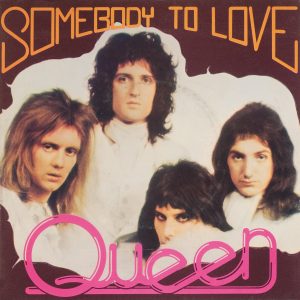
Photo Credit: © Queen Productions Ltd.
“Queen The Greatest”: a celebration of 50 of the greatest moments
from the Queen story so far.
A 50-week YouTube series celebrating key moments in Queen’s history reminding us why Queen and their music continue to be loved across the world.
Episode 8: A Night At The Odeon
WATCH HERE
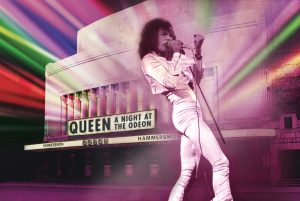
Queen The Greatest – Watch Episodes 1-7 HERE
A look back at Christmas Eve, 1975, as Queen prepare to perform a live concert for the
first time in front of a TV and Radio audience of millions.
Includes rare audio and images from the sound-check.
To celebrate the most successful year in their career to date, Queen returned to play an extra show at London’s Hammersmith Odeon on Christmas Eve 1975.
The Hammersmith Odeon was a prestigious venue the band had been eager to claim as their own having experienced it as the support act for Mott The Hoople in 1973 and the band had already played four shows at the venue late November/early December as part of a sold out 25-date UK tour.
At the same time, “Bohemian Rhapsody” was on a record nine-week run at the top of the singles chart.
This milestone A Night At The Odeon show would provide Queen with its biggest audience to date. To be televised live on the UK’s BBC TV’s Old Grey Whistle Test and broadcast simultaneously on the national Radio 1, the show would take the band into millions of homes across the nation, crowning Queen as the biggest rock band in the UK.But despite all the preparations, there were some things beyond their control that meant the band weren’t taking it for granted that it was something they’d be able to pull off.
Roger Taylor: “It was quite difficult. You’re just starting to wind down and then actually, you’ve got to go back and do this one, all-important show. It was a big deal in the fact that it was going out live on Christmas Eve… I remember thinking ‘ah, will we have lost our momentum and that sort of kick-ass stuff that you’ve developed on a tour, and I do remember being quite, sort of, worried about it.”
But as rare audio from the sound check proves, the band was in top form, and worked hard to make sure this wouldn’t be a night to forget for their audience.
Despite their reservations the show was flawless, and A Night At The Odeon continues to be regarded as one of Queen’s best performances – treasured because it also represents the first filmed live performance of “Bohemian Rhapsody.”
And as can be seen from a Brian May moment in the concert – being able to end such an eventful and significant year on such a high, meant the world to the band.
Brian May: “You know we’ve taken our show around the world, but we’ve never got to so many people all at once, and this felt really good. Thanks a lot for giving us a good year, we’d like to leave you in the Lap of The Gods.”
Footnote: The original multi-track tapes of the show were subsequently believed to be lost, before being recovered in 2009 and restored by Queen sound engineers Justin Shirley-Smith, Kris Fredriksson, and Joshua Macrae. The re-mastered and restored show was shown at a special screening on 8 October 2015 at Olympic Studios in London where some of A Night at the Opera had been recorded.
Next week: “Queen 1976 : Somebody To Love – Freddie’s Greatest Hit?”
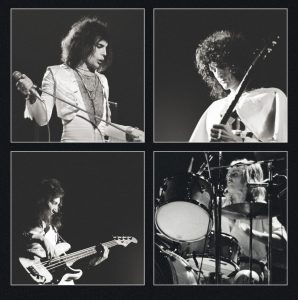
https://www.dropbox.com/s/rkpbby7uf9exzbt/FREDDIE_ON_ODEON.jpg?dl=0
Credit: © Queen Productions Ltd.
https://www.dropbox.com/s/8zri34m7oo0oy8f/0602547500755_Queen_IB_1.jpg?dl=0
Credit: Photography Douglas Puddifoot. © Queen Productions Ltd.
Queen The Greatest “A Night At The Odeon” YouTube Playlist Link:
http://Queen.lnk.to/TheGreatest
Queen The Greatest: a celebration of 50 of the greatest moments
from the Queen story so far
A 50-week YouTube series celebrating key moments in Queen’s history reminding us why Queen and their music continue to be loved across the world.
Episode 7: “Queen: Behind The Hits – Roger Taylor”
This episode highlights five band classic hits that all came from Queen drummer Roger Taylor including the iconic “Radio Ga Ga.”
WATCH HERE
Episodes Go Live Every Friday on Queen Official YouTube
WATCH ALL EPISODES HERE

Taylor penned “Radio Ga Ga” reached number one in 19 countries.
Photos: https://www.dropbox.com/s/1gjigu49epsalmy/QPE037.jpg?dl=0
Credit: Photography by Simon Fowler. © Queen Productions Ltd.
Queen: Behind The Hits – Roger Taylor
As well as being recognized for their individual skills as incredible musicians and performers, perhaps less often documented is the considerable writing talents of all four members of Queen: Mercury, May, Taylor, and Deacon each individually contributing a significant portion of the extensive Queen song catalogue which continues to resonate on playlists and music charts to this very day.
This week’s Queen The Greatest episode highlights five band classic hits that all came from Queen drummer Roger Taylor.
As well as writing, among others, fan favorites such as “I’m In Love With My Car,” famously the B-Side to “Bohemian Rhapsody” (and the source of much parody in the band’s blockbuster Bohemian Rhapsody film), and the live tour de force “Sheer Heart Attack,” Queen’s first major chart success with a Taylor composition came in 1984 with “Radio Ga Ga.” The single was a worldwide success for the band, reaching number one in 19 countries.
The iconic video moment of the crowd clapping along to the drumbeat was quickly adopted by fans attending live Queen shows around the world and continues to be an awe-inspiring audience participation moment during every live performance.
More chart success for Taylor followed on the band’s next album with the title track, “A Kind of Magic,” accompanied by another classic video in which Freddie gets to weave his ‘magic’ over his less than glamorous looking band mates.
By the time The Miracle album came along in 1989, songs were being credited as being composed by Queen, rather than individually – but it is acknowledged that Roger was the originator of two of the album’s chart hits – “Invisible Man” and “Breakthru.”
“These Are The Days of Our Lives” is a song close to every Queen fan’s heart and although it was originally conceived by Roger as a reflective song about parenthood, it took on a different significance on its release, coming shortly after the tragic loss of Freddie Mercury. The song, deservedly, gave Queen a number one hit.
Further along the series will take a look at the hits originated by Freddie, Brian and John.
Next week: Queen Live in 1975 – A Night At The Odeon
Photos:
https://www.dropbox.com/s/1gjigu49epsalmy/QPE037.jpg?dl=0
Credit: Photography by Simon Fowler. © Queen Productions Ltd.
‘Queen The Greatest’ Latest Episode and YouTube Playlist Link:
http://Queen.lnk.to/TheGreatest
Queen The Greatest: a celebration of 50 of the greatest moments from the Queen story so far.
A 50-week YouTube series celebrating key moments in Queen’s history the weekly clips series reminds us why Queen and their music continue to be loved across the world.
Episode 6: “Bohemian Rhapsody – Making History”
Watch HERE
Watch All Episodes on Queen Official YouTube Playlist HERE
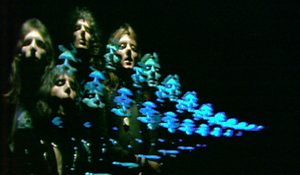
Photo HERE
Credit: © Queen Productions Ltd.
Queen: 1975 Bohemian Rhapsody – Making History
A journey through Queen’s greatest achievements would not be complete without including the ground-breaking “Bohemian Rhapsody.” Even though as the song came together in the studio the band believed something special was emerging, the impact it would make and continue to have was beyond their wildest expectations, changing the music industry forever.
Delivering the band their first No. 1 hit single, it went on to become the only song to sell over a million copies on two occasions in the UK, is the most streamed song of the 20th Century, and in March 2021 reached the extremely rare RIAA Diamond Song status in the US, making Queen the first British band ever to earn this award.
While the weeks of painstaking work in the studio to create this masterpiece are well documented, no one could have predicted that just four hours spent by the band at the UK’s Elstree Studios on the 10th of November would change the course of music history forever…
Brian May: “To be honest we weren’t too keen on going on ’Top of the Pops’ and standing on those little podiums and kind of miming Bohemian Rhapsody. It would have been really crap.”
Roger: “We used an outside broadcast sports unit to bring in their cameras into Elstree (Studios) where we were rehearsing. And we could go on the road and that (video) could be on Top of the Pops and we realized ‘wow’ you don’t even have to be here to promote your record now…just make one of these little video films and that’s got to be the way in the future. We were the first to do that.”
Freddie: “It’s the first video that actually took any kind of effect into actually making sales. A lot of videos were probably made before, but they didn’t sell records. I think that’s the first that actually worked.”
Directed by Bruce Gowers and costing just £4500, the promo for ‘Bohemian Rhapsody’ is widely regarded to have given birth to the practice of creating music videos.
The video’s dramatic imagery has become as iconic and recognizable as the song itself. It’s no surprise then that it was the first pre 1990’s music video to pass the 1 billion views milestone on YouTube.
Next week: Behind The Hits – Part 1. A strand celebrating all four band members as hit songwriters. Part 1 looks at five chart successes written by Roger Taylor.
#QueenTheGreatest
http://www.queenonline.com
Website / YouTube / Instagram / Twitter / TikTok
Brian / Roger
Queen The Greatest: a celebration of 50 of the greatest moments from the Queen story so far…
Episode 5: “Queen: 1975 A Night At The Opera – Make or Break”
Watch HERE
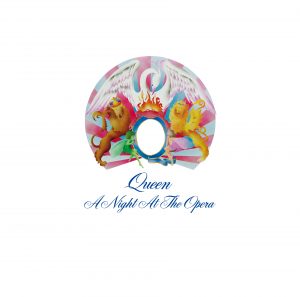
“Queen: 1975 A Night At The Opera – Make or Break”
Brian May: “We were not only poor, but we were in debt. All the sound and lighting companies and the people that hadn’t been paid. So, we were at a really crucial point. We might have had to break up if that album hadn’t done well.”
Continuing the celebration of some of Queen’s greatest achievements so far, this latest episode revisits the band’s fourth album, A Night At The Opera, released December 1975. Widely regarded as Queen’s seminal album, Queen’s perilous financial situation at the time made this an incredibly risky leap of faith, creating a genuine make or break moment for the band.
The album is, without doubt, Queen at their absolute finest as musicians, composers and producers – harnessing an incredible array of musical styles. The fact it was created when the band were on the brink of financial ruin, and was, at the time, the UK’s most expensive album ever produced – brings into sharp focus what a huge risk they were taking.
Roger recalls this as a “make or break moment” for the band. The band were so in debt they feared that it might have been unable to continue if the album did not perform well.
Brian explains: “It was an expensive album, enormous complexity on there. Even looking at it now I wonder how we did some of that stuff.”
The leap of faith paid off and it completely changed the landscape for Queen thanks to hit singles including “You’re My Best Friend” by bassist John Deacon, and of course the legendary “Bohemian Rhapsody” – as well as producing such lasting Queen classics as Freddie Mercury’s “Love Of My Life” and Roger Taylor’s “I’m In Love With My Car.”
A Night At The Opera topped the charts across the globe, going on to sell over 6 million copies giving it platinum status in many countries, including multi-platinum in the US.
It received universal acclaim and would continue to collect accolades year after year. In 2018 it was deservedly inducted into the Grammy Hall of Fame.
Without doubt a milestone in the Queen story the album of course also provided them with what would become the biggest song in their history – which will be explored in next week’s episode.
Next Week: Episode 6: Bohemian Rhapsody – Making History
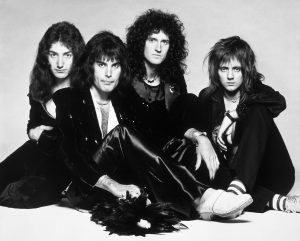
Photo Courtesy: Queen Productions Ltd
About Queen The Greatest
Beginning March 19, 2021 and continuing weekly through to March 2022, Queen YouTube will take Queen fans on a unique and remarkable journey – a chance to revisit some of the band’s most iconic moments and discover some aspects of the story we didn’t know.
Celebrating key moments in Queen’s history the weekly clips series will remind us why Queen and their music continue to be loved across the world.
Presented in chronological order, the series will take us from Queen’s earliest shows at London’s Rainbow and Odeon through vast arenas across the entire world on a journey culminating with the band’s latest record setting achievements with Adam Lambert.
Along with spectacular concert footage, sound checks, backstage and rare after-show access we get to explore the stories behind the songs, hits and album tracks, drawn from the extensive footage that exists in the official archive while also uncovering and sharing rare and previously unseen gems.
Some of these moments will be familiar, others rare or forgotten, some record-breaking milestones, others quirky and unusual but all of which remind us of the impact Queen has maintained for five decades and continues through to today.
First months of the regular weekly output will see it celebrate classic hits such as “Killer Queen,” “Somebody To Love” and, of course “Bohemian Rhapsody,” along with iconic performances at London’s The Rainbow, Hammersmith Odeon and the band’s massive outdoor Hyde Park concert. In addition, revealing some gems from the band’s first tours abroad to Europe, Scandinavia, and North America.
Series producer and creator Simon Lupton says: “The Queen story is unlike any other, and I hope fans from all around the world will enjoy celebrating the many extraordinary achievements, timeless songs, and iconic performances that Freddie, Brian, Roger and John have given us. While we will be revisiting some of their most famous and legendary milestones, I’m hoping there will also be some surprises along the way to excite people whether they be die-hard fans, or curious newcomers. This story has so many chapters to explore, and who knows…there could well be some new ones over the course of the next 50 weeks! ”
#QueenTheGreatest
http://www.queenonline.com
Website / YouTube / Instagram / Twitter / TikTok
Brian / Roger
Queen The Greatest: a celebration of 50 of the greatest moments from the Queen story so far.
Episode 4: Queen In Finland
Friday April 9th – Queen Official YouTube
Watch HERE
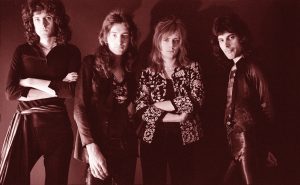 Photo credit: Johnny Dewe Mathews
Photo credit: Johnny Dewe Mathews
Queen In Finland, November 1974
By the end of 1974 Queen had enjoyed success in the singles charts, released three albums and were established as a headlining act in the UK. Yet the band’s ambitions did not stop there. Their sights were firmly set on performing abroad. Interest in other countries was already starting to grow, helped by “Killer Queen” charting well in Belgium, Germany, Austria, The Netherlands, Ireland and the US.
As early as 1973, Queen had already performed in Germany and Luxembourg, and so when the Sheer Heart Attack tour came around in late ’74 this time Scandinavia would become Queen’s new destination on the band’s first proper European tour.
Although the touring schedules didn’t allow much time for sightseeing, each trip was an exciting new experience for these young musicians, and often full of surprises.
One such surprise occurred at the Press Conference ahead of the band’s performance in Helsinki, Finland, on November 25th, 1974. Amongst the usual journalists, TV and Radio presenters, clutching a small tape recorder was Juha Kakkuri, a 12 year old boy, who having heard “Brighton Rock” decided he wanted to get the band’s autographs. The plucky young lad called their record company and ended up being invited along and getting to interview the band through which we learn what John bought in Finland and what were Brian May’s favourite candies at the time and why the young Juha had to miss out on seeing the band perform that night.
Talking now, Juha recalls: “The interesting thing is that the first band member I interviewed was Freddie. I mean I didn’t know he was the lead singer, he could have been the bass player or the drummer. But I happened to interview Freddie first and during my career in Radio I’ve met a lot of big stars. Robbie Williams. Rolling Stones. People like that. But still I think that nothing can top the experience that the first person you have interviewed, at the age of 12, is Freddie Mercury.”
Even though the band never performed there again with Freddie, the fan base remained solid and continued to grow, evidenced by the enthusiastic response Brian and Roger enjoyed when they did return to Helsinki with Adam Lambert in 2016.
As we will witness with so many other countries throughout the Queen The Greatest series, from the very beginning the band had an extraordinary ability to form a deep and special bond with fans all over the world that endures to this very day.
“Queen – The Greatest”
A celebration of 50 of the greatest moments from the Queen story so far.
Episode 3: “Killer Queen, The Turning Point”
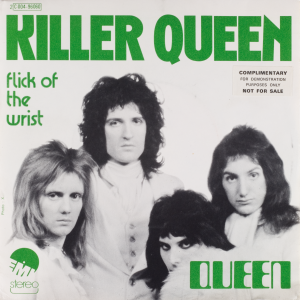 Artwork / photos HERE
Artwork / photos HERE
Watch HERE
Killer Queen, The Turning Point.
Continuing Queen’s 50-week YouTube series Queen The Greatest, episode 3 celebrates one of Queen’s best-loved songs, a track that was a major turning point for the band – “Killer Queen.”
Following the success in the UK charts with “Seven Seas of Rhye” in March 1974, the band were eager to go even better with their next single, and had high hopes for the Freddie Mercury composition, “Killer Queen.”
However, the song had been recorded in unusual circumstances.
Having only just recovered from Hepatitis, a still clearly unwell Brian May was struggling in the studio. A duodenal ulcer was the diagnosis and he was rushed to hospital, leaving the rest of the band to carry on without him.
When he was able to return, the song was already starting to sound unique – and by the time Brian’s guitars and Queen’s now distinctive vocal harmonies were added, something truly special had evolved.
Despite the band’s confidence in the song, they recognised releasing it wouldn’t be without its risks…
In new interviews Brian talks about his initial reservations over the track and Roger evokes Noel Coward when talking about Freddie. From the archive Freddie talks about his development as a songwriter with the track.
As rare footage from Swedish TV reveals, the response at radio was mixed: record promoter Eric Hall faced a hesitant response from one well-known UK radio producer: “a bit much maybe for first thing in the morning.”
Regardless, the song raced into the UK Top Ten, peaking at number 2, while also reaching number 12 in the America.
The song’s success introduced the band to a whole new wave of fans, and to this day remains one of the band’s most recognised and well-loved compositions.
Next week: “Early Tours” including a surprising story from a press conference in Finland.
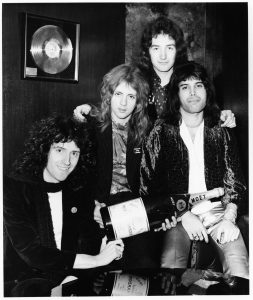 Photo credit: EMI Photo Archive
Photo credit: EMI Photo Archive
Queen – The Greatest – a celebration of 50 of the greatest moments from the Queen story so far
Episode 2: “Live At The Rainbow – London, 1974”
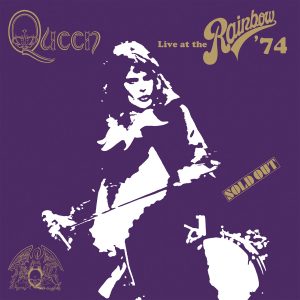 Watch HERE
Watch HERE
(March 26, 2021) Having played host to acts such as Jimi Hendrix, The Beach Boys, David Bowie and Eric Clapton, for a young band like Queen, headlining at London’s The Rainbow really was the stuff of dreams. A dream that first came true for the band on their Queen II tour on March 31, 1974.
The Rainbow concert was hugely significant in the band’s leap forward as a headliner band. Brian explains: “We’d done our support tour and then promoter Mel Bush came to us – he was a pretty top promoter at the time – and he said ‘I think you guys can headline the next tour,’ and we were surprised. I remember thinking ‘Wow, that’s very quick,’ because normally you would support a few acts and build a following and then you would go on your headline tour.
“But he said ‘No, I feel you can do it, you can sell out all these places’ and he gave us a big list – Newcastle City Hall, Manchester’s Free Trade Hall or whatever, you know all the sort of classic gigs that Rock Bands do, and he said ‘you can fill all these, and at the end we’re going to do the Rainbow.’
In October 1974, when the band embarked on their next UK tour to promote the Sheer Heart Attack album, it was no surprise that the Rainbow would feature on their tour schedule. However, this time, due to overwhelming demand, a second sold out night had to be added.
These spectacular nights at The Rainbow November 19/20 in 1974 were a clear statement that, as a live act in the UK, Queen had well and truly arrived.
It also marked the first time Queen had been professionally filmed live in concert. The footage was edited down and later screened at selected British cinemas further underlining Queen’s rapidly emerging stature.
A random fact: In 1974, a ticket to this sought-after gig would have set you back £1.75.
Next week: The ‘turning point’ single, Killer Queen.
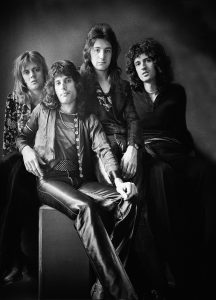
Johnny Dewe Mathews @ Queen Productions Ltd.
Press Contact:
Sharrin Summers / Hollywood Records
Sharrin.summers@disney.com
QUEEN’S “BOHEMIAN RHAPSODY” REACHES RARE
RIAA DIAMOND STATUS WITH MORE THAN
10 MILLION U.S. SALES / STREAM EQUIVALENTS
QUEEN BECOMES FIRST BRITISH BAND IN MUSIC HISTORY TO EARN RIAA DIAMOND SONG AWARD
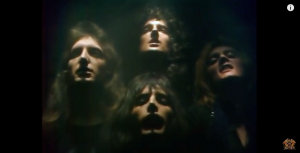
BAND’S LANDMARK PLATINUM COLLECTION, VOL. 1-3 EARNS 5X PLATINUM RIAA CERTIFICATION
(Thursday, March 25, 2021) More than four decades after its release, Queen’s iconic “Bohemian Rhapsody” continues to reach new milestones. The iconic song has been officially certified Diamond by the Recording Industry Association of America (RIAA), representing 10 million or more in sales and stream equivalents in the United States.
Queen is the first British band in music history to earn the Diamond song award.
“This is incredible news. At times like this I have to pinch myself to be sure it’s real,” said Brian May. “All those wild dreams we had – this is beyond any of them. Huge thanks to all who have believed in us over the years.”
“It’s a wonderful and gratifying thought to know the song has reached out and connected with so many people!” said Roger Taylor. “We thank you all…………..onwards.”
This is the latest in a long line of extraordinary achievements for “Bohemian Rhapsody,” which was Queen’s first Top 10 hit in the US. In the UK it went to #1 for 9 consecutive weeks, a record at the time, before returning to the top of the charts again in 1991. It was named the most-streamed song of the 20th century and its companion video recently passed one billion views on YouTube, making history as the first pre-1990’s video to reach one billion views on the platform. In 2004, the song was inducted into the Grammy Hall of Fame and Freddie Mercury’s vocal performance was named by the readers of Rolling Stone magazine as the best in rock history.
“Bohemian Rhapsody” is also one of the many Queen hits featured on the band’s blockbuster compilation, Platinum Collection, Vol. 1-3, which was just certified 5X Platinum. This blockbuster compendium, which hit No. 6 on the Billboard 200, features tracks like “Another One Bites The Dust,” “Killer Queen,” “Under Pressure,” “We Will Rock You,” “We Are The Champions” and so many more.
On the heels of this momentous milestone, the band has also kicked off a year-long weekly YouTube series Queen The Greatest – a celebration of Queen’s Golden Jubilee that highlights 50 of the greatest moments from the Queen story so far. Beginning with the March 19 first episode, “Keep Yourself Alive” (WATCH HERE), and with five decades to explore, the series of weekly insights will highlight some of the biggest songs, most memorable performances, and incredible record-breaking achievements that Queen have brought us since it all began in 1971 – bringing fans, over the coming year, one of the greatest stories ever told. Upcoming: Episode 2 – “Live At The Rainbow-London, 1974” (3/26) and Episode 3 -“The ‘turning point’ single, “Killer Queen (4/2).
Weekly episodes go live every Friday (HERE).
In addition, the band just released their first ever official Queen game on mobile, Queen: Rock Tour, the band’s first ever official game for Android and iOS devices. Upon its release, Queen: Rock Tour went Top 5 on The Music Game App chart in over 20 countries.
Queen remain one of the most popular groups in the world today, transcending multiple generations of fans, a position further buoyed by the phenomenal global success of their Academy Award-winning 2018 biographical film Bohemian Rhapsody, which tells the incredible story of the band’s historic career and quickly became the highest grossing music biopic in history.
http://www.queenonline.com
Website / YouTube / Instagram / Facebook / Twitter / TikTok
Brian / Roger
Press contact:
Sharrin Summers / Hollywood Records
Sharrin.summers@disney.com
“Queen The Greatest”
Episode 1. “Keep Yourself Alive”
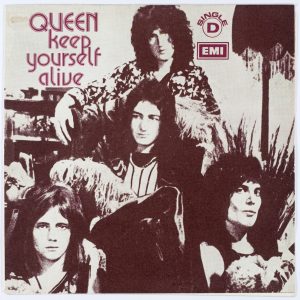
Photo credit: Douglas Puddifoot / Copyright: Queen Productions
Watch HERE
Welcome to “Queen – The Greatest” – a celebration of 50 of the greatest moments from the Queen story so far which begins here and will continue to bring you to one of the greatest stories ever told over the coming year.
With five decades to explore, the series of weekly insights will highlight some of the biggest songs, most memorable performances, and incredible record-breaking achievements that Queen have brought us since it all began in 1971.
And where better to begin our journey than with the song that started it all off – “Keep Yourself Alive.”
“Keep Yourself Alive” was one of the earliest songs ever recorded by the band, part of the first demo they put together in December 1971, it ultimately became the first track on the first side of their first album – Queen.
The song was written and composed by Brian May who says: “I wasn’t very sure that I was a song writer, really, I just sort of had this idea, and strangely enough the lyrics for “Keep Yourself Alive” are meant to be kind of a comment, they’re meant to be slightly ironical.
“Everyone always did think that ‘Keep Yourself Alive’ was just a jolly song about how great it is to be alive, but it’s actually more about asking the question ‘is there more to life than this?’ in a sense.”
As a striking and confident opener, “Keep Yourself Alive” was finally released as the band’s first ever single in July, 1973. To accompany the release, their management company arranged for a promo video to be shot.
However, the stark white set and costumes were in complete contrast to how the band wanted the song to be portrayed.
So, Queen insisted that this alternative version we are so familiar with today be filmed.
From the earliest days of Queen when Freddie Mercury first took to the stage with Brian and Roger in 1970, “Keep Yourself Alive” was a constant on their set list. It continues to remain a firm concert favourite.
And as the perfect showcase for the band’s individual and collective talents, it’s easy to see why it was such a crowd pleaser, and regular feature as the Queen shows got bigger and bigger…
Next week: “The Rainbow” concerts 1974, and “Killer Queen.”
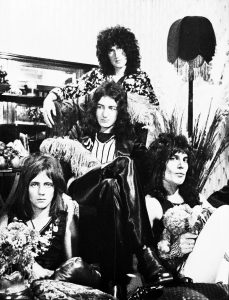
Photo credit: Douglas Puddifoot / Copyright: Queen Productions
Queen The Greatest
For 50 glorious weeks
A celebration of Queen’s Golden Jubilee
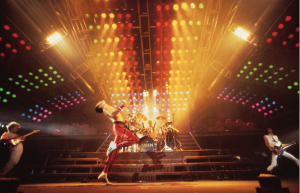 An exclusive series of clips that highlight 50 extraordinary moments from the Queen story so far.
An exclusive series of clips that highlight 50 extraordinary moments from the Queen story so far.
From March 2021 to March 2022 on Queen’s Official YouTube Channel
Watch the trailer HERE
Beginning March 19, 2021 and continuing weekly through to March 2022, Queen YouTube will take Queen fans on a unique and remarkable journey – a chance to revisit some of the band’s most iconic moments and discover some aspects of the story we didn’t know.
Celebrating key moments in Queen’s history the weekly clips series will remind us why Queen and their music continue to be loved across the world.
Presented in chronological order, the series will take us from Queen’s earliest shows at London’s Rainbow and Odeon through vast arenas across the entire world on a journey culminating with the band’s latest record setting achievements with Adam Lambert.
Along with spectacular concert footage, sound checks, backstage and rare after-show access we get to explore the stories behind the songs, hits and album tracks, drawn from the extensive footage that exists in the official archive while also uncovering and sharing rare and previously unseen gems.
Some of these moments will be familiar, others rare or forgotten, some record-breaking milestones, others quirky and unusual but all of which remind us of the impact Queen has maintained for five decades and continues through to today.
First months of the regular weekly output will see it celebrate classic hits such as “Killer Queen,” “Somebody To Love” and, of course “Bohemian Rhapsody,” along with iconic performances at London’s The Rainbow, Hammersmith Odeon and the band’s massive outdoor Hyde Park concert. In addition, revealing some gems from the band’s first tours abroad to Europe, Scandinavia, and North America.
Series producer and creator Simon Lupton says: “The Queen story is unlike any other, and I hope fans from all around the world will enjoy celebrating the many extraordinary achievements, timeless songs, and iconic performances that Freddie, Brian, Roger and John have given us. While we will be revisiting some of their most famous and legendary milestones, I’m hoping there will also be some surprises along the way to excite people whether they be die-hard fans, or curious newcomers. This story has so many chapters to explore, and who knows…there could well be some new ones over the course of the next 50 weeks! ”
#QueenTheGreatest
http://www.queenonline.com
Website / YouTube / Instagram / Twitter / TikTok
Brian / Roger
Press Contact:
Sharrin Summers / Hollywood Records
sharrin.summers@disney.com
QUEEN ROCK TOUR
BECOME A ROCK LEGEND WITH THE FIRST EVER
OFFICIAL QUEEN GAME ON MOBILE.
 “Be a Lockdown Rock Star! No turning back !!!” – Brian May, Queen
“Be a Lockdown Rock Star! No turning back !!!” – Brian May, Queen
Play along with hits from the band’s iconic catalogue
Relive their classic concerts by touring the world and performing on different stages
Click here to view video trailer
Queen: Rock Tour is available now on Android / iOS (HERE)
(London, March 1st, 2021) – With live music in lockdown and the return of tours still uncertain, rock group Queen has come up with a safe alternative – no masks, no social distancing, just the good old fashioned live experience, with Queen: Rock Tour, the band’s first ever official game for Android and iOS devices.
The arrival of the play-along rhythm game comes at a significant landmark for Queen. With 50 years now having passed since the 1971 recruiting of John Deacon, completing Queen’s classic line-up, 2021 marks a Queen Golden Jubilee that the band was hoping to celebrate with fans. A massive 29-date European stadium and arena tour planned for this year has been forced to be delayed to 2022.
Queen: Rock Tour gives players a chance to experience the majesty and might of the Queen [live] experience on their phones supported by extensive attention to detail contributed by the official Queen archives and experts. Hit the stage and perform with the entire band as you unleash your music talents to play thrilling guitar riffs, heart-pounding drum solos and much more. All you need to do is tap the tiles in time with the rhythm!
“Be a Lockdown Rock Star! No turning back !!!” enthused Queen’s Brian May on the game launch.
The game allows users to fully immerse themselves into the world of Queen – Progress and score points by playing along to 20 of their most popular hits including: “Bohemian Rhapsody,” “We Will Rock You,” “Radio Ga Ga,” “I Want to Break Free” and “We Are The Champions,” while performing at 10 historic concert venues from around the world.
Style your performances with over 40 official and iconic costumes from the band’s history and help unlock fun trivia facts and exclusive images from the official Queen archives, by scoring highly in the game.
Queen’s music has been featured in major mobile music games before, but for the first time ever the band will be releasing their own dedicated mobile experience in Queen : Rock Tour.
Queen remain one of the most popular groups in the world today, transcending multiple generations of fans, a position further buoyed by the phenomenal global success of their Academy Award-winning 2018 biographical film Bohemian Rhapsody, which tells the incredible story of the band’s historic career and quickly became the highest grossing music biopic in history.
The film’s title was inspired by their iconic 1975 single “Bohemian Rhapsody,” the world’s most-streamed song from the 20th Century and the first pre-1980’s song to achieve more than 1 billion video views.
Queen: Rock Tour was created in association with Universal Music Group, Hollywood Records and developed by industry-leading mobile gaming developer and producer Gameloft.
Cedric Ratajczak, Creative Director at Gamesloft said, “Our ambition was to push the boundaries of music and gaming with a fun and rewarding experience that would put players in Queen shoes at pivotal points in their career, and make them perform in real-time Queen’s live music unlike ever before. The creative challenge was to modernize the traditional rhythm-game genre with innovative and mobile-friendly twists inheriting from hyper-casual gaming, and with a unique and happy visual style that offers a timeless look to the band, appealing to the new generation of players.
We devoted enormous attention to the details of Queen’s history, authenticity and artistry to craft a fitting tribute to one of the most significant bands in rock history and aim at setting new standards for how band-focused music games could be executed on mobile today.”
Andrew Kronfeld, Executive Vice President, Marketing at Universal Music Group said, “Today, Queen are globally recognized as one of the most iconic and important bands in history. Decades after their first live shows together and following on from the huge worldwide box office success of the Bohemian Rhapsody biopic, their popularity continues to grow every year. We hope the launch of Rock Tour will introduce their inimitable rock legacy and catalogue to a new generation of fans, through this unique new gaming experience.”
Ken Bunt, President, Disney Music Group said, “We are excited to partner with Queen, UMG, and Gameloft to let Queen fans experience the bands legendary music in a new way.”
Rock Tour is certain to appeal to fans old and young alike and is sure to find a place in the hearts of the millions of Queen fans around the world.
Download Campaign Video, In-game images and Queen photographs here:
https://umusic.box.com/s/fcn727c31e7kh1v9n1ps5flhevs0h284
Download Queen: Rock Tour free on Apple App Store:
http://queen.lnk.to/RockTour/AppleAppStore
Download Queen: Rock Tour free on Google Play:
https://queen.lnk.to/RockTour/Google-Play
For more information please contact:
UMG
james.murtagh-hopkins@umusic.com
HOLLYWOOD RECORDS
sharrin.summers@disney.com
GAMELOFT
Stephanie.Cazaux-Moutou@gameloft.com
About Queen: Rock Tour
Embark on a musical journey to rediscover the story of the world’s most iconic rock band. Play the greatest hits at historic venues, create your own stage performances with unique animations and legendary outfits, and collect exclusive images from the official archives of Queen!
Game Features
– Play your favorites tracks from over 20 official Queen songs from the greatest albums, including: Bohemian Rhapsody, Keep Yourself Alive, We Will Rock You, I Want to Break Free, We Are The Champions, and many more!*
– Challenge your music skills in this fun and intuitive game. Whether you’re playing the guitar, drums, vocals or bass, just tap the tiles as they float by to create some of the most memorable music on mobile!
– Keep the rhythm going throughout the stage to chain together crazy combos and rack up an amazing game score as you play and complete the songs!
– Dazzle the audience with official outfits and customizable accessories you can unlock and pick out for each venue.
– Play your songs in one iconic venue after another, including the original stages at London, Tokyo, Houston, Buenos Aires, Rio de Janerio and many more.
– Unlock and collect fun music trivia facts and exclusive band images from the official Queen Archives.
Queen Rock Tour is free to play with 3 full tracks and 30 second playable levels of all other featured tracks, but if you wish you can enhance your experience and unlock all 20 full tracks for a one time in-app purchase of XXXX
Ready to make music history with Queen? It’s showtime!
*(Fully-Unlocked Version Required to access all 20 full-length tracks)
NOTES TO EDITORS:
About Universal Music Group
Universal Music Group (UMG) is the world leader in music-based entertainment, with a broad array of businesses engaged in recorded music, music publishing, merchandising and audiovisual content in more than 60 countries. Featuring the most comprehensive catalog of recordings and songs across every musical genre, UMG identifies and develops artists and produces and distributes the most critically acclaimed and commercially successful music in the world. Committed to artistry, innovation and entrepreneurship, UMG fosters the development of services, platforms and business models in order to broaden artistic and commercial opportunities for our artists and create new experiences for fans. Universal Music Group is a Vivendi company. Find out more at: http://www.universalmusic.com.
About Hollywood Records
Hollywood Records is part of DMG which includes Walt Disney Records, Disney Music Publishing, Buena Vista Records, and Disney Concerts. Along with its genre-spanning rosters Hollywood Records and DMG also release film and television soundtracks such as the chart-topping “Bohemian Rhapsody,” “Guardians of the Galaxy,” “High School Musical: The Musical: The Series” (featuring chart-topper Olivia Rodrigo), Oscar-winning “Coco” and “Moana” soundtracks, and the Oscar and Grammy-winning “Frozen” soundtrack. DMG has a rich catalog with a lasting legacy that has impacted pop culture globally, including music from films like “Star Wars.” DMG produces the For Scores podcast series highlighting conversations with acclaimed film composers from Marvel Studios, Pixar, 20thCentury Studios, Disney, and more. The Concerts division licenses and produces hundreds of shows around the world, including Star Wars in Concert, Disney On Classic, Pixar In Concert, and many more. https://www.hollywoodrecords.com
About Gameloft for brands
With a monthly audience of 250 million active players, 300 million impressions, and an average playtime of 27 minutes per day per user, Gameloft for brands offers advertisers a unique level of visibility and engagement with their audiences. To date, Gameloft for brands has delivered more than 10,000 campaigns for prestigious brands such as Air France, Coca-Cola®, Ford, FOX™, Ferrari, ING, Netflix, Procter & Gamble, Samsung and LEGO, in over 40 countries around the world (North America, Latin America, Middle East, Africa, Europe, Asia, etc.) and our work has been honored with over 50 awards from marketing organizations.
All trademarks referenced above are owned by their respective trademark owners.
QUEEN’S GREATEST HITS SKYROCKETS TO #8 ON THE BILLBOARD 200 CHART
ALMOST 40 YEARS AFTER ITS RELEASE, THE 9X PLATINUM-SELLING COMPILATION CONTINUES TO REACH NEW HEIGHTS
QUEEN’S GREATEST HITS HITS NO. 1 ON BILLBOARD’S VINYL ALBUMS CHART
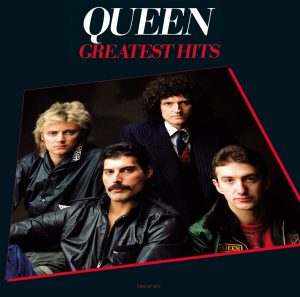 Artwork Courtesy of QPL/ Photo Credit: Lord Snowdon
Artwork Courtesy of QPL/ Photo Credit: Lord Snowdon
ALBUM’S TRACKS HAVE BEEN STREAMED MORE THAN 1 BILLION TIMES IN THE U.S. ALONE
QUEEN’S GREATEST HITS ENTERS INCREDIBLE 413th WEEK ON BILLBOARD 200
(Los Angeles, CA – Monday, November 23, 2020) – For the first time since its release in 1981 and after a jaw-dropping 412 weeks on the chart, Queen’s landmark Greatest Hits compilation has hit the Top 10 of the Billboard 200, rocketing from No. 36 to No. 8. Its previous peak was No. 11, which it hit in 1992. The 9x Platinum-selling career-spanning collection also hit No. 1 on Billboard’s Vinyl Albums Chart with the second-largest sales week of 2020 for any vinyl release.
Spanning Queen’s triumphant first act, Greatest Hits includes some of the world’s most iconic rock songs, including the stadium-sized symphonic chart-topper “Bohemian Rhapsody,” the most-streamed song of the 20th century around the globe and the most-streamed classic rock song of all time. Other gems featured on this compendium include the roof-raising “We Are The Champions,” the crowd rousing “We Will Rock You,” the tongue-in-cheek “Fat Bottomed Girls,” the stomp-stomp-stomp late 70’s disco inspired “Another One Bites the Dust,” to the finger-snapping jukebox retro-rock homage “Crazy Little Thing Called Love” and the soaring, impassioned, gospel-tinged “Somebody To Love.”
Queen recently teamed with Target and Walmart for two separate Greatest Hits vinyl exclusives, both being 2-disc LPs, 180 gram, with fans having a choice between ruby blend marble vinyl or red and white-colored vinyl.
In an era dominated by hip-hop and pop, Queen is bigger than ever with a timeless appeal and a new generation of fans. Their recently released live album, Queen + Adam Lambert Live Around The World, shot to No. 1 on the UK’s Official albums chart, their first time topping that chart since 1995’s Made In Heaven.
Greatest Hits marks the ninth top 10 album for Queen, joining the Bohemian Rhapsody soundtrack (No. 2 in 2019), Greatest Hits I, II & III: The Platinum Collection (No. 6, 2019), Classic Queen (No. 4, 1992), The Game (No. 1, 1980), Jazz (No. 6, 1979), News of the World (No. 3, 1978), A Day at the Races (No. 5, 1977) and A Night at the Opera (No. 4, 1976). This past Saturday marked the 45th anniversary of the release of A Night at the Opera.
Queen’s Greatest Hits remains the best-selling album of all time in the UK.
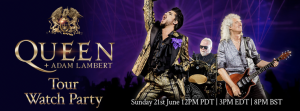
Despite tour postponement Queen + Adam Lambert prove the show must go on with YouTube Tour Watch Party
Sunday June 21. (12PM PT / 3PM ET)
The Tour Watch Party will remain live on the
Queen channel for 24 hours.
Forced by the coronavirus outbreak to postpone their much anticipated ‘Rhapsody‘ European summer tour which this Sunday, June 21, would have seen the band end it’s run of 14 UK arena shows at London’s The 02 having also played Manchester and Birmingham, Queen + Adam Lambert are out to prove that even in these lockdown times the show can still go on.
While appreciating that it won’t be the same as seeing them perform live, the band instead are providing an all access pass to a specially compiled show of highlights from previous tours on the day that they would have played their final O2 London concert by tying upwith YouTube for a special Queen + Adam Lambert Tour Watch Party, this Sunday June 21 at 12PM PDT/ 3PM EDT.
The Tour Watch Party will remain live on the Queen channel for 24 hours.
This never before seen hour long show will feature standout live band performances of many of the best known and loved songs from the Queen catalogue – plus rarities such as ‘Love Kills’ and ‘I Was Born To Love You’ – performed together at the Rock in Rio festivals in Lisbon and Rio de Janeiro; the Global Citizen Festival in New York; Fire Fight Australia; Japan’s Summer Sonic Festival; the UK’s iconic Isle of Wight Festival; an exclusive iHeart Radio performance in Los Angeles, … and not to forget from Dallas, Texas, the much sought out “Fat Bottomed Girls” performed with the Dallas Cowboys Cheerleaders.
So whilst for now a seat at The O2 is not an option, Queen + Adam Lambert are out to show that they can still rock you.
Queen + Adam Lambert are no strangers to YouTube with 12.5 million subscribers following them on the platform and “Bohemian Rhapsody” is part of the exclusive You Tube Billion View Club, the first 1970s video (and pre-1990s video) to reach 1 billion views on the platform. Queen + Adam Lambert’s lockdown version of “You Are the Champions,” all the proceeds of which are going towards the Covid-19 Solidarity Response Fund for The World Health Organisation, has already been viewed close to 4 million times in its first month on YouTube.
QUEEN + ADAM LAMBERT TOUR WATCH PARTY
YouTube
Sunday 21stJune
12PM PDT/3PM EDT/8PM BST
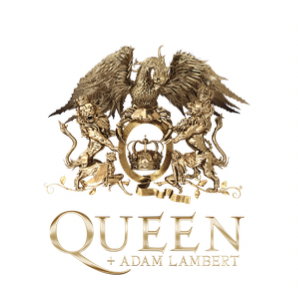
YOU Are The Champions as Queen + Adam Lambert Release Lockdown Version Of Iconic Track
Proceeds go to the COVID-19 Solidarity Response Fund for the World Health Organization powered by the United NationsFoundationto support frontline workers.
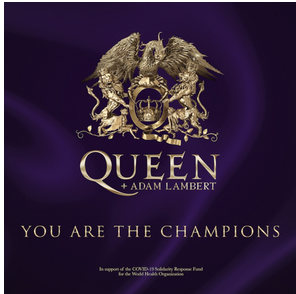
@adamlambert
@unfoundation
@WHO
Clickheretodownload media assets.
Notes to editors:
Queen and Adam Lambert and the Freddie Mercury Estate are waiving all of their royalties from the worldwide sales of You Are The Champions and Universal Music Group are donating all revenues they receive (after deductions only of sales taxes and third party publishing payments) from the sales of single to the COVID-19 Solidarity Response Fund.
About COVID-19 Solidarity Response Fund:The COVID-19 Solidarity Response Fund is a historic opportunity for everyone, everywhere to help support the World Health Organization’s lifesaving work to prevent, detect, and respond to the COVID-19 pandemic. Find out more: covid19responsefund.org
About UN Foundation:
The UN Foundation brings together ideas, people, and resources to help the United Nations drive global progress and tackle urgent problems. Our hallmark is to collaborate for lasting change and innovate to address humanity’s greatest challenges. Learn more at www.unfoundation.org
Footnote:
“We Are The Champions”is a highlight of Queen’s sixth studio album, 1977’s News of the World and first issued as a single, with “We Will Rock You” on the B-side. It has become one of the band’s most instantly identified anthems and is a regular show closer. It was also one of their biggest hits across the world including the UK, US (where it was a double A-side), and Australia, Canada, Ireland, the Netherlands, New Zealand and Norway, Germany, Austria, Sweden and many other territories. In France, “We Are The Champions” stayed at number one for twelve consecutive weeks, afterwhich – and only because no record was permitted to be number one for any longer than twelve weeks – the chart was published with “We Will Rock You”in the top spot.
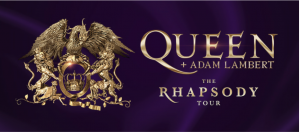
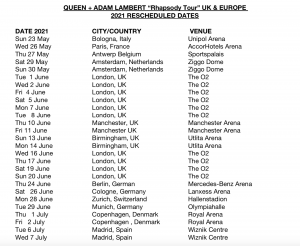
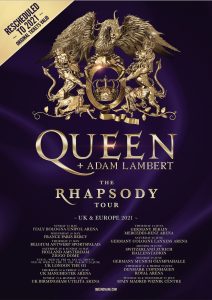
NEW REMASTERED VIDEO AVAILABLE NOW EXCLUSIVELY ON QUEEN’S YOUTUBE CHANNEL
BAND LAUNCHES EXCLUSIVE ‘YOU ARE THE CHAMPIONS’ CAMPAIGN FOR FANS TO BECOME A PART OF QUEEN HISTORY WITH A STARRING ROLE IN THREE NEW USER GENERATED VIDEOS
(Monday, July 22, 2019) Queen’s iconic music video for “Bohemian Rhapsody” has now officially passed 1 Billion views on YouTube, making history as the first pre-1990’s video to reach one billion views on the platform.
The accompanying video for their 1975 single, “Bohemian Rhapsody” is generally recognised as the first ever promotional music video, kick-starting and setting the gold-standard for the genre for decades to come. Today it continues to inspire and entertain millions of fans around the world, more than forty years after it was first created.
Speaking from the band’s current sold-out North American tour, founding Queen members Brian May and Roger Taylor said,
“We are honoured that Bohemian Rhapsody has just hit one billion views on YouTube. We want to thank you all and celebrate with our amazing fans all around the world by creating three new music videos to our songs, all featuring you! Whether you are a musician, singer, dancer, visual artist or you just want to have some fun. Go to www.youarethechampions.com to find out more and we’ll see you on the road somewhere.”
To celebrate this monumental achievement, a newly remastered HD version of the video is available today, for the first time ever and exclusively on the bands YouTube channel. Fans can now see the video restored in all its glory, as it was originally intended. Additionally, fans will now be able to access the song’s lyrics in multiple languages including English, Spanish, Italian, French, Japanese, Polish, German, Indonesian Bahasa, Korean, Czech, Russian & Turkish whilst watching the video.
To further honor this significant milestone, Queen — in partnership with YouTube Music, Universal Music Group and Hollywood Records — have announced the launch of “You Are The Champions’, a unique new campaign that will give fans an exclusive chance to become a part of Queen history with a starring role in three brand new user generated videos for three of the band’s most celebrated tracks.
As part of the campaign, musicians, singers, and instrumentalists can take on “Bohemian Rhapsody”. Dancers will be able to give their own interpretations for “Don’t Stop Me Now” – with a special instructional video created by Polly Bennett (Rami Malik’s movement coach from Bohemian Rhapsody) and finally, visual artists will get the chance to design any word or phrase from the lyrics of “A Kind of Magic”.
Fans can visit YouAreTheChampions.com to find out more and add their submissions! The finished videos will be published later this year on the bands official YouTube channel.
“Bohemian Rhapsody is a sonic and cinematic masterpiece that’s one of the most enduring songs in modern day music,” said Lyor Cohen, Global Head of Music for YouTube. “The newly remastered video on YouTube will ensure the song is re-discovered, embraced and beloved by old and new generations of music fans.”
Celine Joshua, General Manager, Commercial, Content and Artist Strategy at Universal Music Group, said, “We are thrilled that Queen’s iconic Bohemian Rhapsody video has reached a historic one billion views on YouTube. Now, together with Queen, YouTube and Hollywood Records, we are excited to launch ‘You Are The Champions’, an innovative new user generated video campaign with Queen’s incredible fans around the world at its core. This will be the first of a series of custom initiatives we have planned in the coming months on the official Queen channel.”
As well as its status as being the first music promo video of its kind, “Bohemian Rhapsody” is regularly cited as one of the greatest songs ever recorded. In 2004, the song was inducted into the Grammy Hall of Fame and Freddie Mercury’s vocal performance was named by the readers of Rolling Stone magazine as the best in rock history.
The song has continued to inspire a new generation of fans following the unprecedented global success of last year’s biographical film ‘Bohemian Rhapsody’, which tells the incredible story of the band’s career as well as the genesis of the song. The film is the highest grossing music biopic in history, having generated more than $900 million dollars at the box office, with the film winning four Oscars including Rami Malek’s triumph in the Best Actor Category for his portrayal of legendary frontman Freddie Mercury on the big screen. A feat he repeated at both the BAFTA’s and Golden Globes.
BOHEMIAN RHAPSODY & QUEEN IN NUMBERS
-The video was based on their Queen II album cover. It was directed by Bruce Gowers and was shot in 3 hours for a cost of £4,500 at the time at the band’s rehearsal space.
-The track, taken from their seminal ‘A Night At The Opera’ album was first released as a single on October 31, 1975
-The video first aired in the U.K. on TOTP in November 1975
-Bohemian Rhapsody was Queen’s first Top 10 hit in the US. In the UK it went to #1 for 9 consecutive weeks, a record at the time, before returning to the top of the charts again in 1991.
-Bohemian Rhapsody is the only song in history ever to have topped the U.K. charts twice at Christmas.
-Queen have sold in-excess of 300+ million albums worldwide
– In December, ‘Bohemian Rhapsody’ was named as the most Googled song of 2018.
-Queen has more than 10 million subscribers on their official YouTube channel.
-The song reached the top 40 in the USA in 2019 making its third visit and one of the only songs to reach the Top 40 in three different decades.
YouTube Channel: https://Queen.lnk.to/QueenYT
Bohemian Rhapsody: https://Queen.lnk.to/BohemianRhapsodyVideo
QUEEN TO RELEASE SPECIAL 12-INCH VINYL FOR BLACK FRIDAY RECORD STORE DAY
The limited-edition vinyl will include “We Are the Champions” and “We Will Rock You,” and will be released on November 24thin record stores nationwide.
For general information, including a Black Friday FAQ and participating stores, please visithttp://www.recordstoreday.com
About Record Store Day:
Record Store Day, the organization, is managed by the Department of Record Stores and is organized in partnership with the Alliance of Independent Media Stores (AIMS), the Coalition of Independent Music Stores (CIMS) and promotes independent record stores year-round with events, special releases and other fun things.
Record Store Day, the global celebration of the culture of the record store, takes place annually in April.
We Are The Champions
& We Will Rock You
Alternative Previously Unheard ‘Raw Sessions’ Versions
Released on 6 October, 2017
To Mark 40th Anniversary of News of the World
To mark the 40th Anniversary of the release of Queen’s 1977 landmark album News of the World, alternative previously unheard ‘Raw Sessions’ versions of both We Are The Champions and We Will Rock You are being released as digital downloads on the 6 October 2017.
Originally launched in October 1977, News of the Worldis one of Queen’s biggest selling albums of all time. It opens with two of the band’s most indestructible worldwide hits, the Brian May-pennedWe Will Rock Youand Freddie Mercury’s We Are The Champions, monumental stadium anthems which remain a staple of major sporting events all around the world to this day.
Both are taken from the upcoming special box set edition of News of the Worldwhich is released on the 17th November. The brand new package includes the original album on CD, plus two further CDs of recently unearthed out-takes and rarities from the band’s archives, one of which is a newly created ‘alternative’ version of the whole album – Raw Sessions.
Mined deep from long-vaulted studio multi-track tapes, this extraordinary parallel album brings to light never-before-heard alternative versions of each of the album’s 11 tracks.
All the lead vocals on the Raw Sessions are from a different take to that used on the original album. This includes We Will Rock You, which also features a radically different approach to the guitar solo, reminiscent of Jimi Hendrix, plus the band’s original studio banter recorded immediately prior to the master take. This reveals that the much-speculated noise at the beginning of the 1977 record is actually an echo of Brian’s count-in.
On We Are The Champions, there are also many unfamiliar instrumental elements, most notably from the guitar department. This track was edited on the 1977 album but is presented here for the first time in its originally recorded length with two more choruses. Also included is a charming false-start to one of the earliest takes of the song. The recordings also reveal that We Are The Champions, known for its unresolved cliff-hanger ending, was originally intended to fade-out. Freddie ends the take saying “That was a lovely feel…that’s exactly how it should be”.
All of the material on the Raw Sessions was recorded in 1977.
We Are The Champions & We Will Rock You are available from:
40th Anniversary Edition of News of the World, released 17 November 2017
